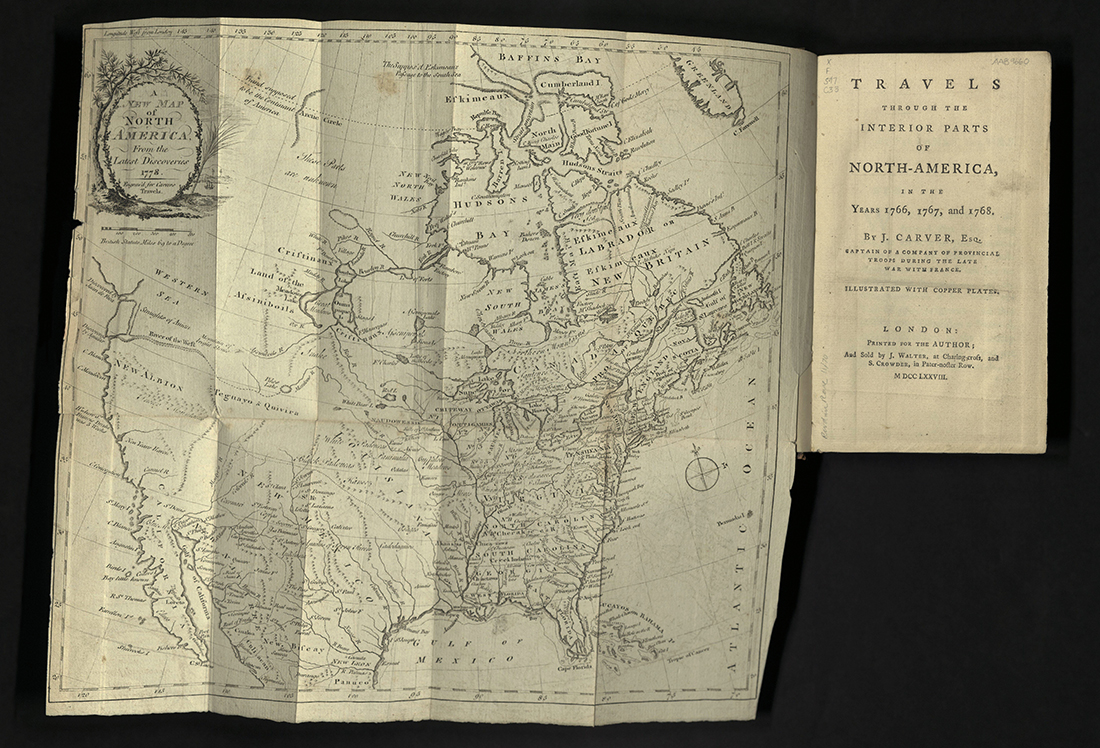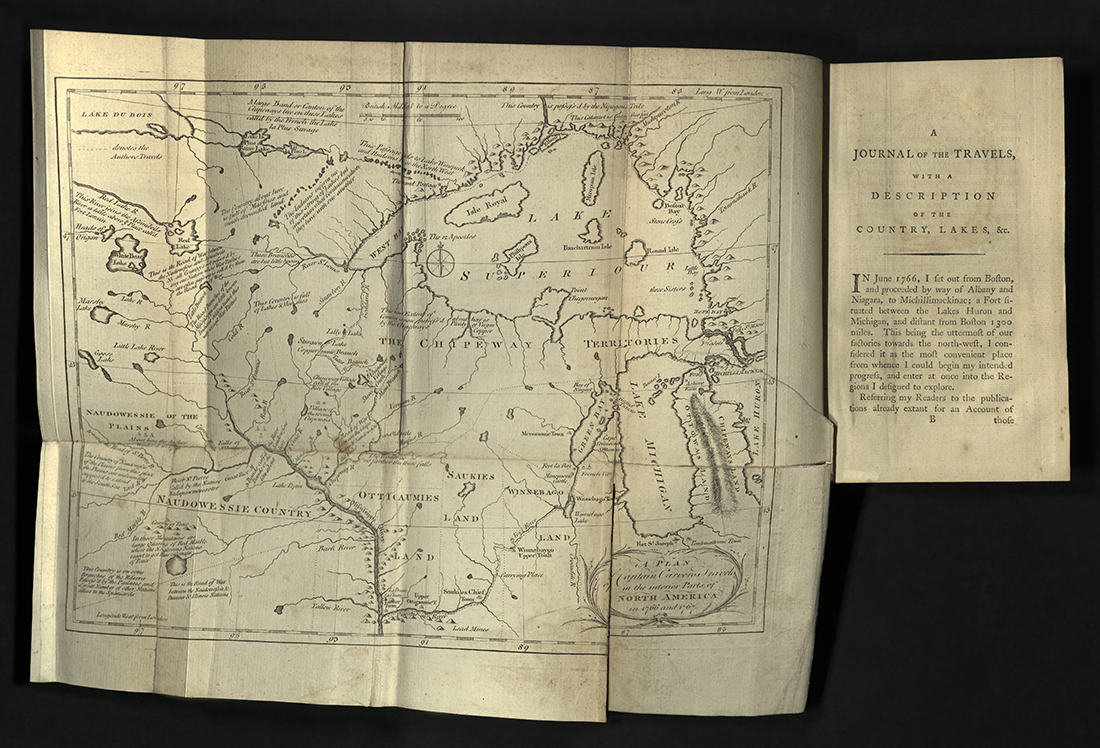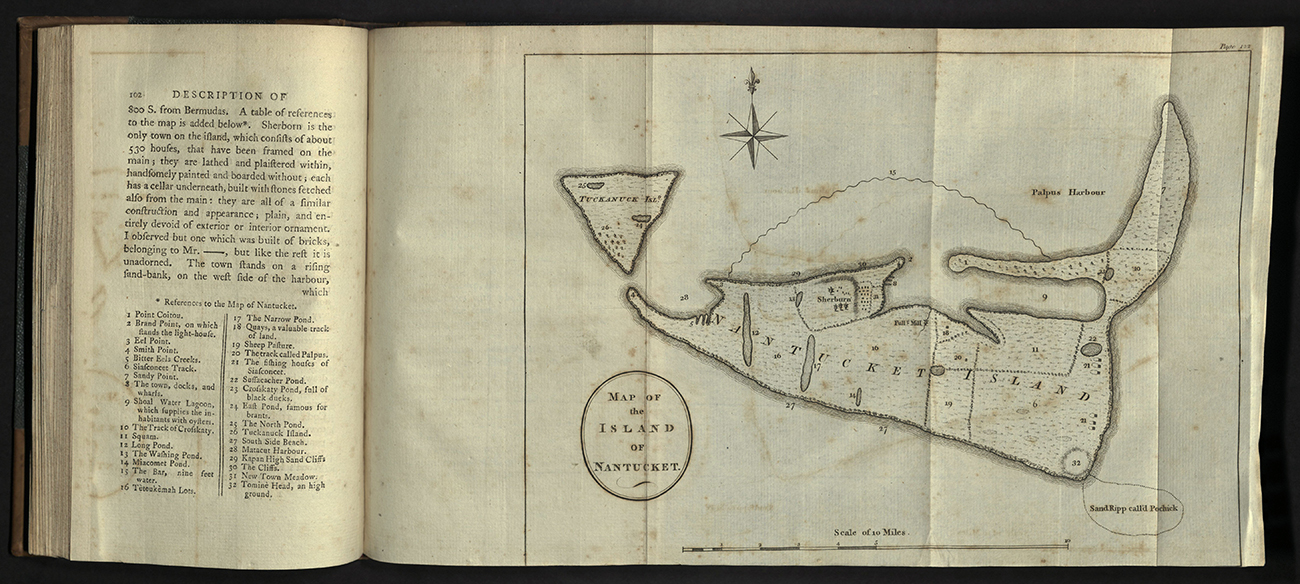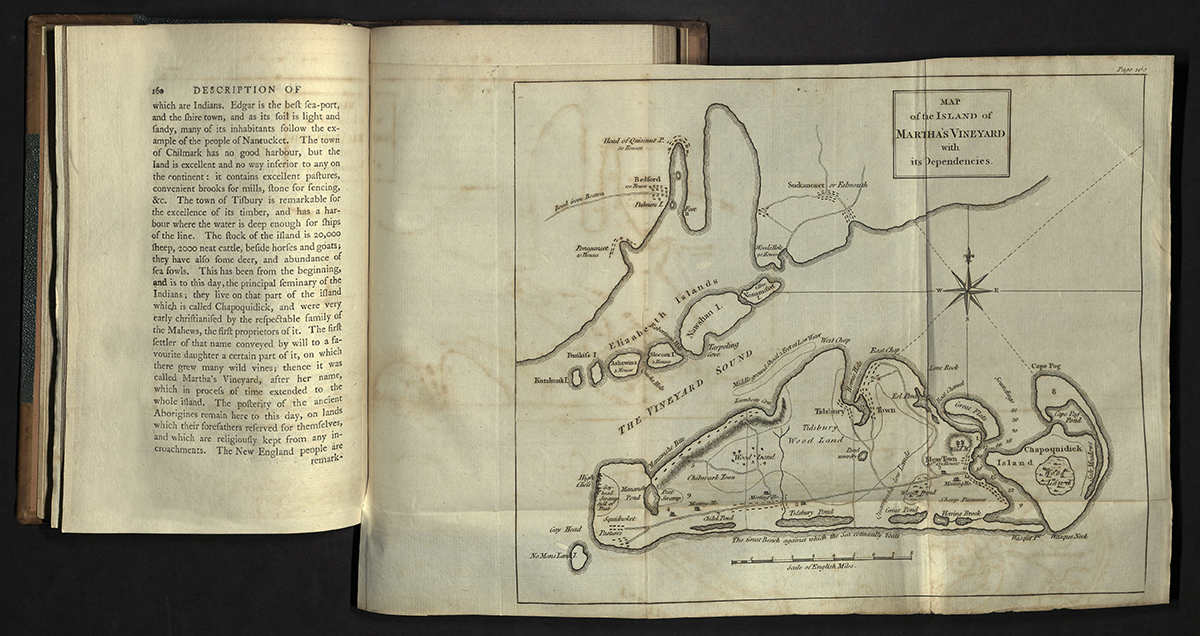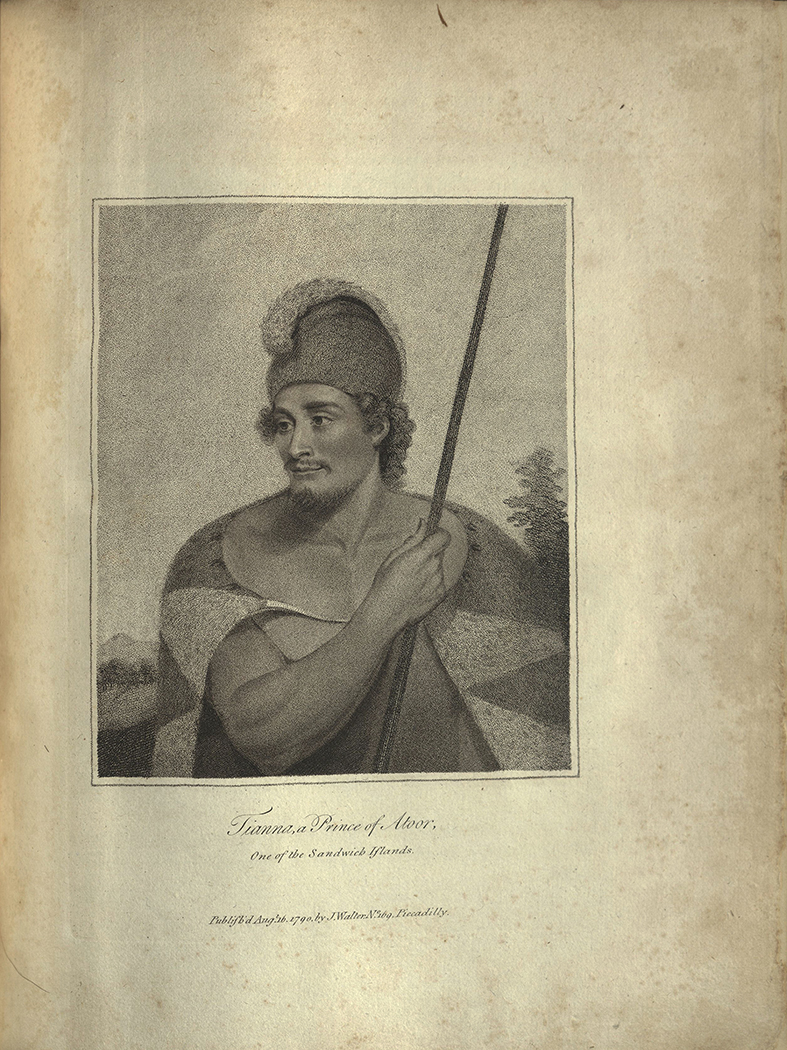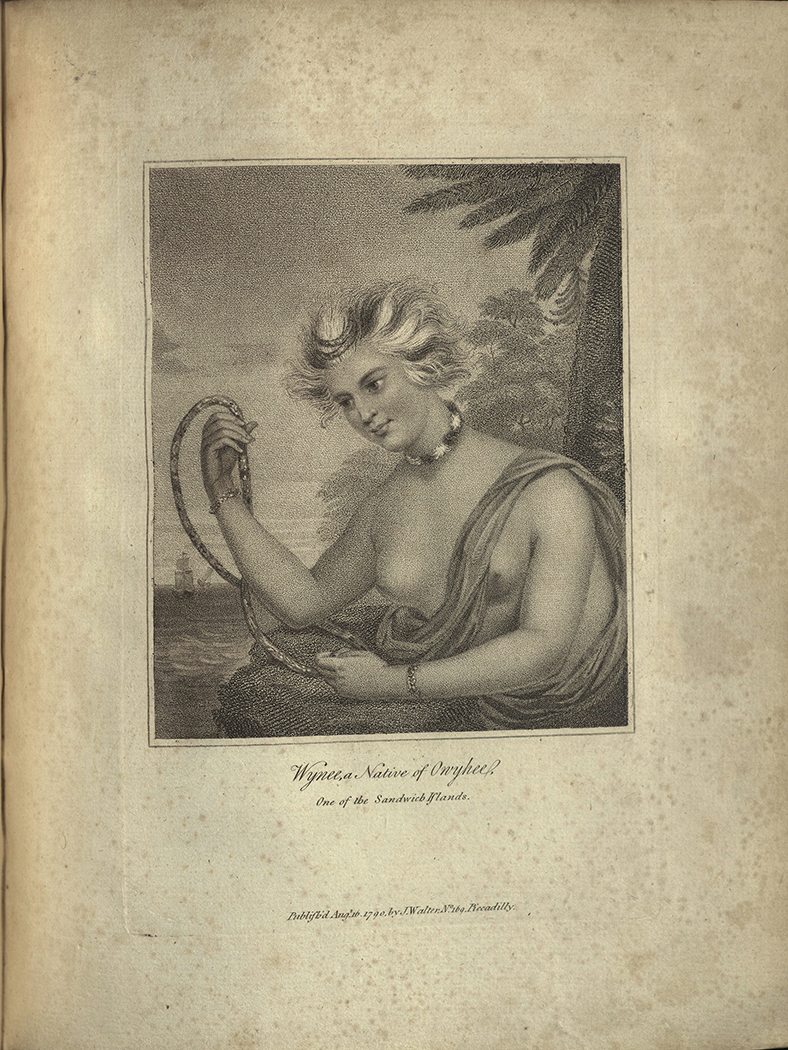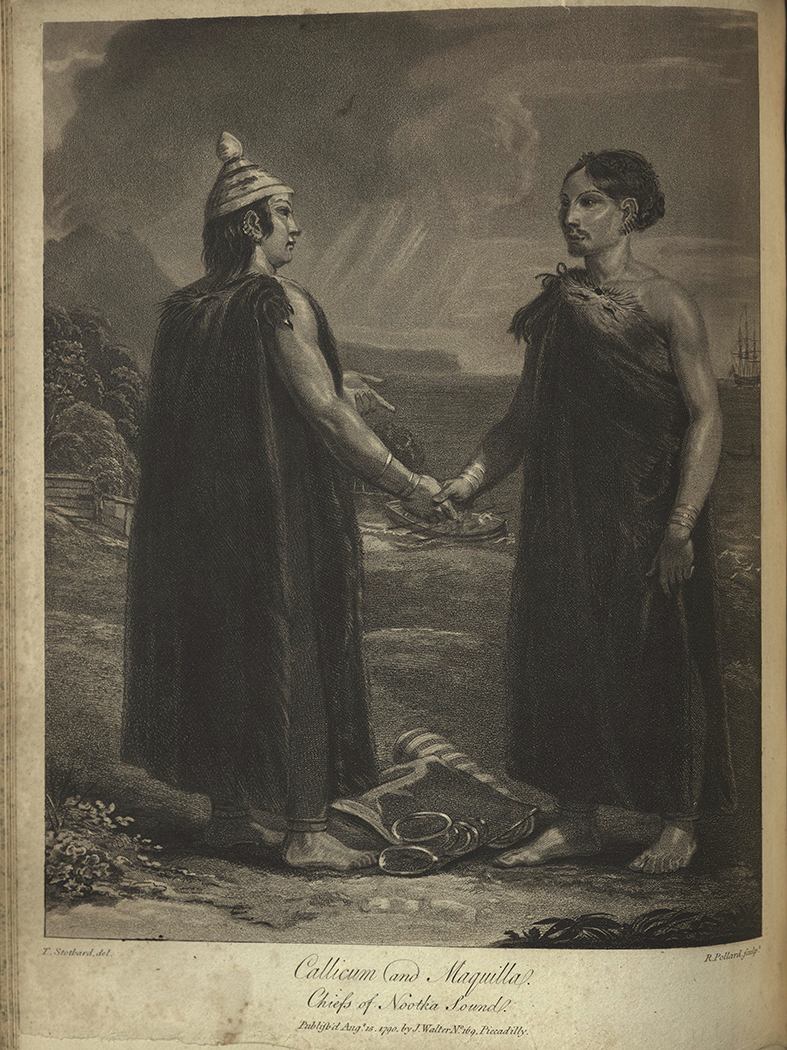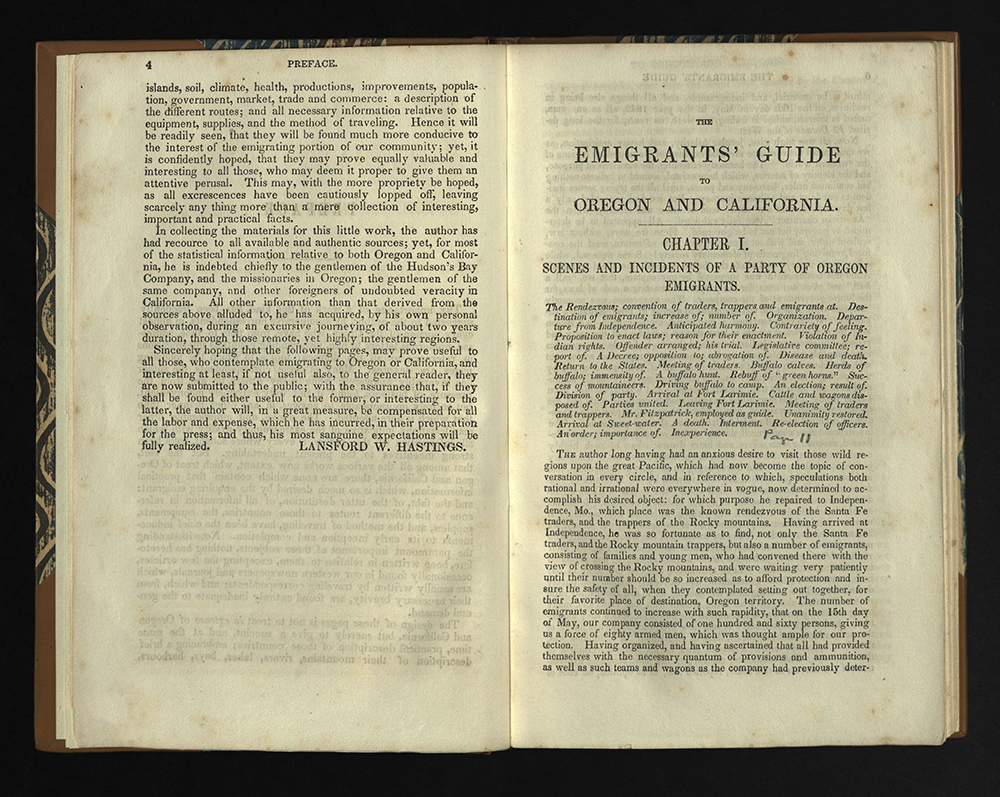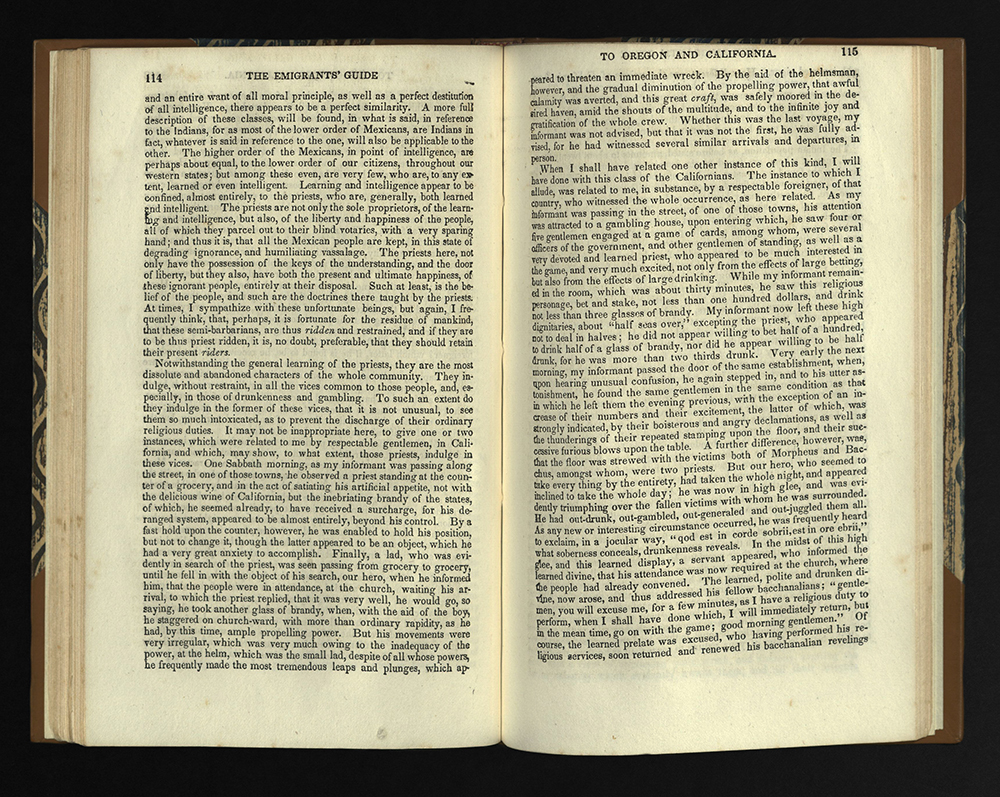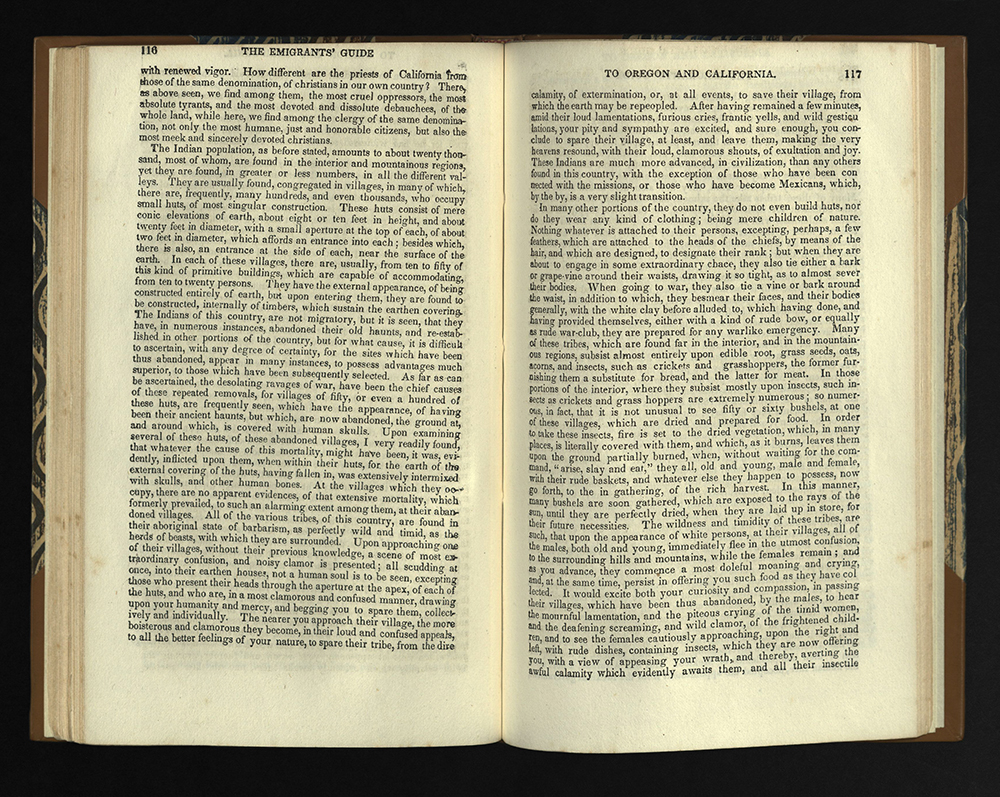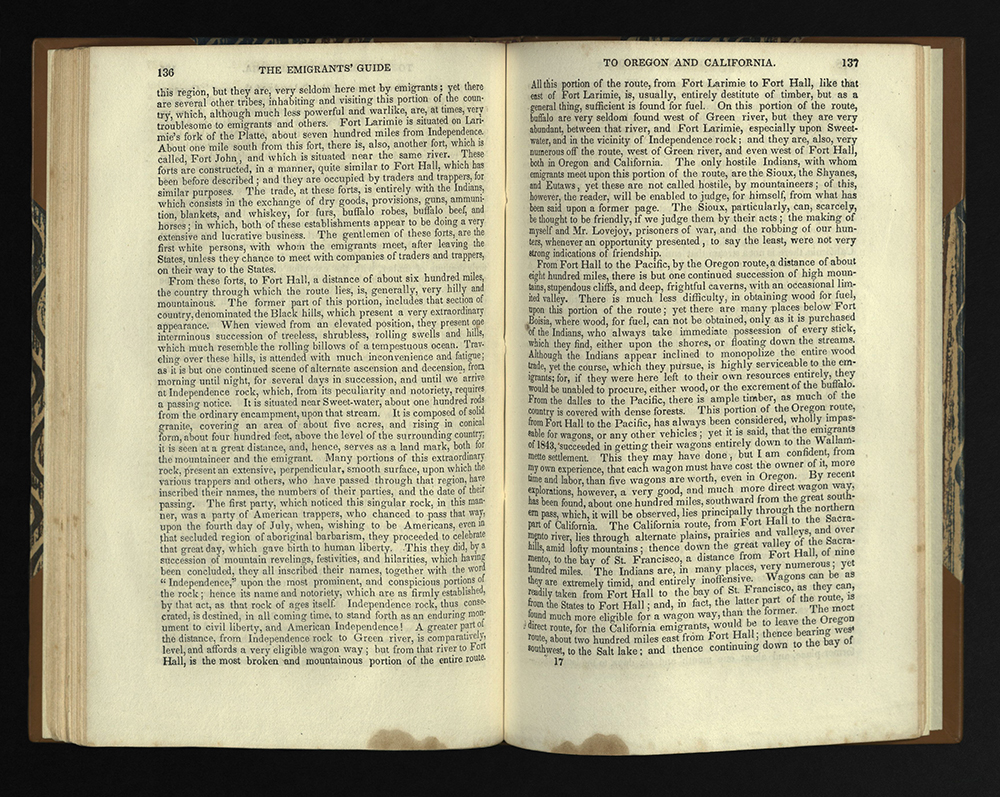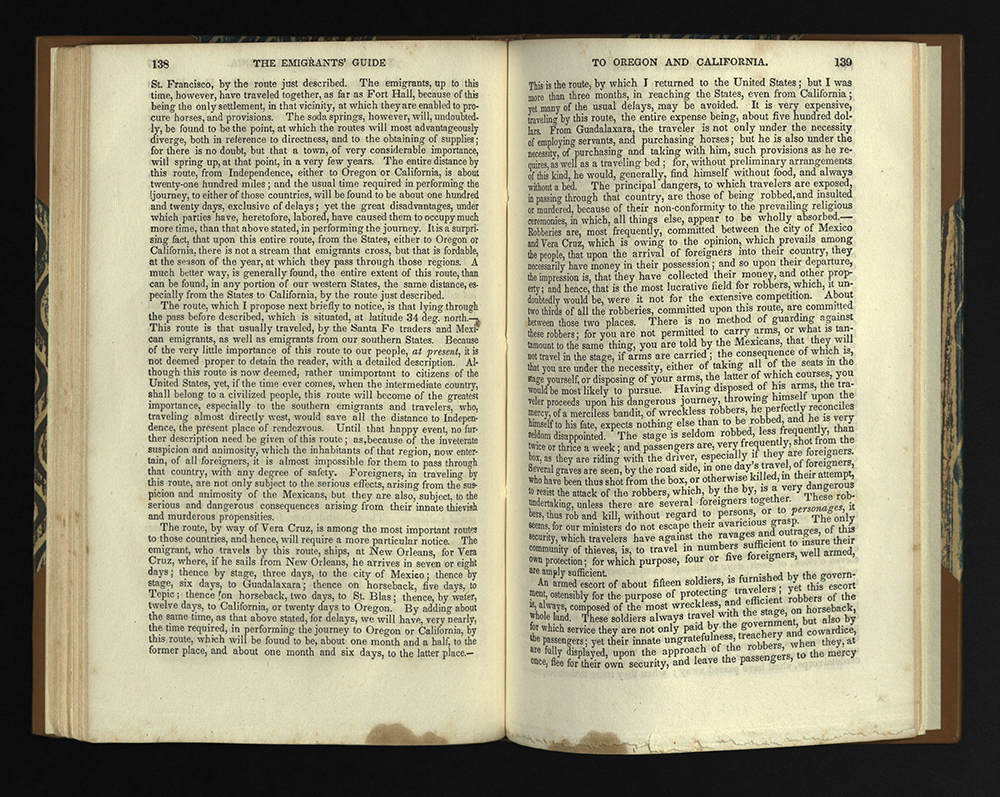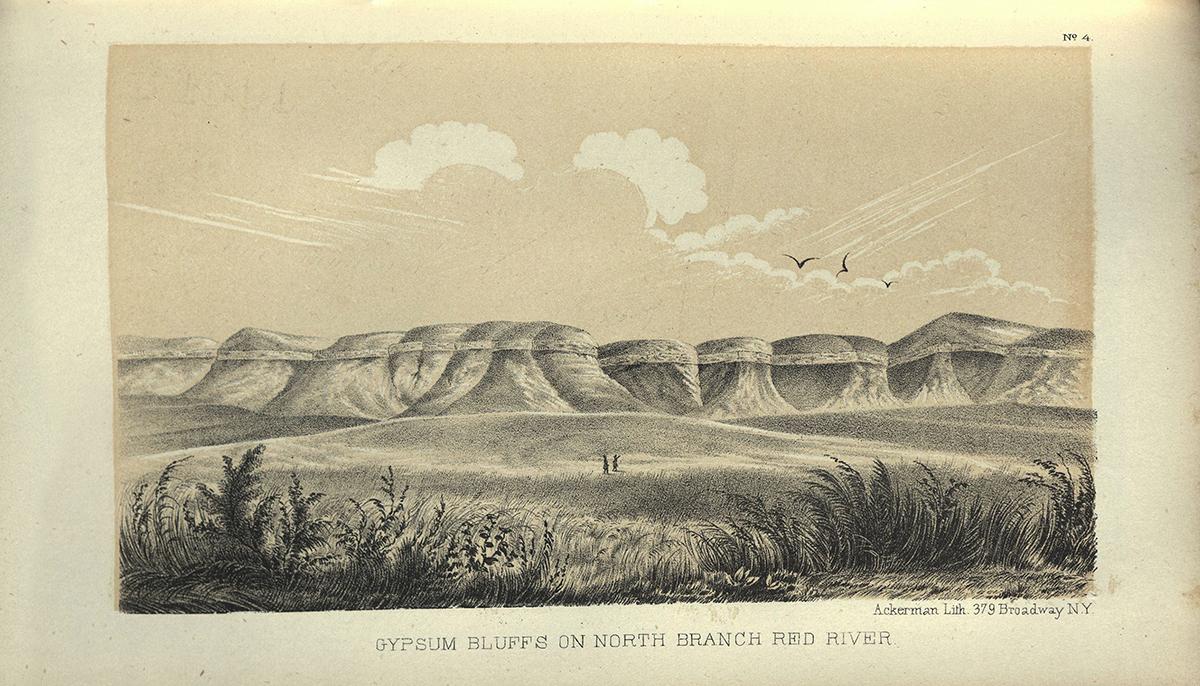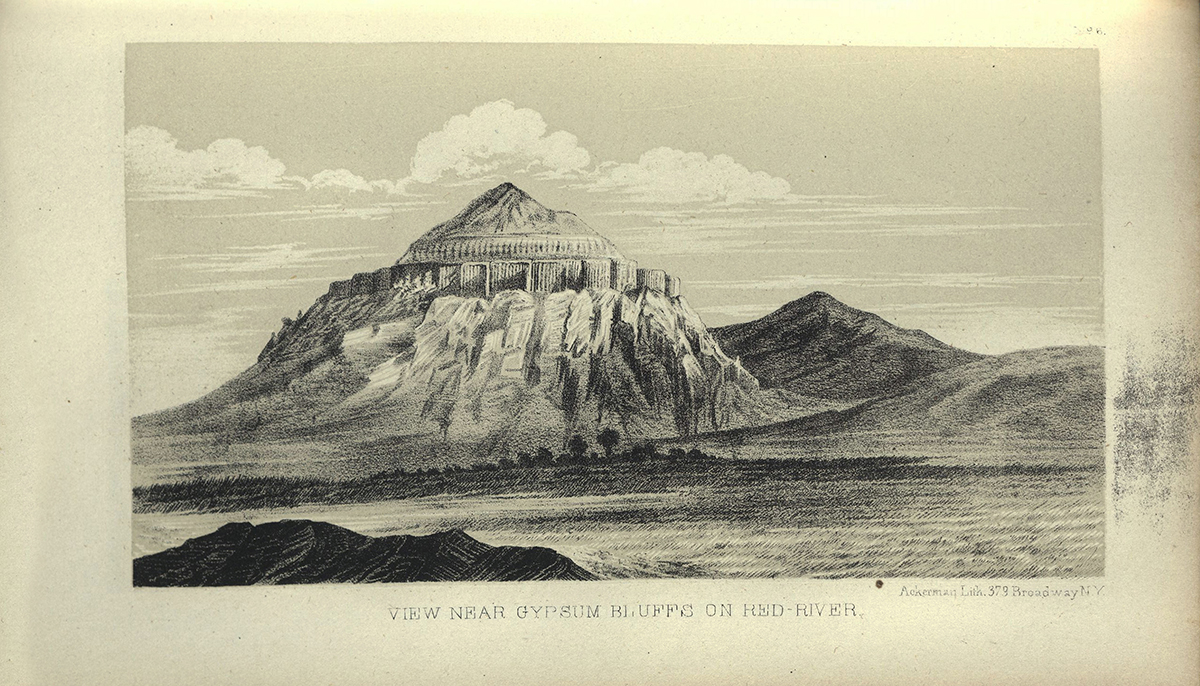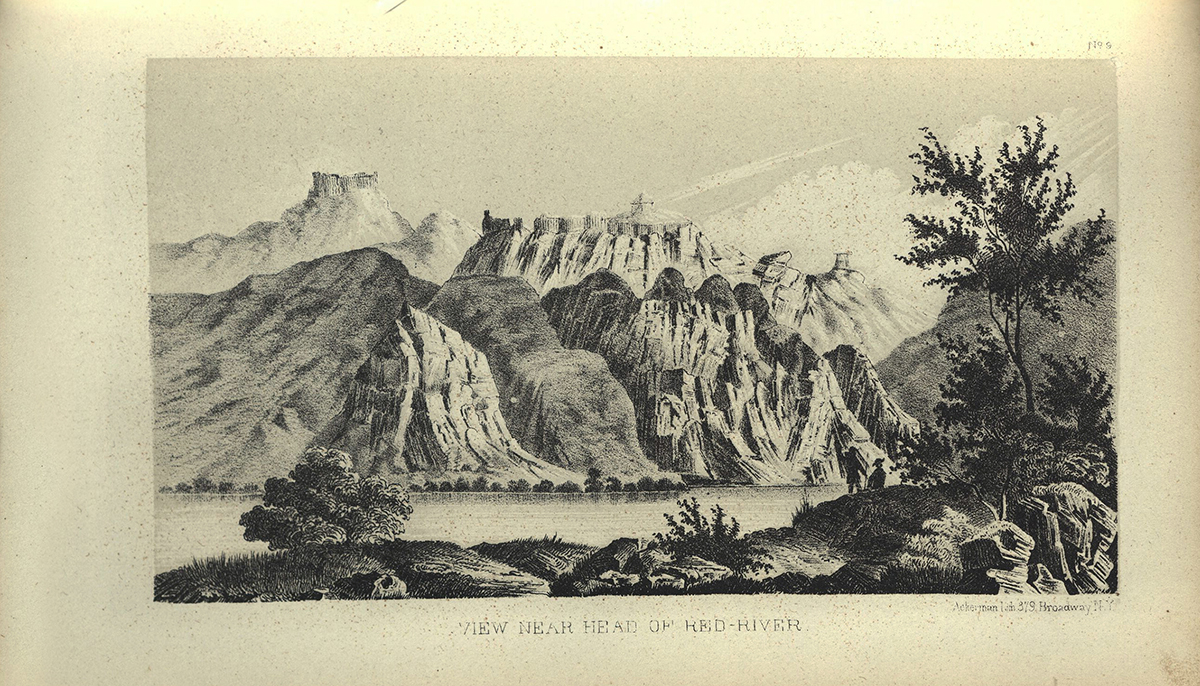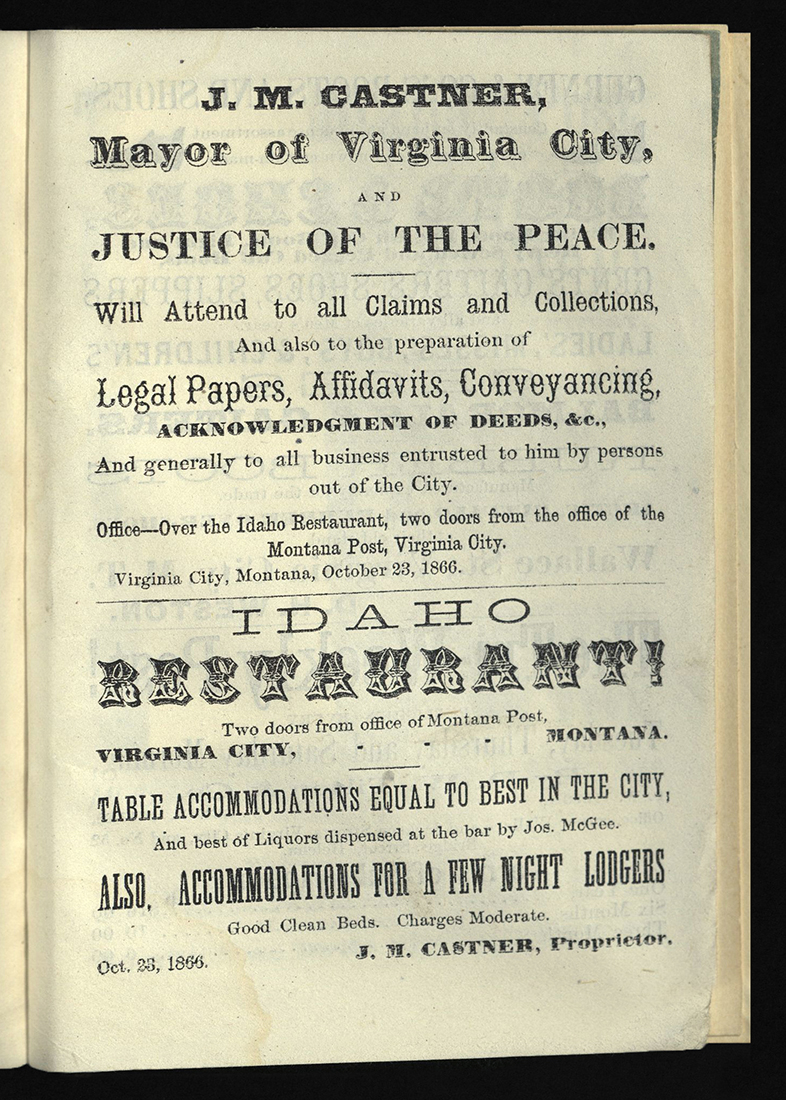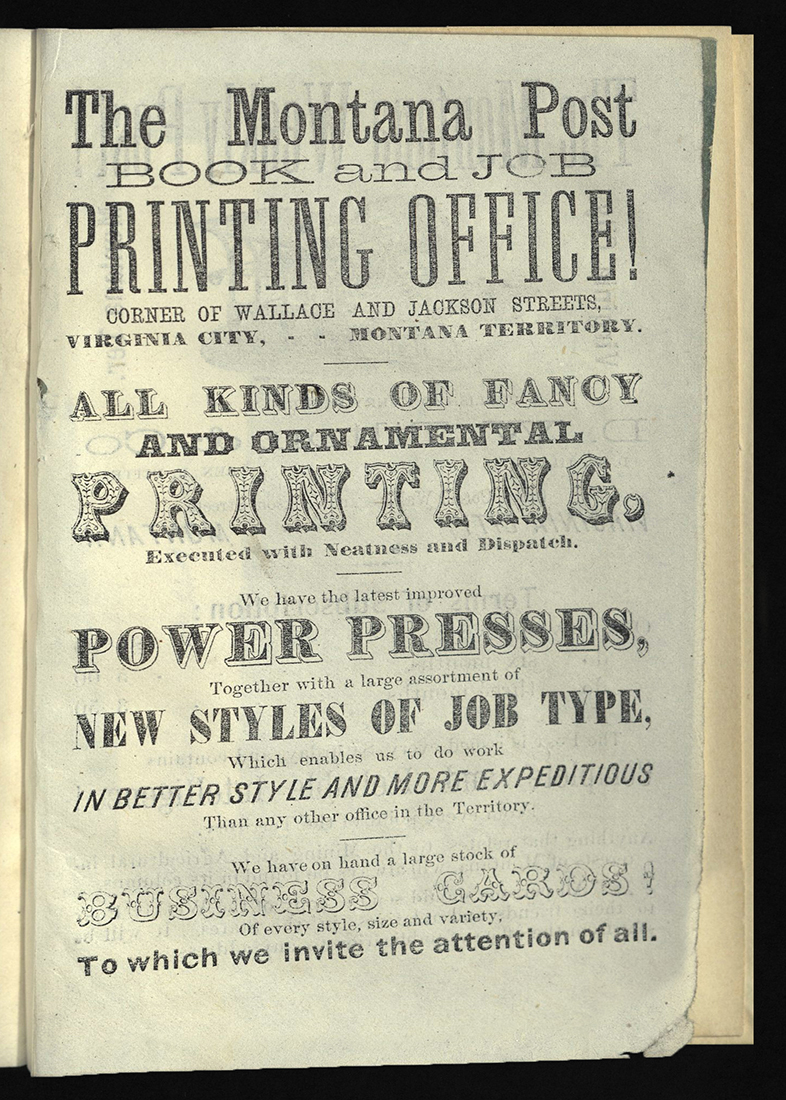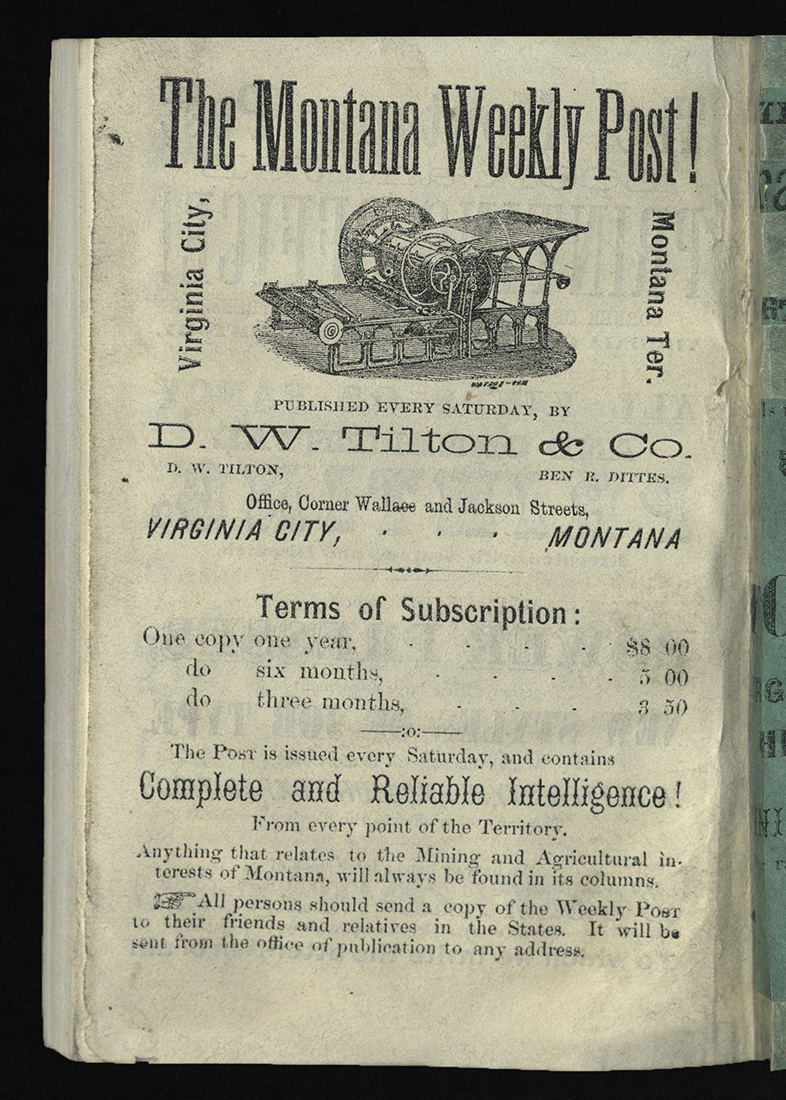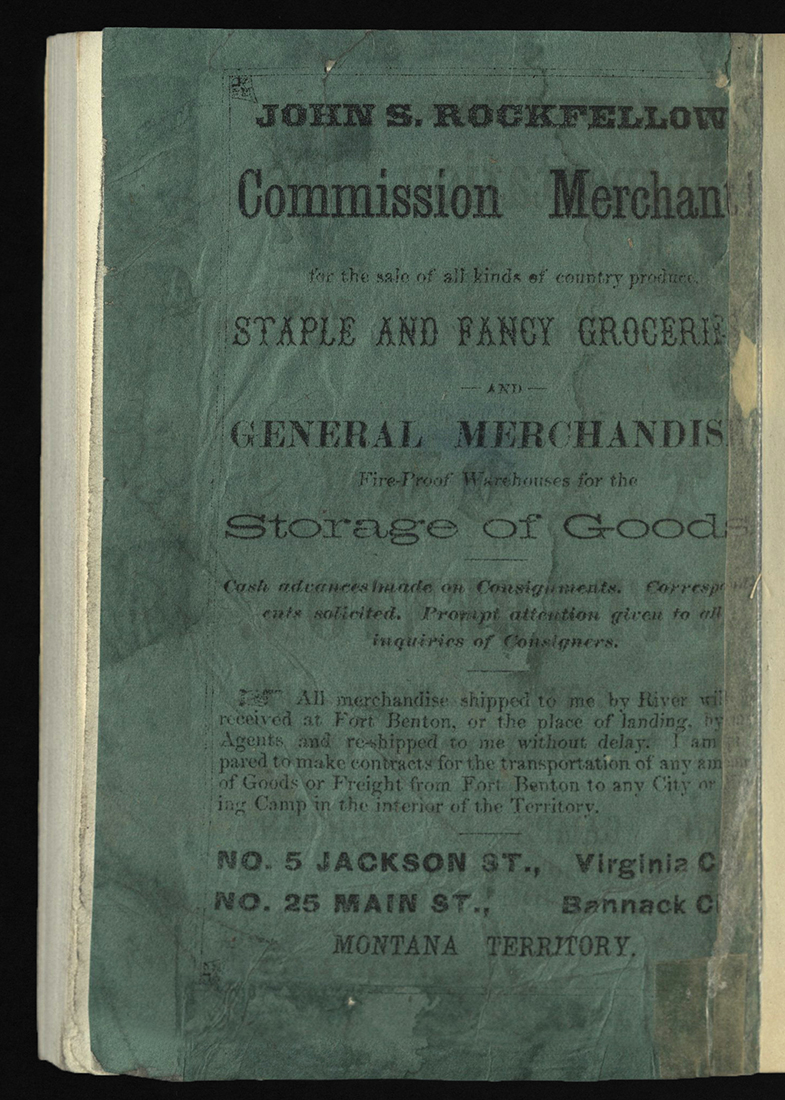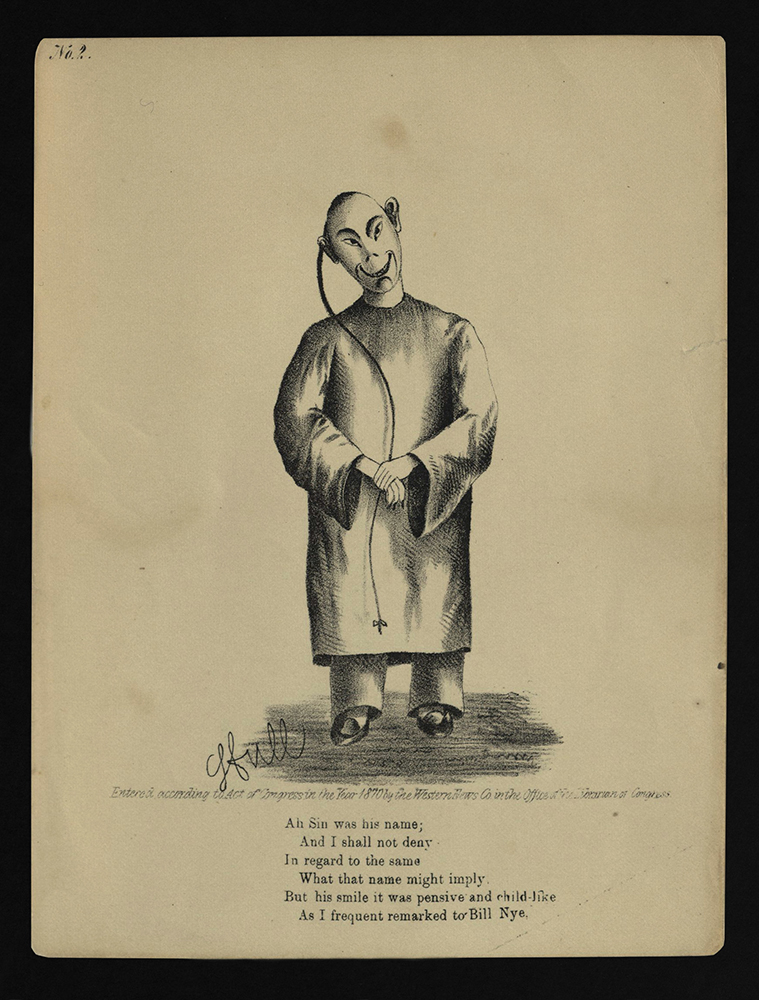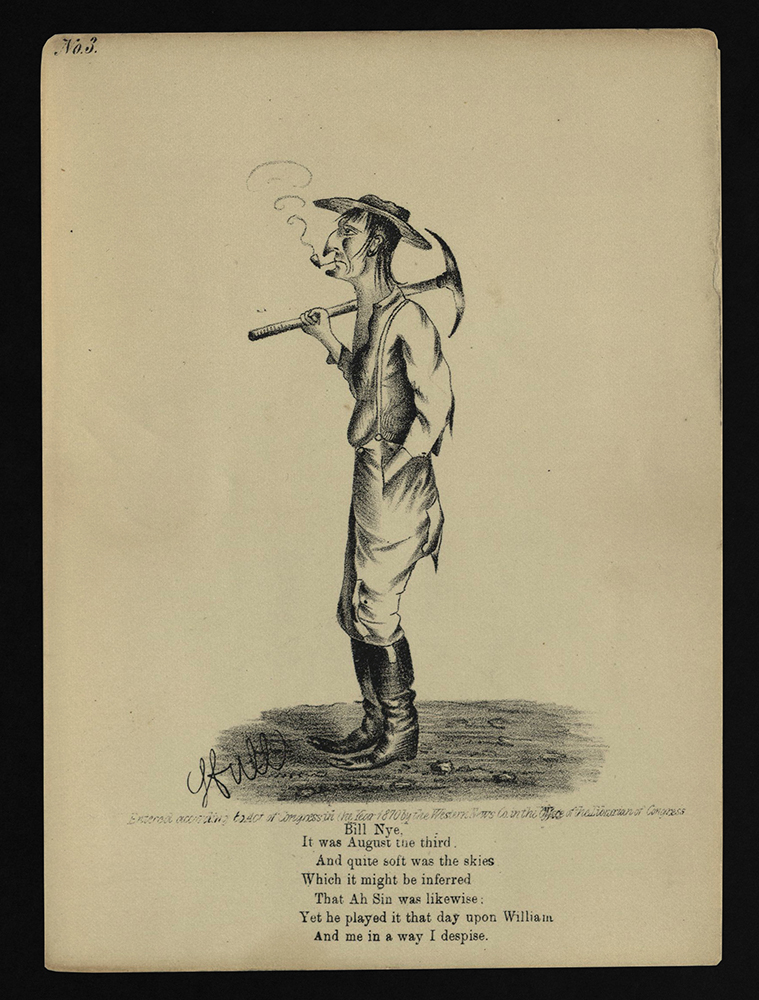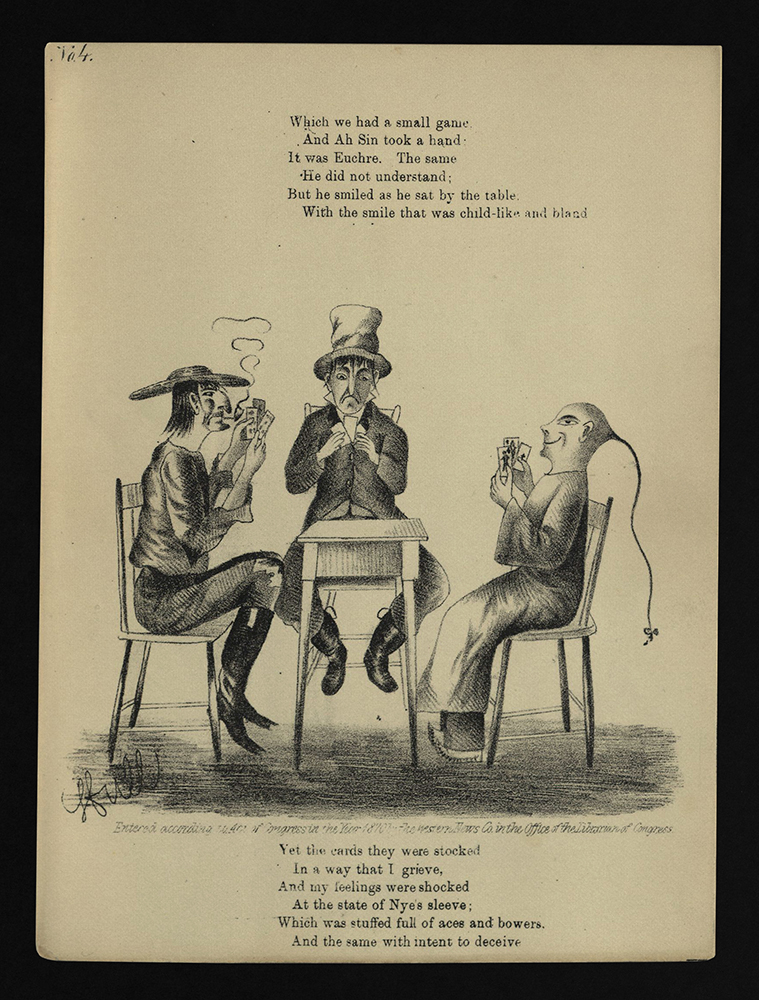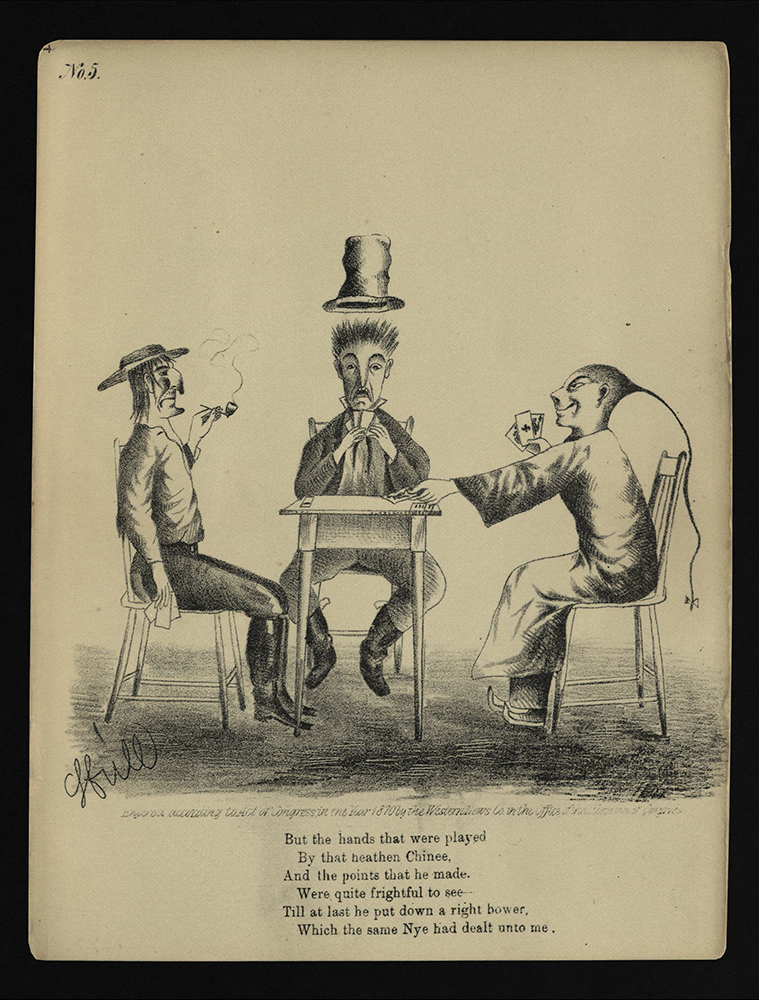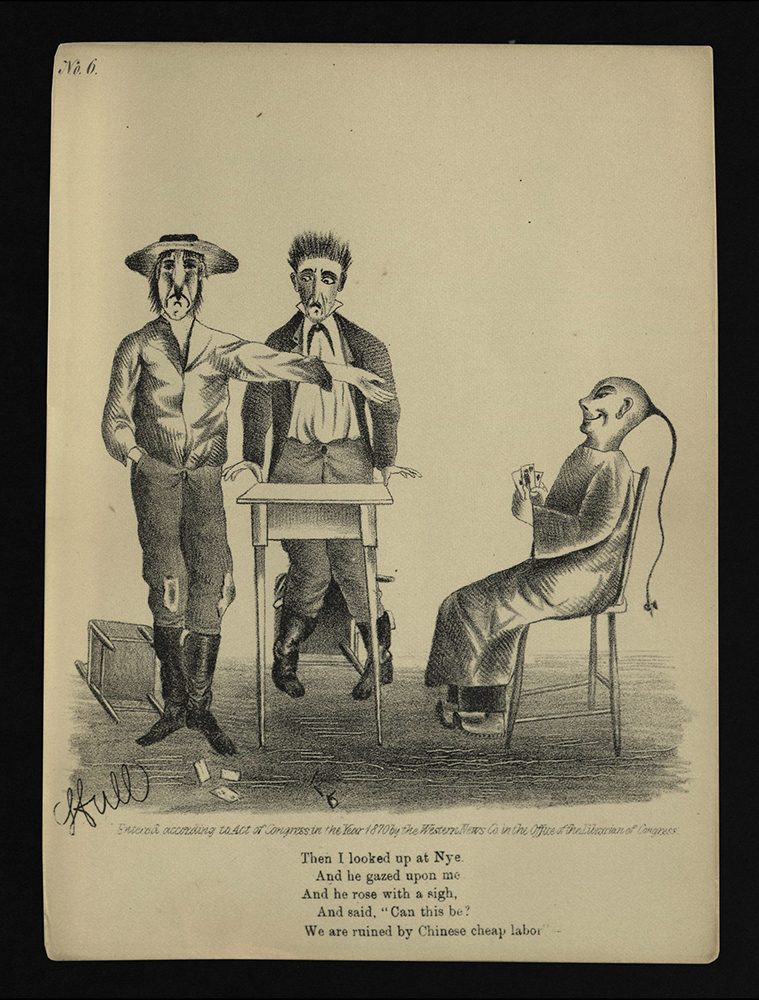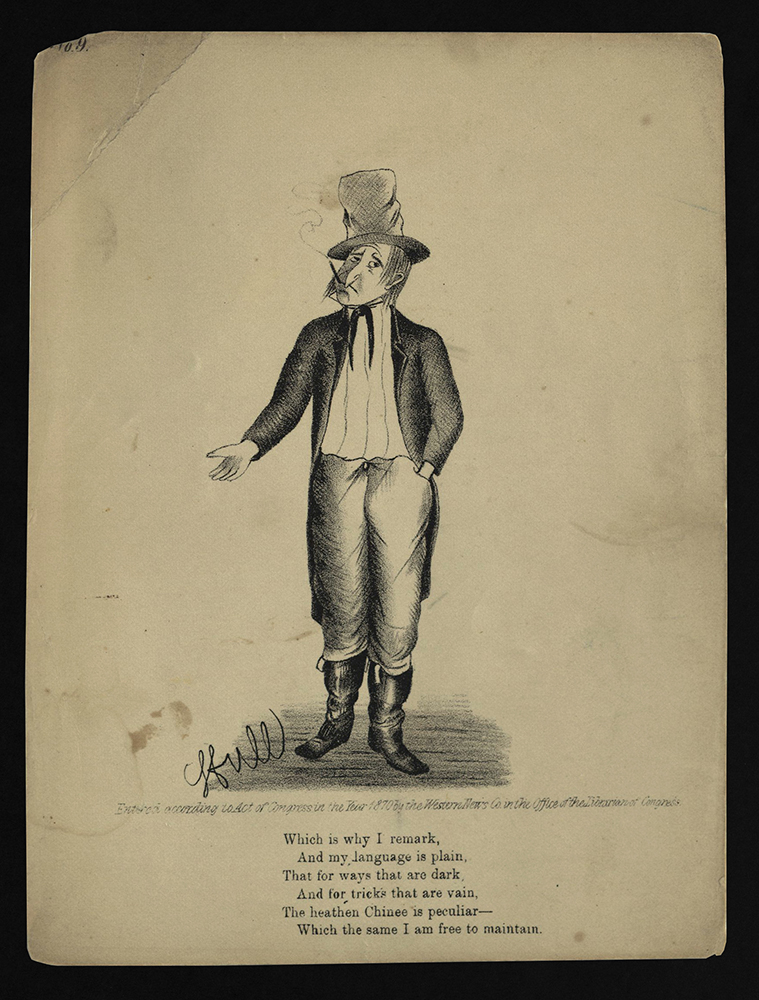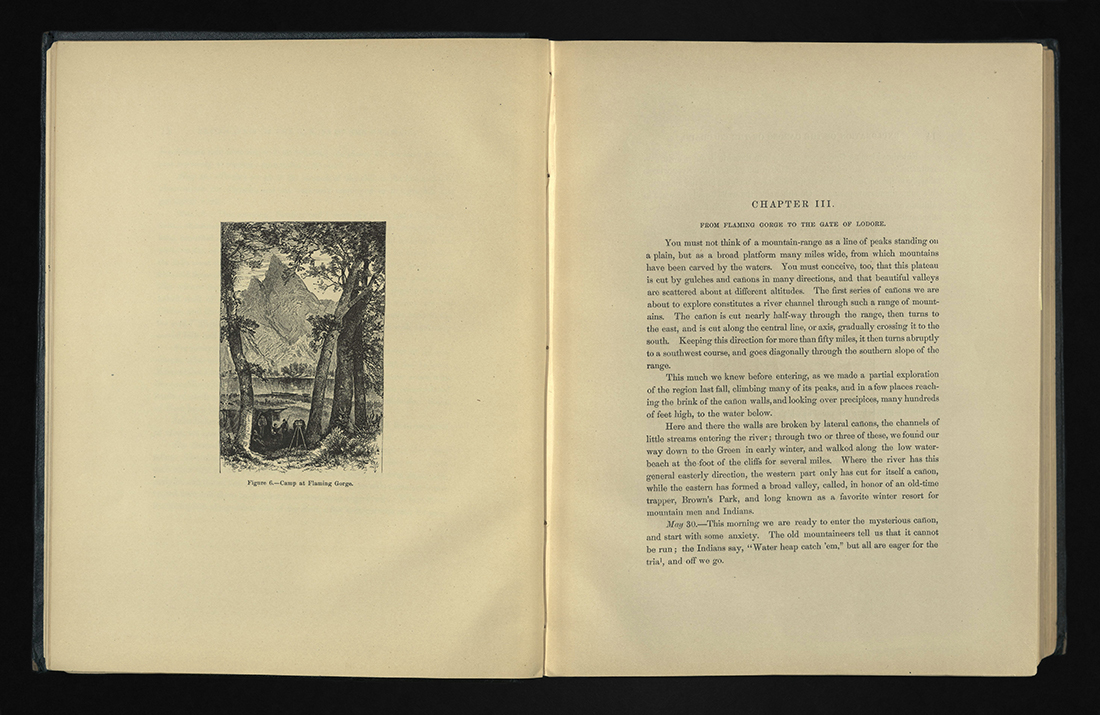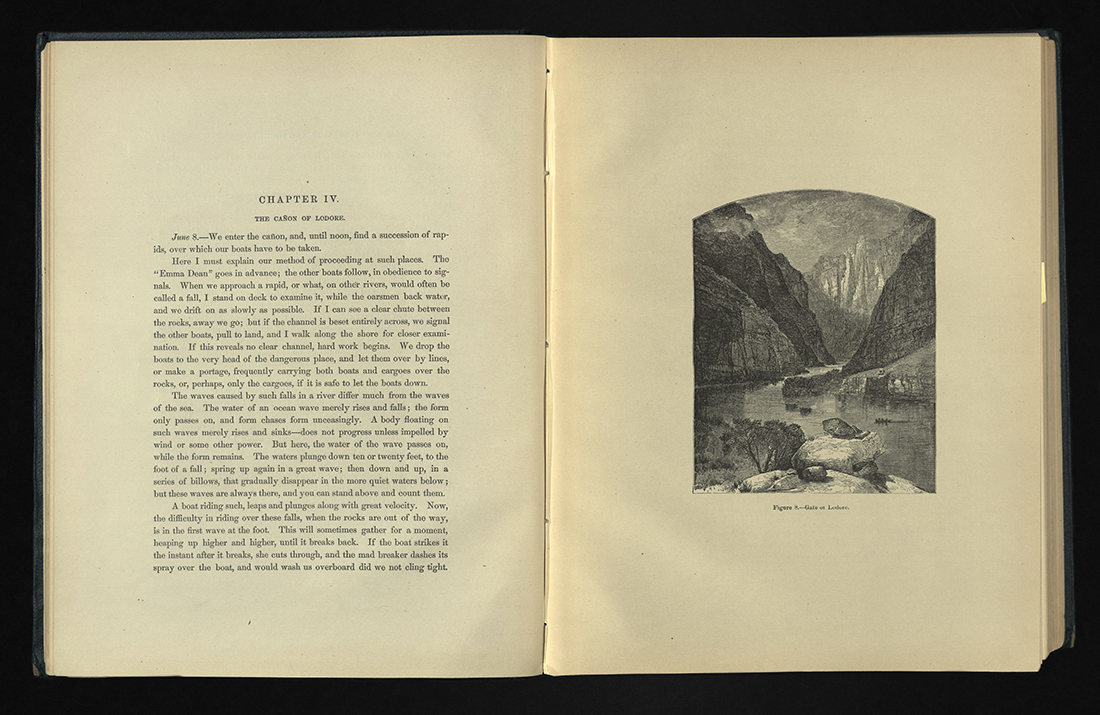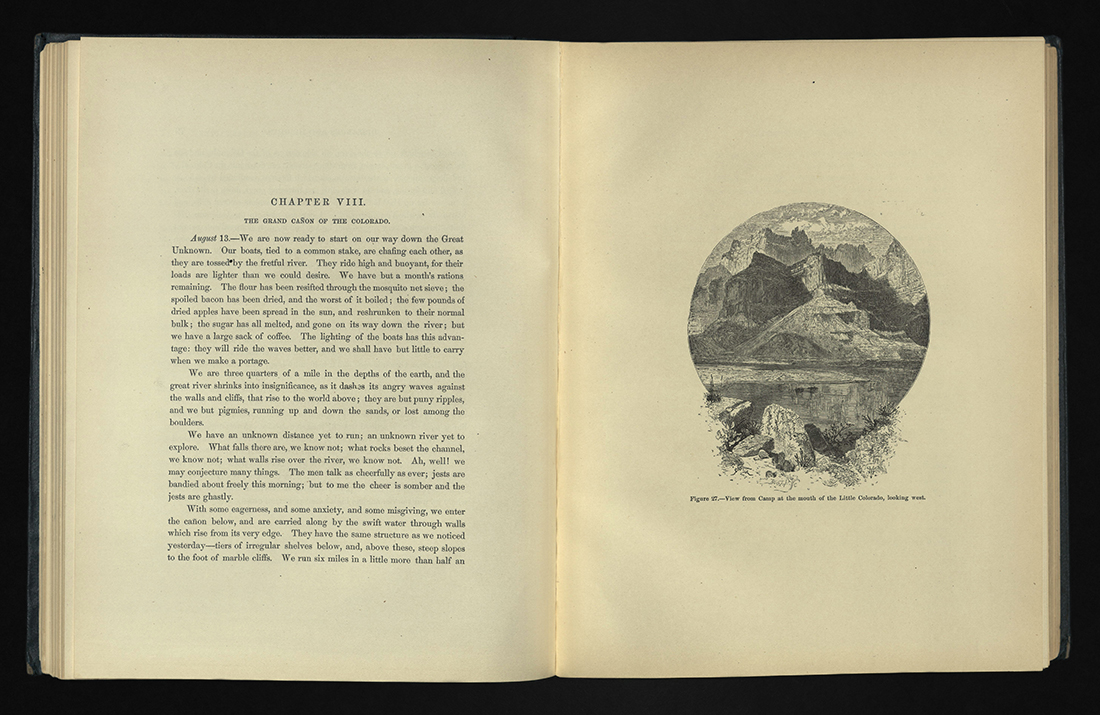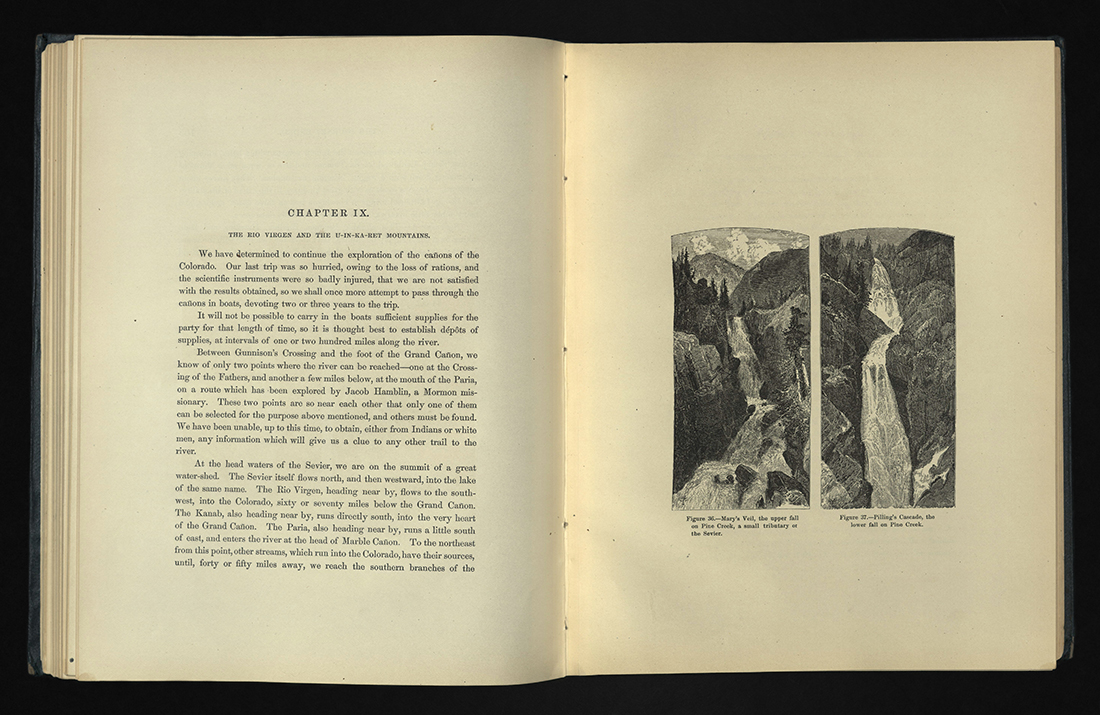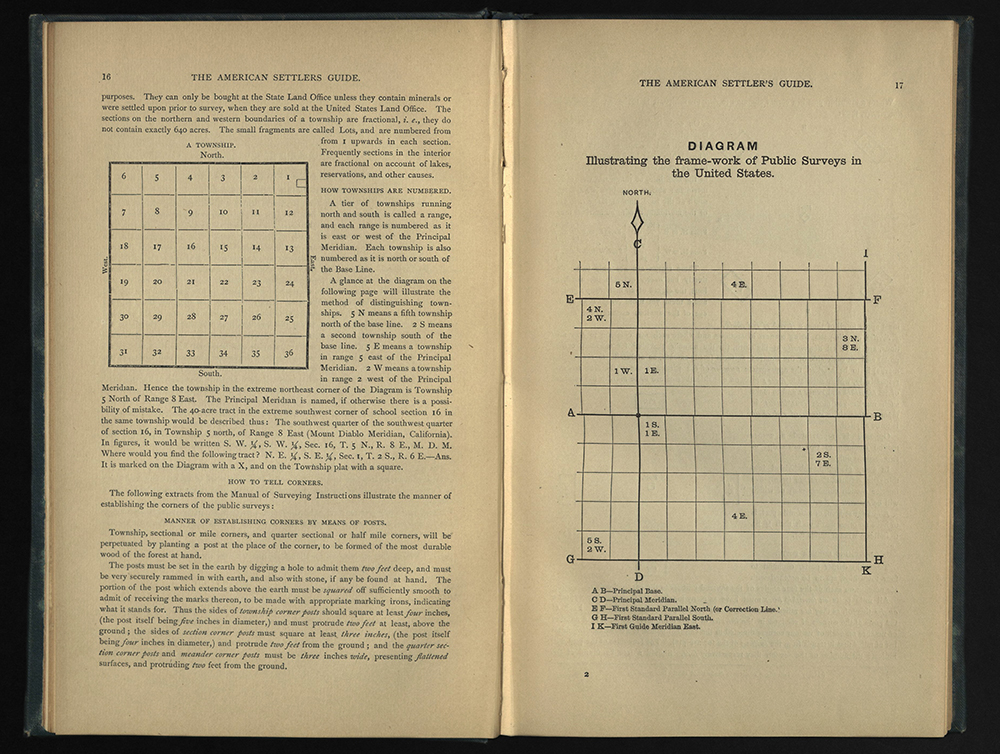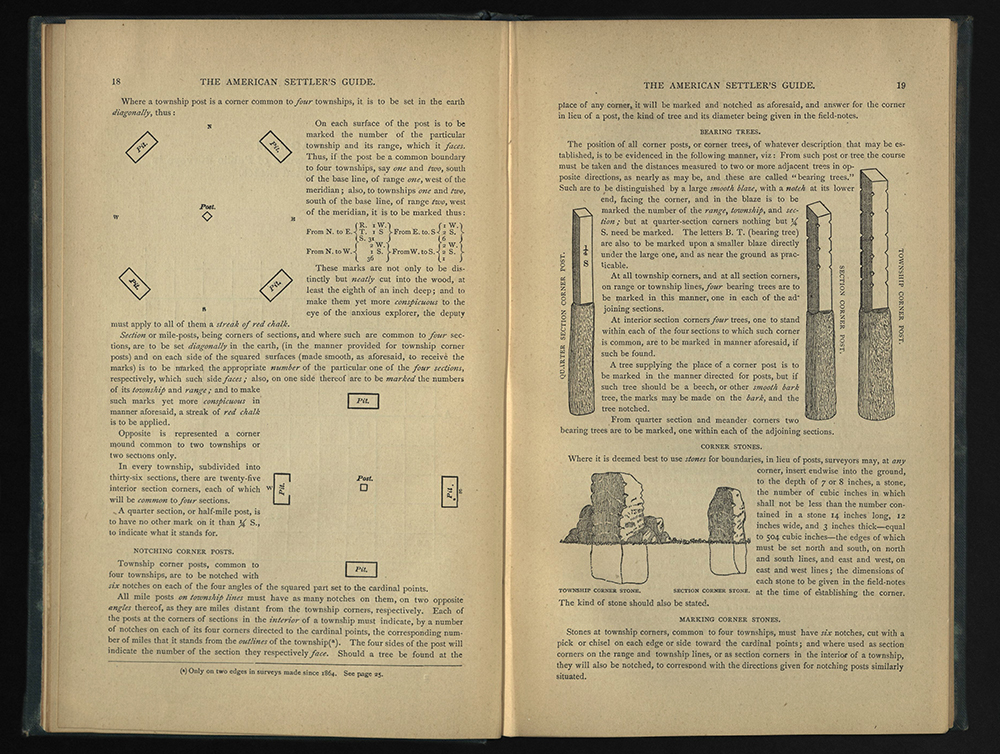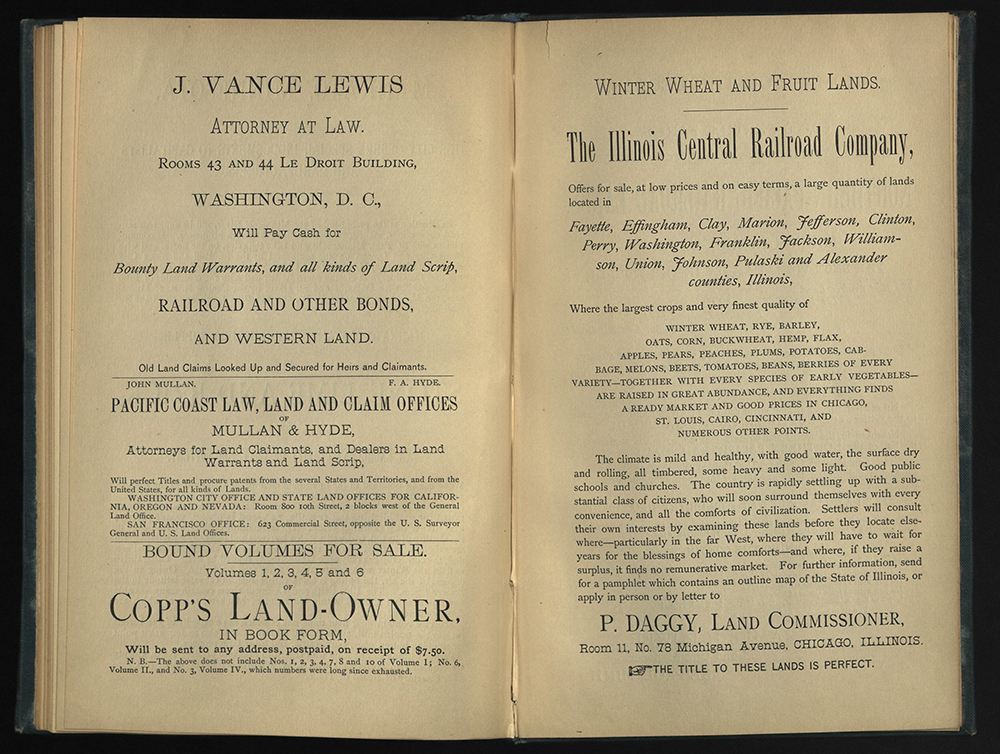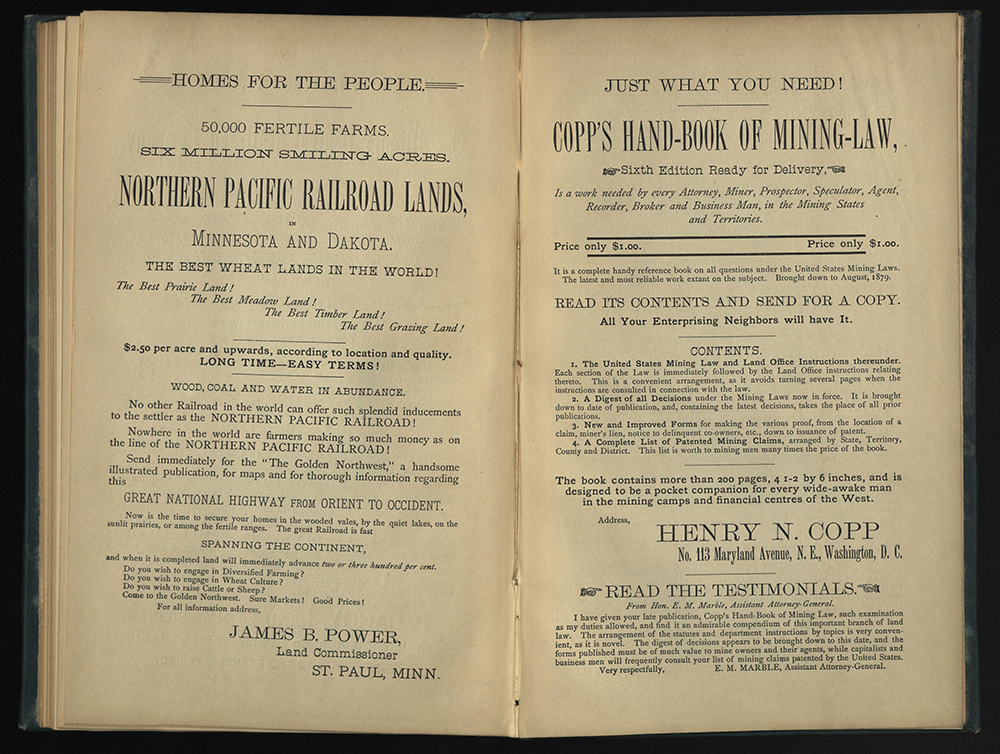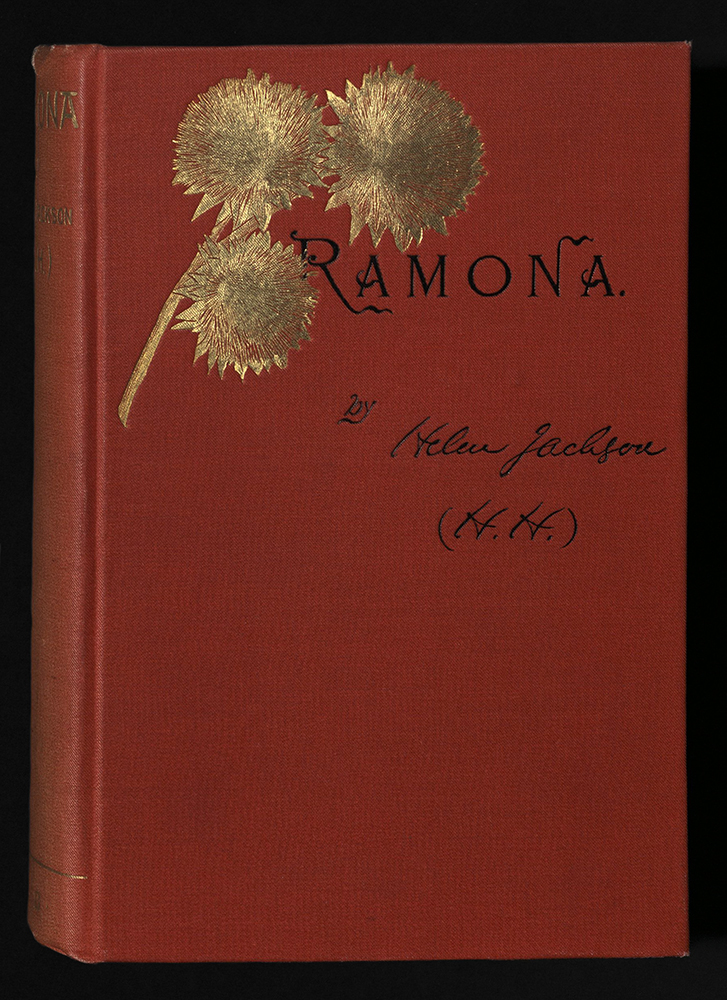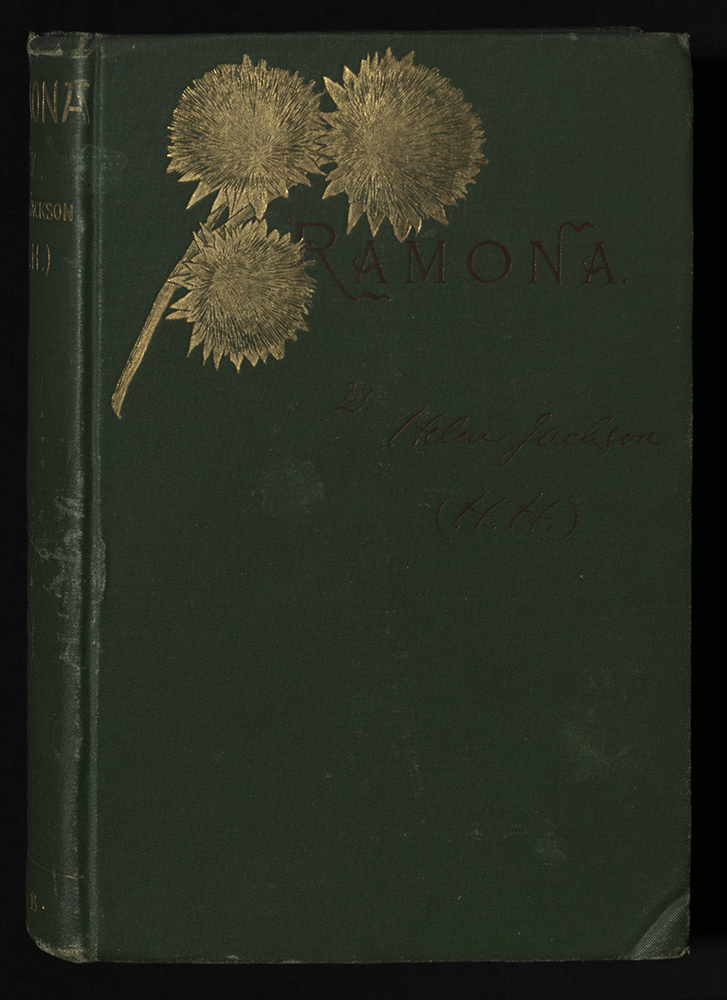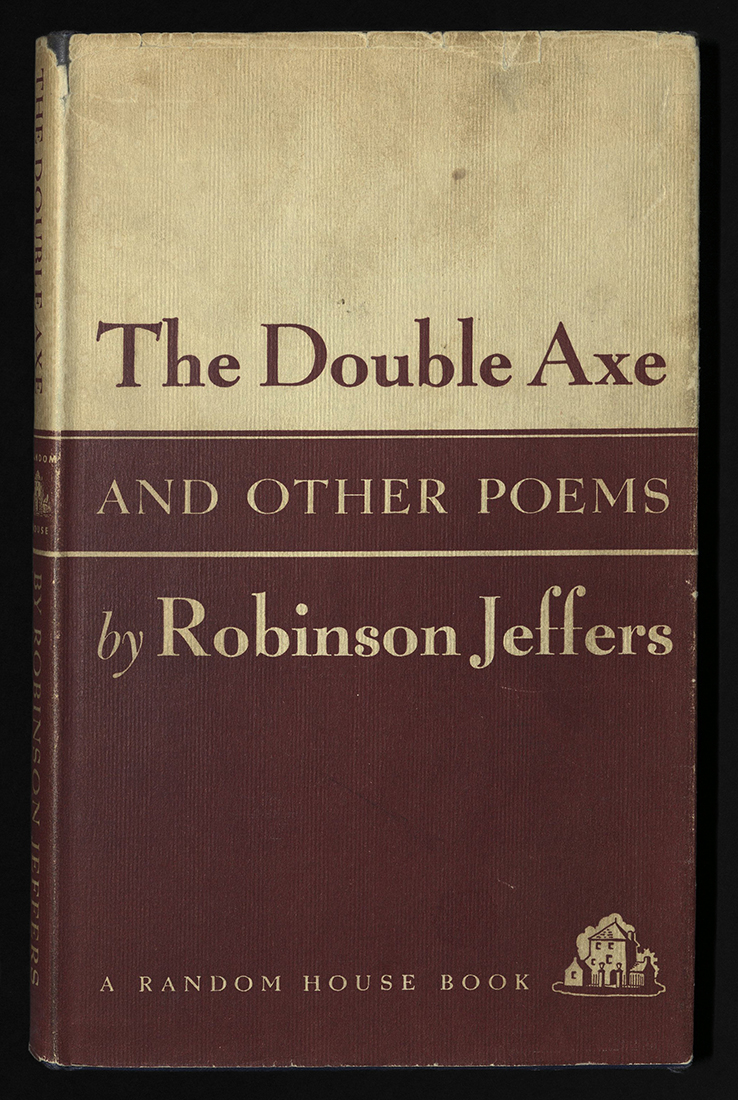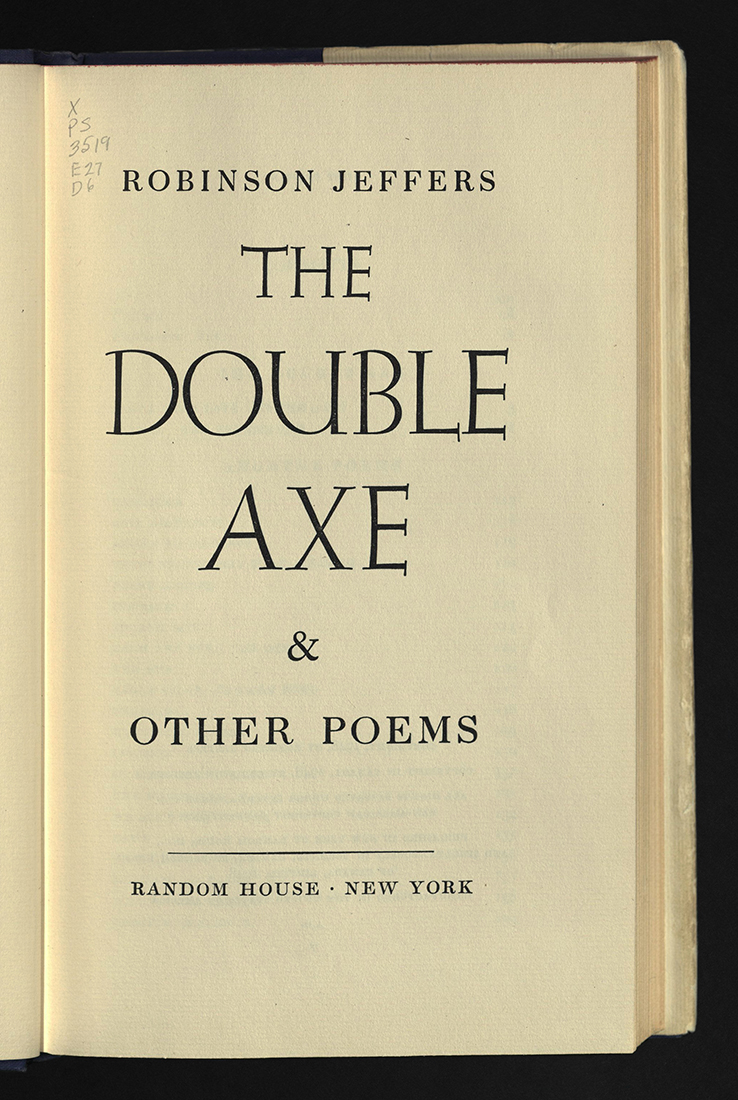Roar of Distant Breakers
An Incomplete, Illustrated, Chronological Bibliographic Tour of the European Encounter with the American West.
Checklist for Roar of Distant Breakers
Curated by Luise Poulton, 2021
Digital exhibition produced by Lyuba Basin, 2021
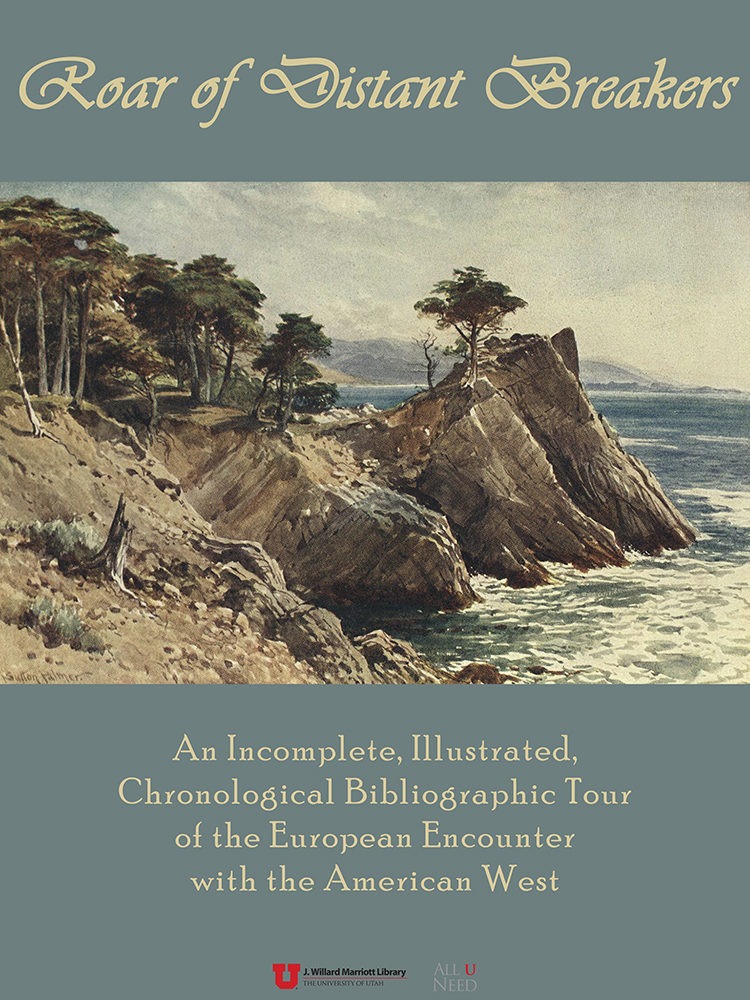
ROAR OF DISTANT BREAKERS...
Every culture has its legends.
The books in this exhibition reflect journeys west, across vast land and sea scapes, by the descendants of a people desperate to find freedom, independence, peace, autonomy, and gold. These people, Europeans, found all these things and more on the North American continent. Their discoveries came at a high price for the peoples who had inhabited the continent for thousands of years. The result for them was nothing short of devastating. From the report of Cabeza de Vaca in the sixteenth century to the fiction of Wallace Stegner in the twentieth century, the narratives here are first-hand tellings from Europeans by birth, ancestry, culture, and ideology. These tellings became legend, for good or for bad, creating a distinctly American mythology – a mythology of reorder within a morally privileged space, a defining of possibility. They became the voice of the character of America – its culture and its society – enticing other voices to join in the American dream for freedom, independence, peace, autonomy, and, yes, gold.
This exhibition is dedicated to Gregory C. Thompson, Ph.D, Associate Dean for Special Collections, whose lively, generous, and patient leadership enables extraordinary opportunity for the growth of Special Collections and for the ability of the collections to be engaged with by people around the world.
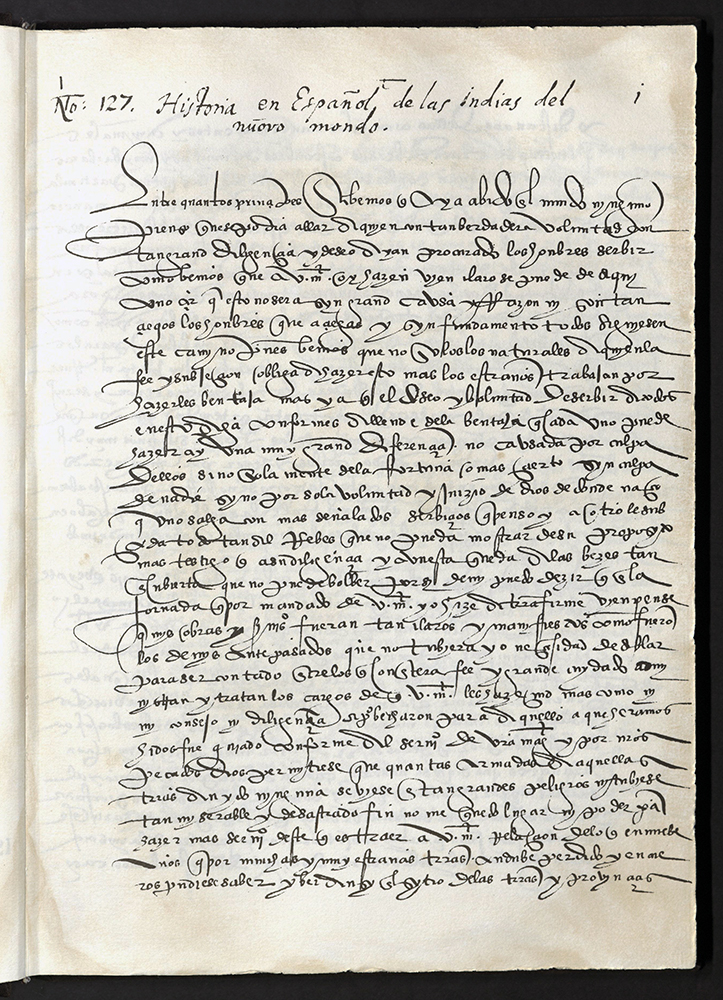
All over the land are vast and handsome pastures, with good grass for cattle, and it strikes me the soil would be very fertile were the country inhabited and improved by reasonable people.
HISTORIA EN ESPANOL DE LAS INDIAS DEL NUOVO MUNDO
Álvar Núñez Cabeza de Vaca (ca. 1488-ca. 1560)
Espana : G. Blazquez, 1996
E125 N9 N85 1996
Facsimile
Álvar Núñez Cabeza de Vaca arrived on the Florida peninsula in 1527, shipwrecked after a harrowing voyage from Cuba. Held in captivity for six years by several groups of Native Americans, only he and three others of his original party survived. The small band, including a North African, Estebanico, made their way overland to the Bay of California. They traveled across Texas, up the Rio Grande, and into southern New Mexico. From there they crossed into Arizona and traveled south to a Spanish outpost. They were the first Europeans to cross the North American continent.
On their approach to the southern tip of the Great Plains, they saw buffalo. Cabeza de Vaca wrote, “These cows come from the north, across the country further on… and are found all over the land… On this whole stretch, through the valleys by which they come, people who live there descend to subsist on their flesh. And a great quantity of hides are met within land.”
According to Cabeza de Vaca, the men were treated as supernatural emissaries and healers by the Native American tribes they met along the way. To the south, toward Mexico, they encountered land and people ravaged by Christians and European slavers. Cabeza de Vaca barely managed to keep his Native American escorts out of their hands.
Estabanico would later lead a Franciscan friar back to the future northern New Mexico to find the towns Cabeza de Vaca had despaired of finding, preparing the way for a larger expedition of Spaniards led by Francisco Vasquez de Coronado. The Zunis, rightly suspicious of his motives, killed Estabanico, leaving Friar Marcos to return to Mexico with faulty stories of wealthy cities. These cities turned out to be the pueblos.
Cabeza de Vaca’s story of his odyssey, written in 1542, was an official report to the king of Spain, detailing the hardships of the expedition and his unintentional exploration of what is now Mississippi, Arkansas, Colorado, New Mexico, Arizona and California. What Cabeza de Vaca saw and described were peoples, rivers, mountains, and plains all, until then, unknown to Europeans.
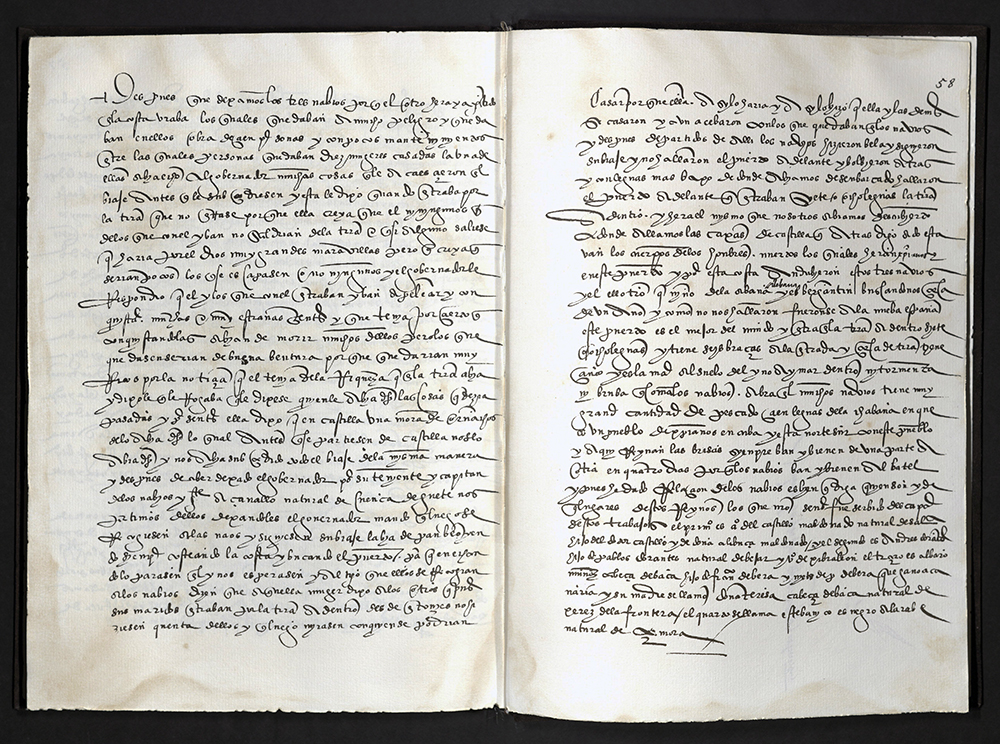
TRAVELS THROUGH THE INTERIOR PARTS OF NORTH-AMERICA IN THE YEARS 1766, 1767, AND 1768
Jonathan Carver (1710-1780)
London: Printed for the author, sold by J. Walter [etc.], 1778
First edition
F597 C33
Peace between Great Britain and France at the close of the French and Indian Wars in 1763 brought eastern Minnesota under the British flag, thus opening the vast territory to British fur traders. At the time, Jonathan Carver was the mapmaker and advance man on an expedition led by Captain James Tute. Inspired by Major Robert Rogers, commandant at Fort Mackinac, the expedition party intended to cross the continent in quest of the Northwest Passage. In advance of this attempt, Carver spent the winter of 1766 with the Sioux along the Minnesota River. He traveled further west than any other English explorer before the American Revolution. In the end, the original plan was abandoned, but Carver’s account of his adventures became a best seller of its day. Thousands of copies were sold in North America and in Europe, giving readers their first glimpse of Minnesota territory.
Illustrated with two engraved folding maps and four engraved plates (one a view of the Falls of St. Anthony, which is the first illustration of both the Falls and what is now the site of Minneapolis.)
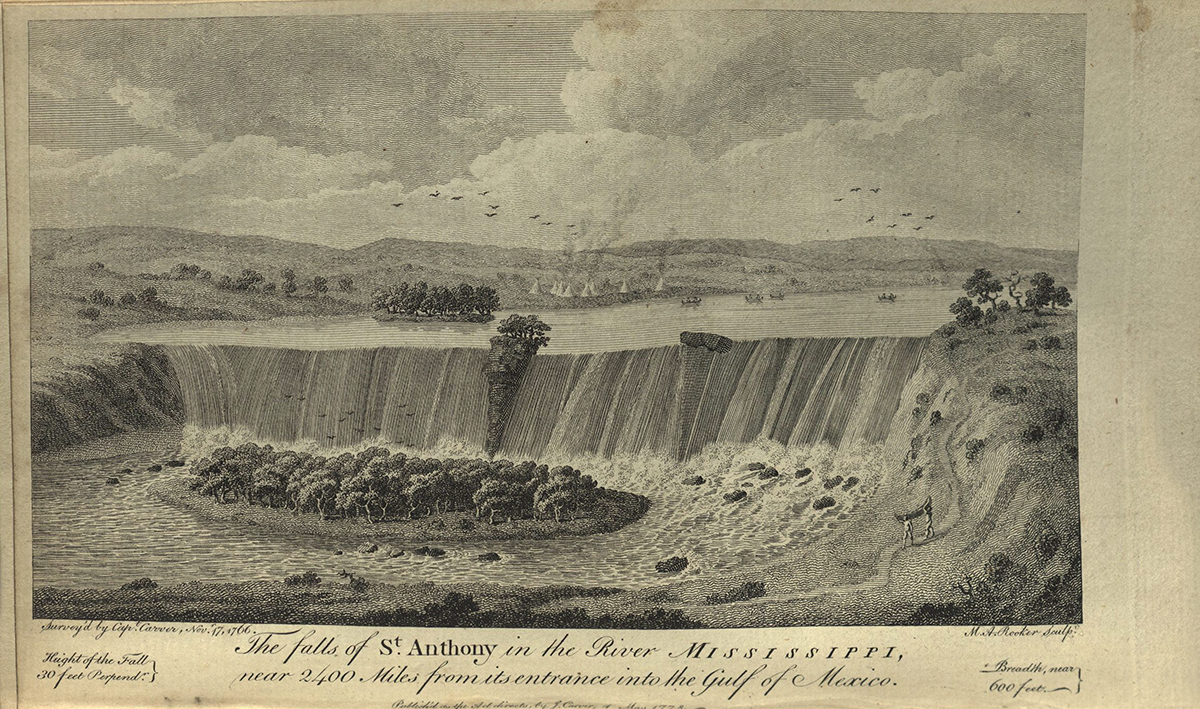
The country around them is extremely beautiful. It is not an uninterrupted plain where the eye finds no relief, but composed of many gentle ascents, which in the summer are covered with the finest verdure, and interspersed with little groves, that give a pleasing variety to the prospect.
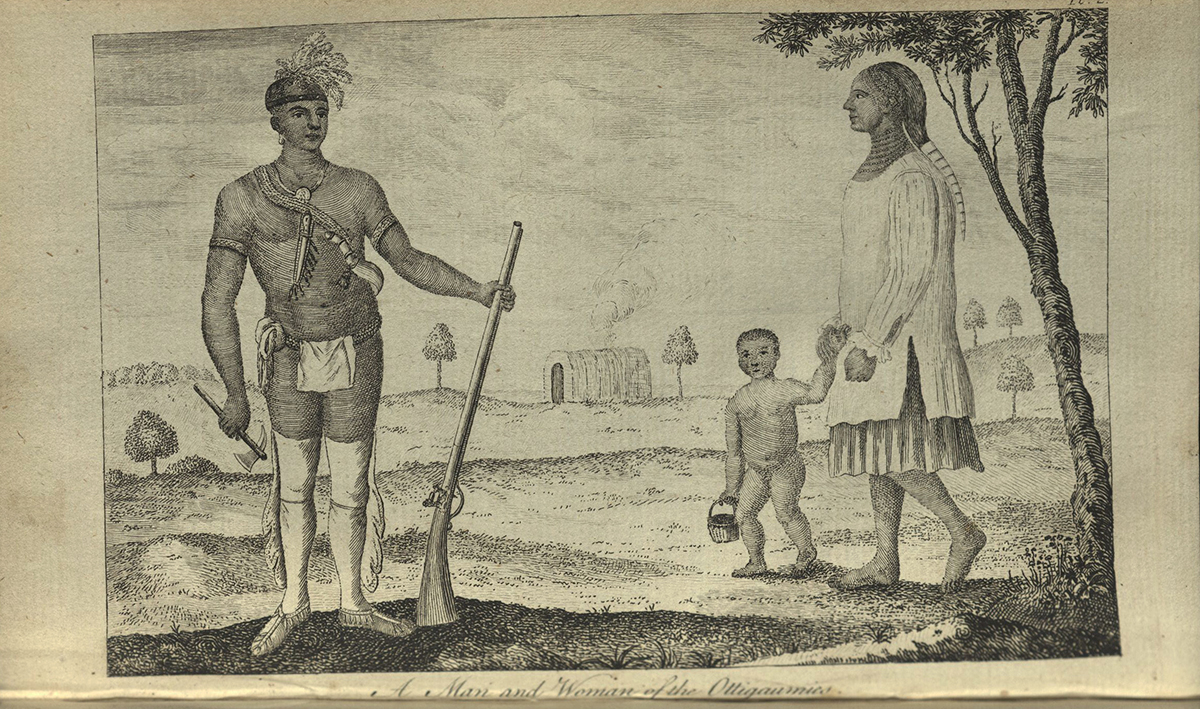
They go without any covering for the thigh, except… round the middle, which reaches down half way the thighs; but they make for their legs a sort of stocking either of skins or cloth: these are sewed as near to the shape of the leg as possible, so as to admit of being drawn on and off. The edges of the stuff of which they are composed are left annexed to the seam, and hang loose for about the breadth of a hand: and this part, which is placed on the outside of the leg, is generally ornamented by those who have any communication with Europeans, if of cloth, with ribands or lace, if of leather, with embroidery and porcupine quills curiously coloured. Strangers who hunt among the Indians in the parts where there is a great deal of snow, find these stockings much more convenient than others.
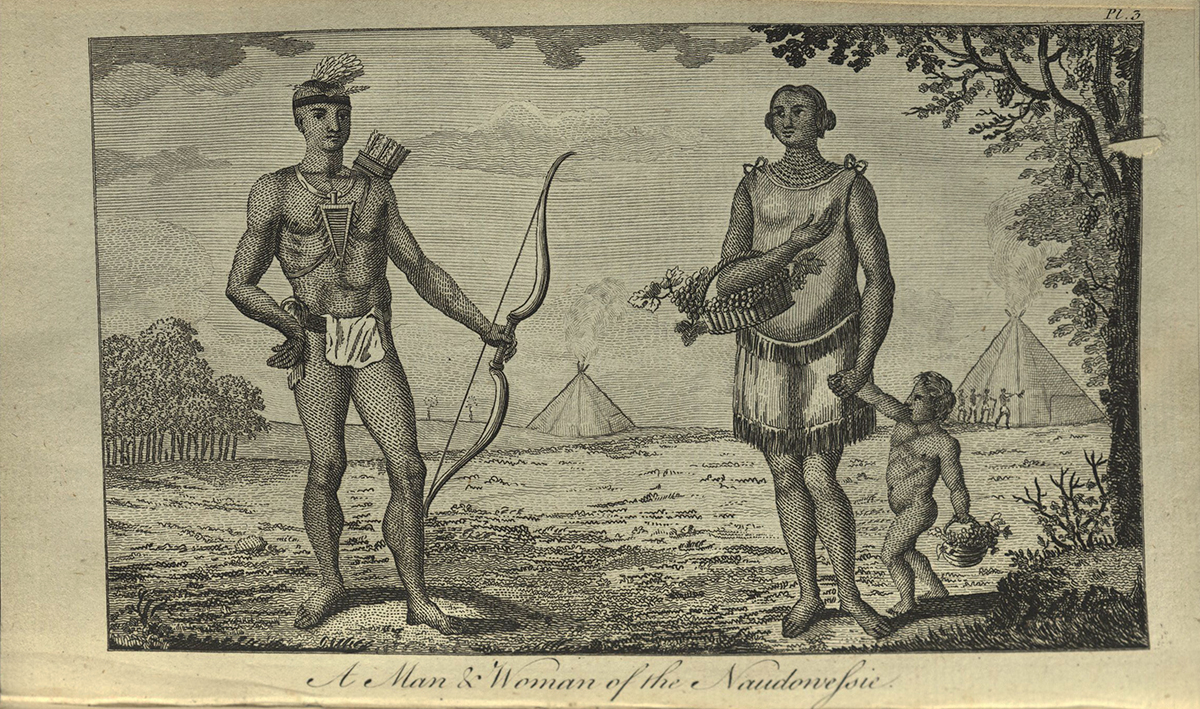
But the women that live to the west of the Mississippi, viz. the Naudowessies, the Assinipoils, &c. divide their hair in the middle of the head, and form it into two rolls, one against each ear. These rolls are about three inches long, and as large as their wrists. They hang in a perpendicular attitude at the front of each ear, and descend as far as the lower part of it.
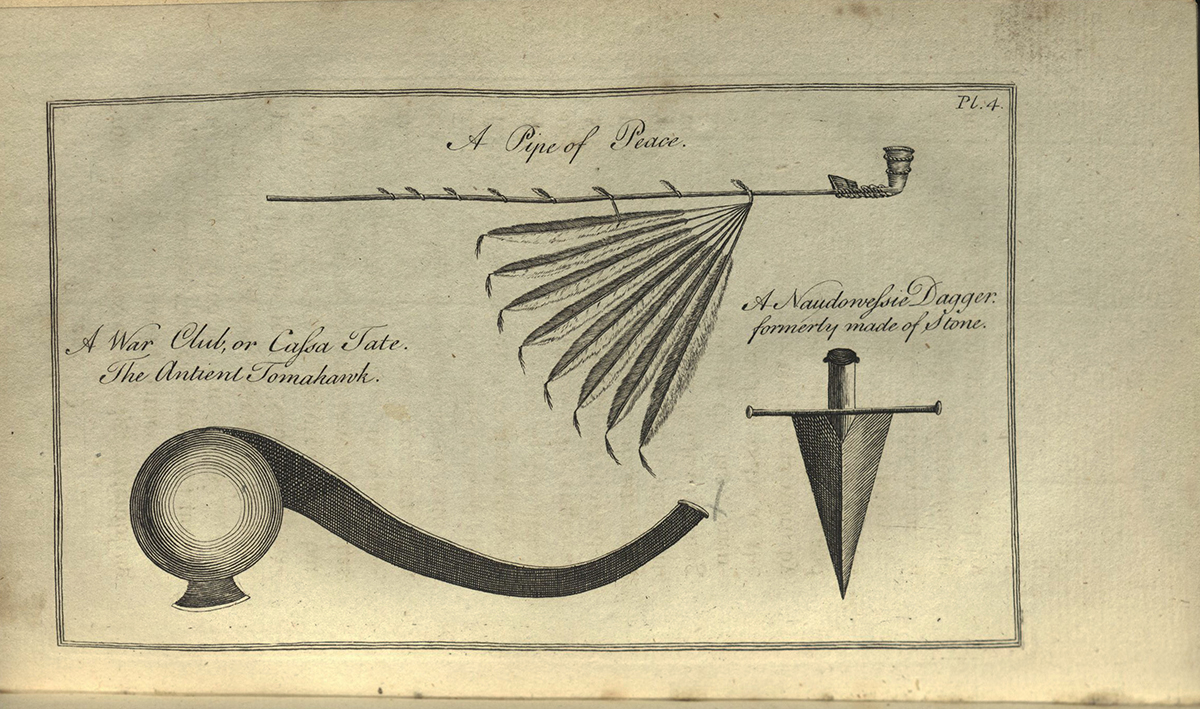
The dagger… is peculiar to the Naudowessie nation, and of ancient construction, but they can give no account how long it has been in use among them. It was originally made of flint or bone, but since they have had communication with the European traders, they have formed it of steel. The length of it is about ten inches, and that part close to the handle nearly three inches broad. Its edges are keen, and it gradually tapers towards a point…This curious weapon is worn by a few of the principal chiefs alone, and considered both as a useful instrument, and an ornamental badge of superiority.
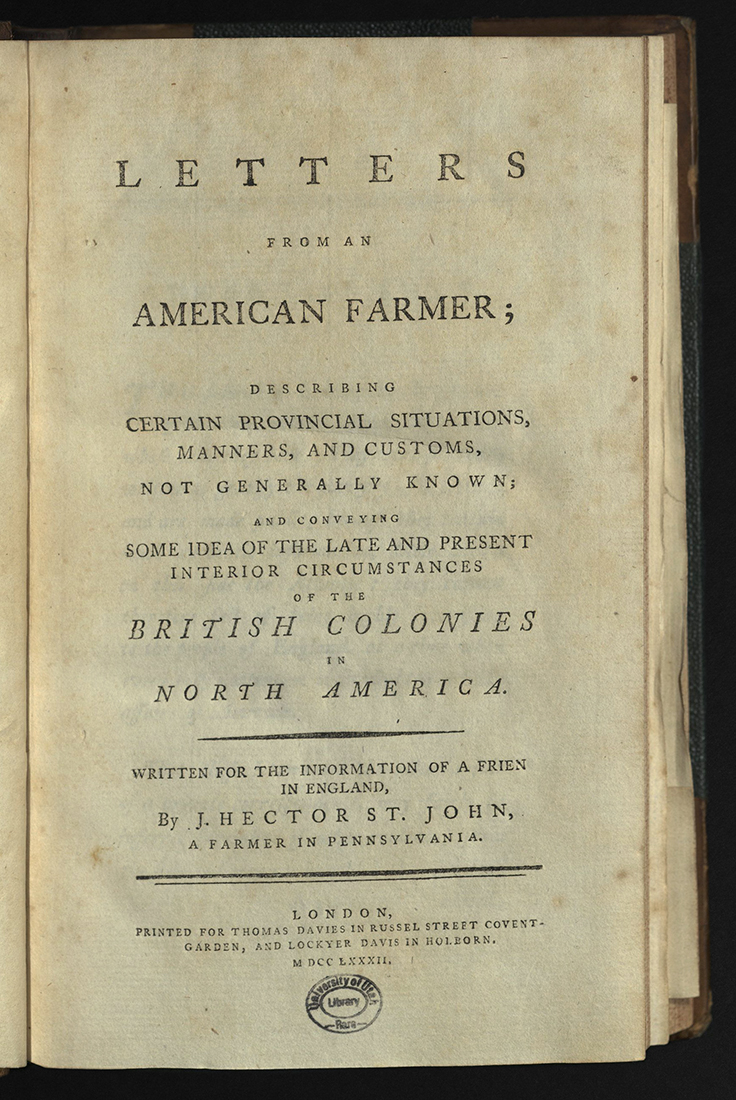
The American is a new man, who acts upon new principles; he must therefore entertain new ideas, and form new opinions... Here individuals of all nations are melted into a new race of men, whose labours and posterity will one day cause great changes in the world... An immigrant when he first arrives... no sooner breathes our air than he forms new schemes, and embarks in designs he never would have thought of in his own country... He begins to feel the effects of a sort of resurrection; hitherto he had not lived, but simply vegetated; he now feels himself a man... Judge what an alteration there must arise in the mind and thoughts of this man; ... his heart involuntarily swells and glows; this first swell inspires him with those new thoughts which constitute an American.
LETTERS FROM AN AMERICAN FARMER ...
J. Hector St. John de Crevecoeur (1735-1813)
London: Printed for Thomas Davies, 1782
First edition
E163 C82
Not long after the American Revolution, J. Hector St. John de Crevecoeur, a French observer of American society, asked a question that Americans would grow fond of answering: “What, then, is the American, this new man?” Crevecoeur spent three decades pioneering and traveling in the American West, offering up a theory of frontier influence on the American character. The maps of Martha’s Vineyard and Nantucket are apparently the first separately printed delineations of those islands.
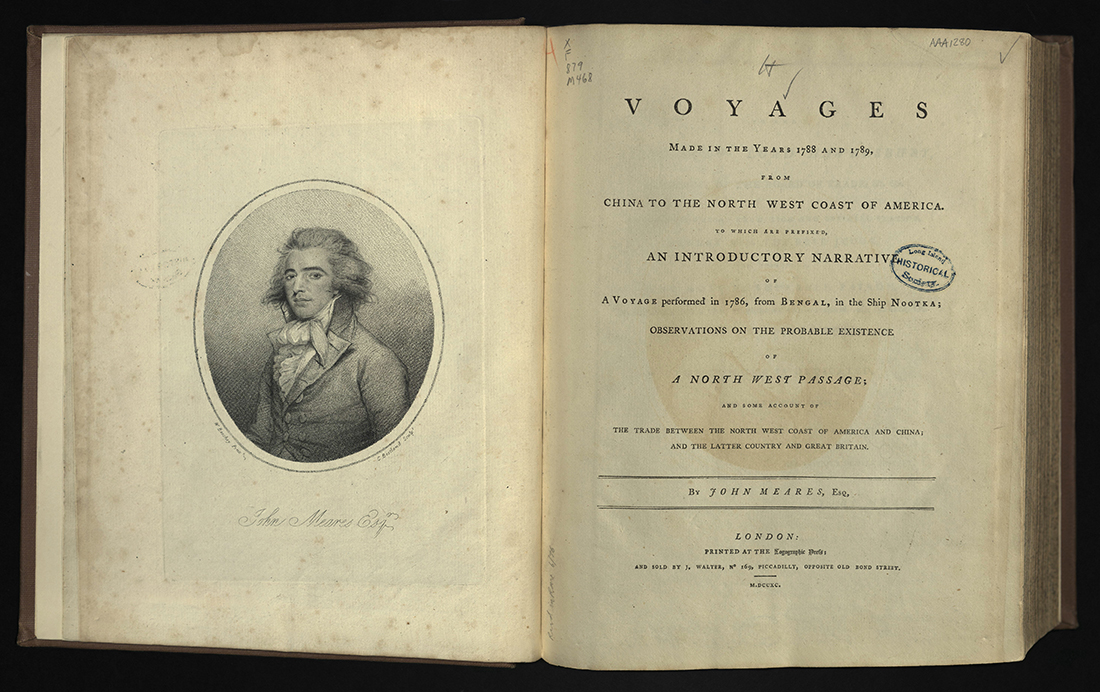
VOYAGES MADE IN THE YEARS 1788 AND 1789 ...
John Meares (1756-1809)
London: Printed at the Logographic Press, 1790
First edition
F879 M468
John Meares was a lieutenant in the British Navy and fought in the American Revolution. He became a captain in the merchant service and established a company in Calcutta for developing trade with Northwest American settlements. In 1786, Meares sailed on the ship Nootka for Prince William Sound and after securing a right of free trade from the native tribes there, returned to China.
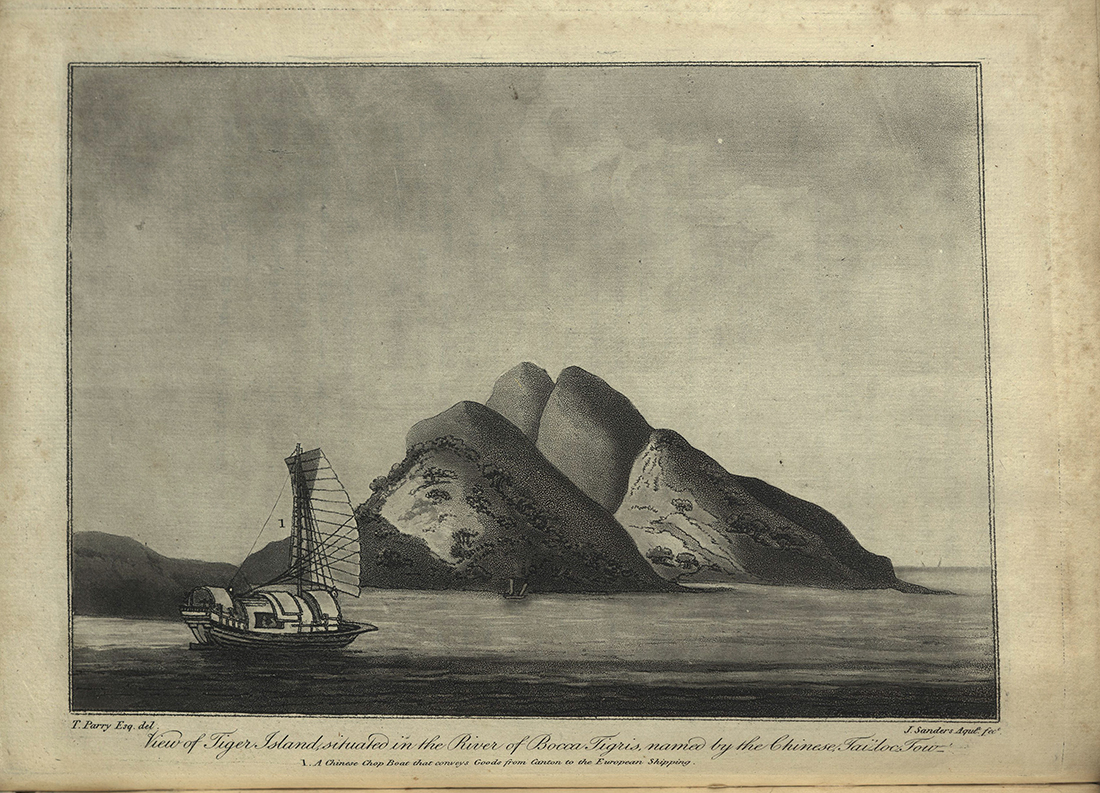
All Europeans are prohibited from entering the city of Canton; and if any should persist in paying it a clandestine visit, as some have done, they are severely bambooed and turned back again. The Chinese call an European a Fanqui.
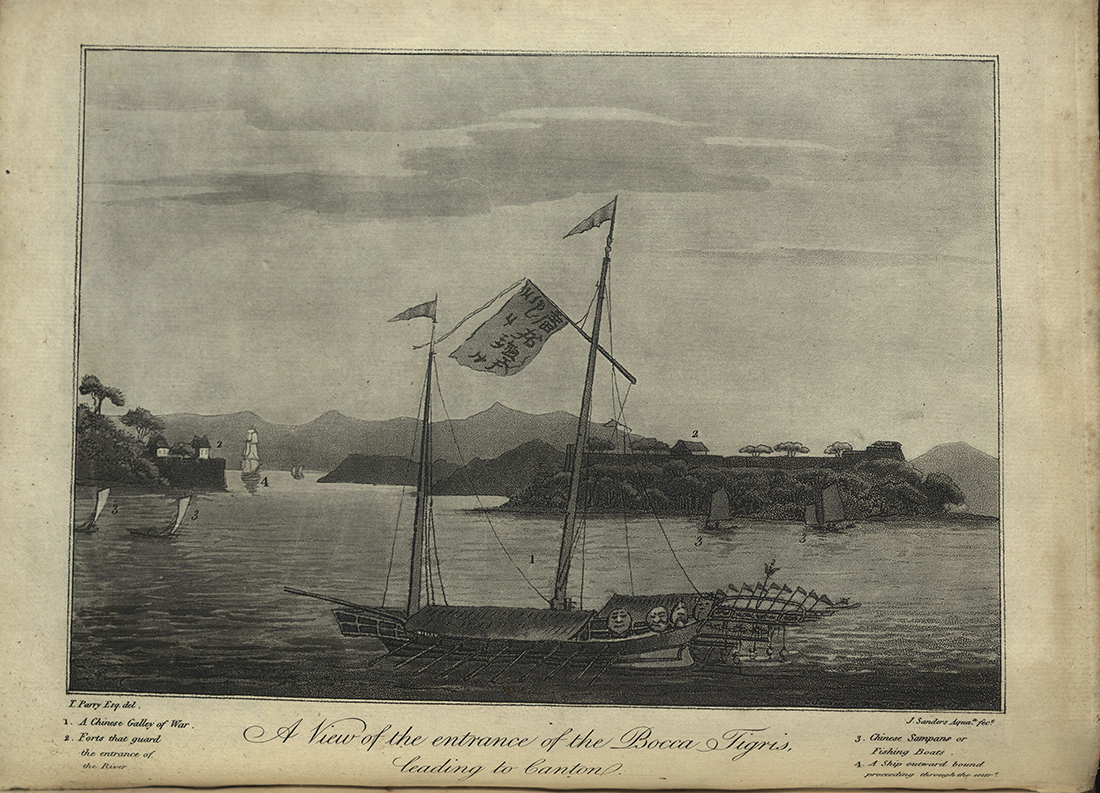
It is indeed a very evident, as well as mortifying proof, that the English name does not possess that consequence with the Chinese, which it merits in every country and corner of the globe, from their conduct towards the East India Company’s servants, who constantly remove to the Portuguese city of Macao for several months of the year.
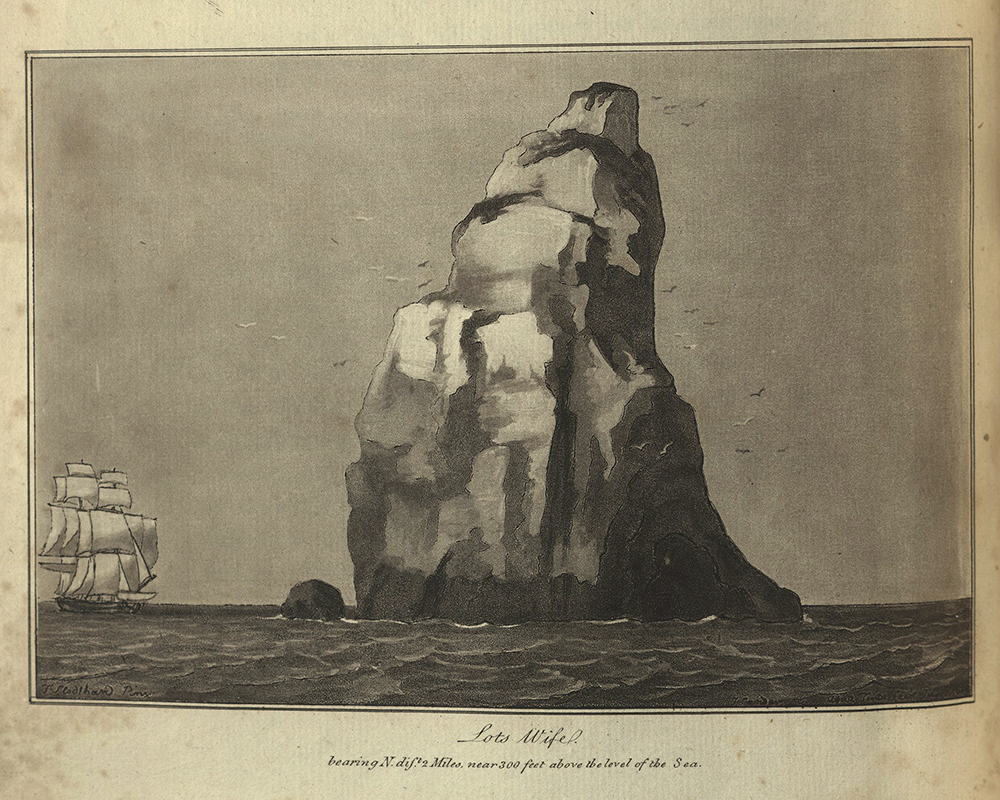
Its appearance did, indeed, very strongly resemble a first-rate man of war, under a croud of sail; and such was its shape, that, at a certain distance, it held forth to the eye the form of every particular sail belonging to a ship. As we ranged up with this rock, our surprise was proportionably augmented, and the sailors were more disposed to believe that some supernatural power had suddenly transformed it into its present shape. It obtained the name of Lot’s Wife, and is one of the most wonderful objects, taken in all its circumstances, which I ever beheld.
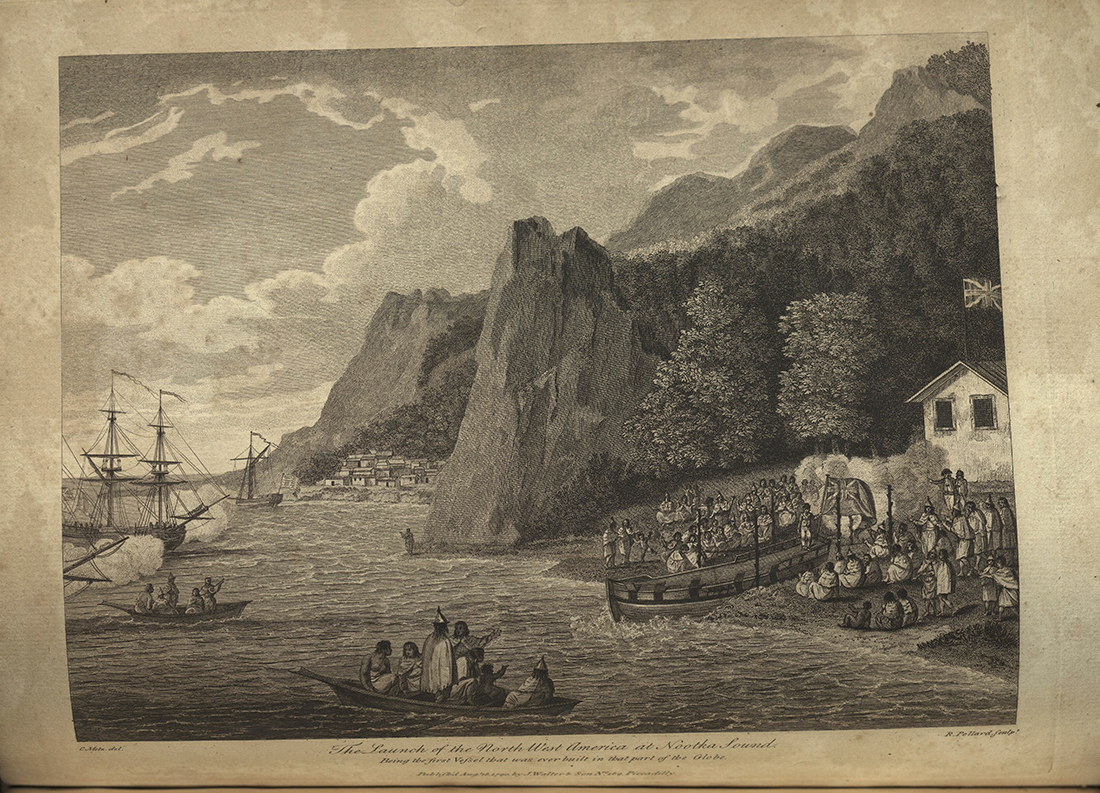
As soon as the tide was at its proper height, the English ensign was displayed on shore at the house, and on board the new vessel, which, at the proper moment, was named the North West America, as being the first bottom every built and launched in this part of the globe.
For this voyage to the American coast, Meares used false papers in order to evade Spanish claims to the coast and circumvent two royally chartered monopolies. The Indians called him “Aitaaita Meares,” or “Lying Meares.” Meares was asked by a legitimate British trader to never return to America, to which he agreed. In 1789, using false papers again, he dispatched the Argonaut and Princess Royal to meet a third, the Iphigenia, in Nootka Sound on the coast of Vancouver Island. The Iphegenia arrived first and was attacked by Spanish ships. The Spaniards claimed the area as their own, seizing the Argonaut and Princess Royal when they arrived. Meares protested to the British government and the House of Commons demanded reparation from the Spanish government. The Spanish were not quick to provide restitution and the English assembled a large fleet to go against them. The political excitement over this stand-off caused great interest in Meares’ activities and encouraged him to write of his travels. The publication of this work led to even more controversy in England. Its accuracy was questioned by many. Nonetheless, Meares’ book helped British claims to the northwest coast of the American continent.
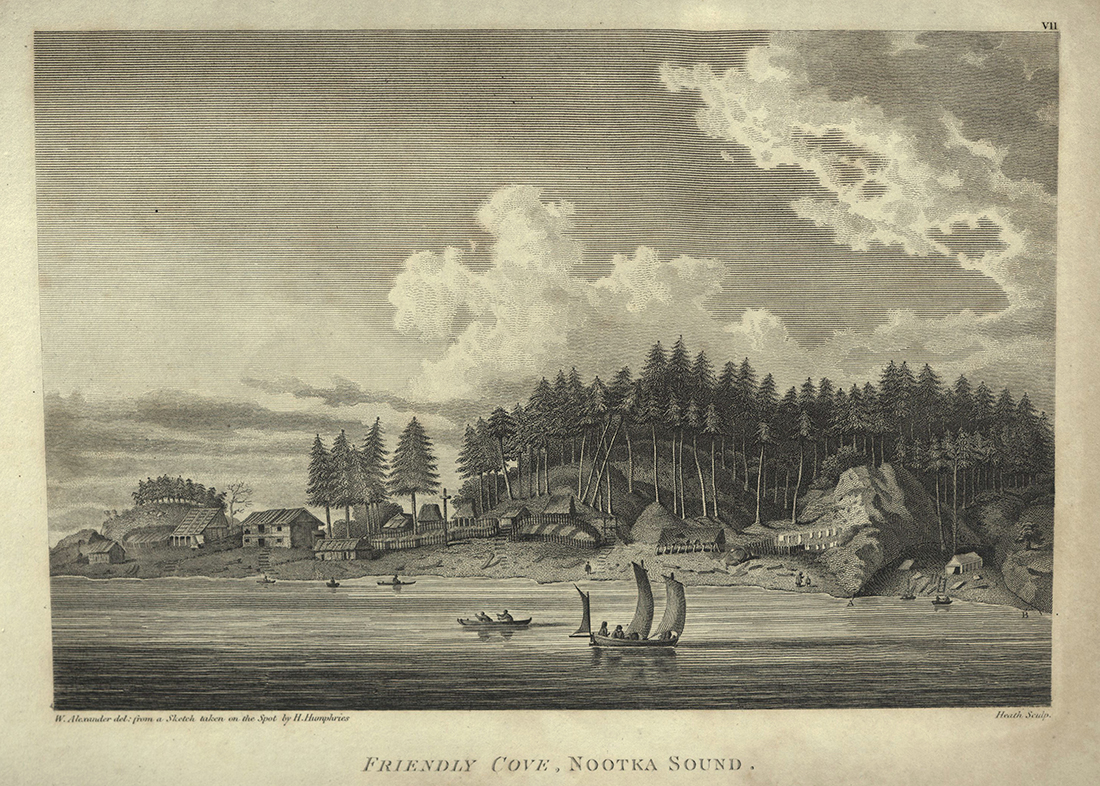
This was the real situation of things, says Senor Quadra, who offers to demonstrate in the most unequivocal manner that the injuries, prejudices, and usurpations, as represented by Captain Meares, were chimerical: that Martinez had no orders to make prize of any vessels, nor did he break the treaty of peace, or violate the laws of hospitality: that the natives will affirm, and that the documents accompanying his letter will prove, that Mr. Meares had no other habitation on the shores of Nootka than a small hut, which he abandoned when he left the place, and which did not exist on the arrival of Martinez: that he bought no land of the chiefs of the adjacent villages; that the Ephigenia did not belong to the English; that Martinez did not take or detain the least part of her cargo;… These circumstances duly considered, adds Senor Quadra, it is evident that Spain has nothing to deliver up, nor damage to make good; but that he was desirous of removing every obstacle to the establishment of a solid and permanent peace, he was ready, without prejudice to the legitimate right of Spain, to cede to England the houses, offices, and gardens, that had with so much labour been erected and cultivated… observing at the same time, that Nootka ought to be the last or most northwardly Spanish settlement, that there the dividing point should be fixed, and that from thence to the northward should be free for entrance, use and commerce to both parties…
A VOYAGE OF DISCOVERY TO THE NORTH PACIFIC OCEAN ...
George Vancouver (1757-1798)
London: Printed for G. G. and J. Robinson, etc., 1798
First edition
G420 V22 1798
George Vancouver, who had served with Captain Cook’s second and third voyages, was made commander of a grand-scale expedition to reclaim from the Spanish British rights resulting from the Nootka Convention at Nootka Sound. He was to thoroughly examine the California coast in order to find a possible passage to the Atlantic and to learn what establishments had been founded by other powers. Vancouver surveyed the northwest coast, visited San Francisco and Monterey, spent the winter in the Sandwich Islands, returned to California and revisited San Francisco. He then went on to Cape Mendocino, Bodega Bay and back to Monterey. He visited the Sandwich Islands again, took possession of Owhyhee and then returned again to the northwest coast and on back to Monterey. From there he set sail to return to England by Cape Horn.
In 1792, Vancouver became the first European to explore Puget Sound. Vancouver’s voyage exploring the northwest coast of America produced the first accurate charts of the area. Vancouver, a self-conscious imperialist, was bent on expanding the English empire. He claimed an enormous unexplored interior basin for Britain, a chunk of territory whose size no one knew and with an enormous river whose source was unknown.
Illustrated with seventeen engravings, including views of the Mission of San Carlos and the Presidio of Monterey thought to be the first published views of California; one small map; and eight folding maps.
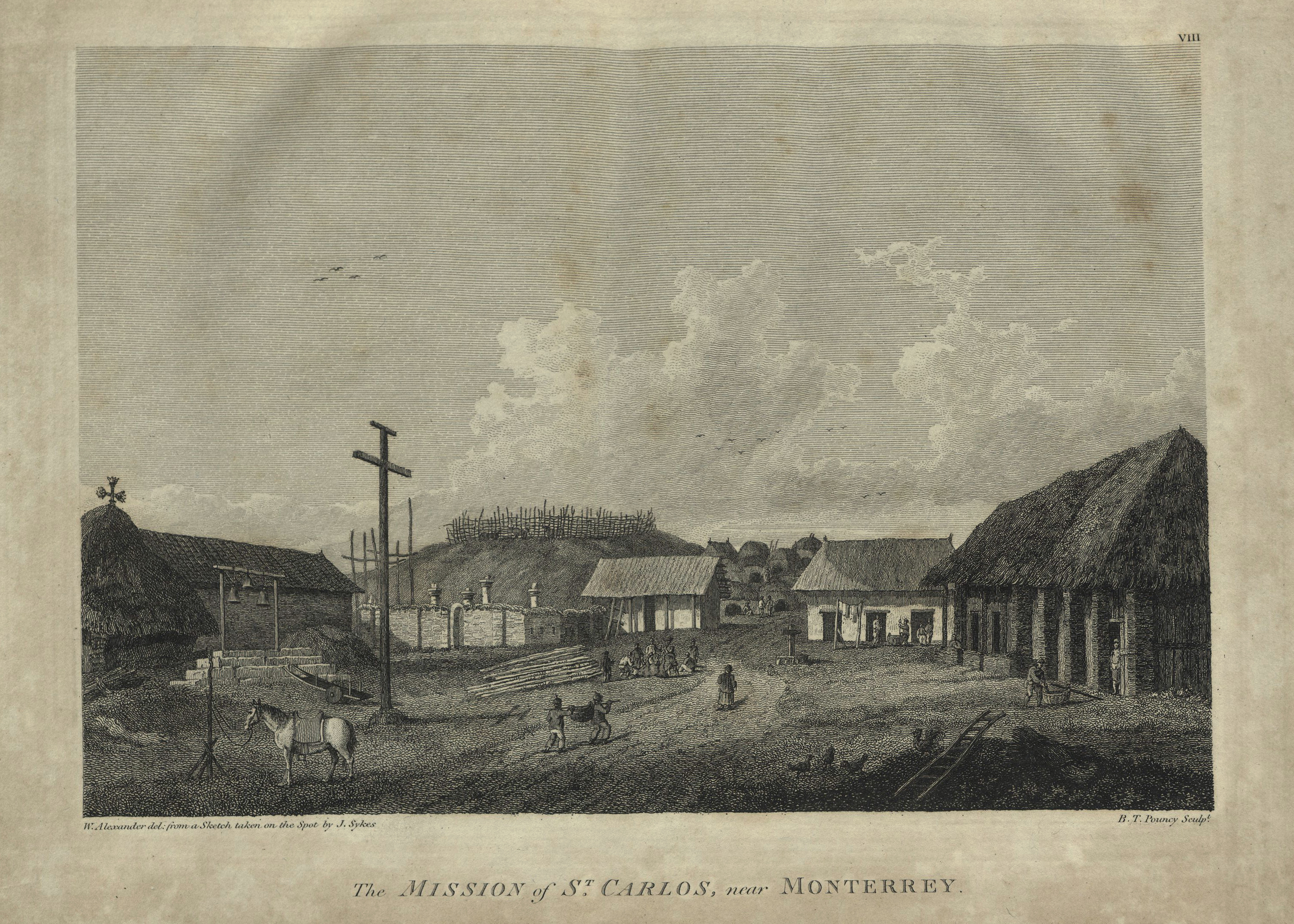
On our arrival, we were received by the reverend fathers with every demonstration of cordiality, friendship, and the most genuine hospitality… The houses were constructed nearly after the manner of those at the presidio, but appeared to be more finished, better contrived, were larger, and much more cleanly.
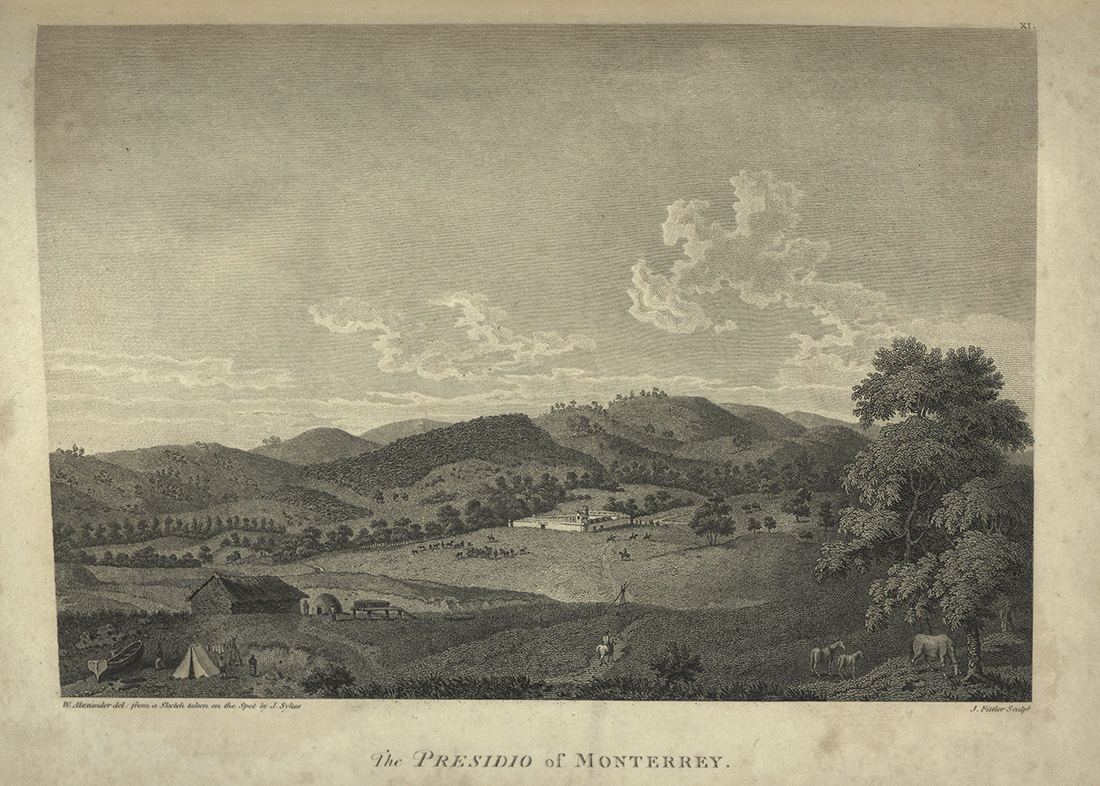
... when I visited him at the Presidio; I was reduced to the necessity of sending him the next day the full explanation of the objects of our voyage, and of the motives that had induced me to enter the ports under his jurisdiction. In this I stated, that I had been intrusted by His Britannic Majesty with a voyage of discovery, and for the exploring of various countries in the pacific ocean; of which the north-west coast of America was one of the principal objects.
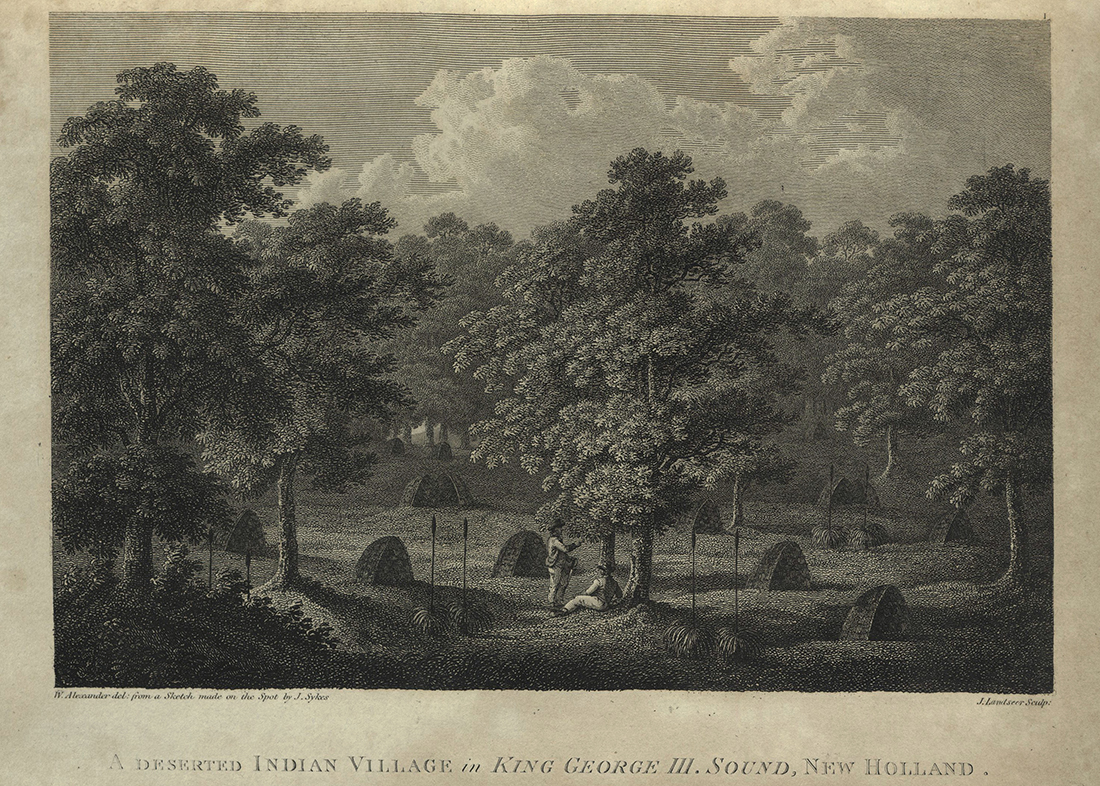
The native appeared to be a wandering people, who sometimes made their excursions individually, at other times in considerable parties; this was apparent by their habitations being found single and alone, an well as composing tolerably large villages.
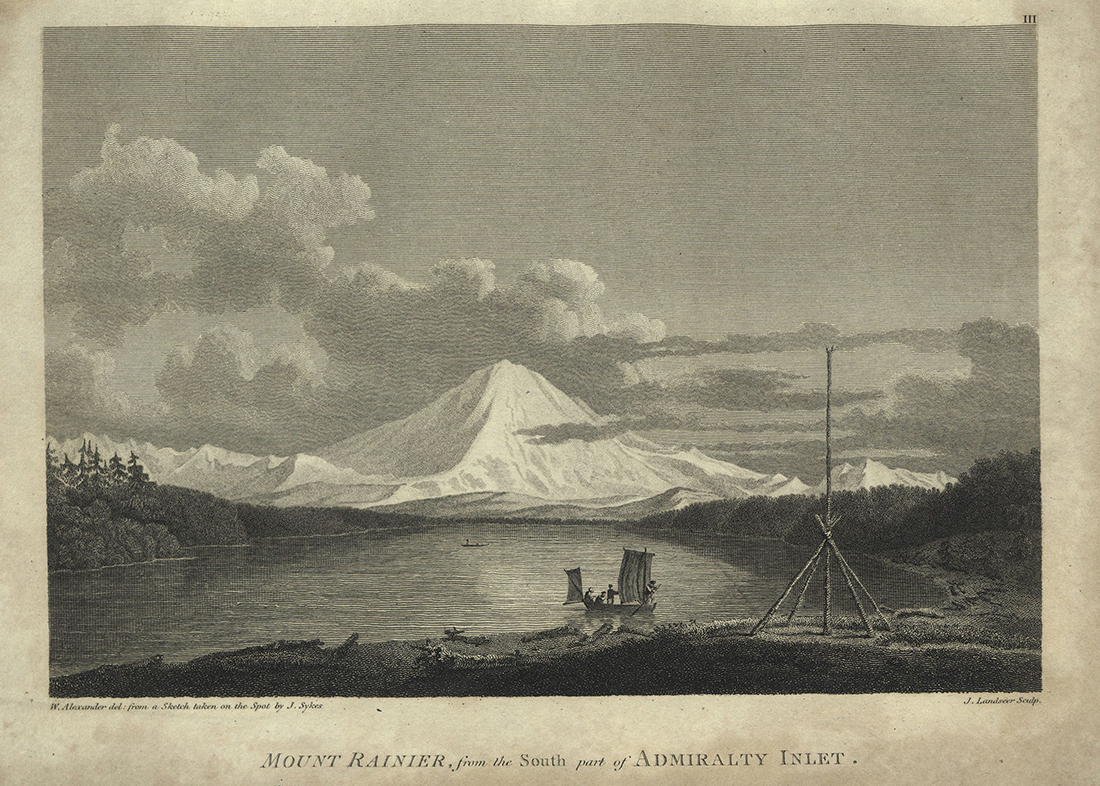
For having passed round the point, we found the inlet to terminate here in an extensive circular compact bay, whose waters washed the base of mount Rainier, though its elevated summit was yet at a very considerable distance from the shore, with which it was connected by several ridges of hills rising towards it with gradual ascent and much regularity. The forest trees and the several shades of verdure that covered the hills gradually decreased in point of beauty until they became invisible; when the perpetual clothing of snow commenced, which seemed to form a horizontal line from north to south along this range of rugged mountains, from whose summit mount Rainier rose conspicuously, and seemed as much elevated above them as they were above the level of the sea; the whole producing a most grand, picturesque effect.
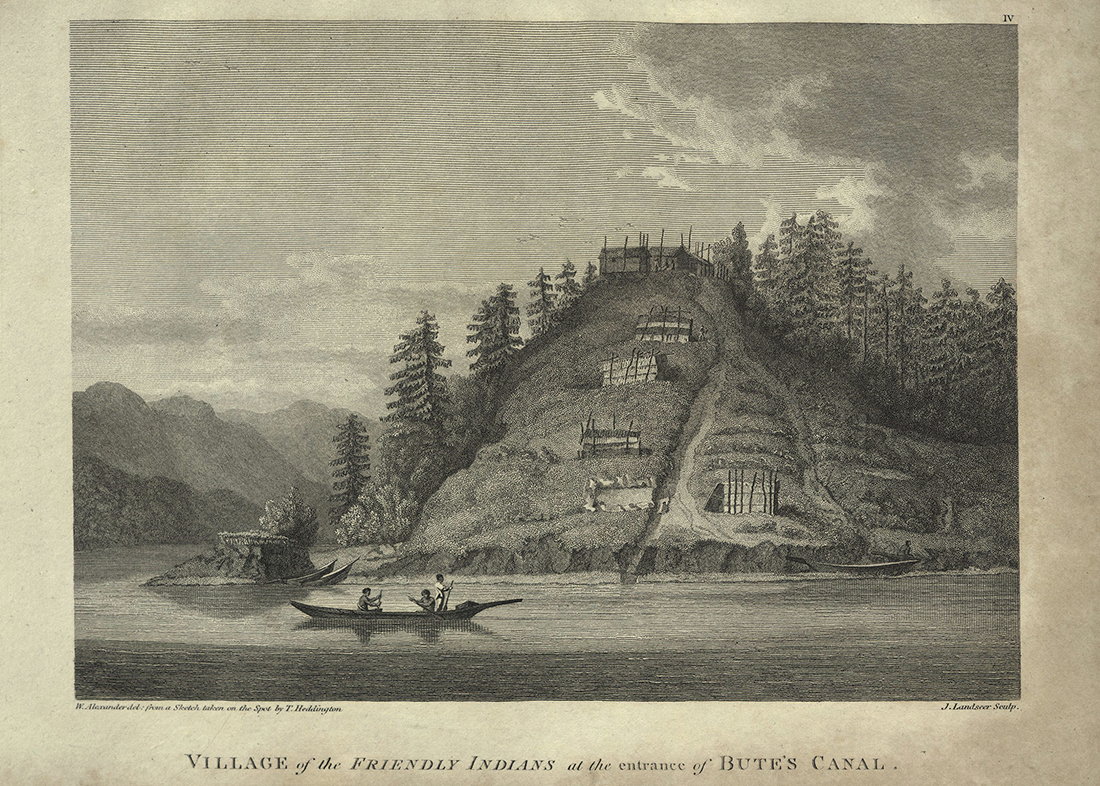
Here was found an Indian village, situated on the face of a steep rock, containing about one hundred and fifty of the natives, some few of whom had visited our party in their way up the canal, and now many came off in the most civil and friendly manner, with a plentiful supply of fresh herrings and other fish, which they bartered in a fair and honest way for nails. These were of greater value amongst them, than any other articles our people had to offer.
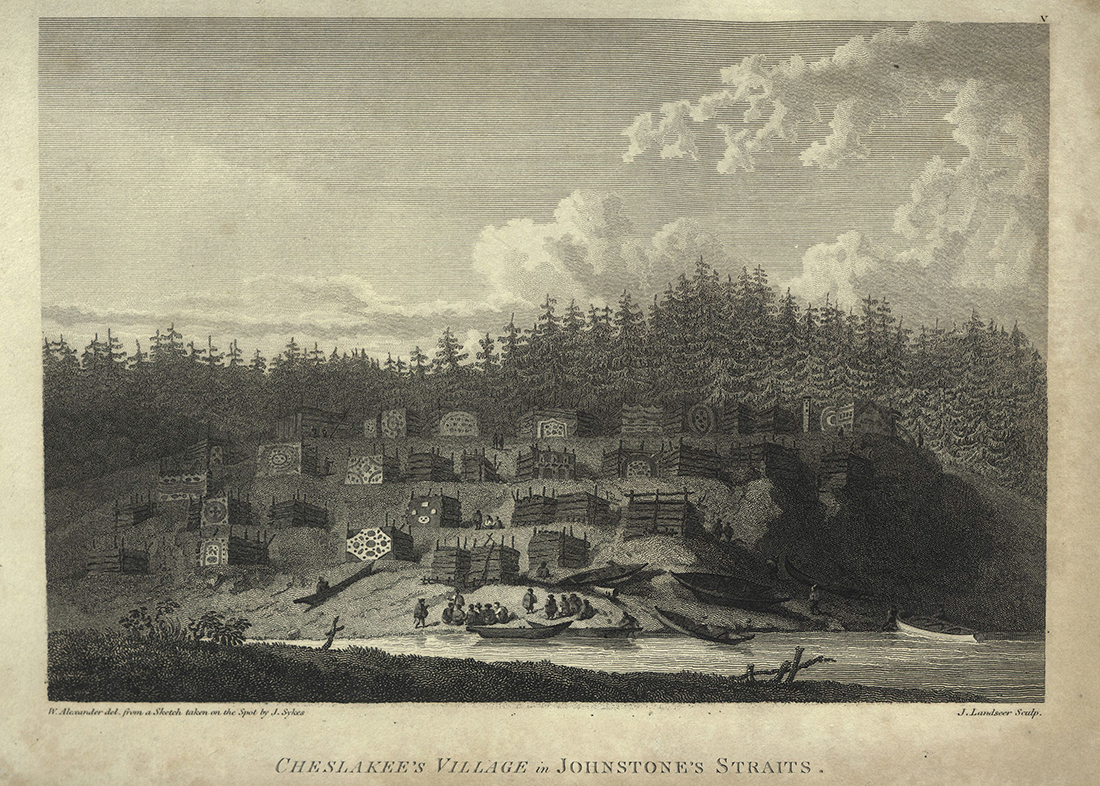
… I repaired to the village, and found it pleasantly situated on a sloping hill, above the banks of a fine fresh—water rivulet, discharging itself into a small creek or cove. It was exposed to a southern aspect, whilst higher hills behind, covered with lofty pines, sheltered it completely from the northern winds. The houses, in number thirty-four, were arranged in regular streets; the larger ones were habitations of the principal people, who had them decorated with paintings and other ornaments, forming various figures, apparently the rude designs of fancy; though it is by no means improbable, they might annex some meaning to the figures they described, too remote, or hieroglyphical, for our comprehension.
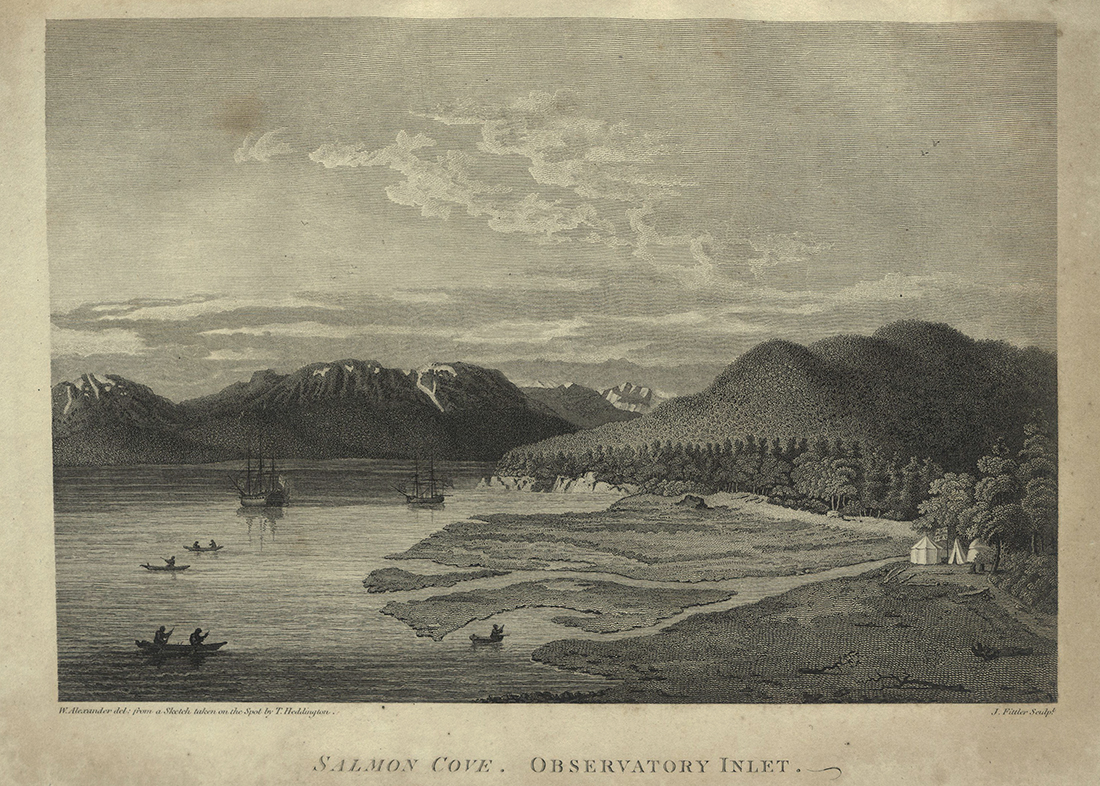
On going on shore, we found a small canoe with three of the natives, who were employed in taking salmon, which were in great abundance, up a very fine run of fresh water that flowed into the cove. Some of these fish were purchased with looking glasses and other trinkets. They were small, insipid, of a very inferior kind, and partaking in no degree of the flavor of European salmon.
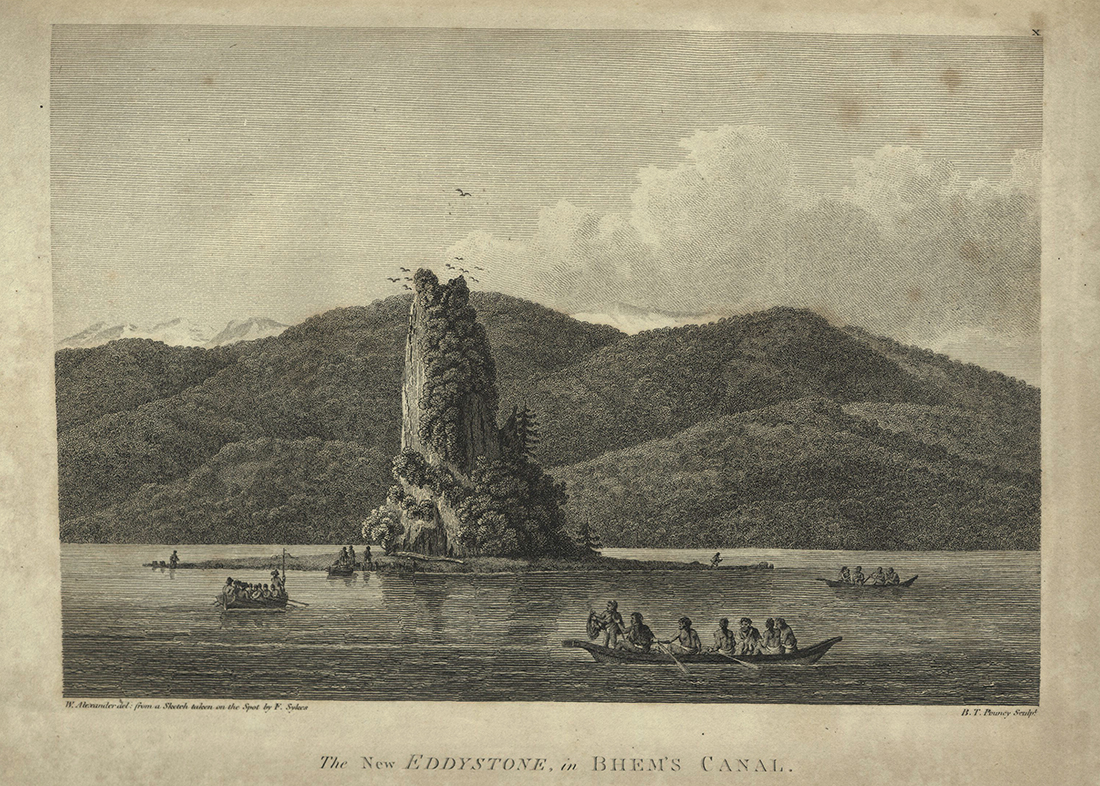
On the base of this singular rock, which, from its resemblance to the Light House rock off Plymouth, I called the New Eddystone, we stopped to breakfast, and whilst we were thus engaged, three small canoes, with about a dozen of the natives, landed and approached us unarmed, and with the utmost good humour accepted such presents as were offered to them, making signs, in return, that they had brought nothing to dispose of, but inviting us in the most pressing manner to their habitations; where they gave us to understand, they had fish skins, and other things in great abundance, to barter for our commodities, amongst which, blue cloth seemed to be the most esteemed.
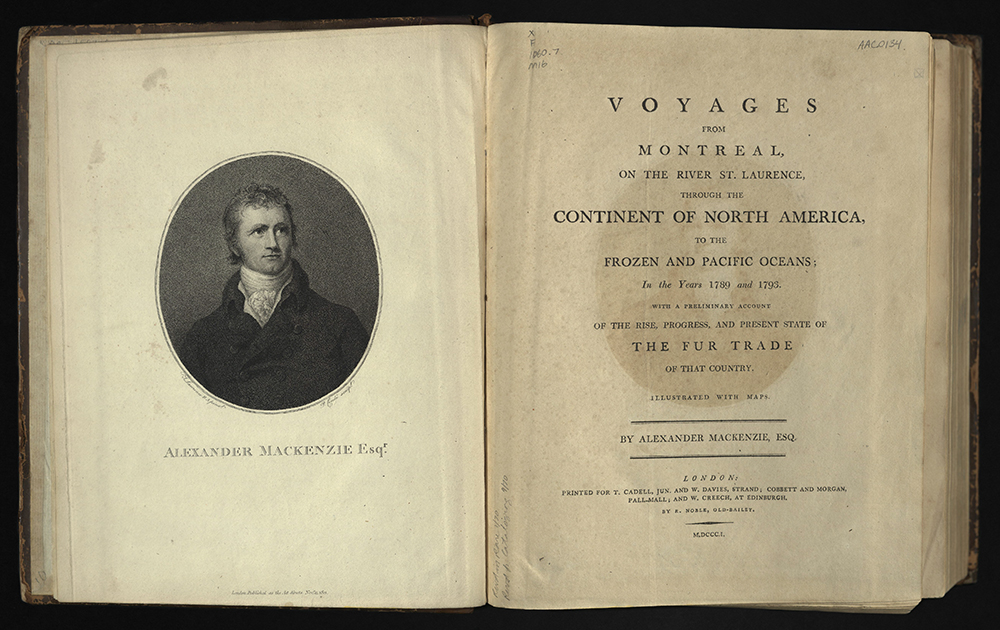
My people could not, at this time, refrain from expressions of real concern, that they were obliged to return without reaching the sea: indeed the hope of attaining this object encouraged them to bear, without repining, the hardships of our unremitting voyage. For some time past their spirits were animated by the expectation that another day would bring them to the Mer d’ouest: and even in our present situation they declared their readiness to follow me wherever I should be pleased to lead them.
VOYAGES FROM MONTREAL ...
Sir Alexander Mackenzie (1763-1820)
London: T. Cadell, jun. and W. Davies: 1801
First edition
F1060.7 M16
In 1789, Alexander MacKenzie, a Scotsman in the fur trade out of Montreal, canoed nearly three thousand miles from Fort Chipewyan, in present-day Alberta, north and west along the river that now bears his name, to the shores of the Arctic Ocean and back again. In 1793, again leaving from Fort Chipewyan, he traveled the Peace River west to the Continental Divide, reaching it a month after his journey began, and continued on foot to the Pacific, arriving thirteen days later, on July 22, 1793, thus becoming the first European to reach the Pacific Ocean by crossing the Rocky Mountains.
Using his telescope, Mackenzie spotted Jupiter and noted the time when the moons Io and Ganymede disappeared behind the planet. With this sighting, tables showing the times of the same events from Greenwich, and his sextant, Mackenzie established the latitude and longitude of his place. The British had their claim on the northwestern empire.
Back at Fort Chipewyan, Mackenzie fell into a depression and struggled to prepare his journal for publication. He left Canada and never returned. His account was probably ghostwritten – Mackenzie was not educated enough to write a publishable report. In the account of his Canadian overland journey to the Pacific, Mackenzie highlighted the stakes for whichever nation first established settlements on the Pacific Coast and the Columbia River. That nation, Mackenzie wrote, would possess “the entire command of the fur trade of North America…and the markets of the four quarters of the globe.” Whichever country first established settlements at the Columbia River would control a vast empire.
Mackenzie described his journey as “long, painful and perilous,” but he also wrote “The way to the Pacific lay open and easy.” President Thomas Jefferson immediately ordered a copy of this book, which he and Meriwether Lewis devoured. Jefferson read Mackenzie’s warnings to his British countrymen about the urgent necessity of controlling the mouth of the Columbia and the Pacific coast. News of Mackenzie’s achievement, and his recommendation that the British fur trade set up shop at the mouth of the Columbia River, spurred Jefferson to organize a response that would affirm U.S. territorial rights in the Pacific Northwest. That response grew into the Lewis and Clark expedition of 1804-06. Meriwether Lewis urged President Jefferson to create a seaport on the Pacific Rim as an outlet to China for furs from the western sector of North America and accepted his own challenge without hesitation.
Aside from plotting one way to cross the continent, Mackenzie’s report was remarkably sparse: he collected few specimens, made few descriptions, advanced nothing of worth regarding plants, animals, minerals, or native inhabitants of the country he crossed.
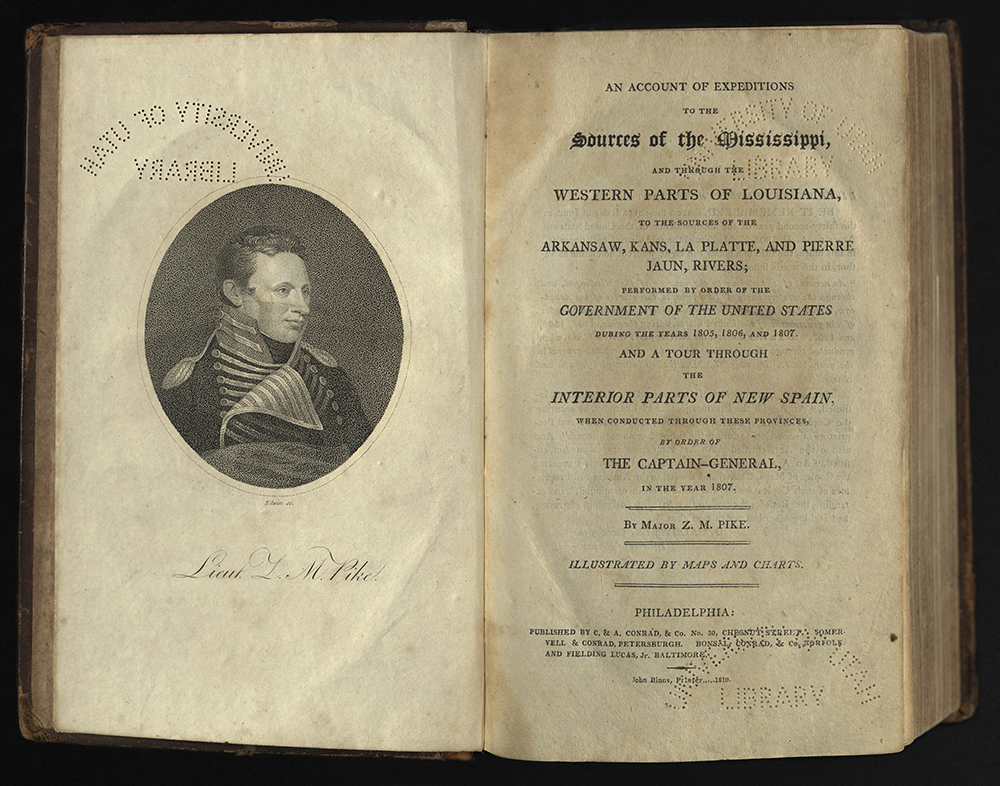
Language cannot express the gaiety of my heart, when I once more beheld the standard of my country waved aloft: -- “All hail" cried I, "the ever sacred name of country, in which is embraced the kindred, friends, and every other tie which is dear to the soul of man!!"
AN ACCOUNT OF EXPEDITIONS TO THE SOURCES ...
Zebulon Montgomery Pike (1779-1813)
Philadelphia: Published by C. & Z. Conrad, Somervell & Conrad, Peterburgh, Bonsal, Conrad, Norfolk, and Fielding Lucas, jr., Baltimore. John Binns, printer, 1810
First edition
F592 P63
This is a report of the first United States government expedition to the Southwest, and includes an account of exploration of the headwaters of the Arkansas and Red rivers, the sources of the Mississippi River, and the Spanish settlements in New Mexico.
Zebulon Pike was born in New Jersey, where his father, a career military officer, fought the British under George Washington. As the son of a soldier, Pike grew up in posts all across the Ohio frontier before joining the service himself at the age of fifteen. He was made a lieutenant at the age of twenty, in 1799. He was at Kaskaskia in 1803, when Meriwether Lewis came through to recruit for his so-called “Corps of Discovery.”
In 1805, Pike was assigned to conduct a reconnaissance of the upper Mississippi region, where it was reported that English fur traders from Canada were illegally working on American soil. He was ordered to purchase sites from the Indians for further military posts and to bring a few influential chiefs back to St. Louis for talks.
Pike headed north on August 9, 1805, in a seventy-foot keelboat. In September he reached what is now Minneapolis, Minnesota. After wintering further upriver and contacting British traders, he met with Dakota Indians. The expedition returned to St. Louis on April 30, 1806, where Pike remained for only a few weeks. The trip was only moderately successful as a mission to the tribes, but Pike was able to convey important geographical information to President Jefferson and other Washington officials.
Pike’s second expedition was meant to explore the headwaters of the Arkansas River, then proceed south and descend the Red River from its source. He was sent to reconnoiter the Spanish borderlands in order to ascertain the southern limits of the recent Louisiana Purchase, in part looking for suitable places for military and commercial sites.
Political intrigue among Spain, Britain, and the United States, including espionage, made the expedition even more dangerous than it already was. Unlike other expeditions commissioned by President Jefferson, Pike traveled under direct orders from General James Wilkinson, governor of the Upper Louisiana Territory and sometime secret agent for the Spanish.
Pike left for his travels south on July 15, 1806 with twenty-three men. They headed west up the Missouri River to Osage country at the border of modern Kansas and then, led by Osage guides, reached a Pawnee village near the border of Kansas and Nebraska. From there they turned south to the Arkansas River, which they followed west, reaching present-day Pueblo, Colorado on November 23 and the South Platte on December 12. They wintered near present-day Alamosa, Colorado. On February 26, 1807, they were captured by Spanish troops.
The expedition, was, in fact, on Spanish lands, as per the instruction of Wilkinson. The Spanish confiscated Pike’s notes and carried the party through Albuquerque and El Paso, arriving in Chihuahua, Mexico. The authorities there, wanting to avoid an international incident, ordered Pike and his troops be returned to the United States. They traveled back through San Antonio, Texas to Natchitoches, Louisiana. Because of political tensions, no American would explore the Southwest again until Stephen Long’s expedition in 1820.
Pike wrote his account from memory. His book is often disorganized, vague or incorrect about exact locations, dates, and events. Publisher Z. Conrad proposed the book in 1808, and began soliciting subscribers in January 1809. The book was not a financial success. The publisher went bankrupt and Pike received no royalties. Still, it was published in London in 1811, Paris in 1812, Amsterdam in 1812, Weimar in 1813 and Vienna in 1826. The maps in this book were the first to exhibit a geographic knowledge of the Southwest based on first-hand exploration.
Pike’s account asserted the weakness of the Spanish authority in Santa Fe, and the profitability of trading with Mexico, stirring businessmen and politicians to expand into Texas. After the expedition, Pike was promoted to major in 1808. During the War of 1812, he was made a colonel and then a general. While commanding an attack on York (present-day Toronto), Pike was killed when the enemy detonated hidden explosives under his advancing troops.
Most of Pike’s notes were returned to the United States State Department in 1910. Illustrated with a stipple-engraved India paper proof portrait frontispiece by Edwin; 6 engraved maps, 5 of which are folding; and 3 folding letterpress tables.
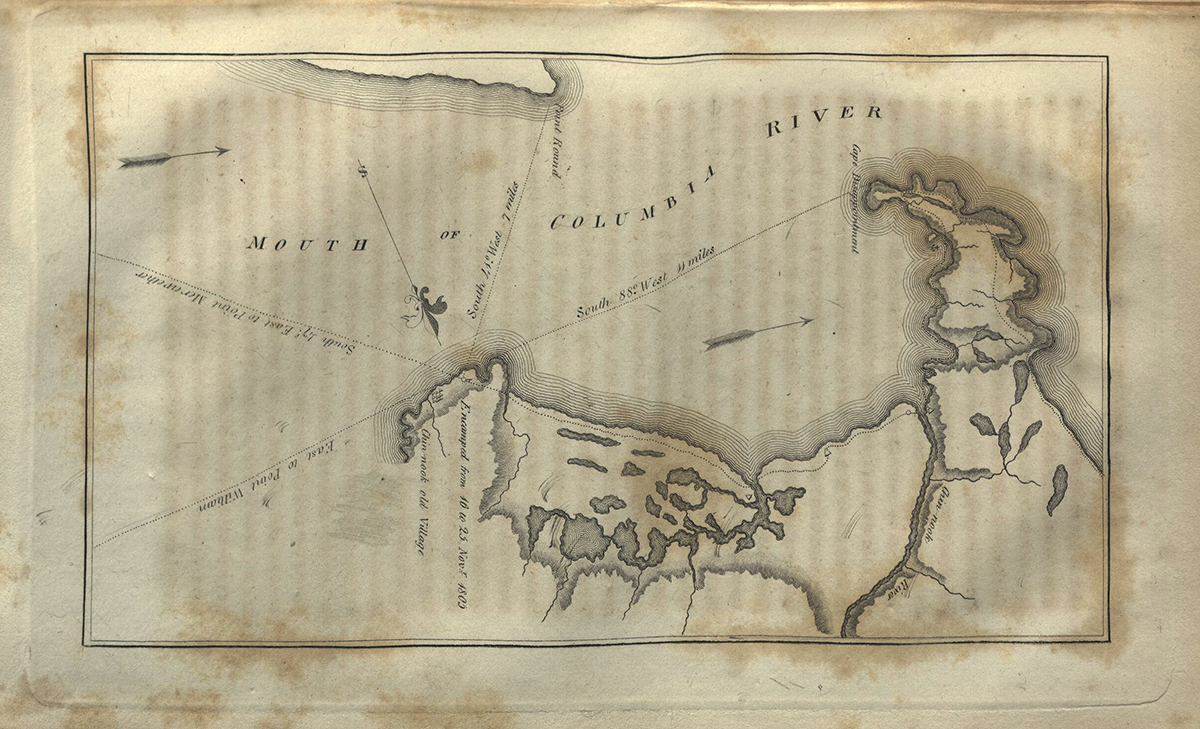
We had not gone far from this village when the fog cleared off, and we enjoyed the delightful prospect of the ocean, the object of all our labours, the reward of all our anxieties. This cheering view exhilarated the spirits of all the party, who were still more delighted on hearing the distant roar of breakers.
HISTORY OF THE EXPEDITION UNDER THE COMMAND OF CAPTAINS LEWIS AND CLARK ...
Meriwether Lewis (1774-1809)
Philadelphia: Bradford and Inskeep; New York: A.H. Inskeep, 1814
First edition
F592.4 1814
Meriwether Lewis’s and William Clark’s exploration of the American west was one of the most important accomplishments of a young United States. Lewis, Clark and their Corps of Discovery made the first overland trip from the Atlantic to the Pacific coast and back. These were the first white men to enter present-day Idaho, Washington, and Oregon by land. Traveling north, they followed the Missouri River from its confluence at the Mississippi River to its source, turned west and, after crossing the Rocky Mountains, explored the Columbia River from its source to the Pacific Ocean.
Lewis wrote a narrative of this expedition and Clark contributed the maps. This published account contains information on the geography and ethnography of the area Lewis, Clark and their party saw, describing the government-funded expedition to explore the newly acquired Louisiana Purchase.
The expedition took place between 1804 and 1806. In total, the expedition traveled nearly eight thousand miles in a little more than twenty-eight months. On its way home, the Corps of Discovery met with a four-man trading party which had news that Zebulon Pike had left St. Louis to explore the Red and Arkansas Rivers.
They returned with the first reliable information about much of the area, made contact with indigenous peoples as a prelude to fur-trading possibilities, and increased the amount of geographical information regarding the lower North American continent. Clark’s map of the West accurately depicts the trans-Mississippi for the first time.
Although Lewis and Clark completed their expedition in September, 1806, this account, which is an edited version of the journals they maintained during their travels, was not published until February 20, 1814, five years after Lewis’s death. Only a portion of Lewis and Clark’s accounts of their epic expedition west appeared in print. After Meriwether Lewis’ mysterious death (probably suicide), the task of editing their journals fell to William Clark who, in turn, asked Philadelphia lawyer Nicholas Biddle to complete the job. When the story was finally published more than fourteen hundred copies were distributed. The book sold for six dollars.
Lewis often wrote personal reflections of what he experienced while recording his scientific observations. His writing had a raw quality that evoked the danger and high adventure of the trip across an unknown wilderness. His report had a profound effect upon the United States. A much more aggressive westward vision quickly outstripped President Jefferson’s modest notion of continued agrarian opportunities with a little commerce thrown in for good measure.
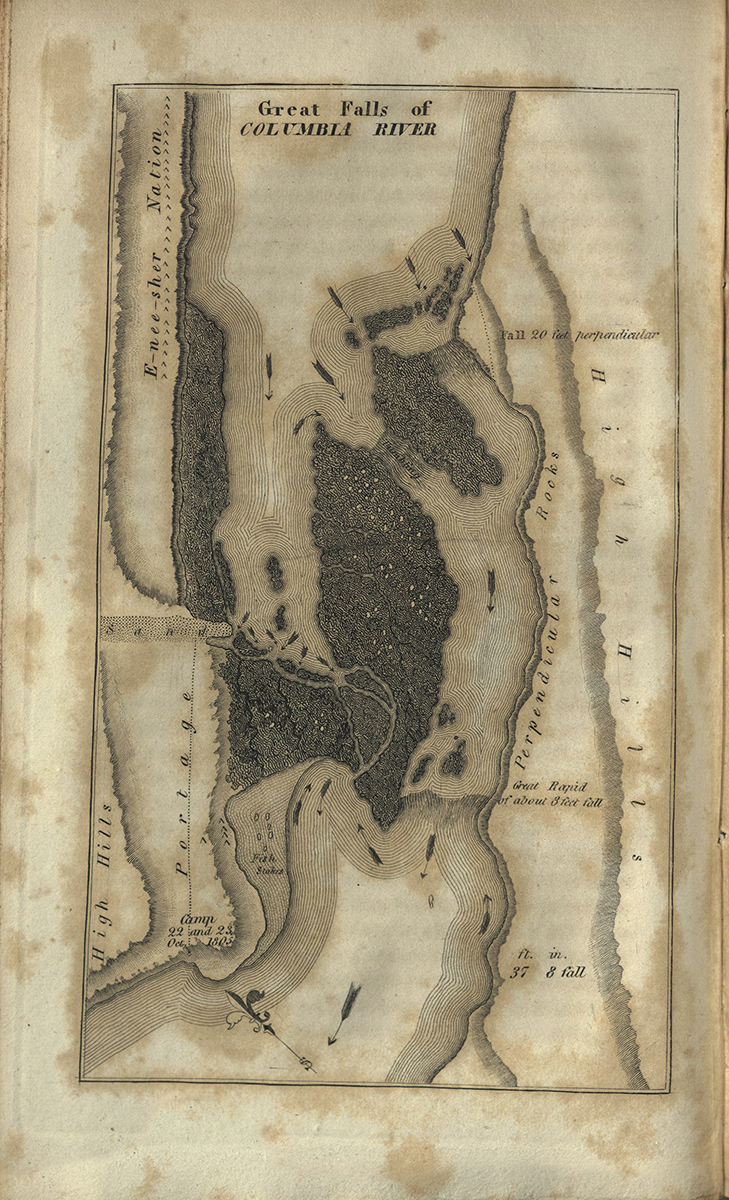
Two miles below we came to seventeen huts on the right side of the river, situated at the commencement of the pitch which includes the great falls. Here we halted, and immediately on landing walked down, accompanied by an old Indian from the huts, in order to examine the falls, and ascertain on which side we could make a portage most easily.
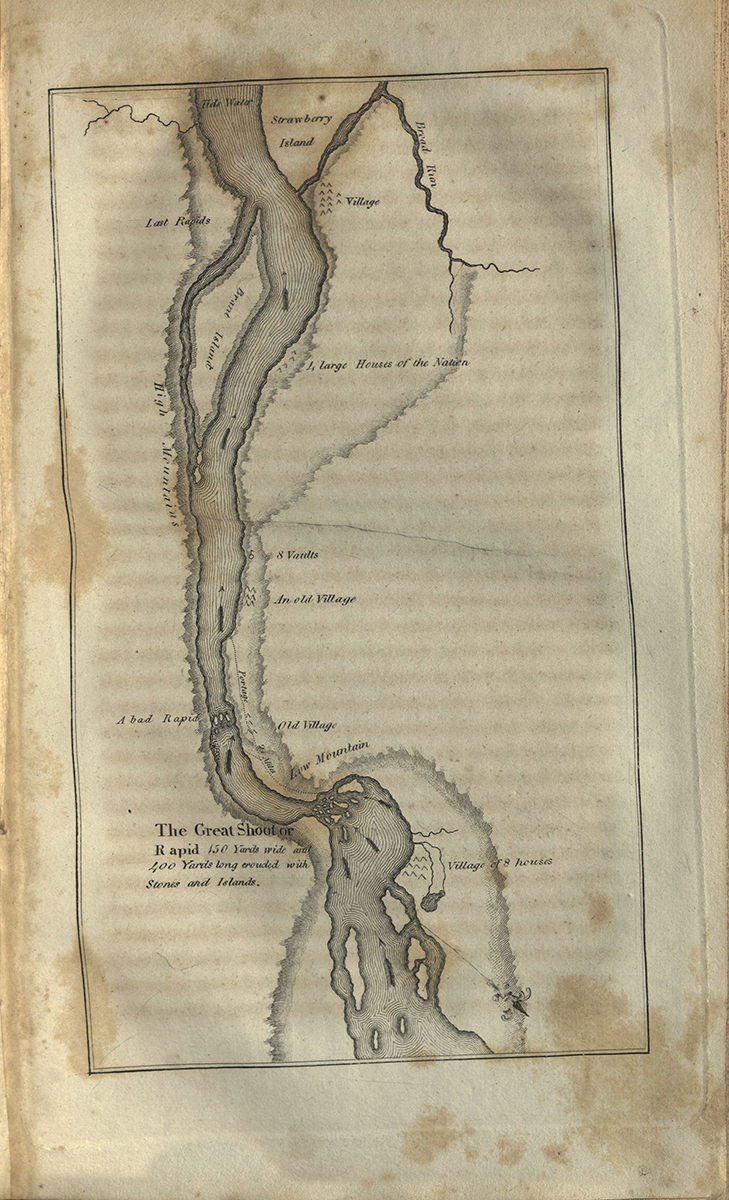
Within this narrow limit it runs for the distance of four hundred yards with great rapidity, swelling over the rocks with a fall of about twenty feet: it then widens to two hundred paces, and the current for a short distance becomes gentle; but at the distance of a mile and a half, opposite to the old village… it is obstructed by a very bad rapid, where the waves are unusually, high, the river being confined between large rocks, many of which are at the surface of the water.
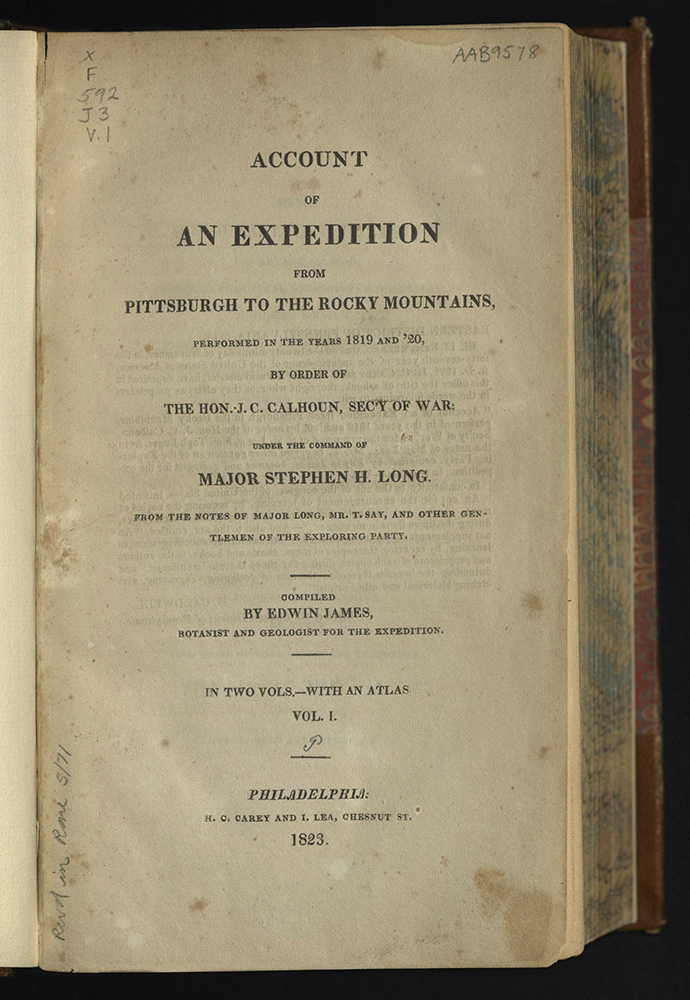
Robins, (Tursus migratorius.) which we had not seen since we left the Missouri, here occurred in great numbers.
ACCOUNT OF AN EXPEDITION FROM PITTSBURGH TO THE ROCKY MOUNTAINS ...
James Edwin (1797-1861)
Philadelphia: H. C. Carey and I. Lea, (1822-23)
First edition
F592 J3
Edwin James was born in Vermont. When he was 23, he was appointed botanist, geologist, and surgeon for the expedition commanded by Major Stephen H. Long. Following the War of 1812, Major Long became a proponent of government-sponsored exploration of the West. He began this expedition under the order of John C. Calhoun, then Secretary of War. The Long expedition was the third major exploration of the trans-Mississippi West, following those of Lewis and Clark and Pike. It was the first expedition accompanied by artists.
James’s compilation of records of the 1819-1820 exploration of the American northwest contributed valuable information regarding the natural landscape, native peoples and wildlife of a heretofore largely unexplored region by the United States.
Major Long was commissioned to ascend the Platte River and explore the headwaters of both the Red River and the Arkansas River. The expedition followed the Platte River to the South Fork to the Colorado Rockies, where it found and named Long’s Peak. On July 5, 1820, they reached present-day Denver and on July 12, Colorado Springs, from where three of the party members, including James, climbed Pike’s Peak, the first men known to do so.
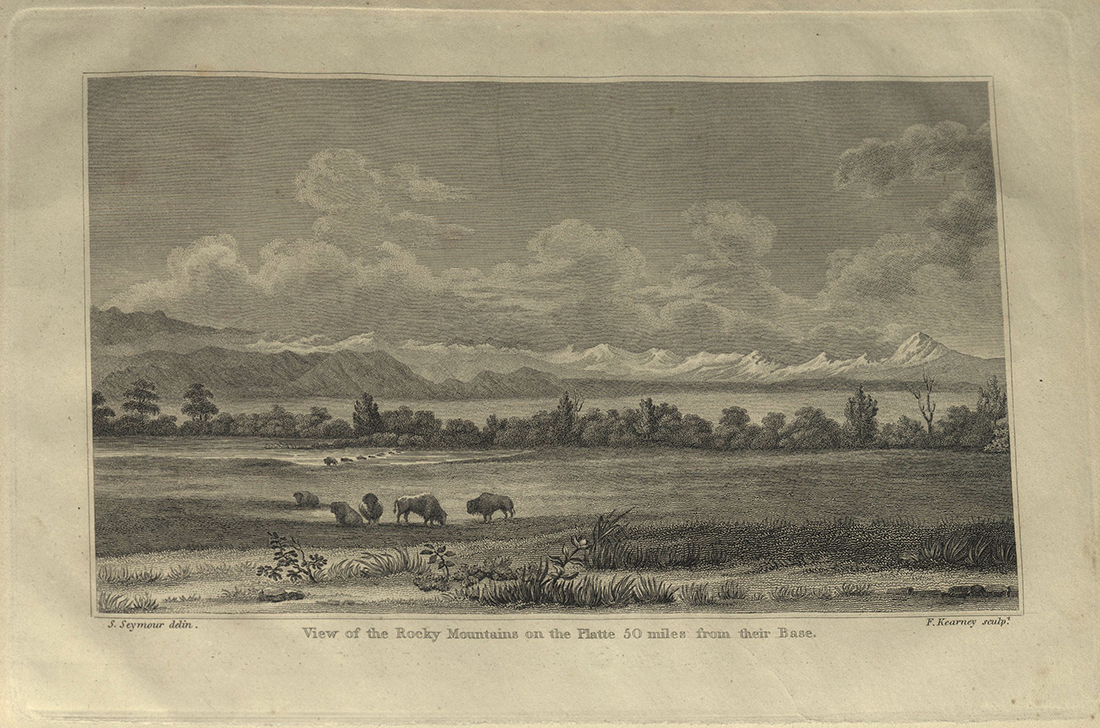
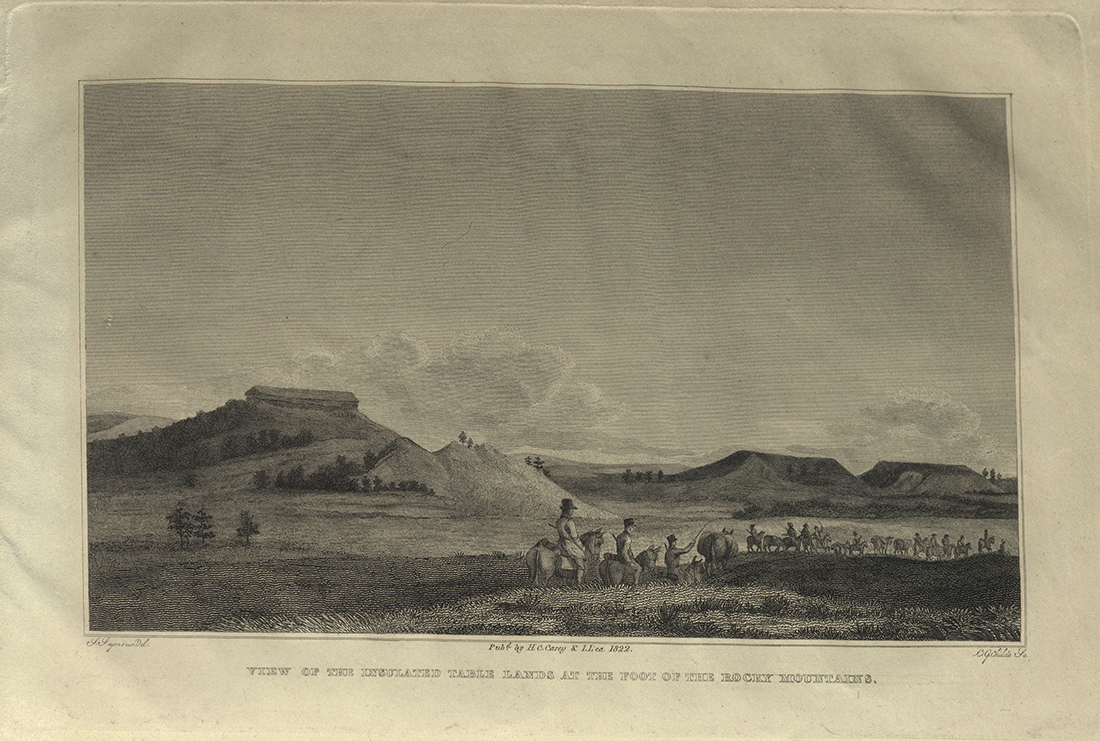
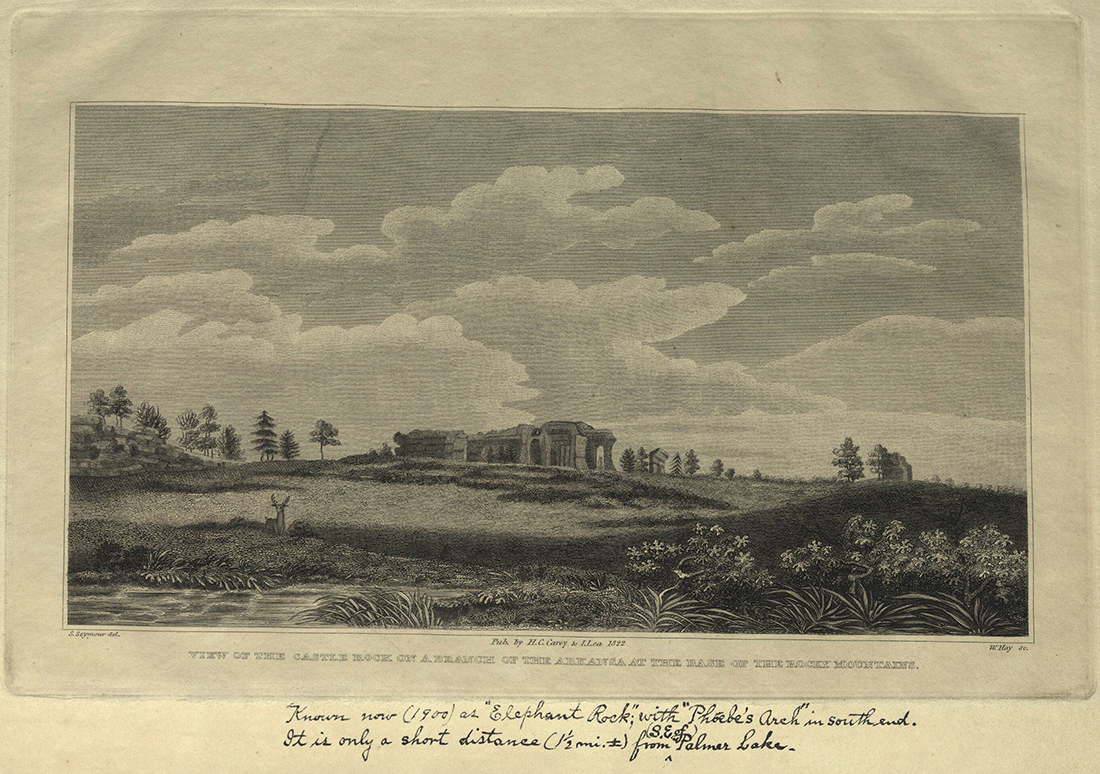
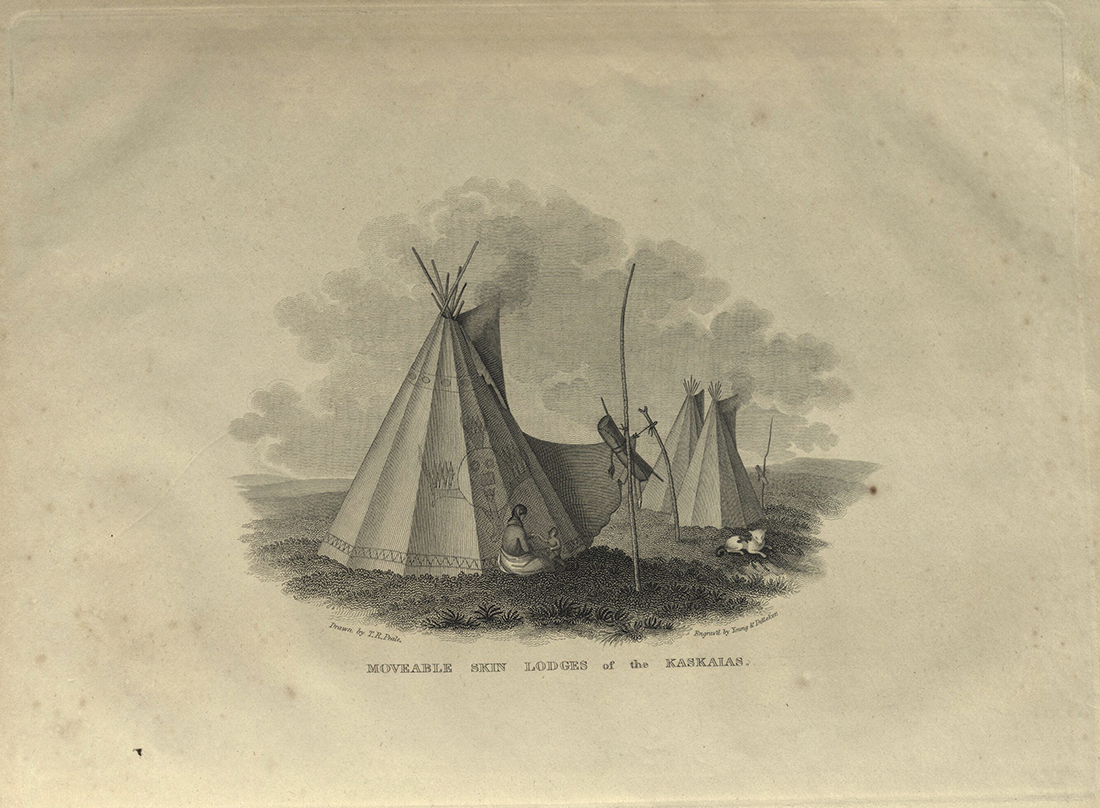
The party continued south to the upper Arkansas River, where Long divided the group: one to continue the exploration of the Arkansas; the other, which included Long and James, to explore the Red River. In early august this second party followed the Canadian River, mistaking it for the Red. This mistake led the group into New Mexico and the Texas panhandle., where they encountered a party of Kiowa Apache, the first recorded meeting between Anglo-Americans and members of this people. The group continued through Oklahoma and rejoined the first group at Fort Smith, Arkansas.
Neither the source of the Arkansas nor the Red River were found, but Long’s expedition travelled farther than Pike and blazed trails that would later be followed by John C. Fremont and John Wesley Powell.
James compiled this account from notations in his journal, Major Long’s notes, and the observations by naturalist Thomas Say. Titian Peale was the draughtsman and assistant naturalist on the expedition. Samuel Seymour was the landscape artist.
Account was to be published simultaneously in Philadelphia and London, but the two editions differ substantially. Review of contemporary correspondence and periodicals indicates the Philadelphia was available for sale on 31 December 1822, whereas the London edition was not available until late February 1823. The Philadelphia edition is the authority for most of the new taxonomic contributions in the work.
After the expedition, James studied Native American languages and translated the New Testament into Ojibwa. He worked as a newspaper editor in Albany, New York, and then settled in Iowa where he ran a station on the Underground Railroad.
Appendices in this work include astronomical and meteorological tables and Native American vocabularies. Plates depict Oto Indians, views of the Plains and buffalo.
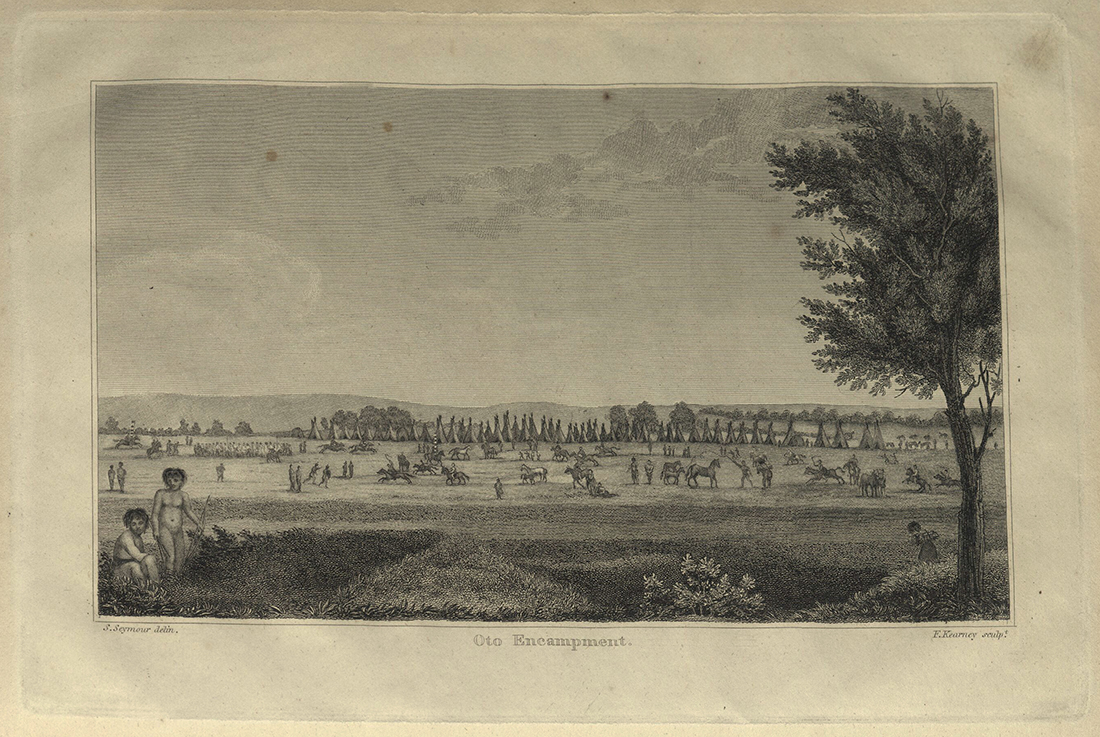
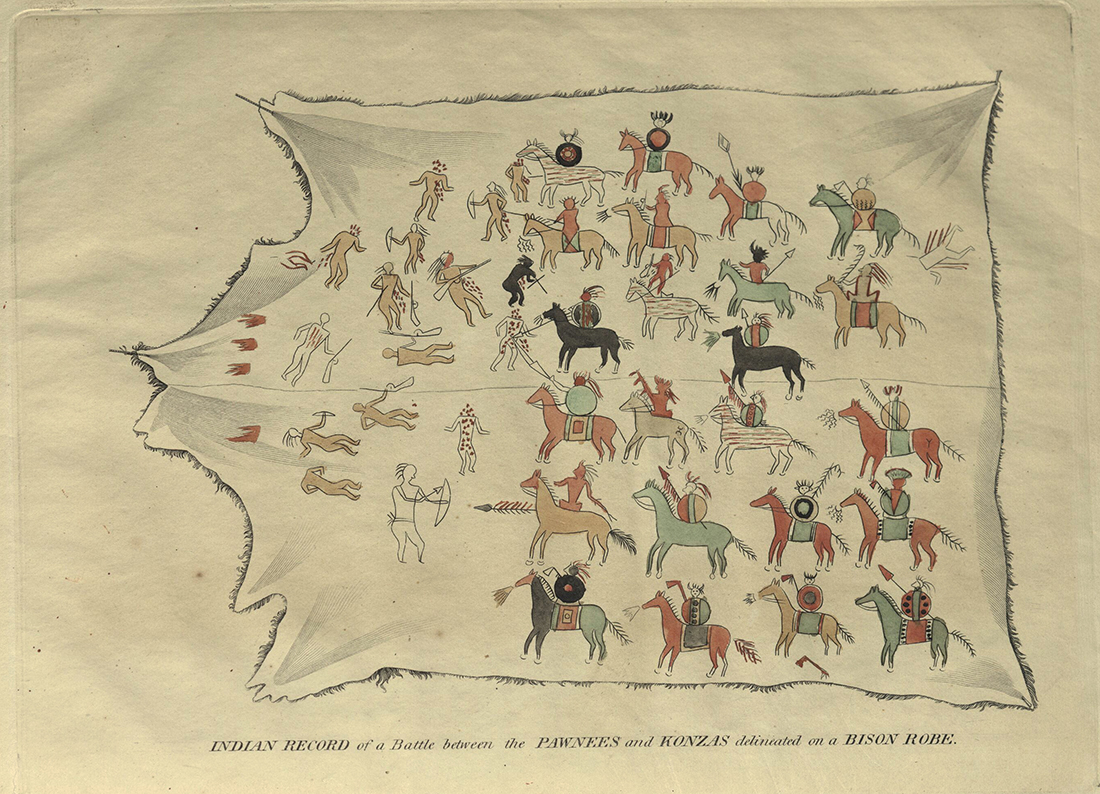
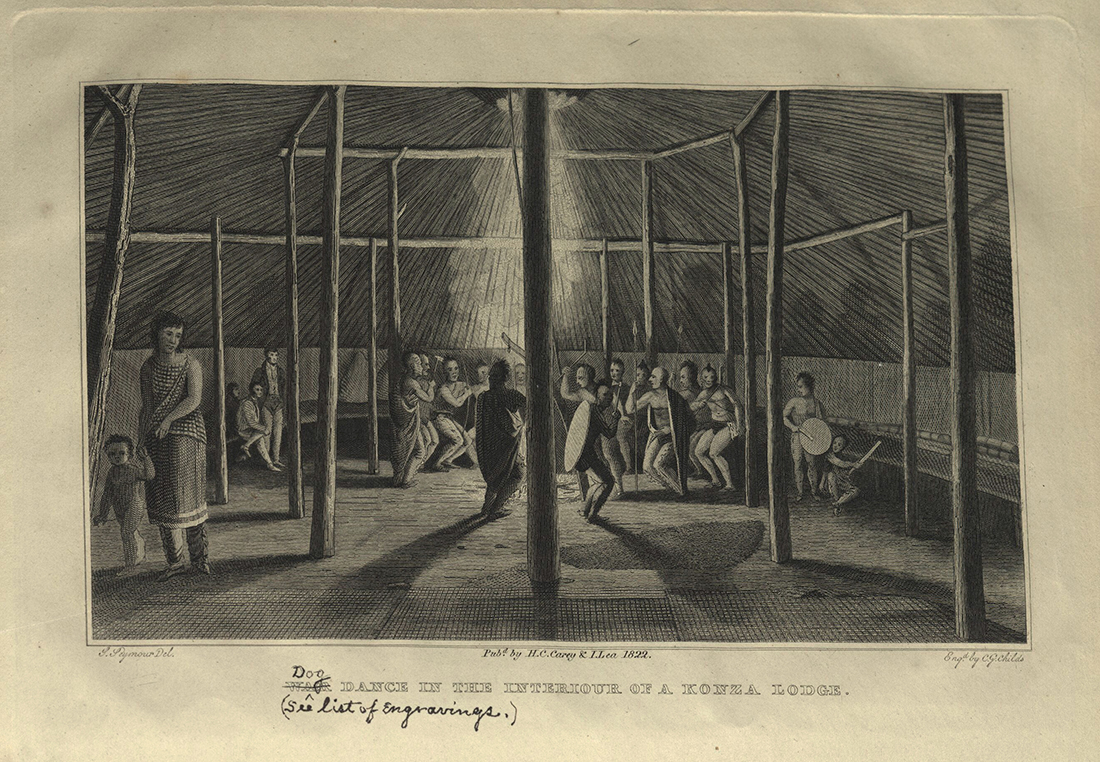
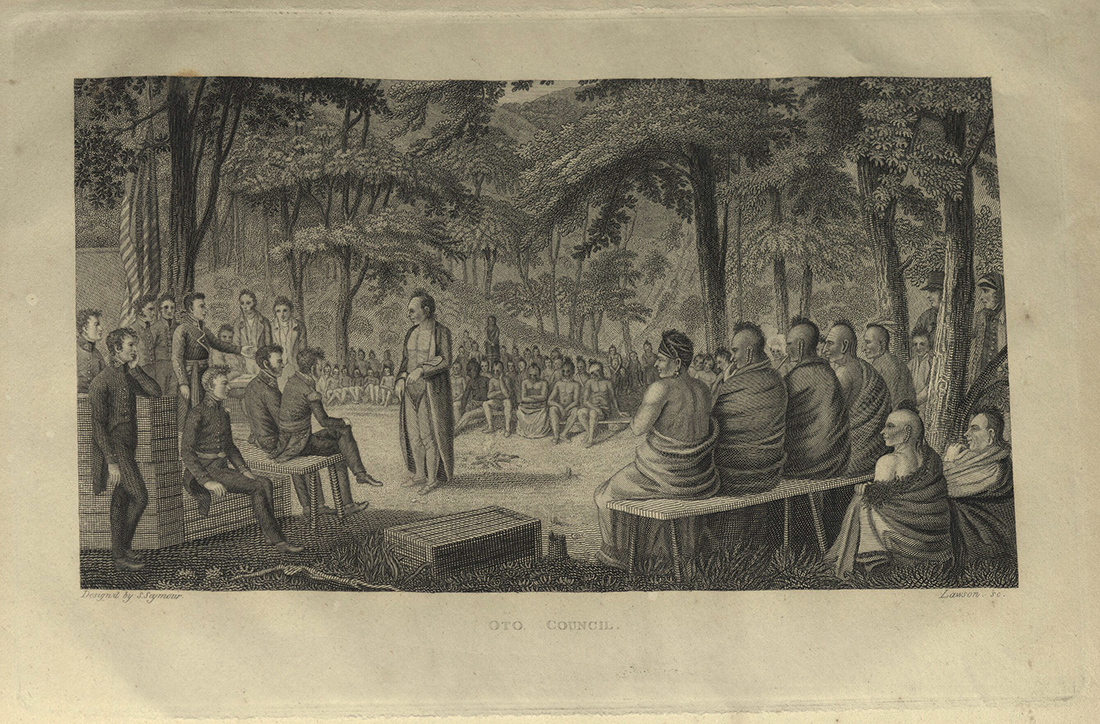
The accompanying atlas contains the first maps providing detail of the Central Plains, with a note: “The Great American Desert is frequented by roving bands of Indians who have no fixed places of residence but roam from place to place in quest of game.”
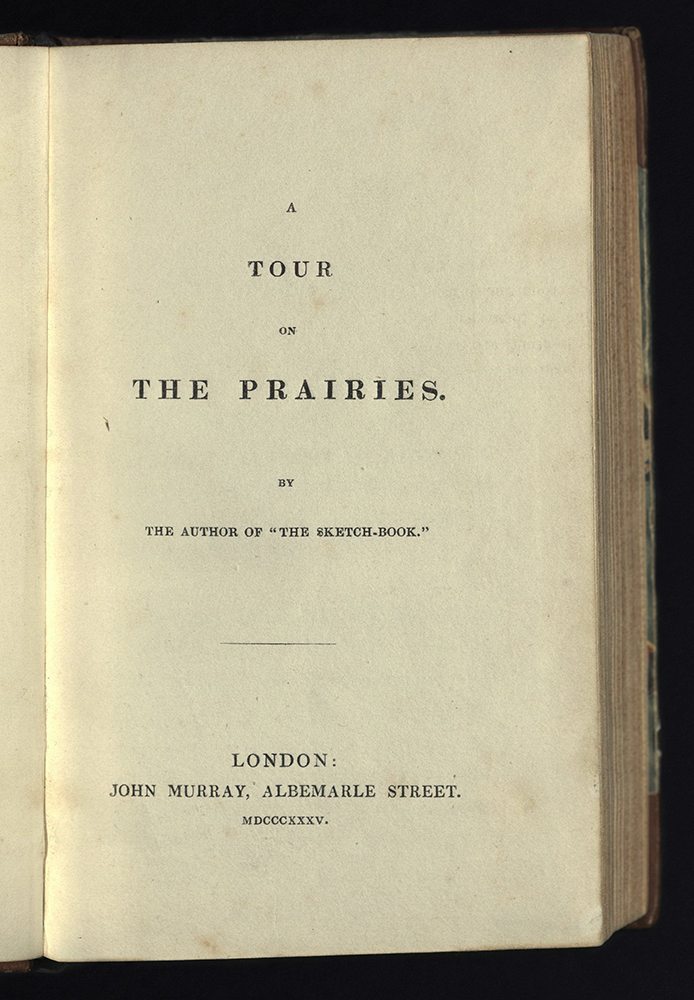
We were overshadowed by lofty trees, with straight, smooth trunks, like stately columns; and as the glancing rays of the sun shone through the transparent leaves, tinted with the many-colored hues of autumn, I was reminded of the effect of sunshine among the stained windows and clustering columns of a Gothic cathedral. Indeed there is a grandeur and solemnity in our spacious forests of the West, that awaken in me the same feeling I have experienced in those vast and venerable piles, and the sound of the wind sweeping through them, supplies occasionally the deep breathings of the organ.
A TOUR OF THE PRAIRIES
Washington Irving (1783-1859)
London: J. Murray, 1835
First edition
F697 I743 1835
In 1832, Washington Irving, America’s literary superstar, returned to the United States after seventeen years abroad. Almost immediately he joined an expedition exploring Osage and Pawnee country – a territory still mostly uncharted by Americans – in what is now Oklahoma. Few white men had set foot in the region and fewer still had written about it.
Irving’s reputation for patriotism had been suffering because of his long time abroad, when he met the newly appointed Indian Commissioner, Henry L. Ellsworth, on a steamboat and accepted the opportunity to join his expedition.
Irving found the whole adventure invigorating: sleeping under the stars was for him a tranquil experience. He embraced Pawnee culture. He kept a daily account of his excursion. When he returned home, he turned his notes into this entertaining work, describing the terrain of the giant rivers and golden plains he had seen and vividly depicting the lives of Native Americans. The affectionate work was hugely successful. It is from this work that a lasting character of the American West was painted: the hardy fur-trapper with trusty rifle, an intrepid bride, scorn for the sweets of civilization and a fierce pride of independence; and the wild plains warrior invading neighboring tribes and ever steeped in ancient lore.
The narrator of this work is Geoffrey Crayon, already familiar to Irving’s fans as an unabashed Anglophile and Hispanophile. Published in the United States one month after the London edition, the work was also published in Paris that same year.
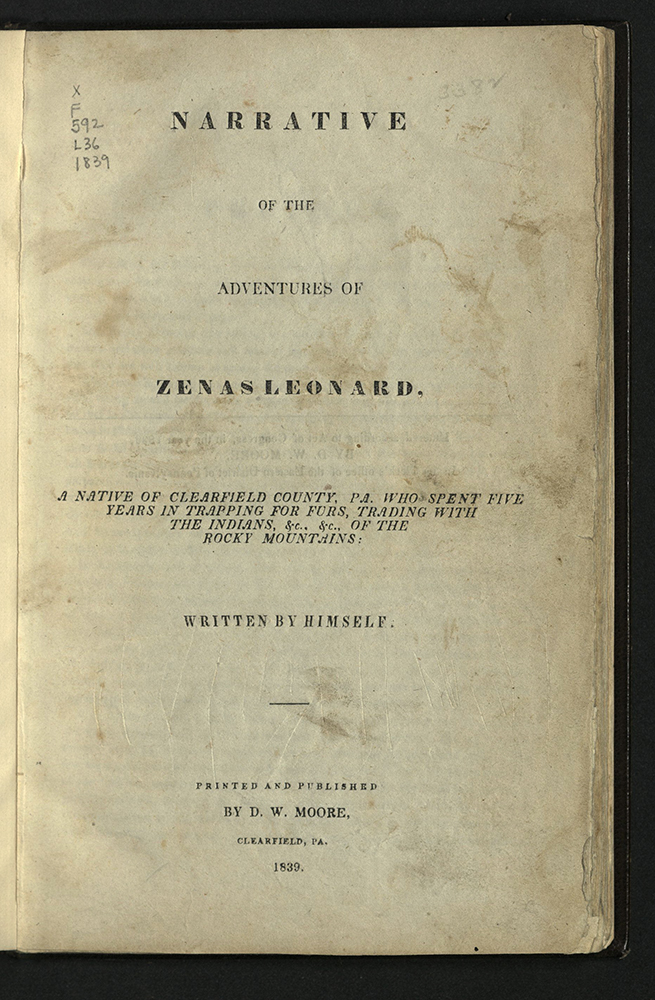
I have seen beautiful and enchanting sceneries depicted by the artist, but never any thing to equal the work of rude nature in those prairies. In the spring of the year when the grass is green and the blossoms fresh, they present an appearance, which for beauty and charms, is beyond the art of man to depict.
NARRATIVE OF THE ADVENTURES OF ZENAS LEONARD
Zenas Leonard (1809-1857)
Clearfield, Pa: D. W. Moore, 1839
First edition
F592 L36 1839
Zenas Leonard’s memoirs of his travels were written, he said, at the request of friends. In order to avoid having to repeat his story over and over again, he decided to write his Narrative. It was published by a small press in his home town. The adventurous Leonard left St. Louis on April 24, 1831 heading west to make his fortune trapping for furs and trading with Indians.
Leonard began his journey as a clerk for a fur trading firm that failed. He remained in the Rocky Mountains as a free trapper. In 1833, he joined the party of Captain Bonneville. With this party, he crossed the Great Basin and the Sierra Nevada to California.
From the beginning Leonard was plagued with misfortune: starvation, attack by a grizzly bear, and encounters with hostile Blackfoot Indians. Nothing was heard of him for five years, until he finally reached the Pacific coast, just south of San Francisco. He flagged down a passing ship from Boston which gave him passage back home. No fortune was made, but his Narrative is an honest and compelling account of his transcontinental trek.
Portions of Leonard’s narrative were published in the Clearfield Pioneer & Banner in 1835 and 1836. The publisher of the newspaper then printed this separate, complete edition, announcing in the preface, “Our author kept a minute journal of every incident that occurred, but unfortunately, a part of his narrative was stolen from him by hostile Indians; still, however, he was enabled to replace the most important events, by having access to the journal kept by the commander of the expedition. His character for candour and truth, among his acquaintances, we have never suspected… At all events, in its perusal, the reader will encounter no improbabilities, much less impossibilities: -- hence it is but reasonable to suppose that in traversing such a wilderness as lays west of the Rocky Mountains, such hardships, privations and dangers as those described by Mr. Leonard, must necessarily be encountered.”
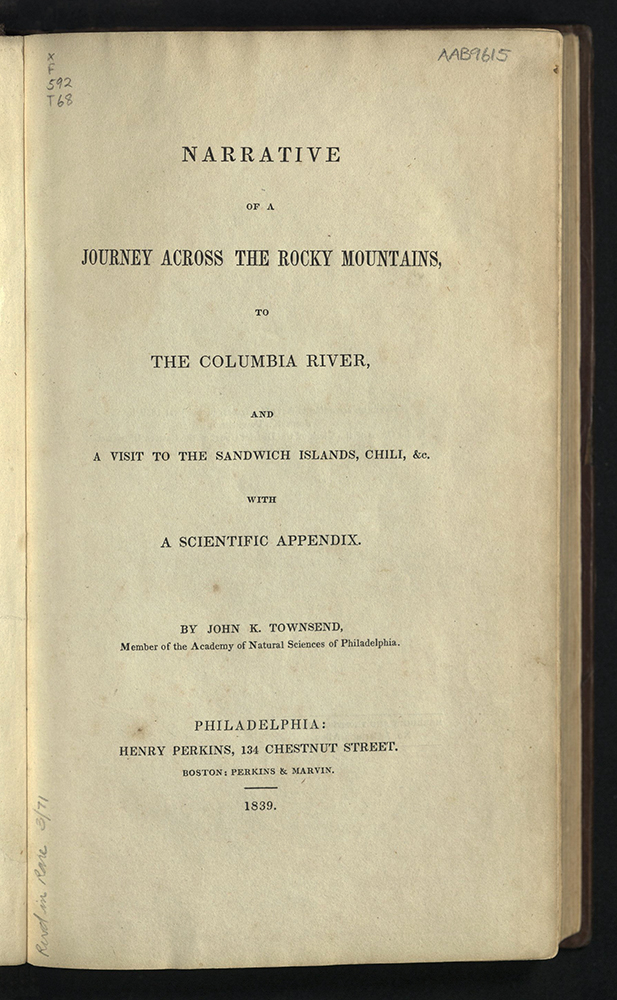
We have amongst our men, a great variety of dispositions. Some who have not been accustomed to the kind of life they are to lead in future, look forward to it with eager delight, and talk of stirring incidents and hair-breadth ‘scapes. Others who are more experienced seem to be as easy and unconcerned about it as a citizen would be in contemplating a drive of a few miles into the country. Some have evidently been reared in the shade, and not accustomed to hardships, but the majority are strong, able-bodied men, and many are almost as rough as the grizzly bears, of their feats upon which they are fond of boasting.
NARRATIVE OF A JOURNEY ACROSS THE ROCKY MOUNTAINS ...
John K. Townsend (b. 1809)
Philadelphia: Boston: H. Perkins, 1839
F592 T68
John Kirk Townsend’s Narrative is based on a journal he kept while traveling to Oregon with Nathaniel Wyeth’s 1834 expedition, the two years he spent in Oregon, and his travels back to the east coast of the United states via Hawaii and Chile.
Born into a Philadelphia Quaker family, Townsend’s siblings were active in medicine and science. Three of his brothers were dentists, one was a philanthropist interested in prison reform. One sister wrote a book on insects for children, another wrote a history of England in verse.
John attended a boarding school where entomologist Thomas Say had also attended. Thomas Say later traveled with Edwin James on his western expedition. Townsend developed his skill at taxidermy and began collecting the birds of West Chester County, admired by John James Audubon.
Nathaniel Wyeth was a Massachusetts ice merchant who dreamed of establishing a fur trading company on the west coast. John Nuttall, a botanist, invited Townsend to join the expedition.
An appendix in this book cites Audubon’s Birds of America in its description of specimens procured on the expedition. Some of the skins brought back from the west by John Kirk Townsend and John Nuttall were given to Audubon by the Philadelphia Academy. Nuttall personally gave Audubon a few of the specimens he had gathered on the expedition.
Rare Books copy inscribed by the author to an Edwin Willcox.
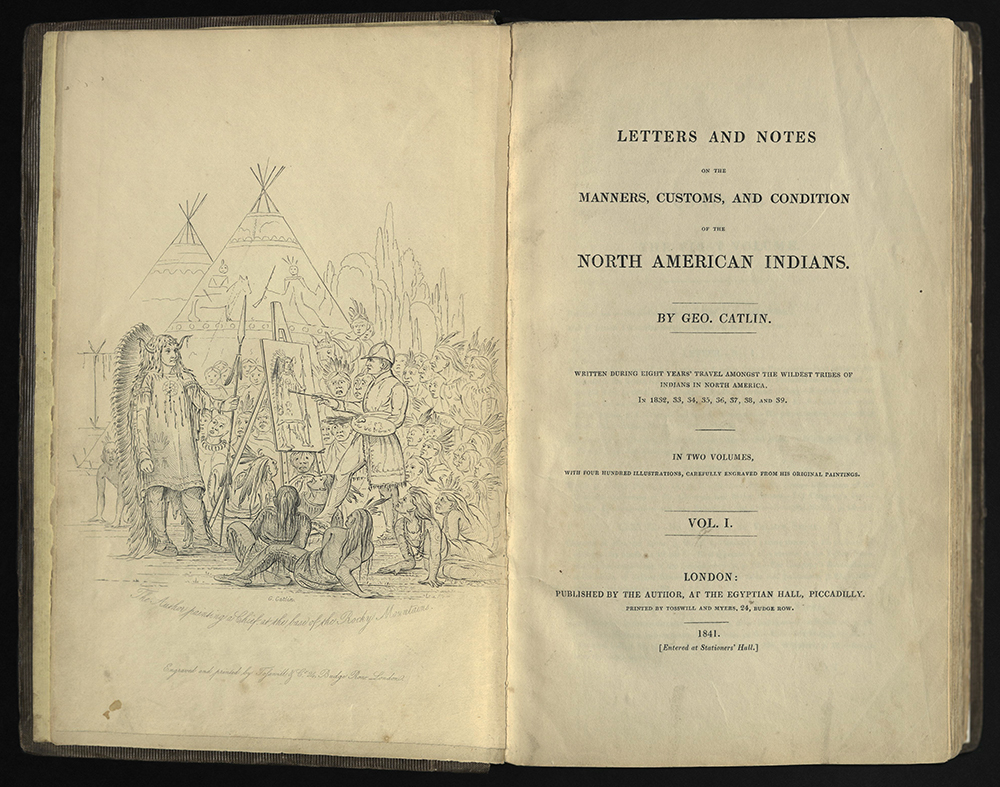
Amidst the multiplicity of books which are, in this enlightened age, flooding the world, I feel it is my duty, as early as possible, to beg pardon for making a book at all; and in the next (if my readers should become so much interested in my narrations, as to censure me for the brevity of the work) to take some considerable credit for not having trespassed too long upon their time and patience.
LETTERS AND NOTES ON THE MANNERS, CUSTOMS ...
George Catlin (1796-1872)
London: Pub. by the author, printed by Tosswill and Myers, 1841
First edition
E77 C38
Artist George Catlin traveled throughout the American West, visiting forty-eight Indian tribes, painting their portraits, and recording their games, dances, funerals, religious ceremonies, buffalo hunts, dress, and weapons. Catlin traveled for six years, documenting southern and western American Indians.
In 1832, Catlin headed upriver, on the first steamboat to ascend the Missouri, to Fort Union, near the mouth of the Yellowstone. His eighteen-hundred-mile journey introduced him to the Blackfoot, Crow, Lakota, and the Mandan. He toured the southern plains, the upper Mississippi, and the great lakes regions. Catlin devoted himself to preserving the image of the Indian, whom he saw, as did all Europeans, as a single group – colorful, exotic, and fragile.
In this book, Catlin wrote that he “flew to their rescue – not of their lives or of their race (for they are doomed and must perish), but to the rescue of their looks and their modes, at which the acquisitive world may hurl their poison and every besom of destruction, and trample them down and crush them to death; yet phoenix-like, they may rise from the ‘stain on a painter’s pallet,’ and live again upon canvass, and stand forth for centuries yet to come, the living monuments of a noble race.” Catlin understood that the Plains Indian way of life depended on an abundance of buffalo – a dependence that would collapse after the white man descended on the landscape. “Oh insatiable avarice such! Wouldst thou tear the skin from the back of the last animal of this noble race, and rob thy fellow-man of his meant, and for it give him poison!” so Catlin wrote.
Catlin traveled as a guest of the American Fur Company. It was his goal to gain personal fame and fortune by preserving a pictorial record of the Native tribes within the borders of the United States. Under Catlin’s supervision, hundreds of engravings, reduced from the original paintings, were used in the publication of Letters and Notes. Catlin’s fusion of classicism and romanticism reflects the nineteenth-century European art movement. For the text, Catlin used a series of articles he had written for the New York Commercial Advertiser between 1832 and 1837.
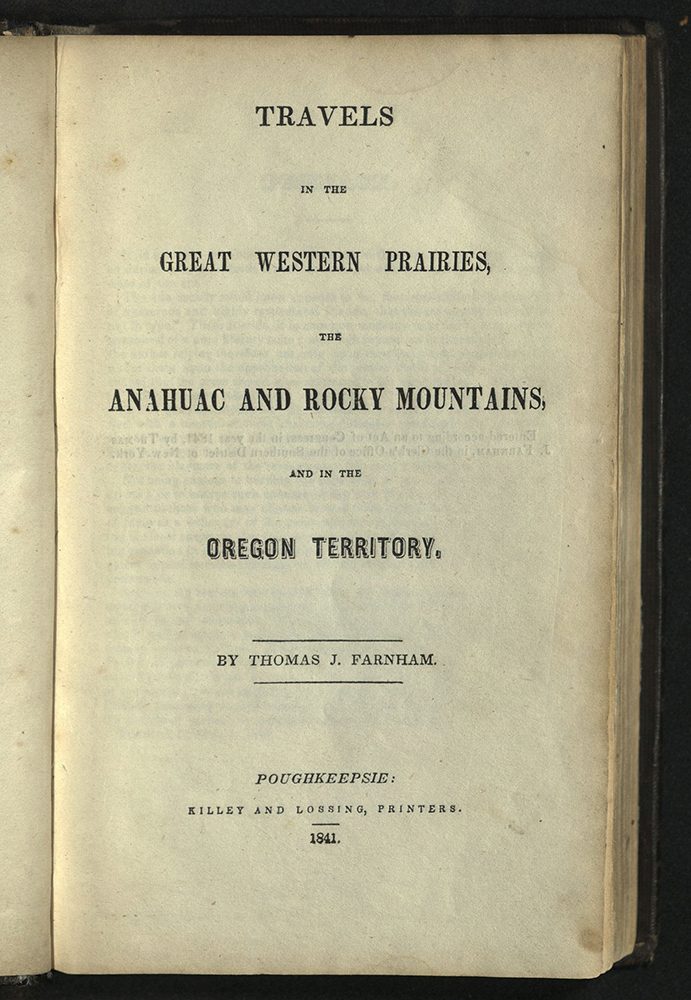
An hour among the sands and wild wormwood – an hour among the oozing springs, and green grass around them – an hour along the banks of Saptin River – and we passed a line of timber springing at right angles into the plain; and before us rose the white battlements of Fort Hall!
TRAVELS IN THE GREAT WESTERN PRAIRIES
Thomas J. Farnham (1804-1848)
Poughkeepsie: Killey and Lossing, printers, 1841
First edition
F592 F225
Thomas Jefferson Farnham, a New Englander, practiced as an attorney in Peoria, Illinois. He heard a lecture on the Oregon country by Methodist missionary Jason Lee, who gone there in 1834. Inspired by the lecture, Farnham went overland in 1839 with a group of would-be settlers to Bent’s Fort and then north to the Oregon Trail. The “Peoria Party” left Independence on May 20, 1839, followed the Santa Fe trail to Fort Bent and then divided the company.
Five of the initial party abandoned the expedition in Santa Fe. One group, made up of eleven members, proceeded up the Platte River. Farnham, with four others, went up the Arkansas to South Park and then to the North Fork of the Platte. From there they proceeded to Brown’s Hole, and then up the Green River to Ham’s Fork. They arrived at Fort Hall, where they met with Joe Walker, who was in charge of the fort. They went on to Whitman’s Mission.
After a few week’s respite, Farnham continued on to Fort Walla, then to the Dalles, and down the Columbia to Fort Vancouver. The trip ended on September 23rd. This was the first overland migration to Oregon.
One of Farnham’s over-glorious goals for his adventure was to kick out the British from Oregon country. Ironically, several of the men in his expedition were English. Farnham’s book was a strong advocate for American control of Oregon. Farnham began this argument with his opening statement: “Some of our number sought health in the wilderness – others sought wilderness for its own sake – and others sought a residence among the ancient forests and lofty heights of the valley of the Columbia.” He continued by celebrating the West, capable of offering health and “wilderness for its own sake,” with vivid descriptions of the geography and insights into native culture.
In later writings, Farnham’s propagandistic enthusiasm for the West notably included the rampant racism of the time. Only the “Anglo-Saxon race” could do the possibilities the land presented justice. He offered very clear, in his mind, expressions to the superiority of “Americans” over the Spanish/Mexican/Indian peoples he had no problem dispossessing.
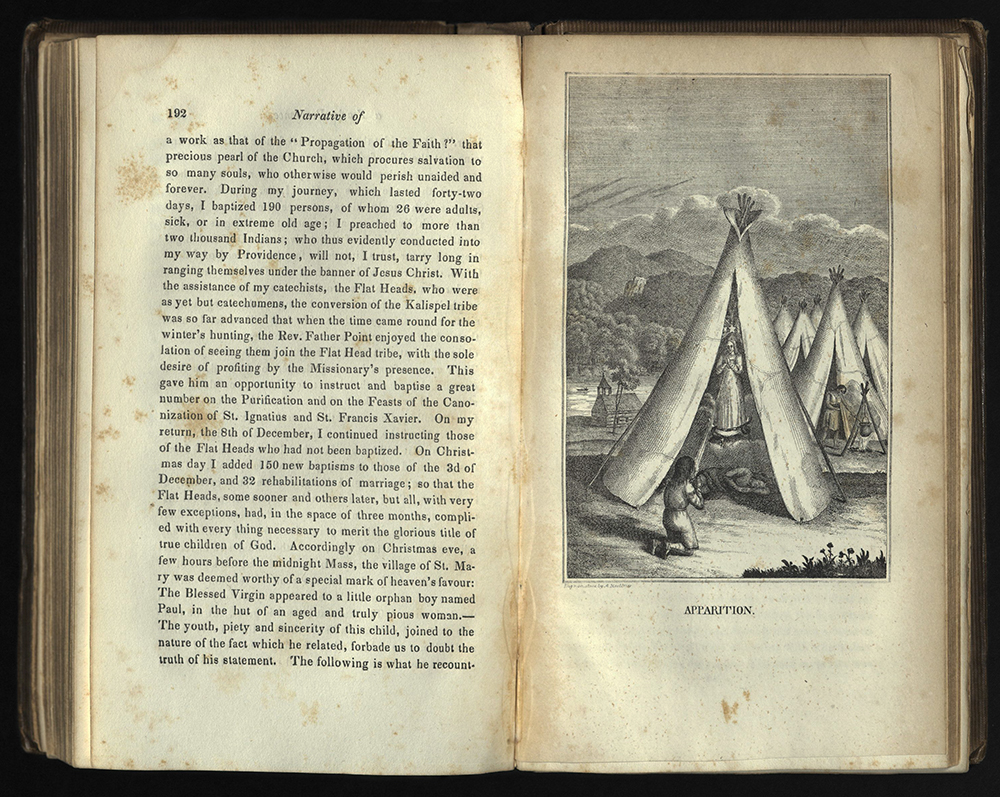
Accordingly on Christmas eve, a few hours before the midnight Mass, the village of St. Mary was deemed worthy of a special mark of heaven’s favour: The Blessed Virgin appeared to a little orphan boy named Paul, in the hut of an aged and truly pious woman.
LETTERS AND SKETCHES
Pierre-Jean De Smet (1801-1873)
Philadelphia: M. Fithian, 1843
First edition
F592 S63
Pierre-Jean De Smet was a Belgian Jesuit. He spent his adult life traversing the Great Plains, founding missions and working to convert the Potawatomi, Dakota, and other native peoples. In 1821, he sailed to the Baltimore to begin his missionary work. Eighteen months later, he was transferred to Missouri, where he was ordained in 1827. He taught at St Regis Seminary, a school for Native American boys, from whom he learned a little about their customs.
In 1833, De Smet returned to Belgium for medical reasons, where he recruited men, supplies, and money for a Missouri mission. When he returned to the United States he worked as a missionary to the Potawatomi Indians at Council Bluffs, Iowa, visiting the Yankton and Santee Sioux in an attempt to negotiate peace between the two tribes. He traveled to the Rocky Mountains in the 1840s, from St. Louis to Fort Vancouver and back.
This book contains sixteen letters he wrote to his supervising priest during his travels. His main goals on this trip and a subsequent one was to establish missions for Native Americans, in particular the Blackfoot. In one letter, De Smet wrote of white settlers, “Nothing frightens them. They will undertake anything. Sometimes they halt – stumble once in awhile – but they get up again and march onward.”
I am almost ashamed to confess that scarcely a day passes without my experiencing a pang of regret that I am not now roving at large upon those western plains. Nor do I find my taste peculiar; for I have hardly known a man, who has ever become familiar with the kind of life which I have led for so many years, that has not relinquished it with regret. ...the wild, unsettled and independent life of the Prairie trader, makes perfect freedom from nearly every kind of social dependence an absolute necessity of his being. He is in daily, nay, hourly exposure of his life and property, and in the habit of relying upon his own arm and his own gun both for protection and support. Is he wronged? No court or jury is called to adjudicate upon his disputes or his abuses, save his own conscience; and no powers are invoked to redress them, save those with which the God of Nature has endowed him. He knows no government — no laws, save those of his own creation and adoption…The exchange of this untrammeled condition — this sovereign independence, for a life in civilization, where both his physical and moral freedom are invaded at every turn, by the complicated machinery of social institutions, is certainly likely to commend itself to but few,— not even to all those who have been educated to find their enjoyments in the arts and elegancies peculiar to civilized society; — as is evinced by the frequent instances of men of letters, of refinement and of wealth, voluntarily abandoning society for a life upon the Prairies, or in the still more savage mountain wilds.
COMMERCE OF THE PRAIRIES
Josiah Gregg
New York: H. G. Langley, 1844
First edition
F800 G8
Josiah Gregg, born in Tennessee and raised in Missouri, studied mathematics and surveying. He was convinced that a trip west would restore his failing health. In 1831, he set out with a trading caravan for Santa Fe on the first of what would be eight journeys across the prairies.
In 1831, the American trade with New Mexico was a decade old. Business procedures had already been developed, but travel along the Santa Fe Trail was still exotic.
On his first trip, Gregg learned Spanish and bookkeeping. The trip was exciting, but also serious business. Gregg had a keen interest in science and took careful notes of the geography and geology of the Southwest, detailing the culture of its inhabitants, in particular the Native Americans in Texas and New Mexico. He outlined a trail from Van Buren, Arkansas to Chihuahua. This route, following the Canadian River, later became a main route for prospectors headed to California.
A decade after his last trip, he began compiling his travel notes into a readable manuscript and traveled to New York to find a publisher. His was the first book published about the Santa Fe Trail. Gregg captured the romance of the early wagon train enterprises – the approach into Santa Fe, wagon masters dressed in their Sunday best, headed toward the customhouse, while locals shouted their arrival.
Gregg’s work, published in two volumes, was an immediate success, going through two more editions in 1845, a fourth and fifth edition, and a sixth edition in 1857 under a different title. It was translated into French and German. Sales were brisk in England.
Gregg’s account of his travels was scrupulously accurate. It contains vivid descriptions of desert mirages and buffalo hunts. A large folded map is the first to display the Staked Plains of Texas, and includes the locations of forts, military roads, and trading posts. It identifies the Oregon Trail and Native American settlements, and traces the routes of Gregg’s exploring predecessors, including Stephen Long, and Zebulon Pike.
After his travelling adventures, Gregg studied medicine, a field he had dropped a decade earlier, and became a physician. He wanted to return to Santa Fe, but those plans were thwarted by the Mexican War. He became a newspaper correspondent and served as a guide and interpreter for Brig. Gen. John Wool and then for Col. Alexander Doniphan. He established a medical practice in Mexico where he also studied botany. From Mexico he traveled to San Francisco, visiting the gold fields. He led a small expedition over the coastal mountains of California and discovered what is now called Humboldt Bay. He died from injuries he received falling from a horse.
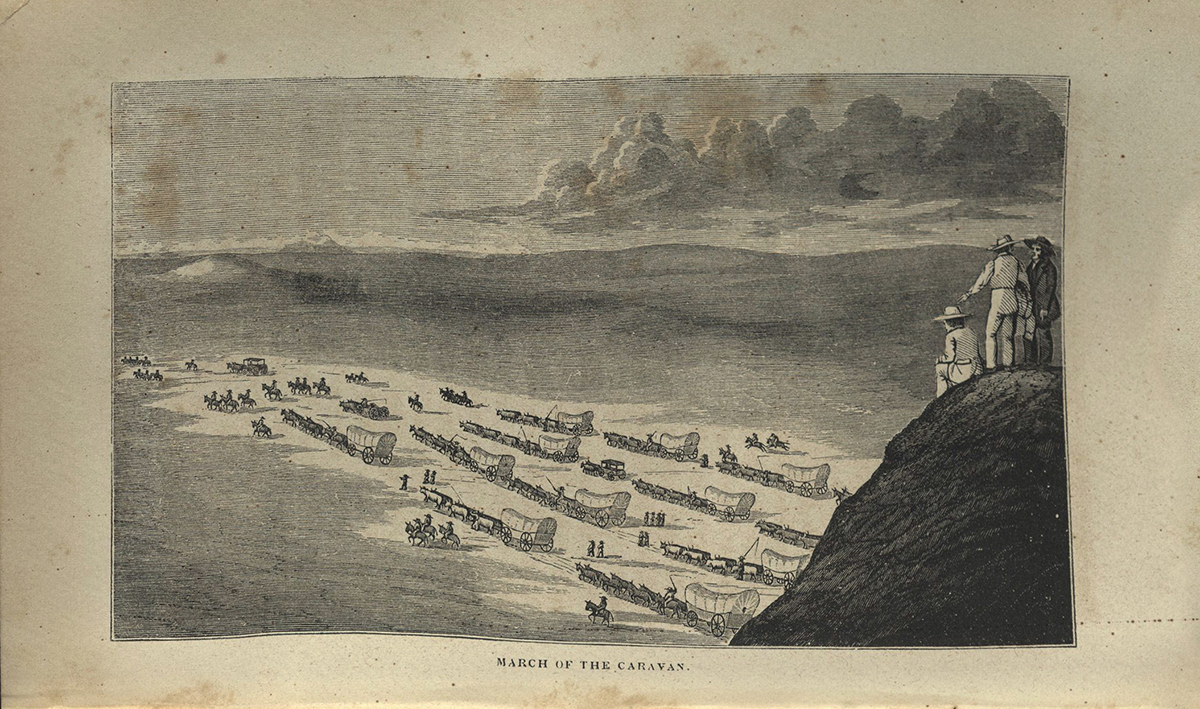
The wagons marched slowly in four parallel columns, but in broken lines, often at intervals of many rods between. The unceasing ‘crack, crack,’ of the wagoner’s whips, resembling the frequent reports of distant guns, almost made one believe that a skirmish was actually taking place between two hostile parties: and a hostile engagement it virtually was to the poor brutes, at least; for the merciless application of the whip would sometimes make the blood spirt from their sides – and that often without any apparent motive of the wanton carrettieri, other than to amuse themselves with the flourishing and loud popping of their lashes!
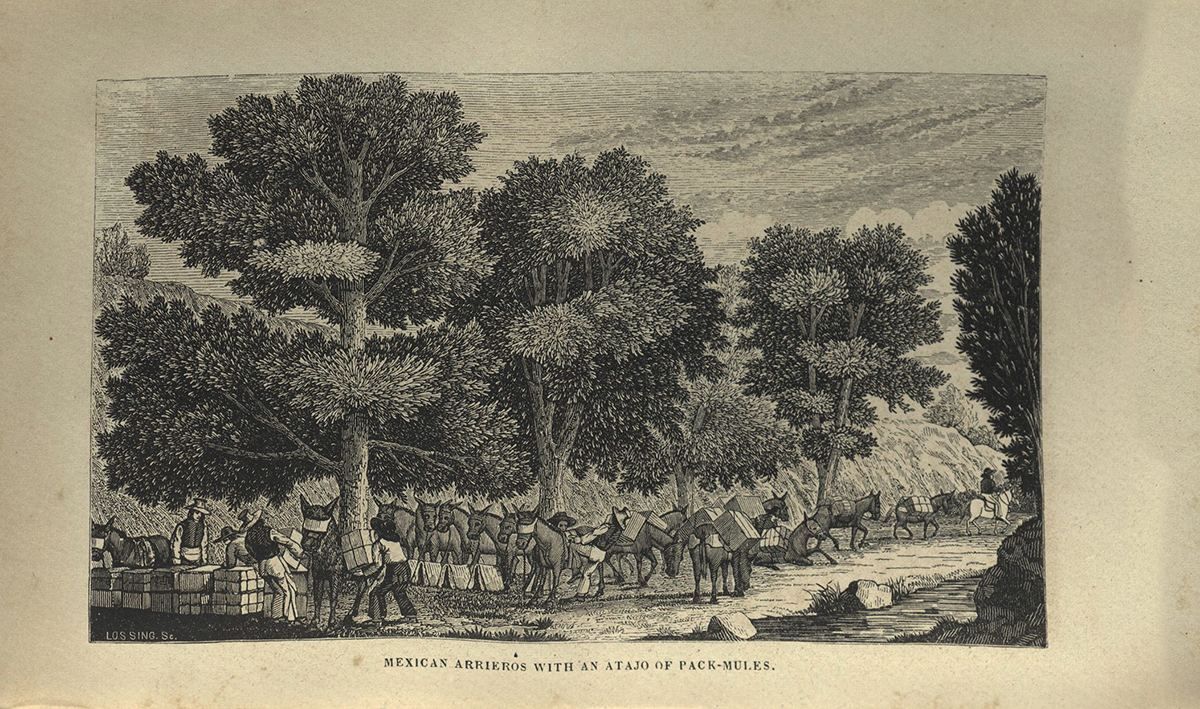
In this operation they frequently demonstrate a wonderful degree of skill in the application of their strength. A single man will often seize a package which, on a ‘dead lift,’ he could hardly have raised from the ground, and making a fulcrum of his knees and a lever of his arms and body, throw it upon the mule’s back with as much apparent ease as if the effort cost but little exertion. At stopping-places the task of unpacking is executed with still greater expedition.
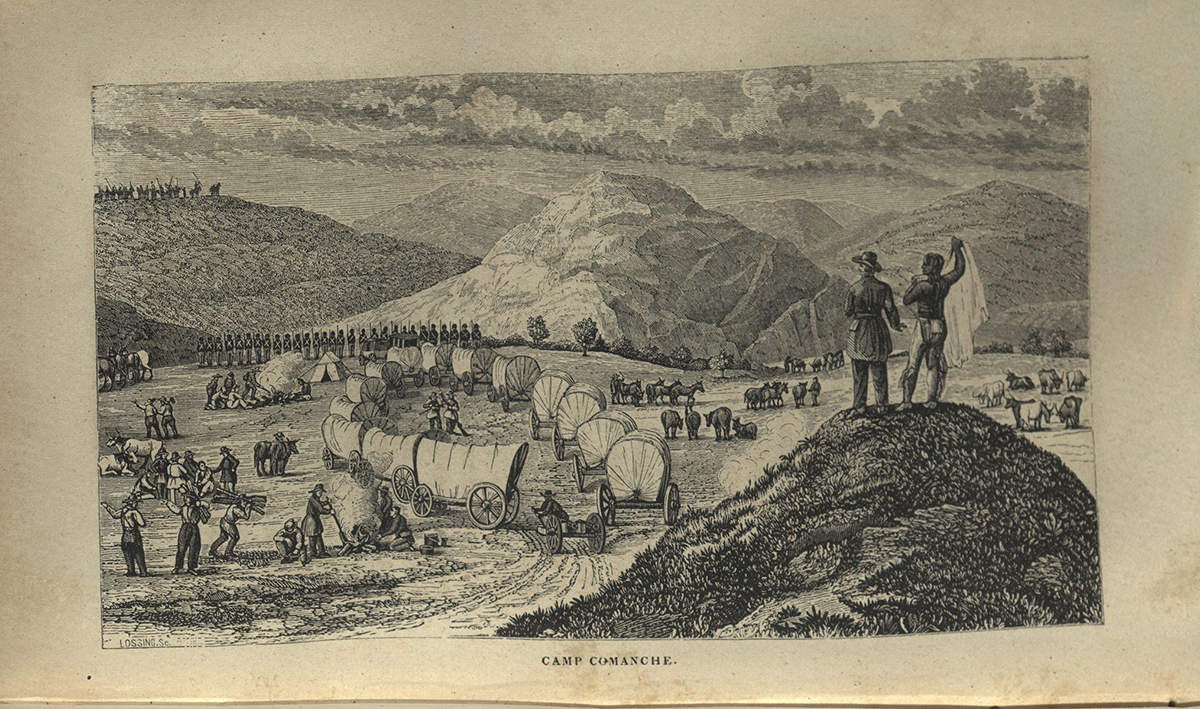
The party consisted of about sixty warriors, at the head of whom rode an Indian of small stature and agreeable countenance, verging on the age of fifty. He wore the usual Comanche dress, but instead of moccasins, he had on a pair of long white cotton hose, while upon his bare head waved a tall red plume, -- a mark of distinction…
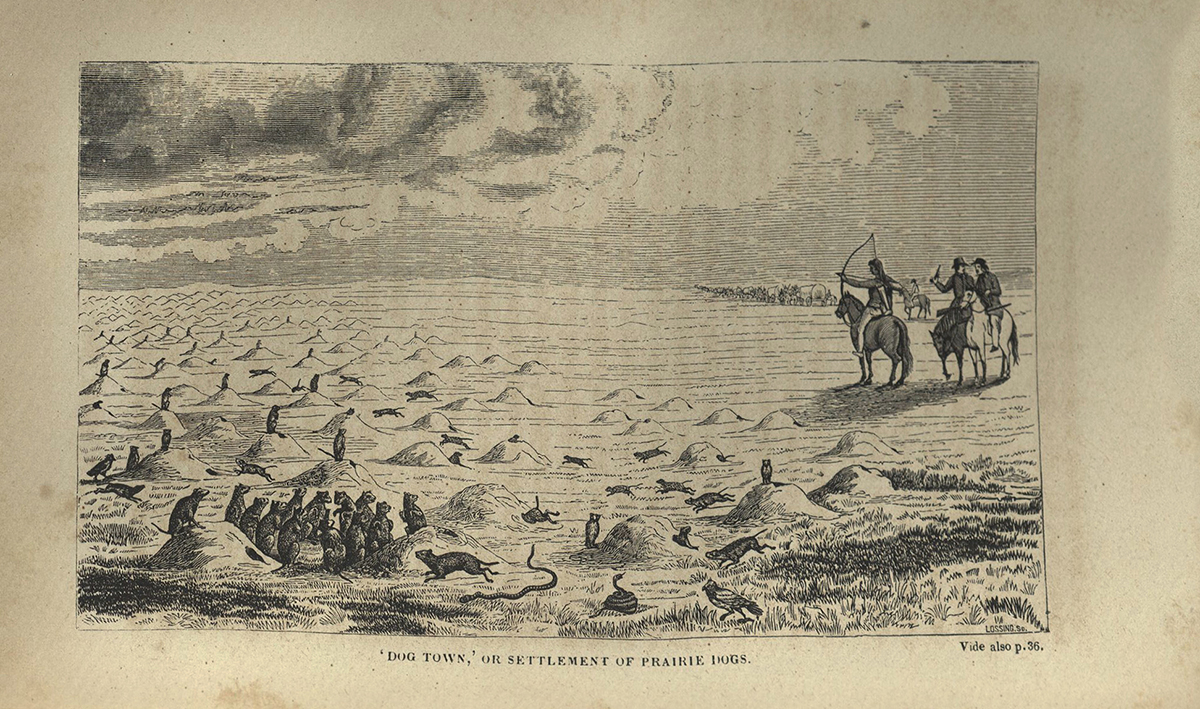
Approaching a ‘village,’ the little dogs may be observed frisking about the ‘streets’ – passing from dwelling to dwelling apparently on visits – sometimes a few clustered together as though in council – here feeding upon the tender herbage – there cleansing their ‘houses,’ or brushing the little hillock about the door – yet all quiet.
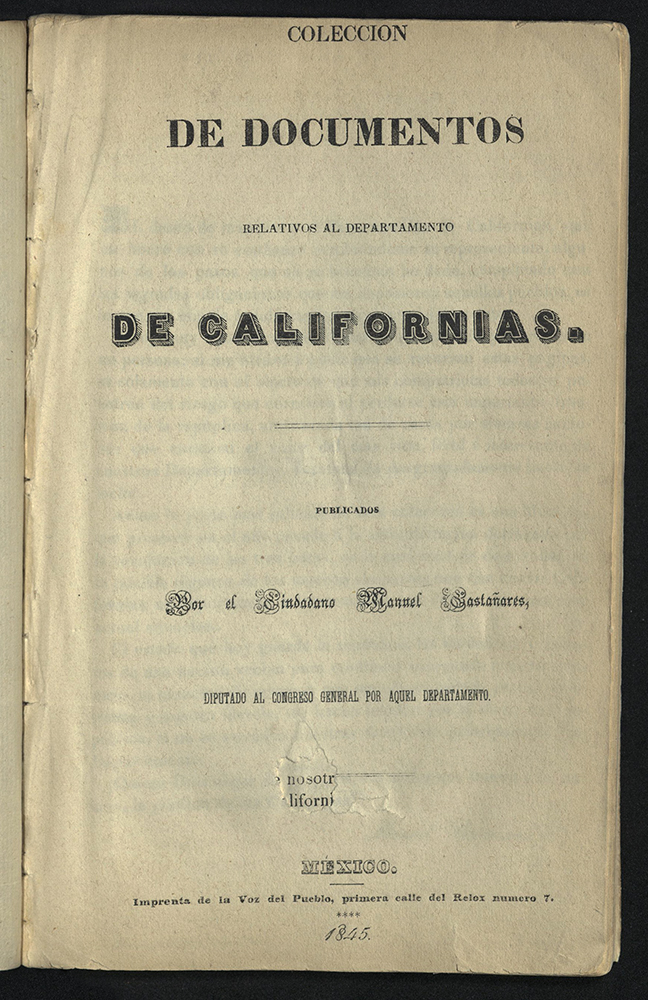
El estado que hoy guarda la república, las tendencias y conatos de una nación vecina para continuar usurpando nuestro territorio, el carácter de invasión que manifiesta toda la prensa americana y nuestra inercia, me hacen temblar por la suerte de la república, si no se atienden nuestras fronteras, principalmente mi Departamento.
COLECCION DE DOCUMENTOS ...
Mexico: Imprenta de la Voz de Pueblo, 1845
First edition
F864 C37 1845
Manuel Castañares was a former representative from California in the Mexican National Congress. His work here focuses on California’s indigenous population, missions, agriculture, ports, Russian establishments, civic structure, and a gold discovery in 1843.
Castañares pleads for the Mexican federal government to proactively protect California because, should it fail to do so it, “will be irredeemably lost, and I tremble at the sad consequences…A powerful foreign nation will pitch its camps there…Then will sprout the seeds of today lying ignored in the soil; then her mines will be worked, her ports crowded, her fields cultivated…” At the time, the United States had no claim to California, other than desire.
A year following the publication of Castañares’s concerns about unrest in California and the assertive nature of an American government perched on the California frontier, Anglo-Californians learned of the outbreak of war with Mexico, and raised a standard for a “Bear Flag Republic,” hoping for an independent, American, California. At the time, about five hundred Americans were more or less permanently settled in California, amongst approximately twelve thousand Mexicans. Only a few of the Americans had obtained grants of land from Mexican authorities.
In the spring of 1846, John C Fremont arrived at Sutter’s Fort with a small group of soldiers, ostensibly to make a scientific survey for the United States government. Fremont encouraged the American settlers to form militias in preparation for a rebellion against Mexico. More than thirty Americans, made up of settlers, hunters, and adventurers, led by William Ide, invaded a Mexican outpost just north of San Francisco. Although Fremont and his soldiers did not participate, he did not prevent the attack.
Ide had been an Elder in the Church of Jesus Christ of Latter-day Saints and president of a branch of the church in Illinois. He served on the delegation at the Mormon convention to promote Joseph Smith, Jr.’s candidacy for President of the United States in 1844. After Smith was murdered later that year, Ide headed west, arriving at Sutter’s Fort in 1845.
On July 5th, having successfully bullied a sympathetic Mexican general into surrender, the rebels proclaimed Fremont their governor. By early 1847, California officially came into the possession of the United States.
Eleven copies of this pamphlet are known to exist, nine of which are the in the United States. Rare Books copy in contemporary plain paper wrappers.
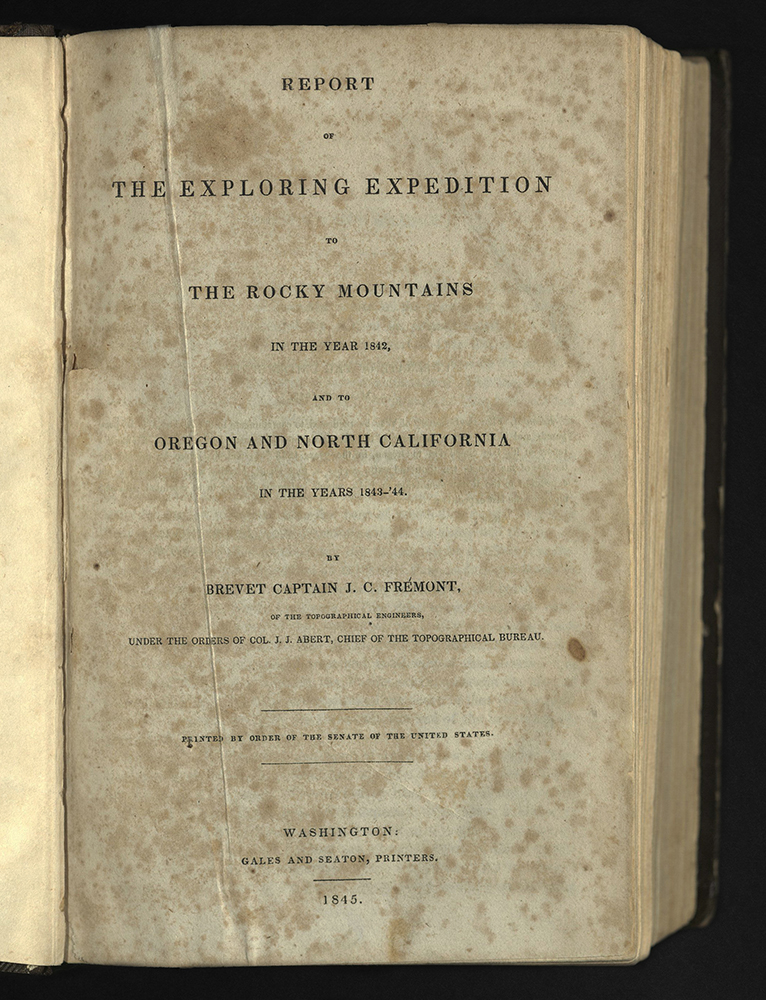
Taking leave at this point of the water of the Bear River, and of the geographical basin which encloses the system of rivers and creeks which belong to the Great Salt Lake, and which so richly deserves a future and detailed and ample exploration, I can say of it, in general terms, that the bottoms of this river, (Bear) and some of the creeks which I saw, form a natural resting and recruiting station for travelers, now, and in all time to come. The bottoms are extensive; water excellent; timber sufficient; the soil good, and well adapted to the grains and grasses to such an elevated region.
REPORT OF THE EXPLORING EXPEDITION TO THE ROCKY ...
John Charles Fremont (1812-1890)
Washington: Gales and Seaton, printers, 1845
First edition, Senate issue
F592 F874 1845
John Charles Fremont played a major role in opening up the American West to settlement by white pioneers. Fremont was the son of a Québécois father and a Virginian mother. His parents entertained influential people at their home in Charleston, South Carolina.
Fremont was appointed second lieutenant in the U.S. Topographical Corps, quickly rising within its ranks. Through the influence of his father-in-law, Senator Thomas Hart Benton of Missouri, who was the chairman of the Senate Committee on Military Affairs, Fremont was charged with leading an expedition to the Rocky Mountains in 1832. His party of twenty-five men, including Kit Carson, left the Kansas River, following the Platte River to the South Pass. From Green River the party explored the Wind River mountain range, where Fremont climbed a 13,745-foot peak, planted an American flag and claimed the Rocky Mountains and the West for the United States.
This report documents the first two of his four expeditions. The first, in 1842, explored the country between the Missouri River and the Rocky Mountains, following the Kansas and Great Platte Rivers. The second, in 1843-44, explored Oregon and Northern California, traveling from the Great Salt Lake to Vancouver, then south to San Francisco, and finally east over the California desert.
This second expedition linked the interior with the surveys of Charles Wilkes along the Pacific Coast. Fremont mapped and confirmed the Oregon Trail as the best route for pioneers heading West.
In all, Fremont’s expeditions explored 20,000 miles of wilderness, although Fremont wrote of “about ten thousand miles of actual traveling and traversing in the wilderness which lies between the frontiers of Missouri and the shores of the Pacific.” The first edition of his report, published for the American Senate, included a large map produced by Charles Preuss.
Preuss’s accurate map was of primary importance to those hoping to undertake the difficult journey west. Based on direct observation, it was more trustworthy than anything else available at the time. Fremont supplemented the map with a table of distances from Kansas Landing to Fort Vancouver.
Fremont’s report mapped out all California rivers south of the American River and the three Colorado rivers. The maps became essential for gold rush travelers.
The year after Fremont’s report was published, 1846, saw an explosion of national expansion: war over Texas with Mexico, the settlement of the dispute over ownership of the Pacific Northwest, a vast overland emigration to Oregon and California, and the Mormon flight to Utah Territory.
Fremont’s report included twenty-two lithographic plates. The plates evoked a rugged but dramatic landscape. In one plate, “Pass in the Sierra Nevada of California,” the explorers are depicted deep in snow.
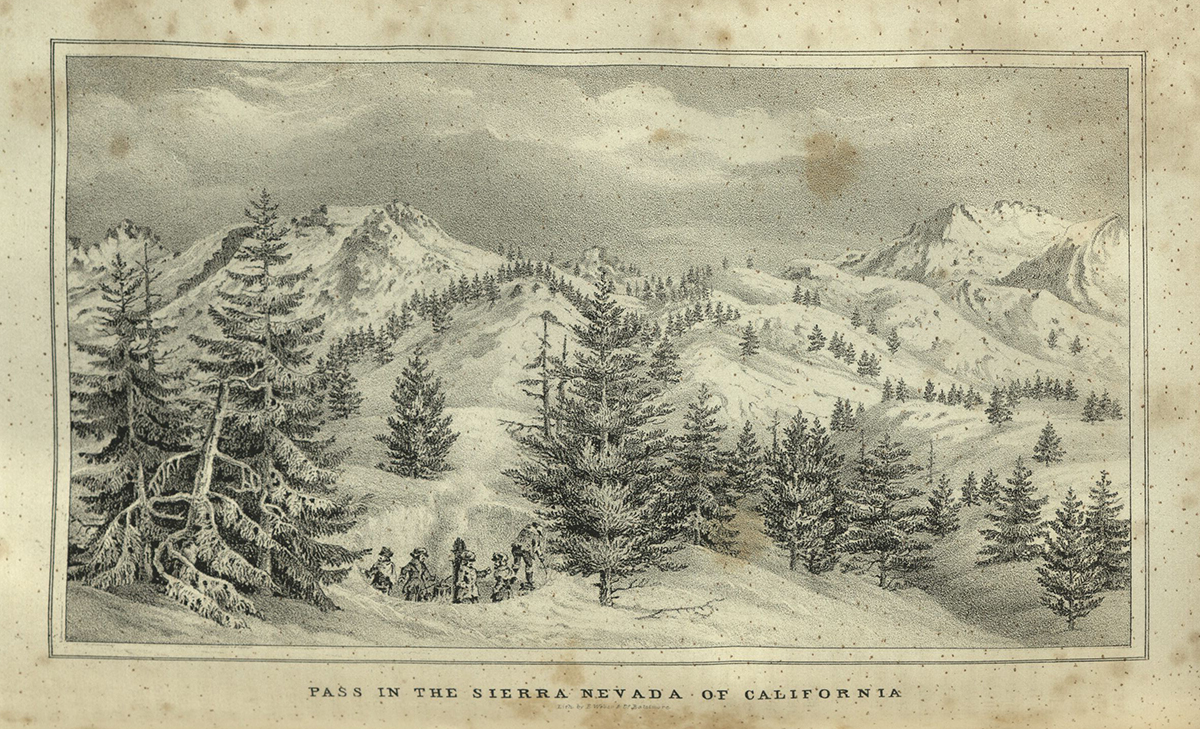
Putting on our snow shoes, we spent the afternoon in exploring a road ahead. The glare of the snow, combined with great fatigue, had rendered many of the people nearly blind…
The report, written with the help of his wife, Jessie Benton Fremont, became the cornerstone of early western exploration, capturing public imagination. Mrs. Fremont’s writing added a romantic quality to the undertaking. It introduced a public readership to then little-known mountain man Christopher “Kit” Carson, who entered into a national mythology about the West.
In one instance, Fremont described the Great Salt Lake valley as “bucolic.” Only a few years later, Brigham Young read Fremont’s report which helped him decide that the remote location was suitable for his persecuted Mormon followers. Fremont’s report had international interest, as well. The publisher of Charles Darwin’s books in the United States, William H. Appleton, sent Darwin a copy of this report.
The U.S. Senate ordered the publication of ten thousand copies of Fremont’s reports. Twenty-five editions were printed between 1845 and 1860, although the maps were not included in several of the later versions. D. Appleton & Company published several of these editions.
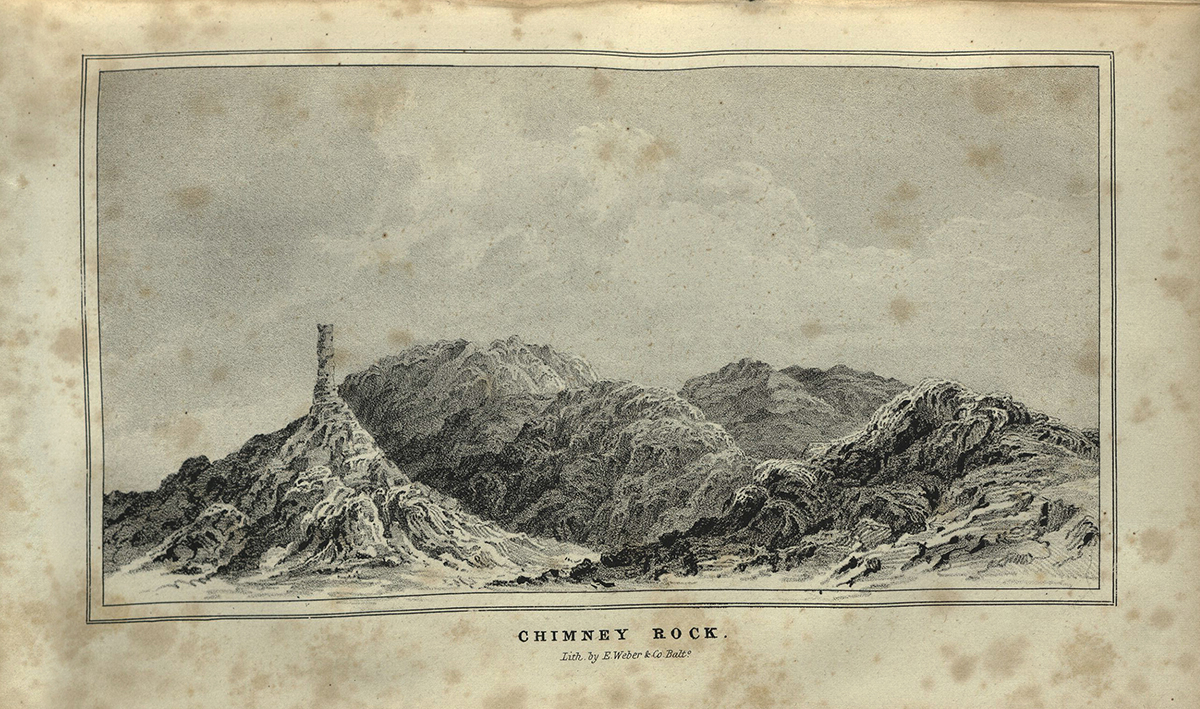
It looks, at this distance of about thirty miles, like what it is called – the long chimney of a steam factory establishment, or a shot tower in Baltimore.
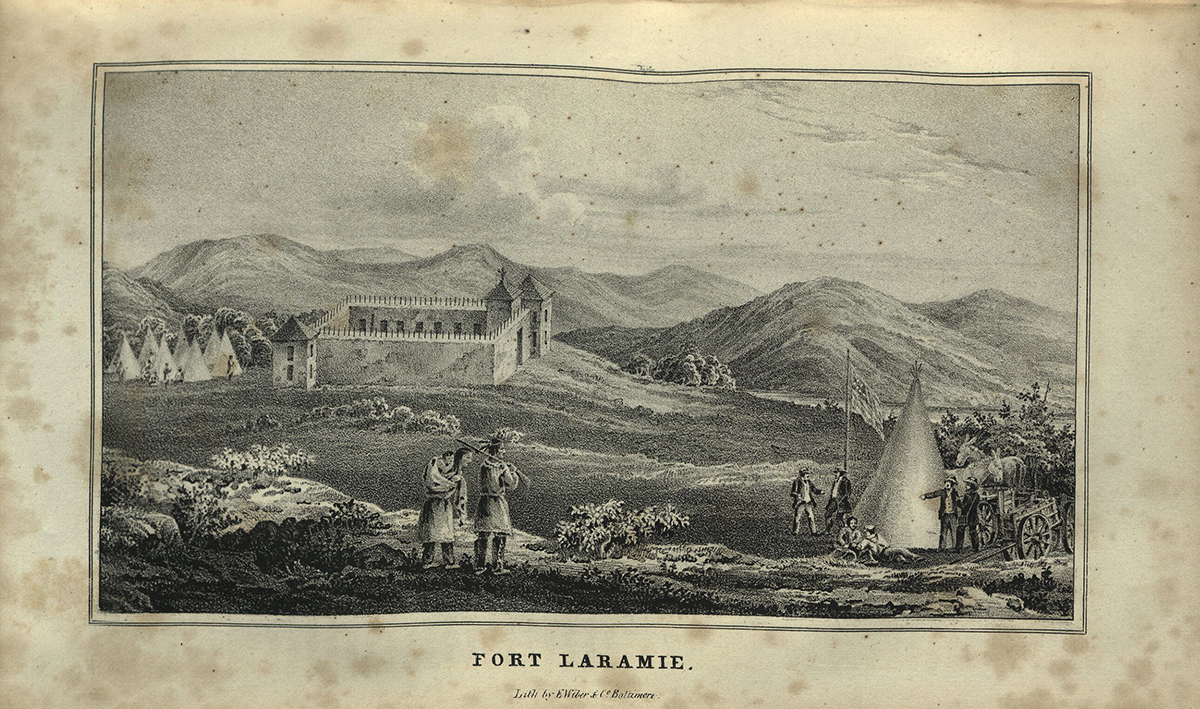
The fort had a very cool and clean appearance. The great entrance, in which I found the gentleman assembled, and which was floored, and about fifteen feet long, made a pleasant, shaded seat, through which the breeze swept constantly; for this country is famous for high winds.
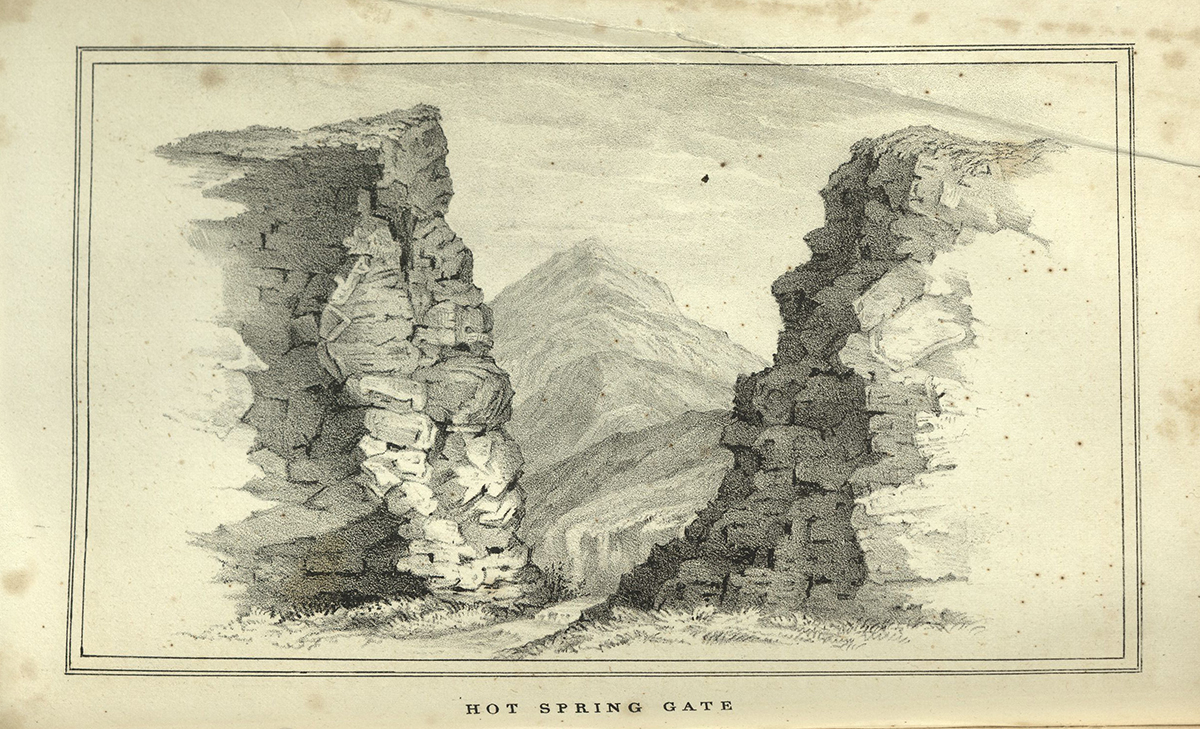
Crossing the ridge of red sandstone, and traversing the little prairie which lies to the southward of it, we made in the afternoon an excursion to a place which we have called the Hot Spring Gate.
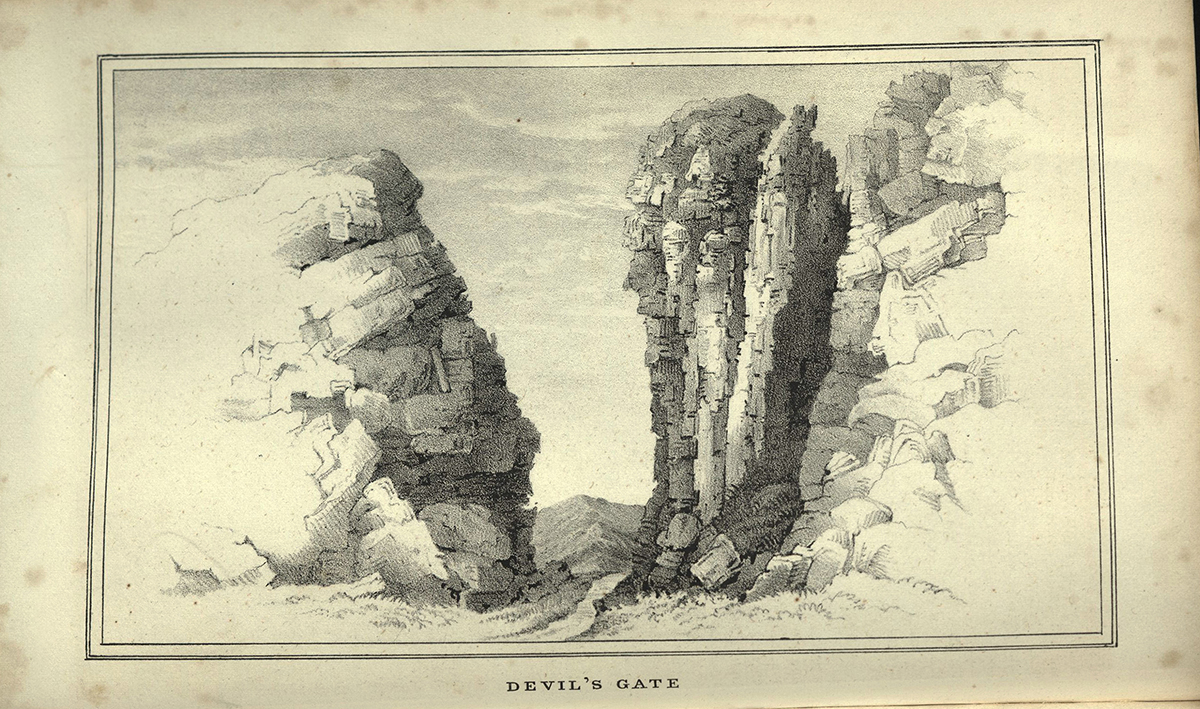
Five miles above Rock Independence we came to a place called the Devil’s Gate, where the Sweet Water cuts through the point of a granite ridge.
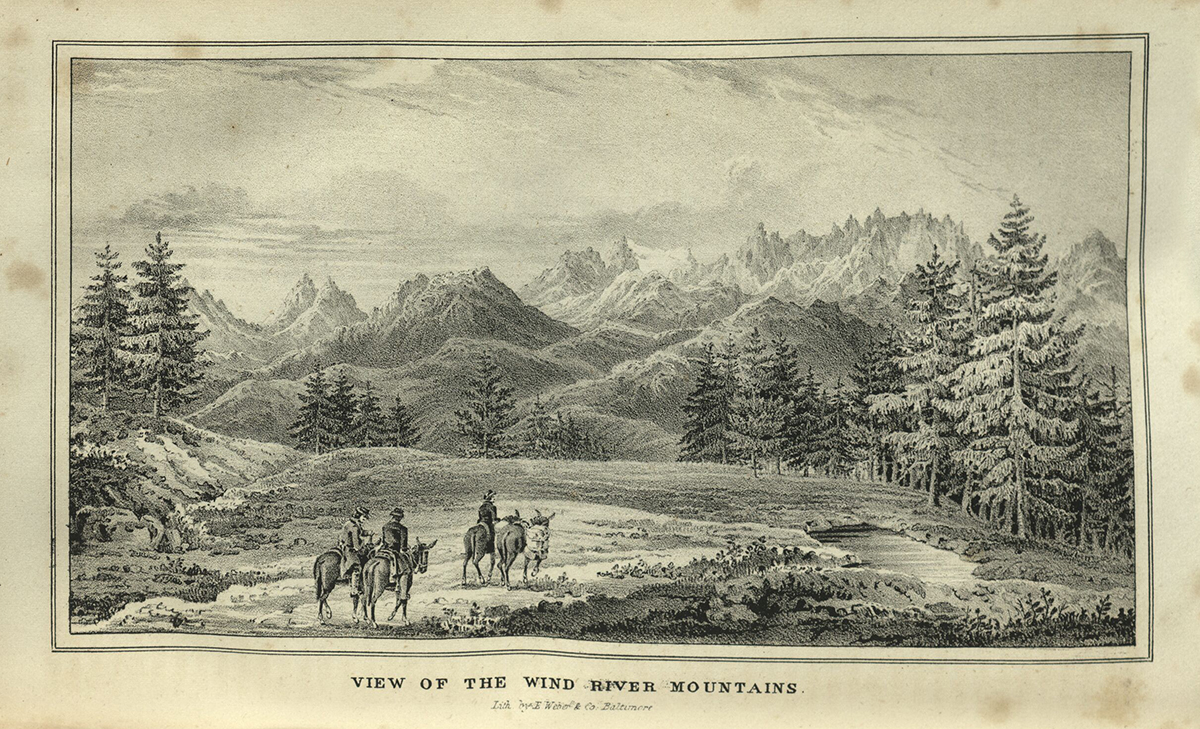
Their wildness seems well suited to the character of the people who inhabit the country.
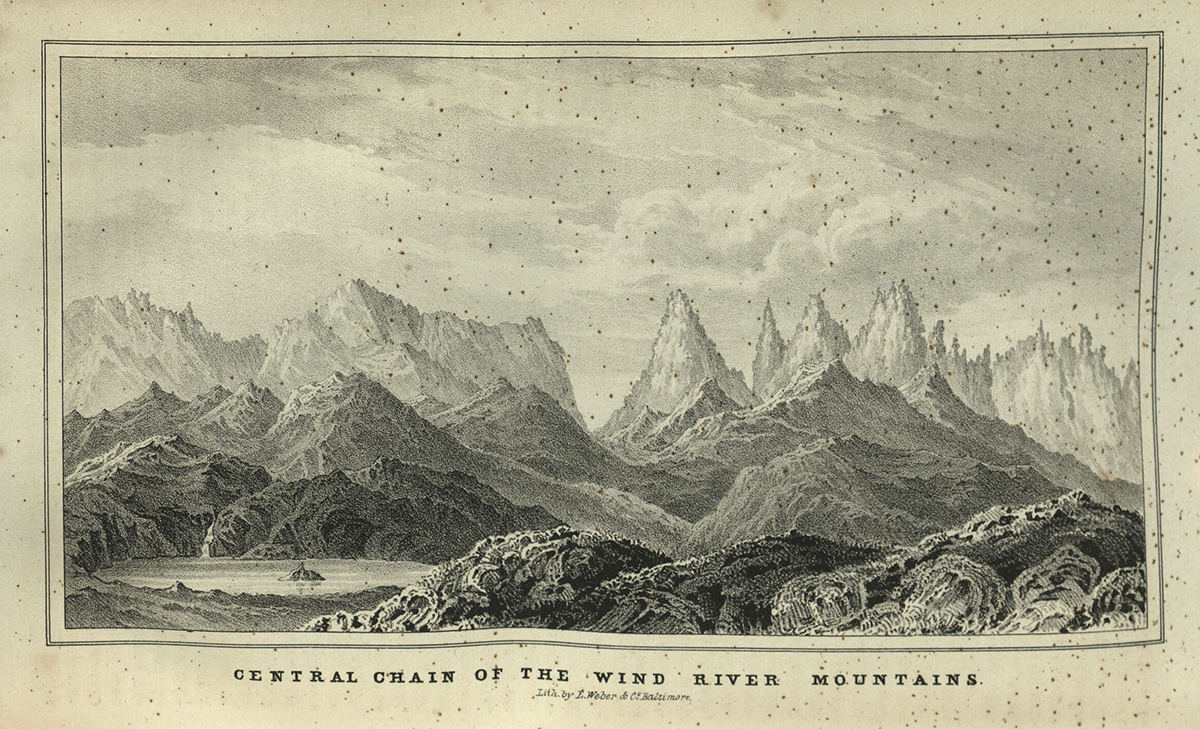
Around us, the whole scene had one main striking feature, which was that of terrible convulsion.
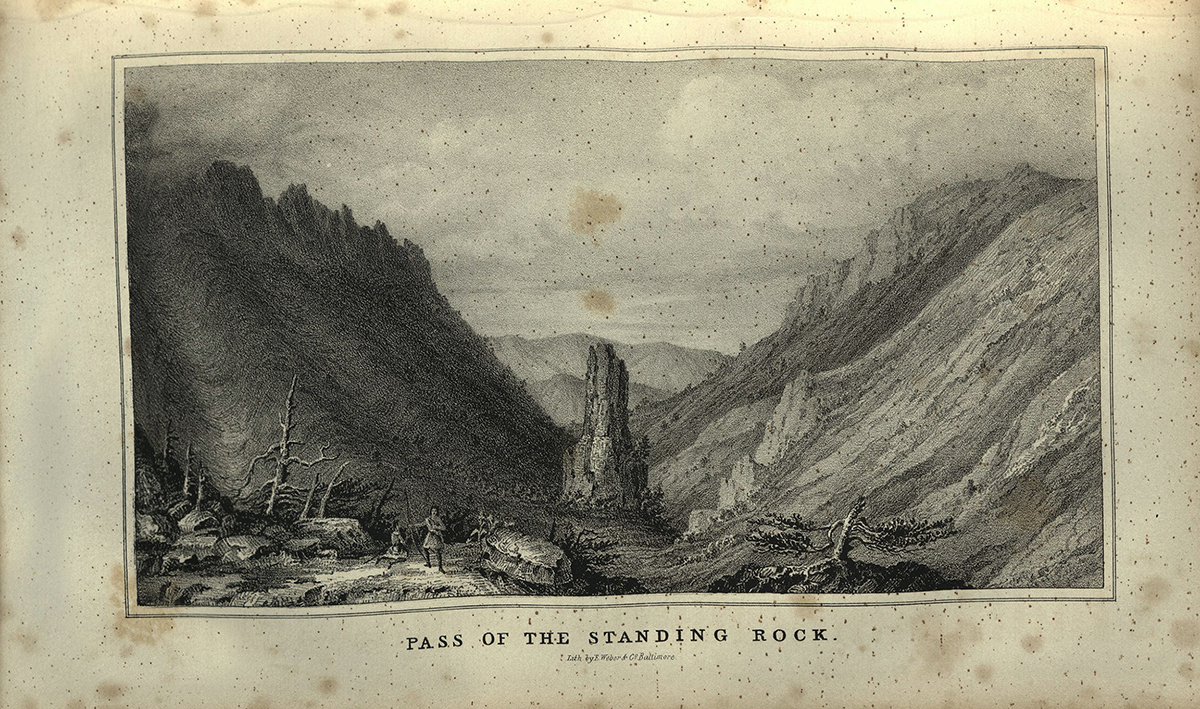
… a huge rock, fallen from the cliffs above, and standing perpendicularly near the middle of the valley, presents itself like a watch tower in the pass…generally the mountains rise abruptly up from comparatively unbroken plains and level valleys…where a green valley, full of foliage, and a hundred yards wide, contrasts with naked crags that spire up into a blue line of pinnacles…sometimes crested with cedar and pine, and sometimes ragged and bare.
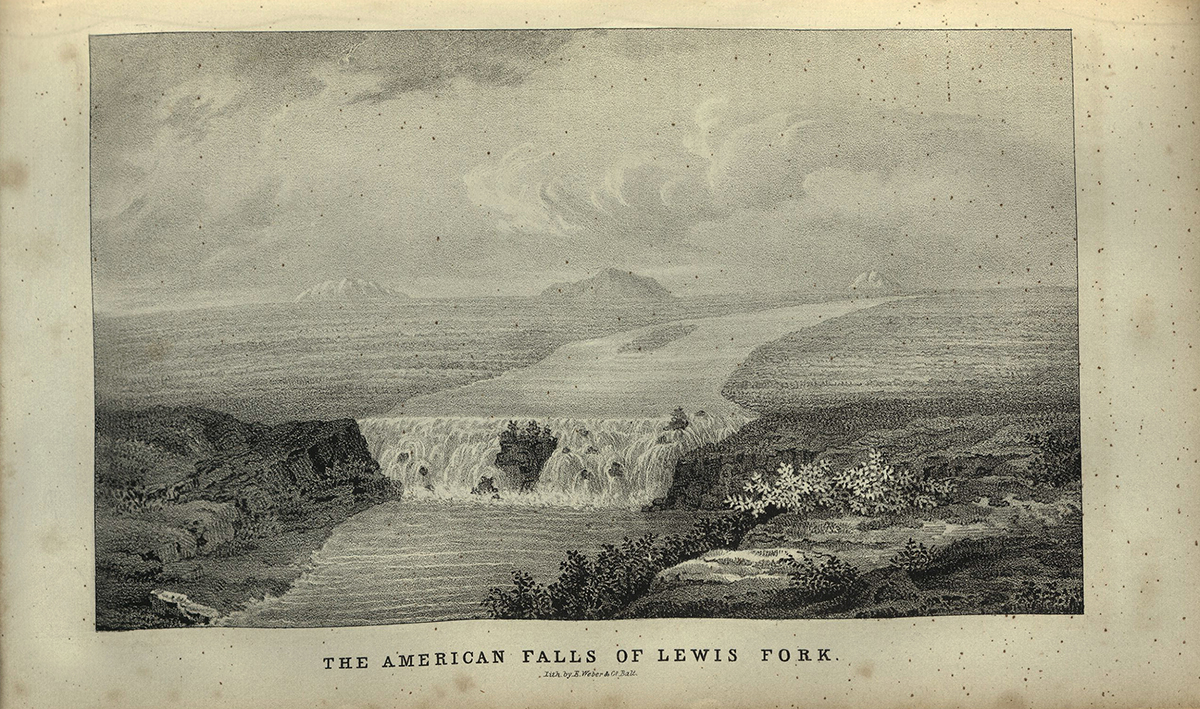
In the south is a bordering range of mountains, which, although not very high, are broken and covered with snow; and at a great distance to the north is seen the high, snowy line of the Salmon river mountains, in front of which stand out prominently in the plain the three isolated rugged-looking little mountains…
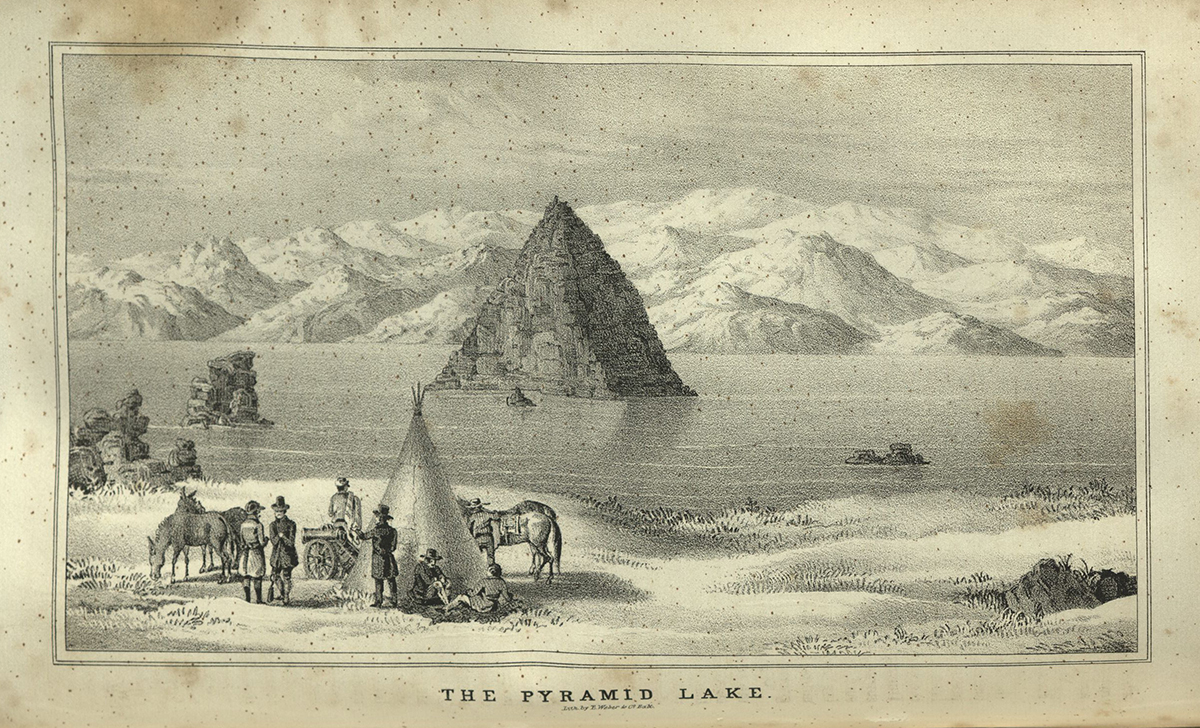
…we encamped on the shore, opposite a very remarkable rock in the lake, which had attracted our attention for many miles.
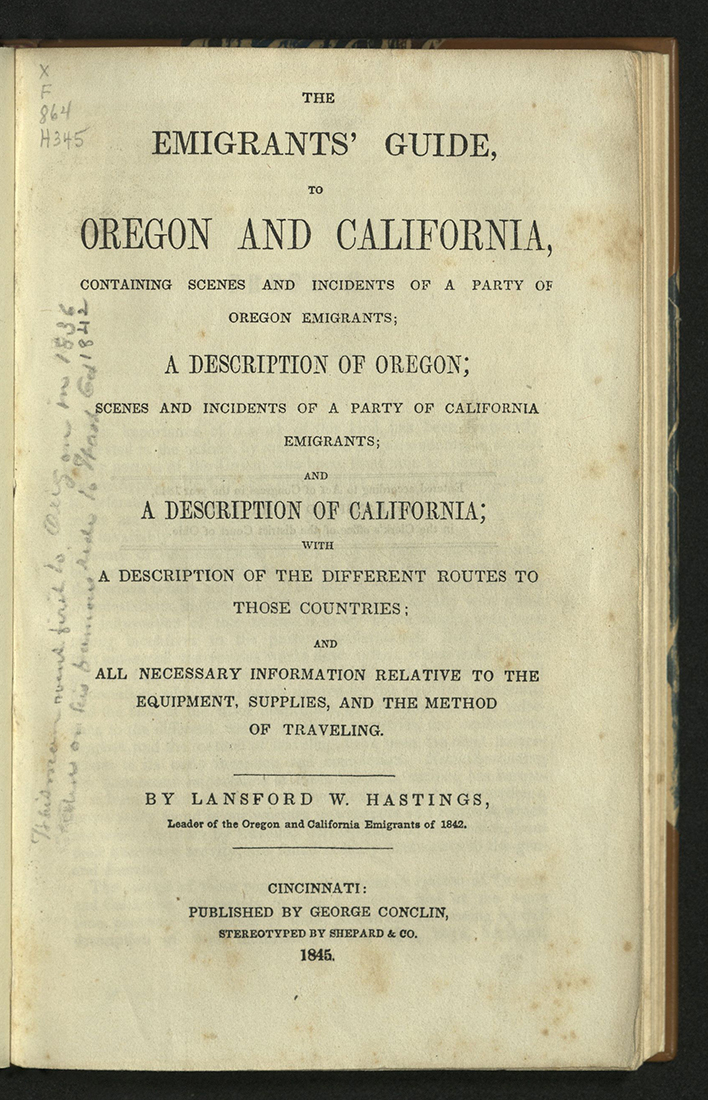
The most direct route, for the California emigrants, would be to leave the Oregon route, about two hundred miles east from Fort Hall, thence bearing west southwest to the Salt Lake ; and thence continuing down to the bay of San Francisco, by the route just described.
THE EMIGRANT'S GUIDE TO OREGON AND CALIFORNIA
Lansford Warren Hastings (1819-1870?)
Cincinatti: G. Conclin, 1845
First edition
F864 H345
Lansford Warren Hastings was a real-estate investor from Ohio. In 1842, at the age of twenty-three, he made a trip west to California, where he developed financial and political interests. His Emigrant’s Guide became a bestseller.
The book had almost no practical advice, in spite of the crowing in its preface of providing "a description of the different routes; and all necessary information relative to the equipment, supplies, and the method of traveling" with the caveat that "all excrescences have been cautiously lopped off, leaving scarcely any thing more than a mere collection of interesting, important and practical facts." To make up for the lack of "excrescences," Hastings regaled the reader with lengthy and snarky anecdotes regarding "Californians," gamblers and drunks, all. "How different are the priests of California from those of the same denomination of christians in our own country?"
In his guide he depicted Indians as lazy and Mexicans as dishonest, blaming much of the latter on the priests of the Roman Catholic Church. "At times, I sympathize with these unfortunate beings, but again, I frequently think, that perhaps, are thus ridden and restrained and if they are thus priest ridden, it is, no doubt, preferable, that they should retain their present riders." As for Indians, Hastings wrote, with no irony, that they "in numerous instances, abandoned their old haunts, and re-established in other portions of the country, but for what cause, it is difficult to ascertain, with any degree of certainty, for the sites which have been thus abandoned, appear in many instances, to possess advantages much superior, to those which have been subsequently selected." Hastings’ "little work," as he called it, was inspirational to those wishing to escape the crowded conditions and poor economy of the east and Midwest.
Hastings’ book promoted the land and climate of California as ideal companions for hardworking Americans. Many sold farms and gave up businesses as the lure a better life captivated their imaginations.
Hasting’s guide book had good information: "All persons designing to travel by this route, should, invariably, equip themselves with a good gun" and "It would, perhaps, be advisable for emigrants, not to encumber themselves with any other, than those just enuerated; and it is impracticable for them, to take all the luxuries, to which they have been accustomed, and as it is found, by experience, that, when upon this kind of expedition, they are not desired, even by the most devoted epicurean."
His guidebook also had bad information. Eager to sell land, he encouraged travelers to forget about Oregon and make their way to California, suggesting a cutoff through the Wasatch Mountains, passing to the south of the Great Salt Lake and then across the salt flats to rejoin the California Trail at the Humboldt River. A conversation with John C. Fremont suggested to Hastings that this was a viable possibility.
Hastings, who had not, in fact, traveled this route himself, was sure the shortcut would save travelers valuable time and began his promotion. The cutoff avoided anywhere from two hundred to four hundred and fifty miles off the northwestward route to Fort Hall and thence to the Humboldt River, saving weary travelers around fifteen to thirty days. But this was a new wagon road and fraught with difficulties.
It was Hastings’ intent to attempt the crossing and he headed east to pick up a group of pioneers. Hasting’s followed Fremont’s tracks eastward to the Salt Lake Valley. He went up Parley’s Canyon, over Big Mountain, and on to the Weber River, traveling upstream to Echo Creek, crossing Bear River near present-day Evanston, Wyoming. From there he intersected with the Oregon Trail. He thought that the Great Salt Lake Desert might pose a problem for groups heading west, but having crossed it on horseback, failed to recognize how difficult crossing the desert mud would be for heavily-laden wagons. His traveling guide, James Clyman, had twenty years experience in the area and urged California-bound emigrants not to take this cutoff. The route turned out to be fatal for members of one eager group, the Donner Party.
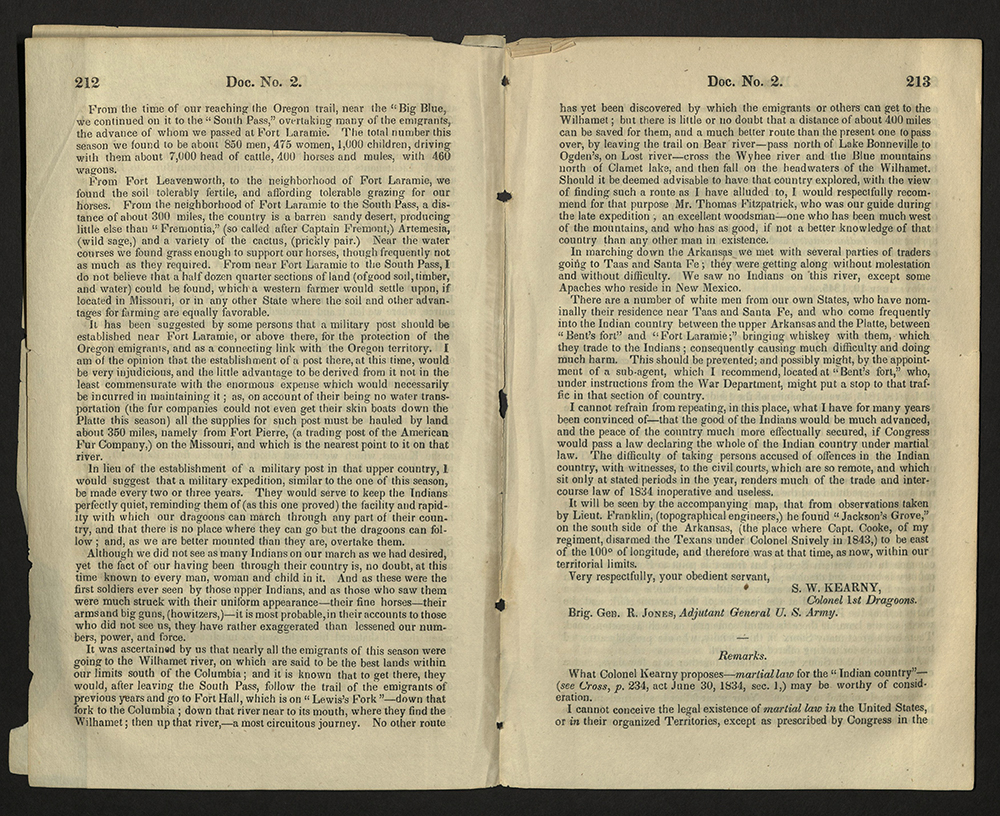
I cannot refrain from repeating, in this place, what I have for many years been convinced of – that the good of the Indians would be much advanced, and the peace of the country much more effectually secured, if Congress would pass a law declaring the whole of the Indian country under martial law.
REPORT OF A SUMMARY CAMPAIGN TO THE ROCKY MOUNTAINS ...
Stephen Watts Kearny (1794-1848)
Washington: Ritchie & Heiss, 1845
First edition
E405.2 K4 1845
In 1845, five companies of dragoons consisting of sixteen officers and more than two hundred and fifty enlisted men, under the command of Colonel Stephen Kearny, left Fort Leavenworth, heading northwest on what would become the Oregon Trail, to Wyoming, down along the Rocky Mountains to Mexican territory, and north again via the Santa Fe Trail. The march displayed the military power of the United States to native tribes and to the British government. Kearny took every opportunity on the march to display the might of the United States government. He flashed two mountain howitzers and lots of carbines. In all, Kearny covered a total distance of 2,073 miles in 99 days.
In his report to the United Stated Congress, Kearny described the route, his encounters with the Pawnee, Sioux, Cheyenne, and Arapaho; the soil and landscape, and the traders moving goods to and from Santa Fe.
Near Fort Laramie, where he left one hundred dragoons, Kearny met with the Sioux to try to persuade them not to attack the emigrant wagon trains heading West. He also admonished them against imbibing in the alcohol offered them by traders. According to Kearny, white traders from New Mexico had followed the Taos Trail to Colorado and beyond for decades to exchange whiskey for furs and buffalo robes.
Kearny wrote that the best way to protect American settlers traveling to Oregon was to continue marches such as these to remind native tribes of the “facility and rapidity with which our dragoons can march through any part of their country.” He advocated seasonal patrols over the emigrant route to Oregon, arguing against the expense of permanent posts.
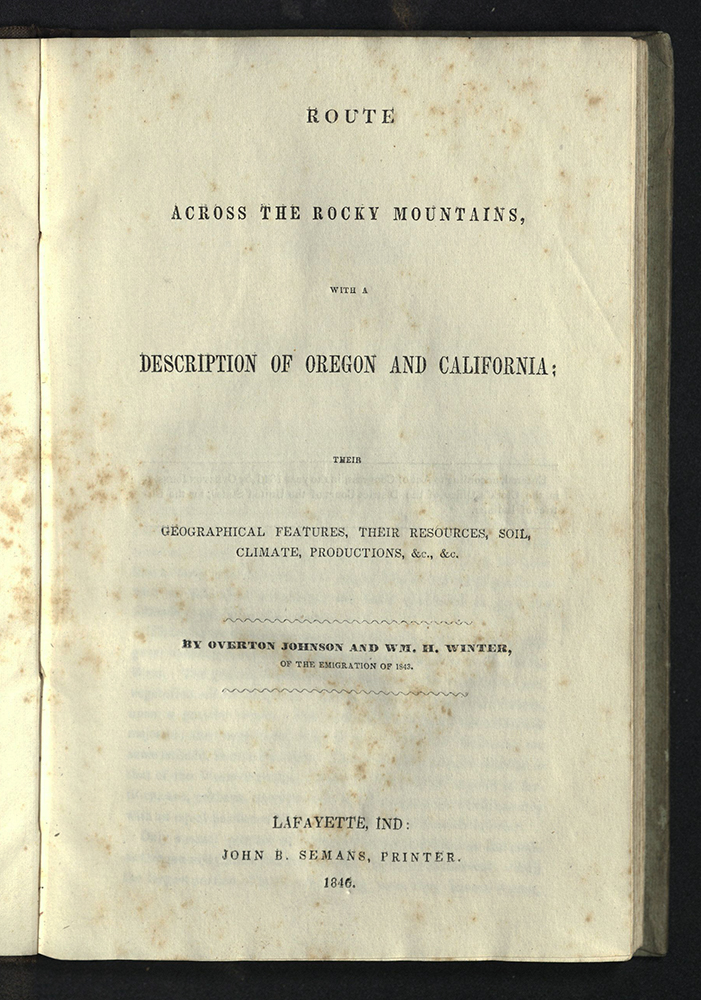
Having passed these rapids, we arrived, in a few minutes, at Oregon City, situated at the Falls of the Willammette, the place of our destination. This was the 13th of November, 1843, and it was five months and nineteen days after we left Independence, in Missouri. Here we were able to procure such things as were really necessary to make us comfortable; and, what was most especially pleasing to us, an abundance of substantial food.
ROUTE ACROSS THE ROCKY MOUNTAINS
Overton Johnson and William H. Winter (1819-1879)
Lafayette, IN: J.B. Semans, printer, 1846
First edition
F851 J68
This is one of the earliest overland guide books to the Oregon Trail, second only to William Hasting’s guide published a year earlier.
Overton Johnson and William Winter, both from Indiana, left Independence, Missouri on May 25, 1843 and arrived in the Willamette Valley on November 13 of that year. Like others, they made the trip both for adventure and economic opportunity. Winter went on to California the following year, and then met up with Johnson by accident at Fort Hall, Idaho. The two returned to Indiana together, where they arranged the publication of this book in time for the 1846 emigrant season.
The book gives an account of their contact with Indians, their customs, dances, and methods of warfare. The route traveled to California and the return to Ft. Hall is vividly described. The guidebook mentions the Bear Flag Rebellion, the production of wine, and the presence of gold in northern California.
Twelve of their fellow travelers didn’t make it, including a six-year-old who was crushed by a wagon wheel. Winter eventually settled in Napa Valley.
The Appendix includes complete instructions to emigrants with regard to supplies, equipment, an itinerary, and notes on various stopping places along the way.
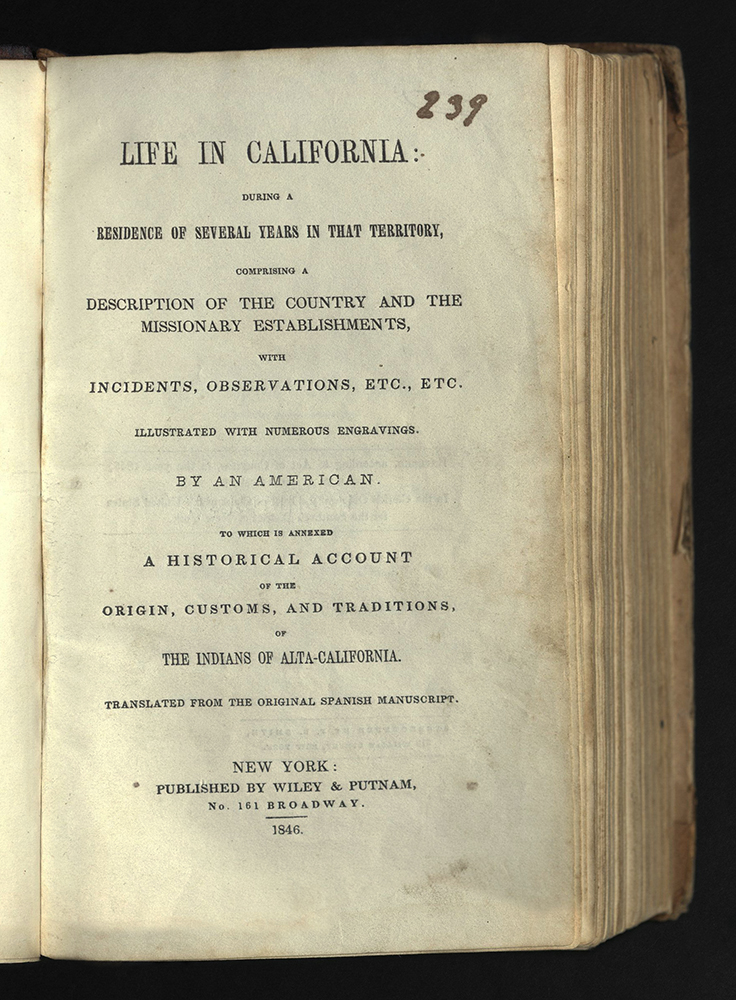
They passed their time in play, and roaming about from house to house, dancing and sleeping and this was their only occupation…The women were obliged to gather seeds in the fields, prepare them for cooking, and to perform all the meanest offices as well as the most laborious. It was painful in the extreme, to behold them with the infants, hanging upon their shoulders, groping about in search of herbs and seeds.
LIFE IN CALIFORNIA ...
Alfred Robinson (1806-1895)
New York: Wiley & Putnam, 1846
First edition
F864 R65 1846
Originally from Massachusetts, Alfred Robinson arrived in California in 1829 as representative for the hide-trading and shipping firm Bryant, Sturgis & Co. He married Anita de la Guerra de Noriega y Carrillo, heiress of the prominent De Guerra family of Santa Barbara.
Life in California is the first book on California published in English written by a resident, containing Robinson’s personal observations of Spanish rule and detailed descriptions of Alta California under Mexican rule. It is a comparatively sympathetic portrait of the Californios living under the Mexican Republic.
The book includes Robinson’s translation of Fr. Geronimo Boscana’s (1776-1831) Chinigchinich, an historical account of the beliefs and customs of the Acagchemem (called Juaneño by the Spanish colonizers) tribe of the mission of San Juan Capistrano. Boscana’s ethnographic contribution resulted from an 1812 questionnaire sent by the Spanish government to the Missionaries of Alta California. This is published here as an appendix. Boscana died at Mission San Gabriel and is the only missionary to be interred among 2,000 other mission inhabitants, mostly Tongva-Gabrielino Indians.
The Acagchemem people dwelled along the coast in what is now Orange and San Diego counties. Many of them were baptized at Mission San Juan Capistrano in the late eighteenth century. Robinson estimated the non-Indian population of Alta California at 8,000, and the Indian population at 10,000. In 1770, the estimated aboriginal population was 133,550. The Juaneño Band of Mission Indians, Acjachemen Nation is recognized by the State of California, but not yet by the federal government, preventing it from accessing, protecting and restoring their ancestral lands and sites.
The book is illustrated with lithographs from Robinson's now-lost drawings of four California missions.
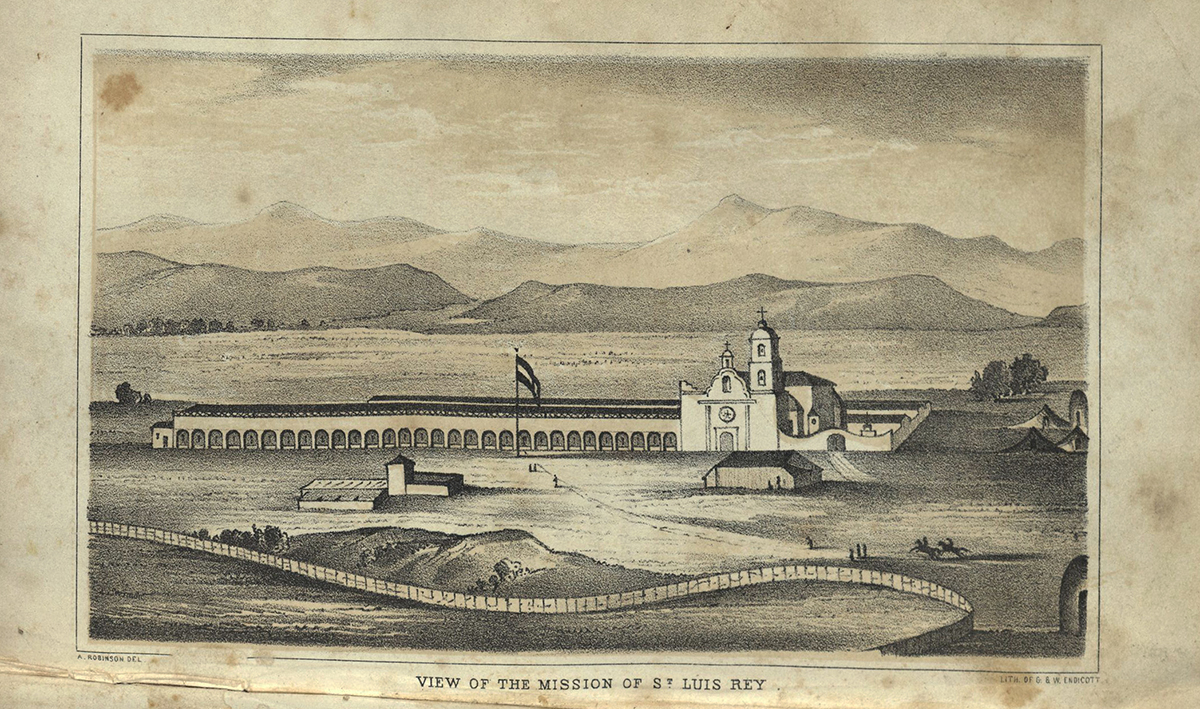
The reverend father was at prayers, and some time elapsed ere he came, giving us a most cordial reception. Chocolate and refreshments were at once ordered for us, and rooms where we might arrange our dress, which had become somewhat soiled by the dust.
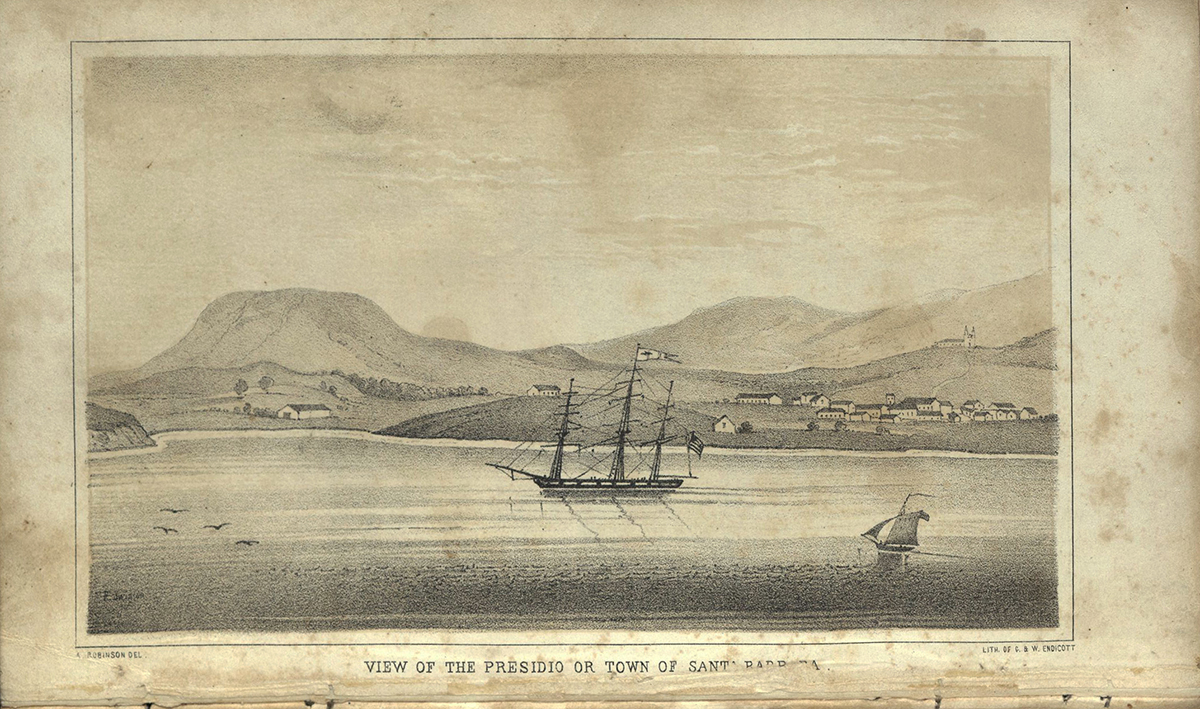
Seen from the ship, the “Presidio” or town, its charming vicinity, and neat little Mission in the background, all situated on an inclined plane, rising gradually from the sea to a range of verdant hills, three miles from the beach, have a striking and beautiful effect.
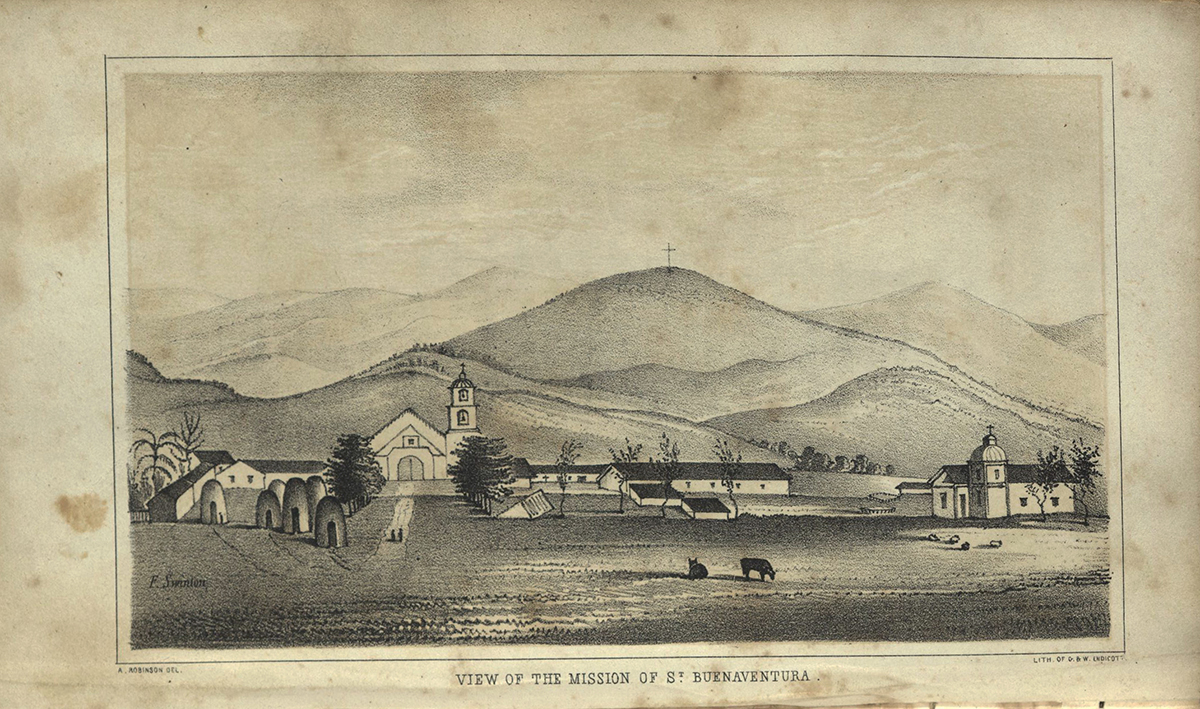
… we set out on an excursion to St. Buenaventura. The road thither is partly over the hard sandy beach, and at times, when the tide is low, it is possible to perform the whole journey over this smooth level. We were not over two hours on the road, and arrived before dinner, finding the reverend father Francisco Uria closely wrapped up in his studies, in his sitting apartment.
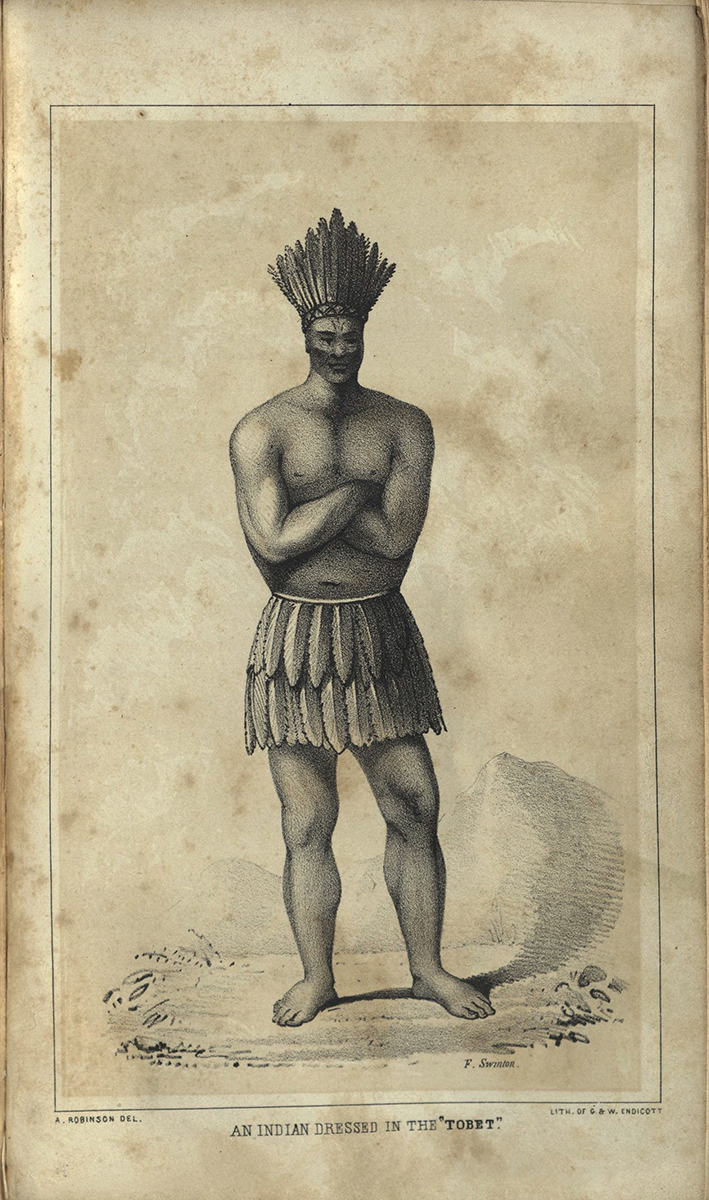
… they fixed upon the head a kind of wig, called “emetch,” that was made secure, by a braid of hair passed around the head, into which, they inserted various kinds of feathers, forming a crown, or ad they termed it, an “eneat;” then, there covering for the body, was also prepared from the feathers of different kinds of birds, which were sewed together, an like a sort of petticoat reached down to their knees – this they called a “paelt.”
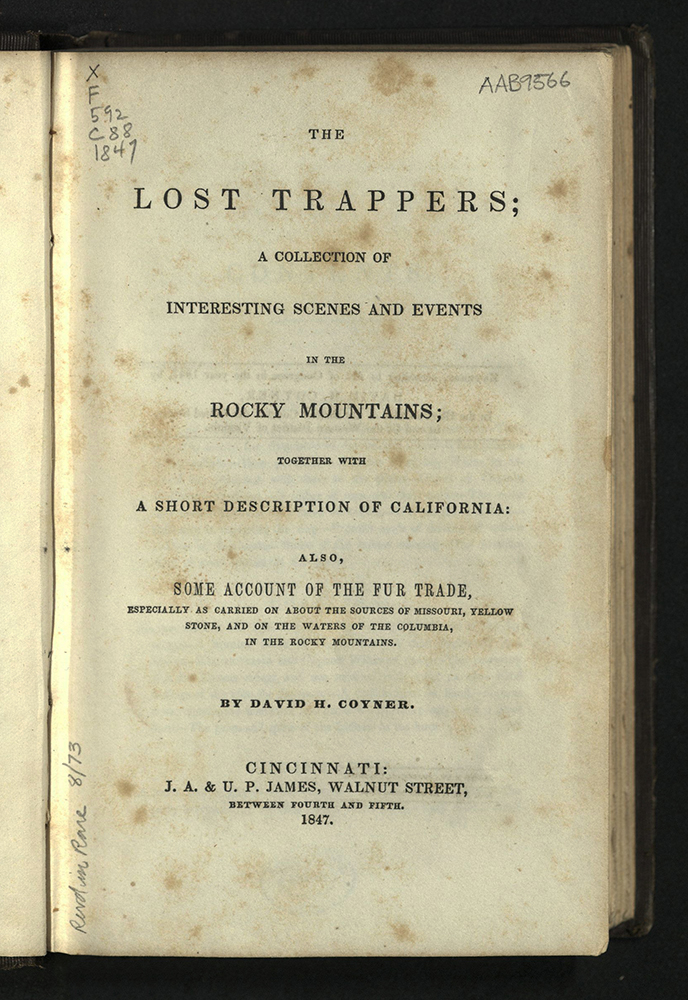
They take to themselves wives, and domesticate themselves among the different tribes in the west…the result of this intermixing and intermarrying has been the springing up of a numerous hybrid race of beings, that constitute a medium, through which, it is hoped, at no distant day, the laws, arts, and habitudes of civilized life may be successfully introduced among the tribes of the west, and be the means of reclaiming them from the ignorance and barbarities in which they have been so long enthralled.
THE LOST TRAPPERS
David H. Coyner (1807-1892)
Cincinnati: J.A. & U.P. James, 1847
First edition
F592 C88 1847
This fictionalized narrative of the American West apparently had its beginnings as the now-lost journal of Ezekial Williams written between 1807 and 1809 while on an overland trapping expedition. Williams, a Missourian, was caught in the Rockies until he became a prisoner of the Kansas Indians. He was freed in 1814 and returned to the Rockies, descending the Arkansas River, where low water compelled him to cache his furs.
Seventeen of the twenty men who set out on the original expedition died from hunger and disease or were killed by Comanche. The survivors met Spanish traders at an outpost on the Colorado near Santa Fe and went with them to California. Williams found the Missouri and made it back to St. Louis.
Much of the authenticity of Coyner’s account has been questioned by historians, who note the many geographical inaccuracies. Other historians, though, consider the basic account genuine, albeit embellished. Certainly, Coyner took some information from the written accounts of the Lewis and Clark expedition. Coyner also most likely used material he heard from trappers returning from the plains and the eastern slope of the continental divide.
Fact or fiction, the work remains one of the most interesting descriptions of early days on the plains and of the fur trade. It played a part in the already legendary depiction of the mountain man who deliberately rejected civilized life. The proverbial Mountain Man despised uniformity and monotony, thriving instead on the wild west adventure. Security and law had no attraction for him. He wanted no defense other than his own rifle, his constant companion. He was impatient with formalities and galled at the restrictions of a well-organized society, preferring the liberty of a life in the woods.
Fewer than thirty years after The Lost Trappers was written, a substantial portion of the buffalo herds were decimated, mostly by a policy of the United States government denying Plains Indians a central feature of their roving lives.
Coyner’s view of the Native Americans is very much a part of the American mindset of the time. As uncivilized as they were, the Mountain Man could introduce some civility to those deemed even more savage.
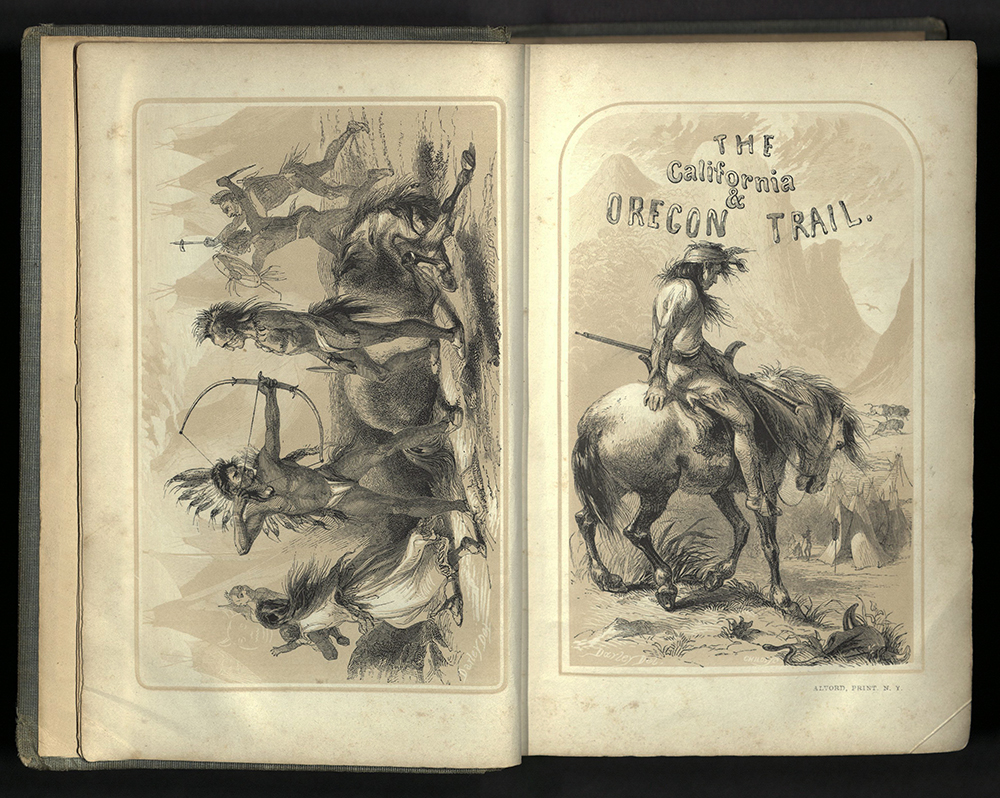
Great changes are at hand in that region. Within a few years the traveller may pass in tolerable security through country. Its danger and its charm will have disappeared altogether.
THE CALIFORNIA AND OREGON TRAIL
Francis Parkman (1823-1893)
New York, London: 1849
First edition
F592 P24 1849
One of the most widely read and influential narratives of the American frontier, six editions of The California and Oregon Trail were published within the first ten years of this initial first printing. A Boston attorney, Francis Parkman set out from St. Louis in April 1846 to explore the American West, traveling from western Missouri to Oregon. He toured the high plains of Nebraska, Wyoming, Colorado, and Kansas.
Parkman undertook his journey in an attempt to restore his health, but he was keenly interested in learning about Native American life and gathering information for his planned history of the conflict between the French and British in North America. In spite of fragile health and poor eyesight, Parkman kept a daily record of his tour.
Traveling along the Oregon Trail and then south following the eastern edge of the Rockies, he returned on the Santa Fe Trail. Along the way he lived with a band of Sioux and met with legendary frontiersmen like Jim Beckwourth. After his return East, in utter physical collapse, he dictated this work to his cousin.
The account is part history, part travel narrative, and part adventure story, written with an eastern, European sensibility. His eye well-attuned to the West as a wilderness quickly vanishing, his writing is not so much sentimental as it is nostalgic. Of Kansas he wrote, “the alternation of rich green prairies and groves that stood in clusters, or lined the banks of the numerous little streams, had all the softened and polished beauty of a region that has been for centuries under the hand of man.” Of the buffalo he wrote, “You are too ugly to live.”
Parkman’s tour brought him into contact with Hispanics, “thirty or forty dark slavish-looking Spaniards, gazing stupidly out from beneath their broad hats.” Parkman went on to become one of the most noted historians of the nineteenth century.
University of Utah copy 2 has handwritten shelfmark, “No. 2107 Utah Library Salt Lake City Utah Ty” (Territory) and University of Deseret stamp.
A virgin empire has been added to the United States… She is without government, without laws, without a military force, while tens of thousands of adventurers from all parts of the earth are pouring into her golden valleys…and will be transformed by the evil spirit of avarice…
A TOUR OF DUTY IN CALIFORNIA ...
Joseph Warren Revere (1812-1880)
New York & Boston: C. S. Francis & Co. & J. H. Francis, 1849
First edition
F865 R4
Joseph Revere, a grandson of Paul Revere, was an Annapolis graduate. As a Naval officer, he fought in the Mexican-American War, commended for bravery in battle. Revere pulled down the Bear Flag and raised the first American flag to fly in Sonoma. He wrote of an invasion of Walla Walla Indians into the Sacramento Valley, describing the Californios, American, and Indian cooperation in dispelling the crisis.
In 1850, he joined the Mexican Army. As a colonel, he reorganized the Mexican Artillery Corps. For his rescue of Spanish citizens he received knighthood from Queen Isabella II.
His work, Tour of Duty, is well-regarded as a firsthand account of the American takeover in California. Revere wrote exuberantly of California: its natural resources, herds of cattle, flourishing crops, and rivers, lakes and coasts offering an abundant supply of fish. Descriptions include land law and land titles as well as reports on the gold fields. “I had travelled over the richest placers a thousand times, but it never occurred to me to wash the golden sands over which I travelled and upon which I slept.” Revere became so enamored with California that he bought a rancho near Sonoma.
The book is illustrated with drawings by Revere, lithographed by William Endicott & Company. A folded map depicts the San Francisco harbor.
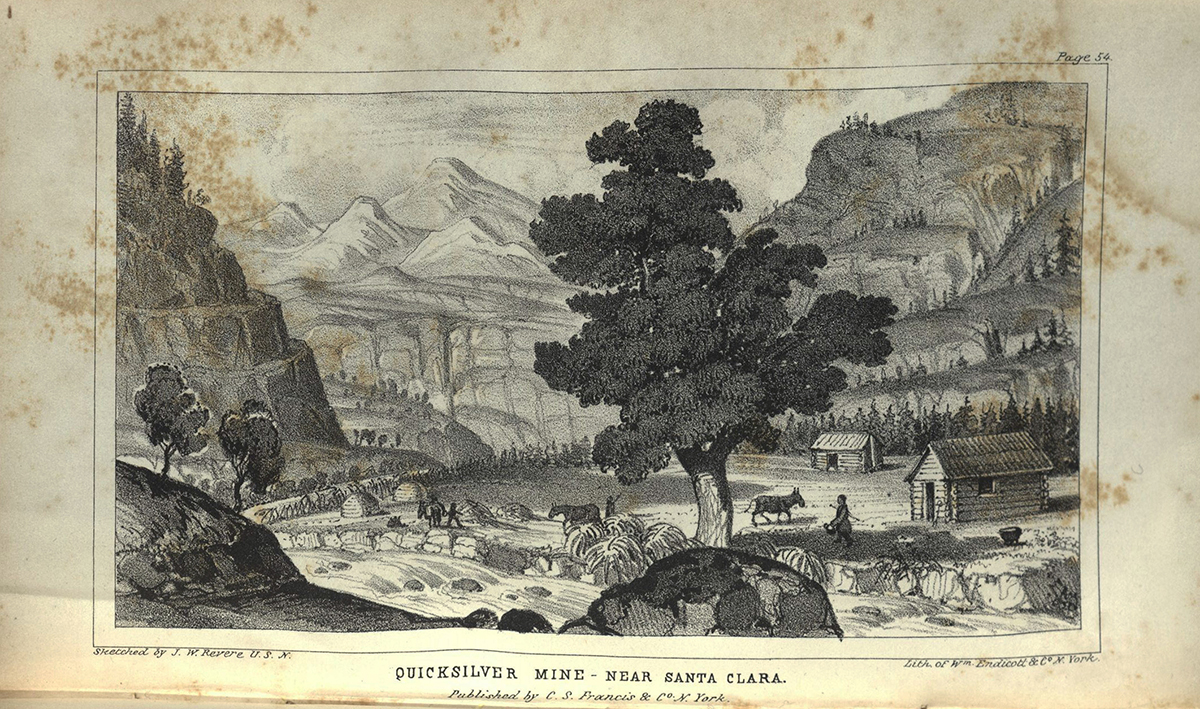
This extensive plain is divided into ranchos of four and eight square leagues in extent, and the soil is a black loam many feet deep, as any one can see in passing the dry beds of what, in the wet season, are running streams, emptying into the bay.
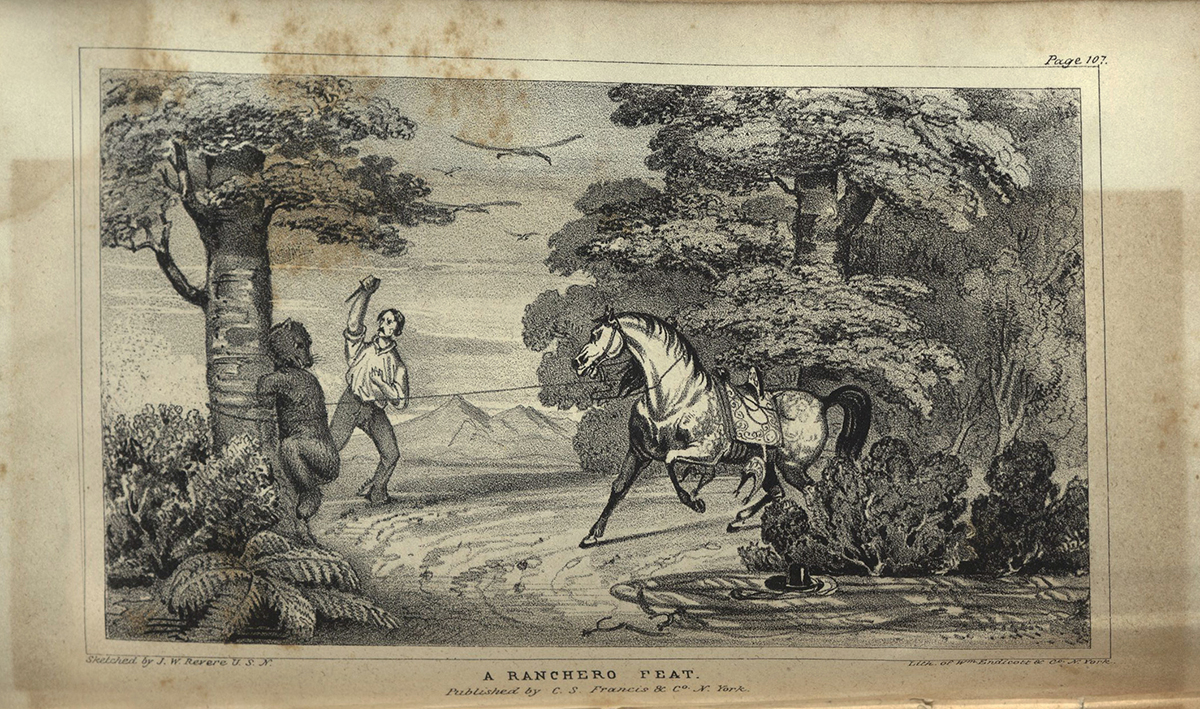
The severest test of these qualities is his behavior in attacking a bear, a feat often undertaken by a single ranchero, without other aid than his horse, his inseparable friend the riata, and the accustomed knife worn in his garter.
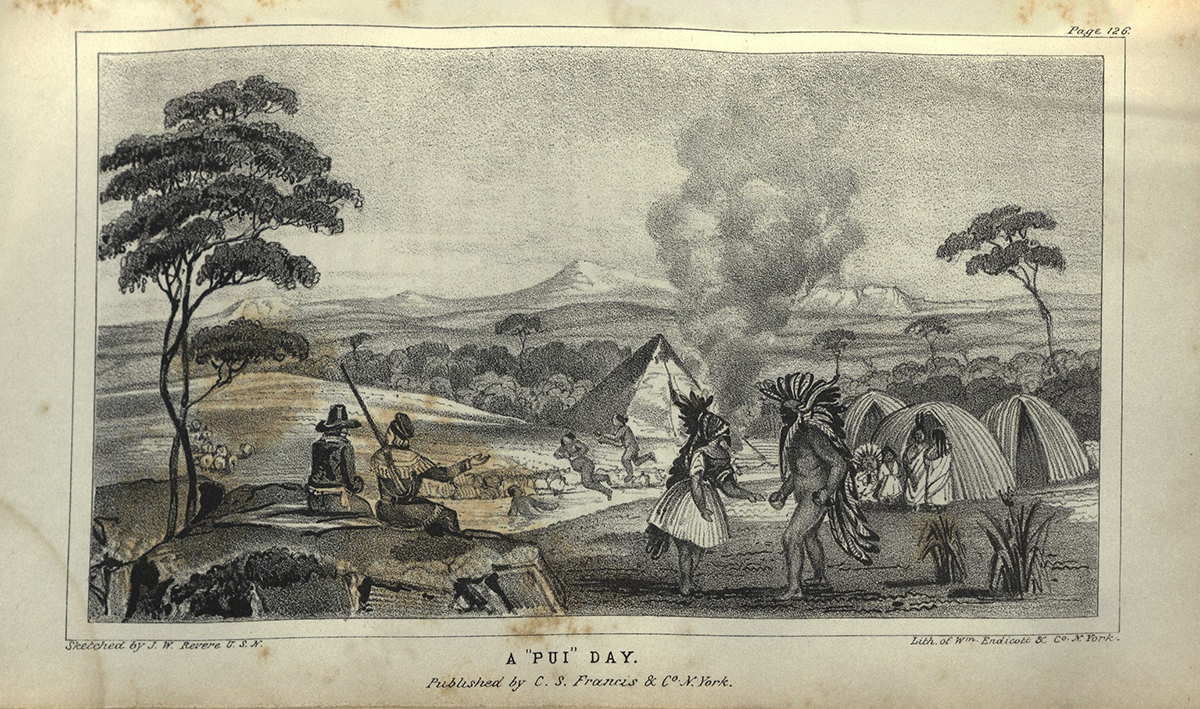
They are also employed in the celebration of rites of a peculiar nature, analogous to those practiced by the ancients in the mysteries of Pan and Apollo in the cave of the Parthenon.
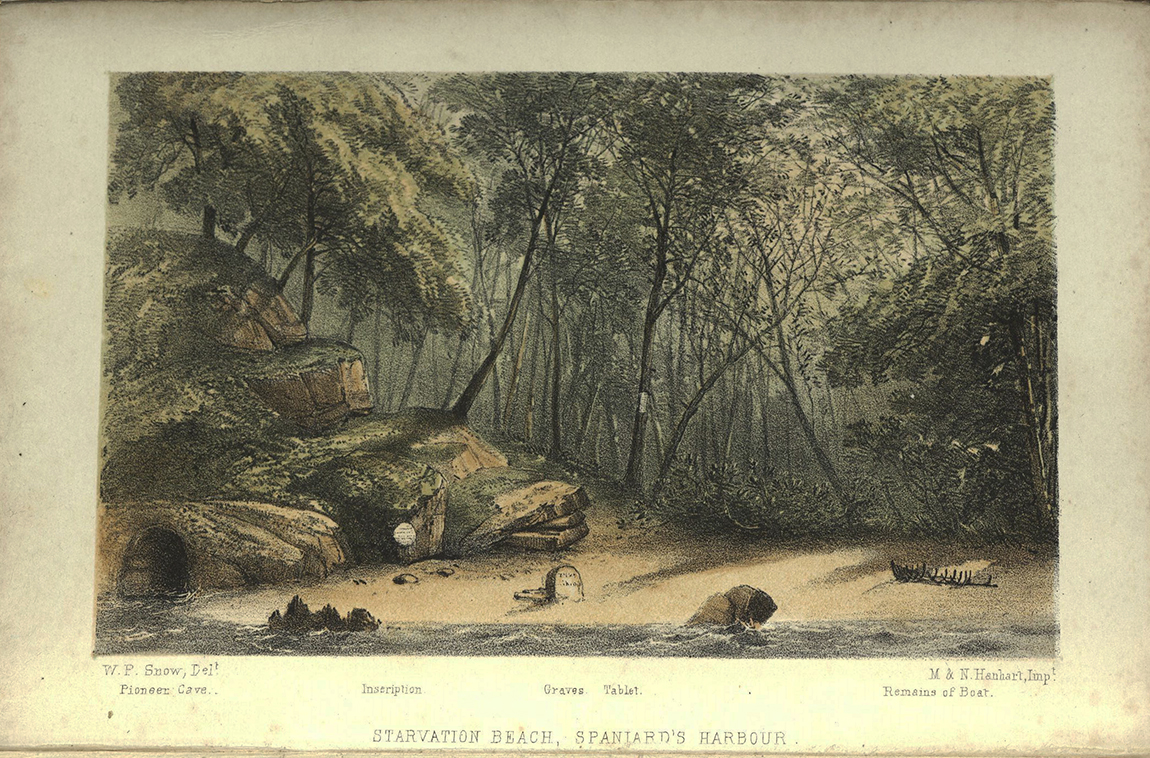
One must have experienced it one’s self to be able to conceive of the melancholy which takes possession of the soul of a man of sensibility, at the instant that he leaves his country and the civilized world, to go to inhabit with strangers in the wild and unknown lands.
ADVENTURES OF THE FIRST SETTLERS ON THE OREGON ...
Alexander Ross (1783-1856)
London: Smith, Elder and Co., 1849
First edition
F880 R81
John Jacob Astor, a New York business man, dispatched an overland expedition to establish a fur trading post on the Columbia River. A second group traveled by sea aboard the “Tonquin,” among them Alexander Ross, a clerk in Astor’s Pacific Fur Company. Adventures is his tell-all account of that disastrous expedition led by the foul Captain Thorn, and its struggles to establish a successful trading enterprise.
Ross details the dangerous voyage and documents the difficulties in clearing land and building a trading post. According to Ross, sixty-one “Astorians” died during this venture. The settlement, Fort Astoria, became the first European settlement on the Pacific Slope.
Ross arrived on the Columbia in March 1811 and helped build the first Fort Okanogan, where he was stationed for several years. From there he made trips south to the Yakima country, west to the summit of the Cascades, north to Thompson River and east to the Spokane country. He ascended the Willamette River, noting, “Between these high lands, lie what is called the Valley of the Wallamitte, the frequent haunts of innumerable herds of elk and deer…a very rich country,” and in 1818 helped Donald McKenzie build Fort Nez Perce at the mouth of the Walla Walla River. He took charge of that fort in 1823.
This journal begins in 1824 in Montana, when Ross was in charge of the Snake Country Expedition. The expedition ended in April 1825. He lived in the Red River settlements (today’s Manitoba) until his death in 1856. He and his Native American wife had thirteen children.
Ross’s journal is one of four contemporary documents about the early exploration of the Columbia River basin. Twenty years after his travels in the area, he published this book and then a second in 1855.
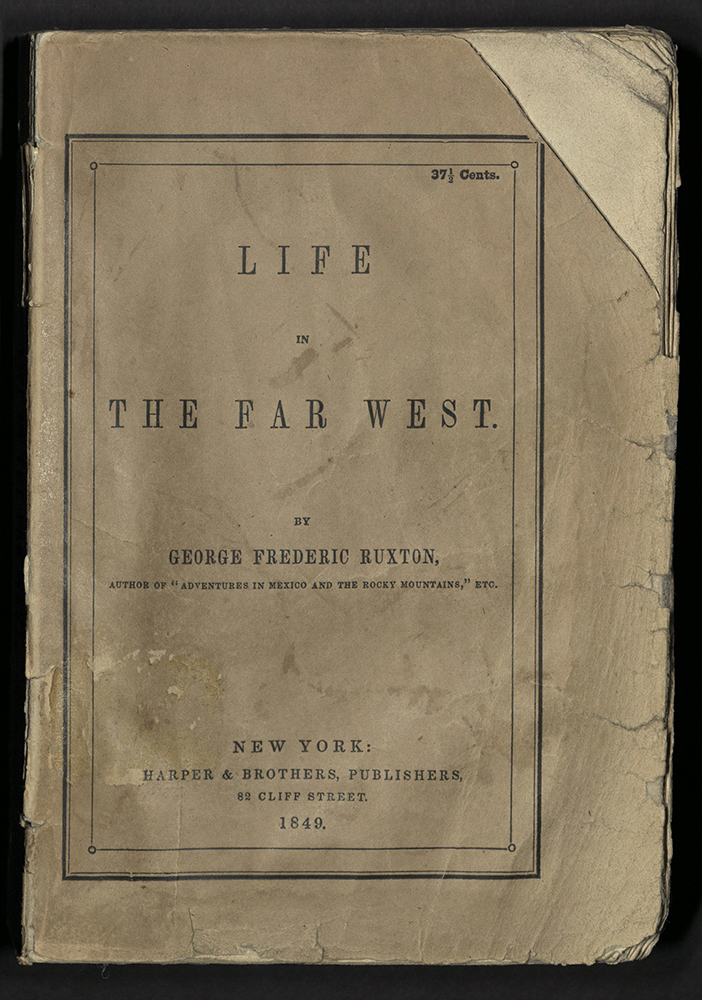
Apart from the feeling of loneliness which any one in my situation must naturally have experienced, surrounded by stupendous works of nature, which in all their solitary grandeur frowned upon me, and sinking into utter insignificance the miserable mortal who crept beneath their shadow; still there was something inexpressibly exhilarating in the sensation of positive freedom from all worldly care…my sporting feelings underwent a great change when I was necessitated to follow and kill game for the support of life, and as a means of subsistence; and the slaughter of deer and buffalo no longer became sport when the object was to fill the larder…
LIFE IN THE FAR WEST
George Frederick Ruxton (1820-1848)
New York: Harper & Bros, 1849
First American edition
F592 R97
Originally published in Blackwood’s Magazine in 1848, this is the adventure of British sportsman George Ruxton, who witnessed firsthand the relationship between the U.S. Army and the Comanche Indians and the lifestyle of the Colorado mountain men.
When the United States went to war with Mexico in May 1844, Ruxton secured an appointment as a British commercial attaché, in charge of protecting the lives and property of British citizens in Mexico. In this capacity, he almost certainly acted as a spy.
In July 1846, he travelled from Vera Cruz into New Mexico, where he encountered Lt. James Abert of the US Corps of Topographical Engineers. He continued to travel throughout the southwest, eventually arriving home in England in 1847, where he put together the notes from his journal for publication.
From his year-long adventure, Ruxton developed an intimate acquaintance with the trappers and traders of the American West.
Nothing can be more social and cheering than the welcome blaze of the camp fire on a cold winter’s night, and nothing more amusing or entertaining, if not instructive, than the rough conversation of the single-minded mountaineers, whose simple daily talk is all of exciting adventure, since their whole existence is spent in scenes of peril and privation; and consequently the narration of their every-day life is a tale of thrilling accidents and hair-breadth escapes, which, though simple matter of fact to them appear a startling romance to those who are not acquainted with the nature of the lives led by these men who with the sky for a roof and their rifles to supply them with food and clothing, call no man lord or master and are as free as the game they follow.
In this romantic parlance, Ruxton recounts the story of two of the most adventurous of these hardy pioneers, named Killbuck and La Bonte, whose daring and bravery in the midst of Indian and Spanish enemies were legend among their fellow-frontiersmen.
Along with companions Old Bill Williams, “Black” Harris, William Sublette, Joseph Walker and others Ruxton followed Killbuck and La Bonte across prairies and through forests, west from Bent’s Fort, into dangerous Arapaho country near the headwaters of the Platte. Ruxton wrote of the culinary delights of their campfires – buffalo “boudins” and beaver tails – and humorous tales of trading, all in mountaineer dialect, which was adopted by future storytellers. Alfred Jacob Miller, Ruxton’s fellow traveler, contributed watercolors and sketches depicting Ruxton’s dramatic scenes in detail.
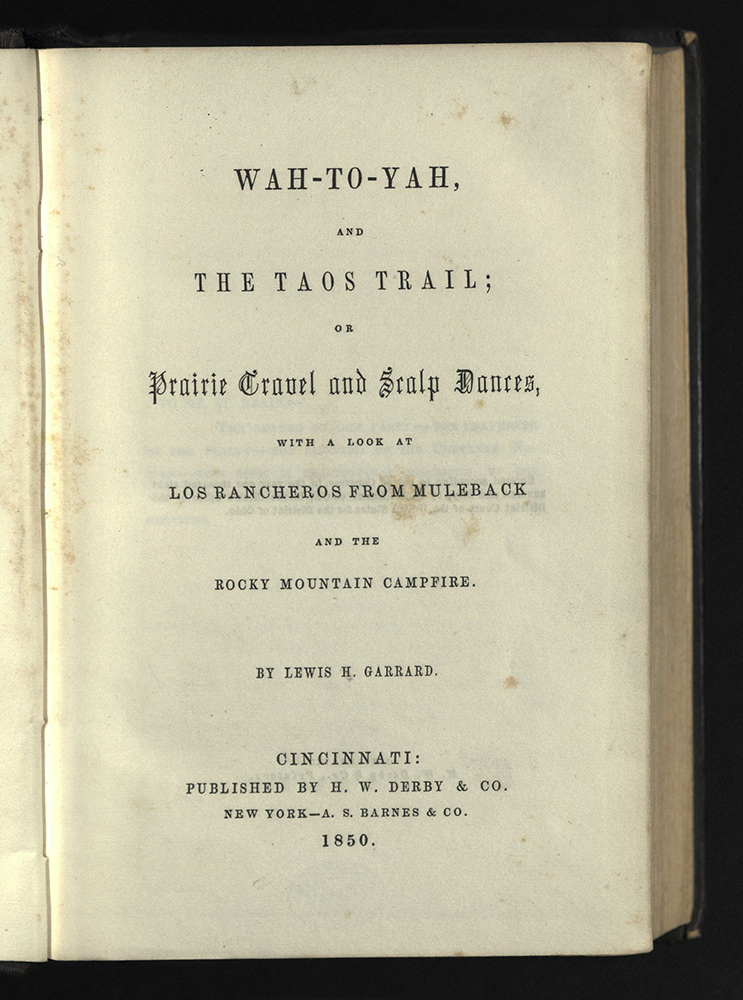
Justice! Out upon the word, when its distorted meaning is the warrant for murdering those who defend to the last their country and their homes.
WAH-TO-YAH AND THE TAOS TRAIL ...
Lewis H. Garrard (1829-1887)
New York: A.S. Barnes & Co., 1850
First edition
F786 G23
Lewis Hector Garrard, born in Cincinnati, Ohio, left Westport Landing, Missouri in 1846 with a wagon train headed for Santa Fe led by Colonel Ceran St. Vrain. He spent a year traveling the Rocky Mountains with his base in Taos, New Mexico.
His book about this trip takes its name from an Indian name for Colorado’s Spanish peaks. In his account of his journey he wrote of the Native Americans he encountered; the trader; and mountain men, their dress, behavior, and speech, and the environment in which they lived. During his travels, Garrard met well-known figures, including Jim Beckwourth, Kit Carson and George Ruxton. Garrard described the Taos Massacre and the subsequent trials of prisoners taken after the rebellion. New Mexicans, including Native Americans, resisted the new government established by General Stephen Kearny, at the direction of President Polk. Polk had suggested that Kearny incorporate as much of existing New Mexican governmental structure and staff as possible. Kearny didn’t do this. Instead, he appointed merchants from Taos and Santa Fe to run the territorial government. Only two native New Mexicans were given offices. Kearny ignored the ruling Santa Fe families.
New Mexicans bridled at the arrogance of the American soldiers stationed there and worried about the confiscation of their lands They rebelled in January 1847. Taos Indians killed the American governor, Charles Bent, and other American members of the government. Simultaneously, a rebellion that was supposed to happen in Santa Fe failed. Americans quickly defeated the rebels, tried the leaders for treason, and hanged them. Garrard attended the trial and was less than impressed with the outcome.
Garrard went on to receive a medical degree in 1853 from the University of Pennsylvania, but he never practiced medicine. He eventually settled in Minnesota, serving in that state’s legislature. On his ranch, he introduced Devon cattle and Southdown sheep. He is noted for being the first in Minnesota to cultivate Orchard Grass, considered a valuable forage plant for grazing and for hay.
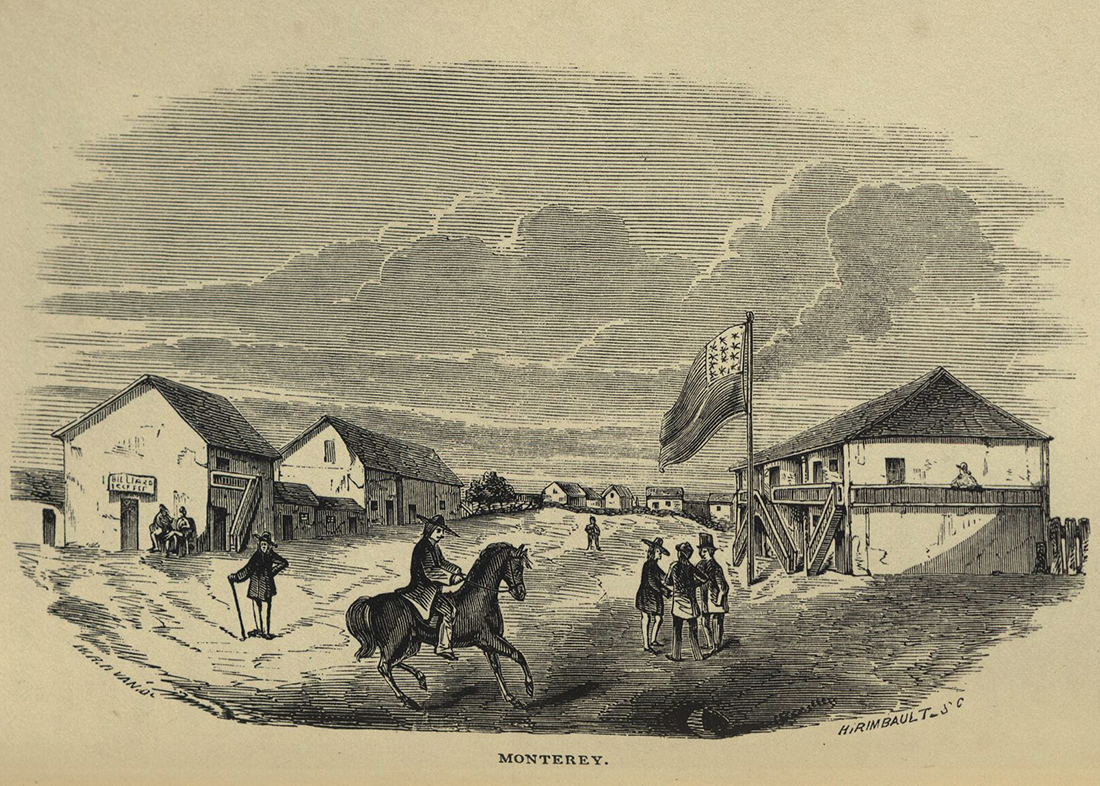
The projector of the building was the Reverend Waller Colton, the Alcalde, who raised the necessary funds partly by voluntary subscriptions from the townspeople, and partly by fines inflicted upon offenders against the law, and further promoted the philanthropic object by employing in its erection the culprits whom he condemned to the penalty of hard labour for terms varying in duration.
PERSONAL ADVENTURES ...
William Redmond Ryan (1791-1855)
London: William Shoberl, 1850
First edition
F865 R96
Artist and English wayfarer William Ryan had a great adventure in the wilds of California. He enlisted in the First Regiment of New York Volunteers, with a promise of land. He sailed for California on the USS Isabella which rounded the Horn in 1847, arriving in California in February, 1848.
His book describes that voyage and military life during the Mexican War in Monterey, La Paz, and San Jose. His regiment saw no action and was discharged after their enlistments were up.
Ryan went off to the Stanislaus River diggings, where he prospected for nearly eighteen months, but never struck gold. He worked as a trader, dealing in pistols and rifles, traveling through Stockton Sacramento, and San Francisco. In 1849 he went to Mexico.
He wrote in an easy style reflecting his bohemian fancy and evoking a world of prospectors, Indians, Spaniards, boom towns, breathtaking landscapes and a unique crop of men staking their all on illusive metal.
Illustrated with wood engravings and duotone lithographs.
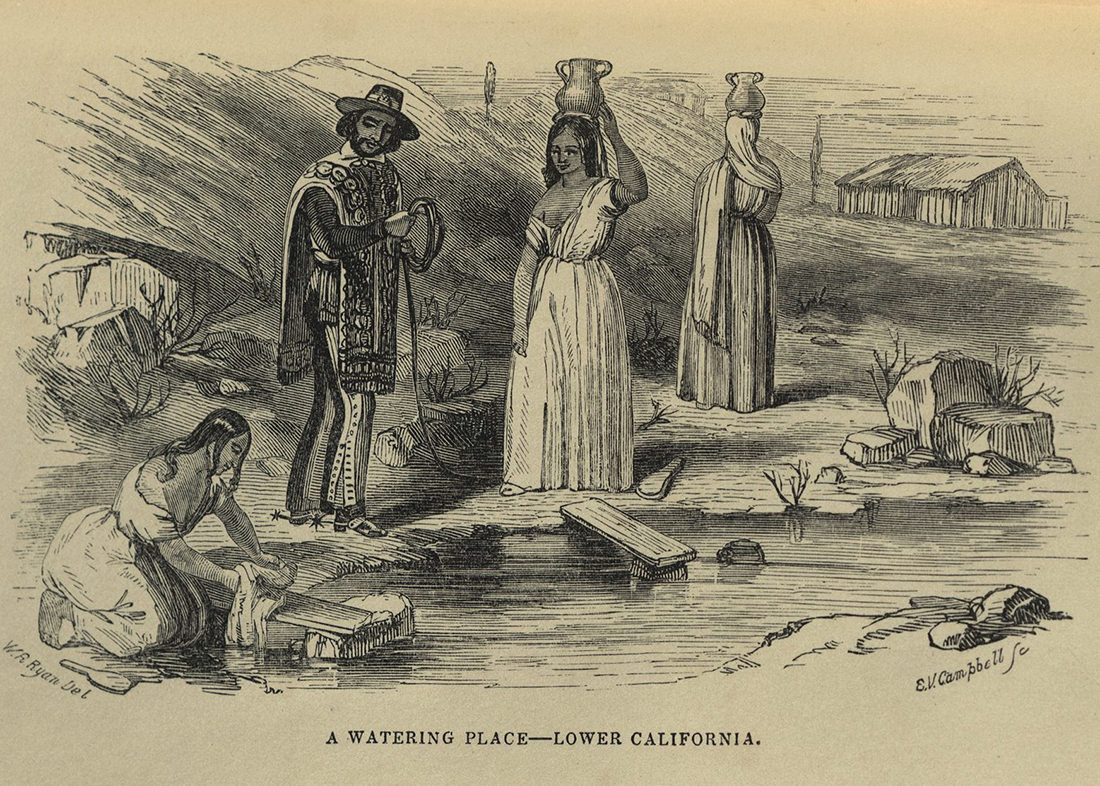
Round his waist he wears a red or blue sash, which serves the purpose of braces; the freedom of his movements being inconsistent with that inconvenient auxiliary of European costume.
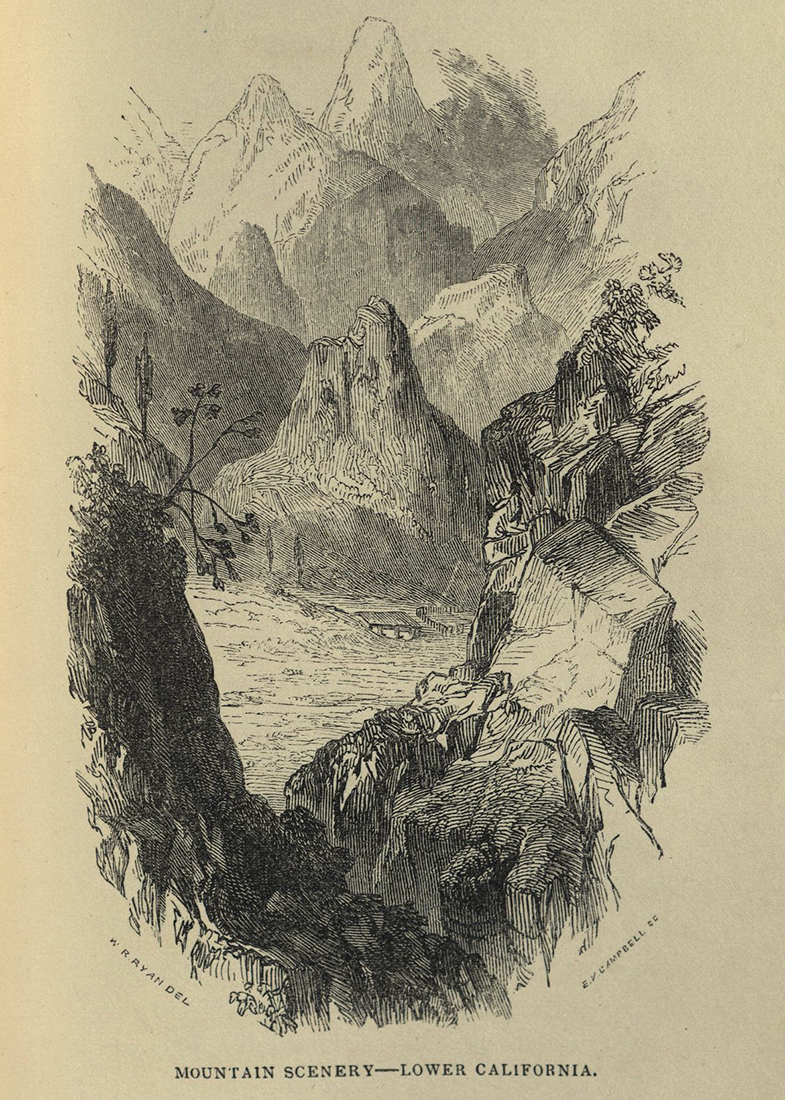
From the fissures of the rocks there flowed, with a gentle ripple, a thin, limpid stream, which, falling into a hollow at the end of this little valley, there formed a small pond where the cattle could slake their thirst.
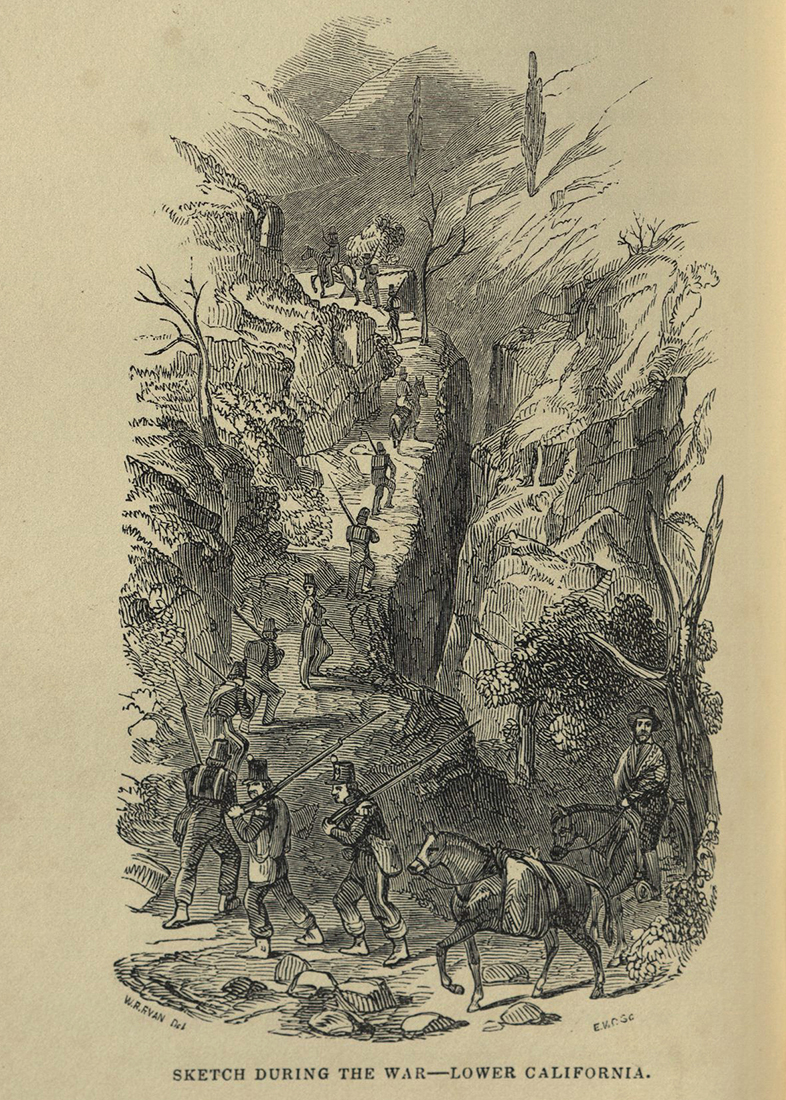
We continued our road across the mountains, winding round them, in and out, and along narrow shelves of rocks, from which a single false step would have precipitated him who made it into the deep valley far beneath; never resting but for a few minutes at a time, except at intervals or relays, averaging about twenty-five miles each…
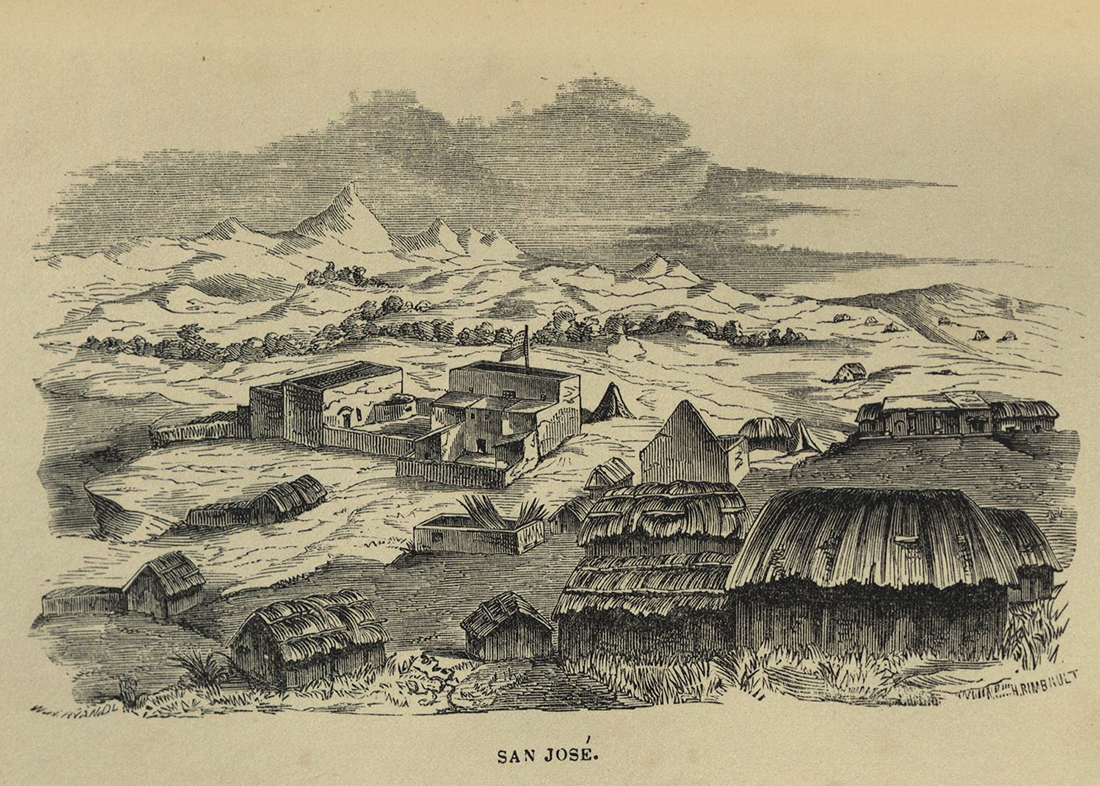
These defences, imperfect as they were, had proved of immense advantage to the Americans during the recent siege, who had kept up, from behind them, a very destructive fire upon the enemy.
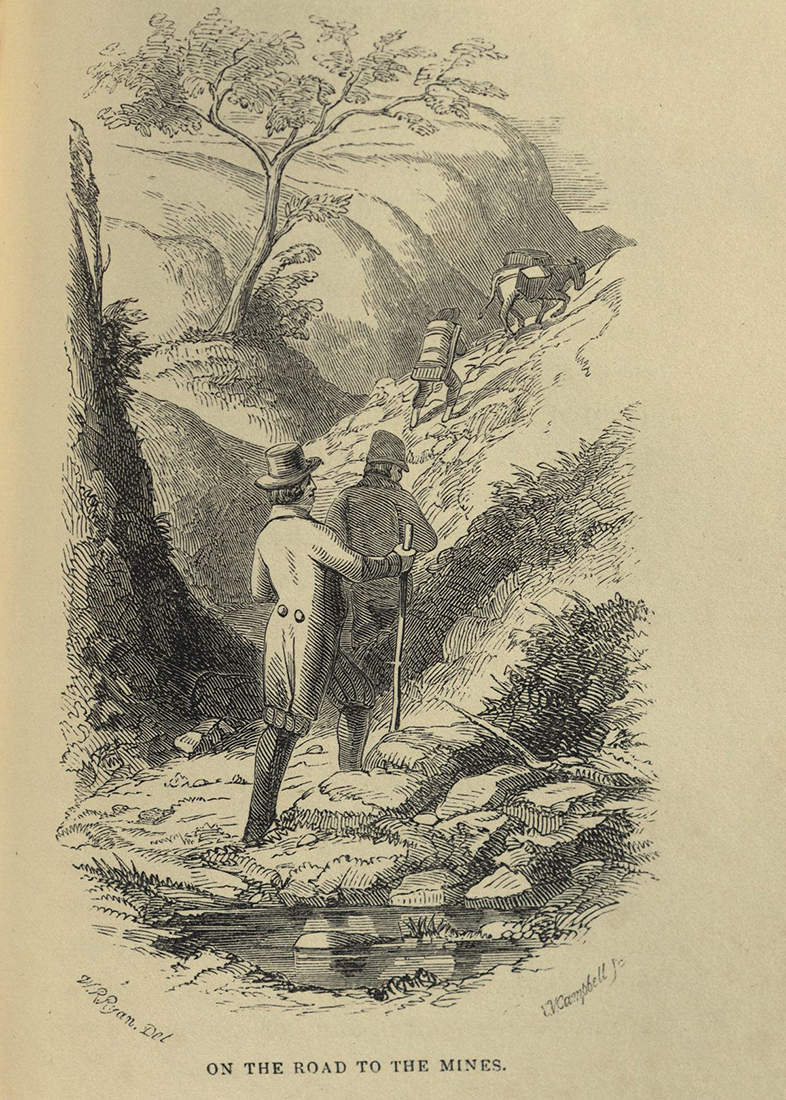
Wearily, too, did we mount the rugged slopes of those mountains, under a broiling sun, to which we were fully exposed, panting for water, and anxiously seeking for it, and for a few trees under which we might procure an hour’s shelter and rest.
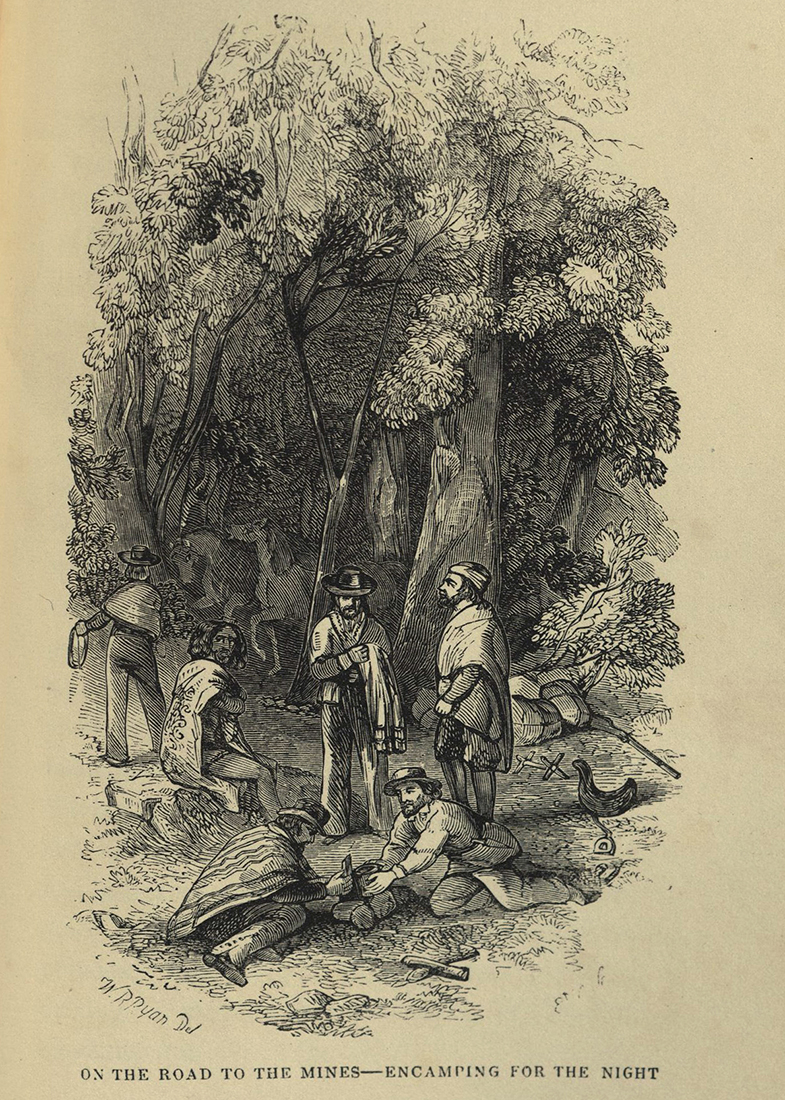
On arriving at a sort of hollow, filled with water, which lay opposite a narrow and fertile valley, shut in by a couple of hills, we dismounted, and prepared to encamp, there being plenty of grass for our horses, who could roam about without being picketed.

At our feet and on each side lay the waters of the Great Salt Lake, which we had so long and so ardently desired to see. They were clear and calm, and stretched far to the south and west... The dreamy haze hovering over this still and solitary sea threw its dim, uncertain veil over the more distant features of the landscape, preventing the eye from discerning any one object with distinctness, while it half revealed the whole, leaving ample scope for the imagination of the beholder.
EXPLORATION AND SURVEY OF THE VALLEY OF THE GREAT SALT LAKE ...
Howard Stansbury (1806-1863)
Philadelphia: Lippincott, Grambo & Co, 1852
First edition
F826 U558 1852
Captain Howard Stansbury was commander of a detachment of the U.S. Army’s Topographical Engineers. He explored the Great Basin in 1849-50 for the federal government in order to survey the best route through the Rocky Mountains for a railroad to the Pacific Coast. His surveying party trekked for two years in the Rocky Mountains, exploring and mapping around the Great Salt Lake, Utah Lake, the Jordan River, north to Ft. Hall in southern Idaho and east to Fort Laramie.
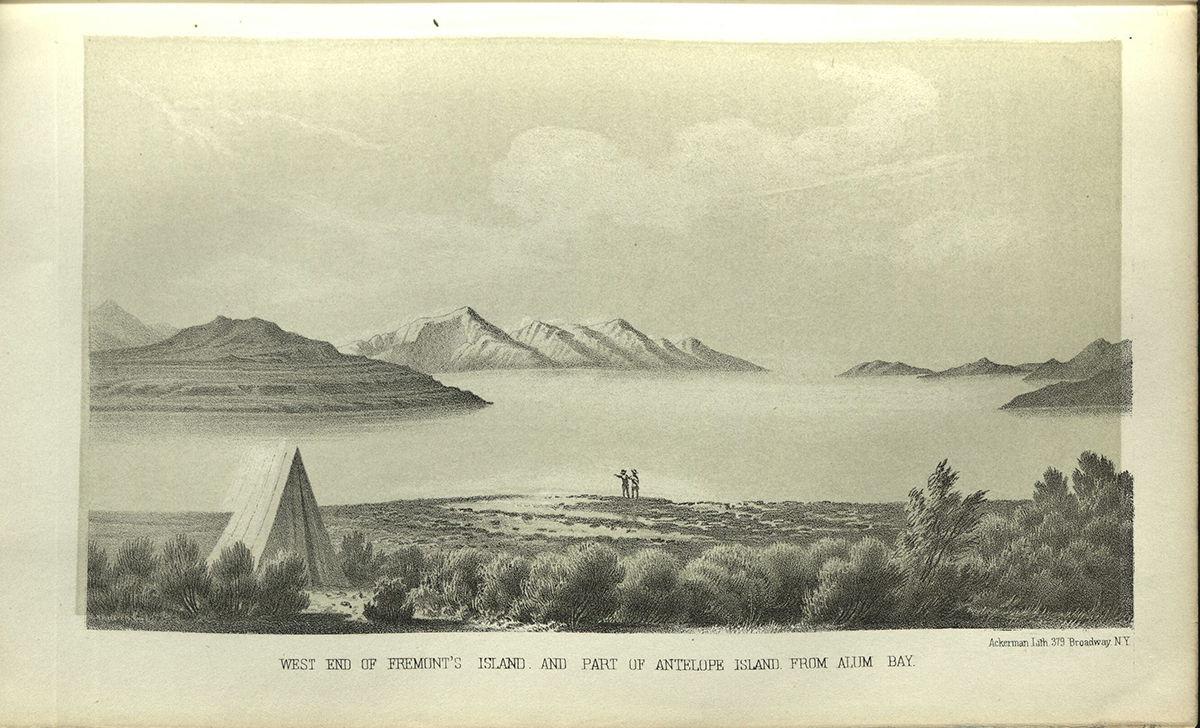
In spite of his initial rapturous description of the Great Salt Lake, he also wrote, “The bleak and naked shores, without a single tree to relieve the eye, presented a scene so different from what I pictured in my imagination of the beauties of this far-famed spot, that my disappointment was extreme.” Stansbury was the first white man to determine that the lake was the remnant of a much larger ancient fresh-water lake.
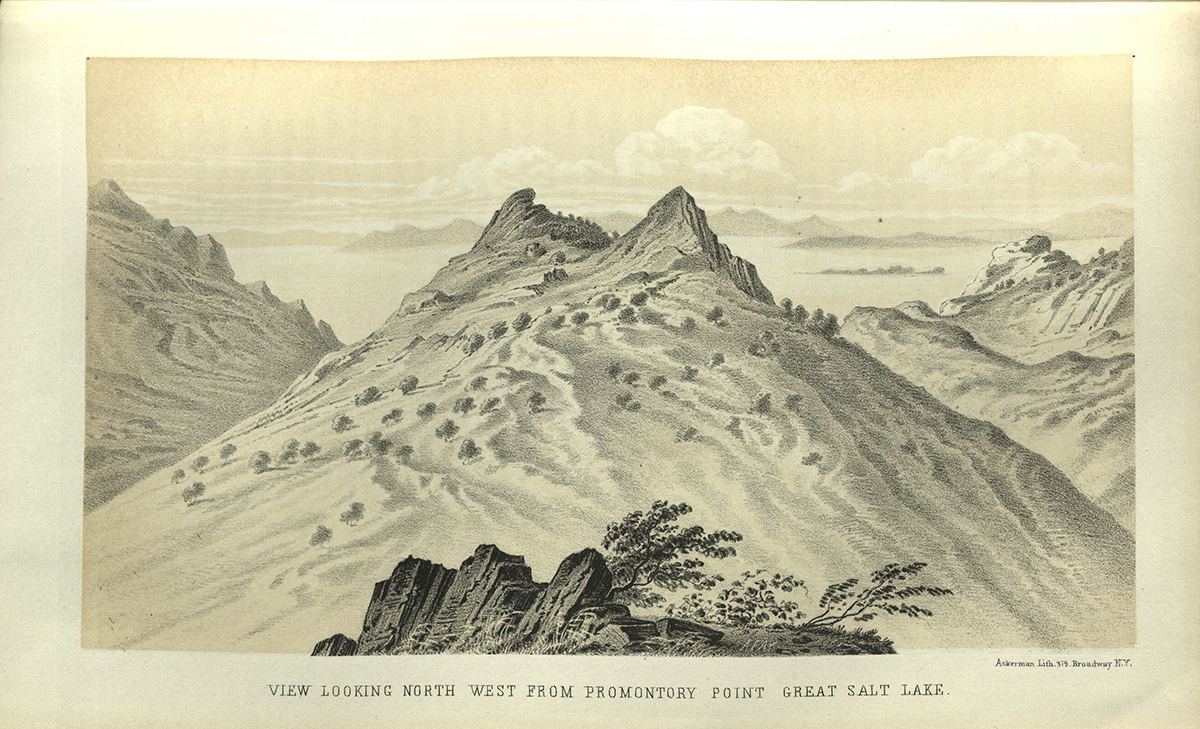
The highest of these is no about two hundred feet above the valley, which has itself been left by the lake, owing probably to gradual elevation occasioned by subterraneous causes. If this supposition be correct, and all appearance conspire to support it, there must have been here at some former period a vast inland sea, extending for hundreds of miles; and the isolated mountains which now tower from the flats, forming its western and south-western shores, were doubtless huge island, similar to those which now rise from the diminished waters of the lake.
Stansbury’s prose was powerful, a style that captivated his readers. He wrote, for example, “After following some miles down the ravine upon which we had encamped, we struck upon an Indian lodge-trail, leading either to Cache Valley or to Ogden’s Hole. This we followed in nearly a southerly direction, crossing many deep hollows and very steep ridges, up which we had to scramble, leading our mules, (it being impossible to ride,) until we struck upon the head of a broad, green, beautiful valley, with an even, gentle descent, which led us, in about three miles, down to Ogden’s Creek…previous to entering Ogden’s Hole. There we encamped for the remainder of the day, with abundance of excellent grass, wood, and water.” Here is adventure, challenge, beauty, and plentitude.
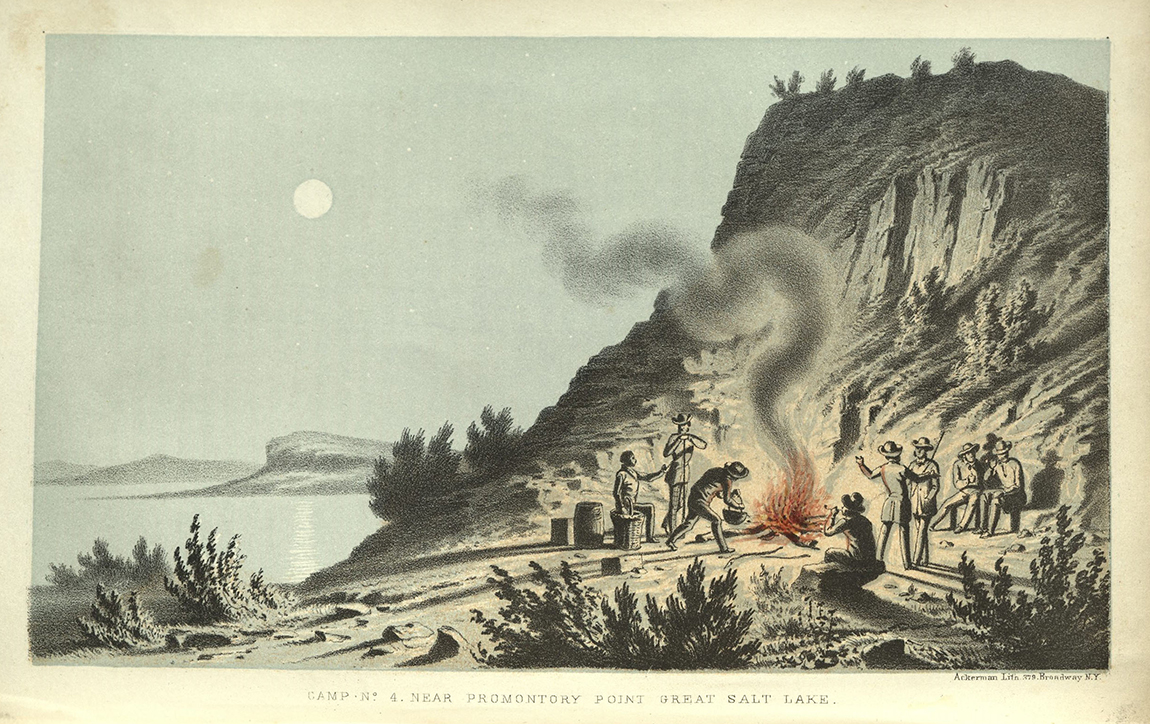
This report, with its accurate descriptions of the Great Salt Lake Basin, was of particular interest to the public because of its depictions of the newly established Mormon settlements. When Stansbury’s party arrived in the Great Salt Lake valley, Brigham Young met them with caution, suspicious that they had been sent to break up the Mormon settlement. Stansbury assured the Mormon leader that this was not his intent. Of the Mormons, Stansbury wrote, “In what has been said respecting the Mormon community, I have endeavored frankly to present the impressions produced upon my mind by a somewhat intimate acquaintance of a year’s duration with both rules and people.” He continued, “…the tie that binds a Mormon to his second, third, or fourth wife, is just as strong, sacred, and indissoluble, as that which unites him to the first” and further, “…it must be remembered that these people are exasperated and rendered almost desperate by the wrongs and persecutions they had previously suffered in Illinois and Missouri; that they had left the confines of civilization and fled to these distant wilds, that they might enjoy undisturbed the religious liberty which had been practically denied them; and that now they supposed themselves to be followed up by the General Government with the view of driving them out from even this solitary spot, where they had hoped they should at length be permitted to set up their habitation in peace.”
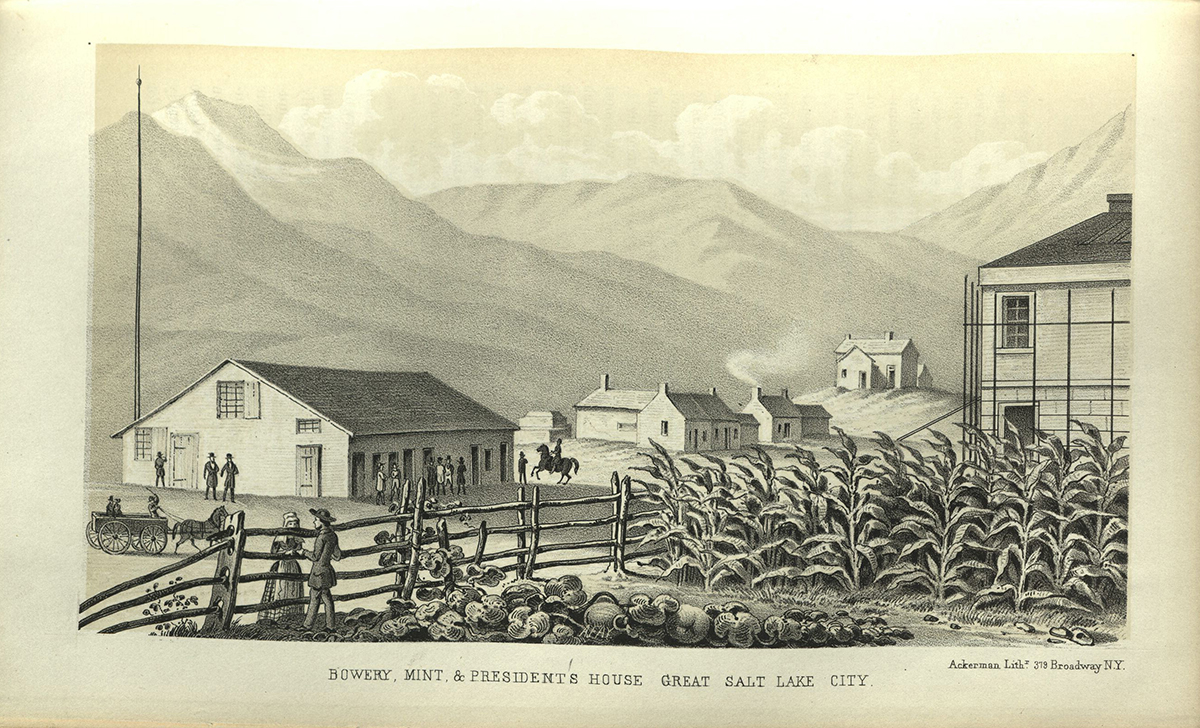
The first extensive survey of the Great Basin, Stansbury’s report was a landmark in the cartography of the American West. The accompanying maps established the topography and place names of northern Utah, and the routes and passes through the Rockies for emigrants and, possibly, a railroad. Appendices include information on quadrupeds, birds, insects, plants, geology and paleontology.
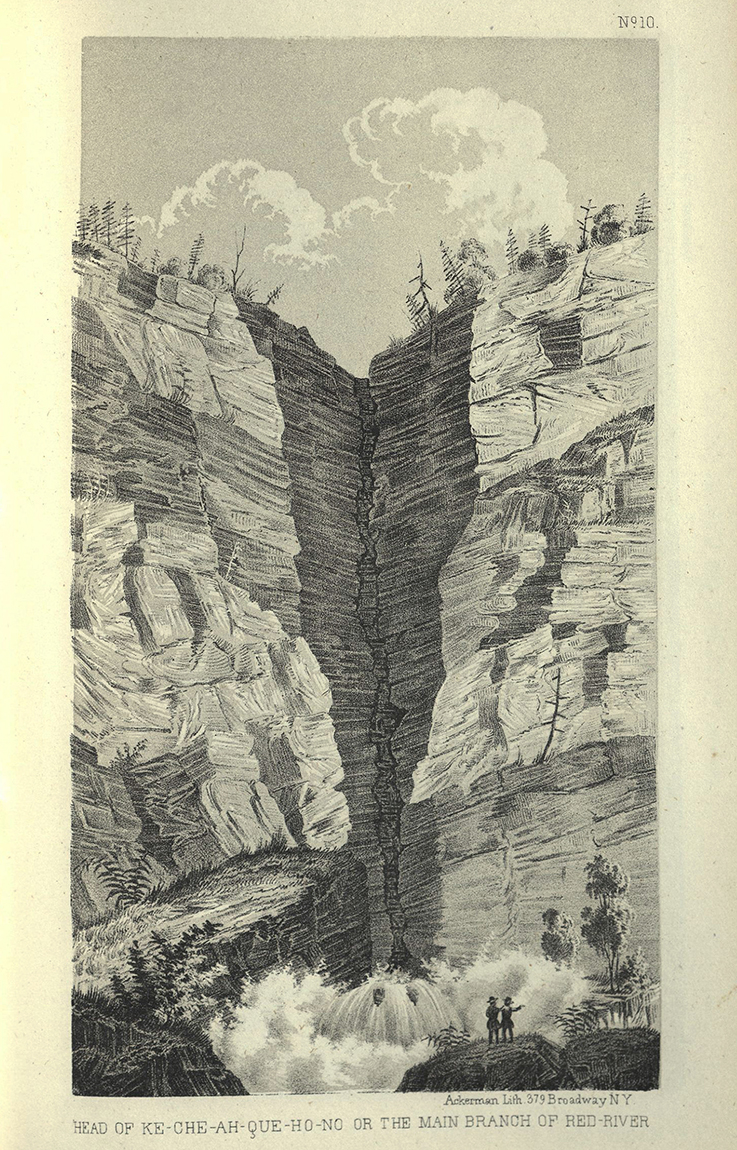
This forms a boundary-line, dividing the country suited to agriculture from the great prairies, which, for the most part, are arid and destitute of timber. It seems to have been designed as a natural barrier between civilized man and the savage, as upon the east side, there are numerous spring-brooks, flowing over a highly prolific soil, with a superabundance of the best timbers, and an exuberant vegetation, teeming with the delightful perfume of flowers of the most brilliant hues;… while on the other side commence those barren and desolate wastes, where but few streams greet the eye of the traveller, and these are soon swallowed up by the thirsty sands over which they flow…
EXPLORATION OF THE RED RIVER OF LOUISANA ...
Randolph B. Marcy (1812-1887)
Washington: R. Armstrong, Public Printer, 1853
First edition, Senate Issue
F377 R3 M3 1853
Randoph B. Marcy went to Texas in 1845 with Zachary Taylor, fighting at Palo Alto and Resaca de la Palma. Between May 2 and July 28, 1852 Marcy, Captain of the United States Army Fifth Infantry, and his second in command, Capt. George B. McClellan, led a seventy-man expedition over nearly a thousand miles of present-day Oklahoma and Texas, mostly along the branches of the Red River in search of the source of that river. At the time, all known maps of the river were inaccurate.
The annexation of Texas made the establishment of a verified northern border with “Indian territory” necessary. Along the way Marcy collected geological and botanical specimens and studied evidence of early inhabitants. The expedition encountered the little-known Wichita Indians. Marcy compiled the first Wichita dictionary. As a representative of the United States government, he ordered all of the tribes he encountered to cease raids into Texas, telling them that it would now be protected by the Great White Father in Washington.
Marcy found gold samples, a new type of copper, coal, and gypsum. He identified twenty-five species of animals and ten species of snakes. He was the first Anglo-American to explore the Palo Duro Canyon and Tule Canyon. He returned with information on Cynthia Ann Parker, a white woman who had been captured by Comanche warriors in 1836. She refused to return with the party.
Marcy was successful in locating the headwaters of the Red River, which Zebulon Pike and others before him had failed to find. Upon Marcy’s return, he received a hero’s welcome, his party having been falsely reported to have been wiped out by Comanches.
His report was illustrated with lithographs, twelve of which are views of places he visited and the remainder of some of the specimens he gathered.
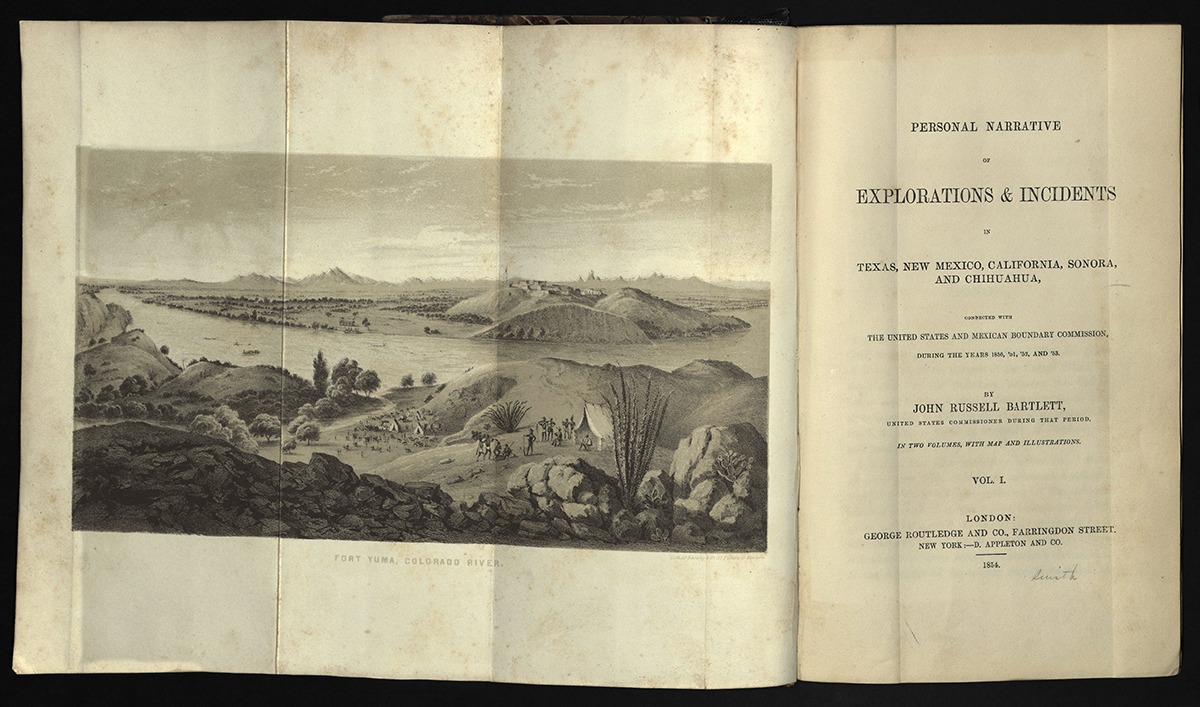
PERSONAL NARRATIVE OF EXPLORATIONS ...
John Russell Bartlett (1805-1886)
New York, London: D. Appleton & Company, 1854
First edition
F786 B283 1854
John Russell Bartlett was a Rhode Island bookseller and artist with political connections, which landed him a boundary commission job. He was assigned to collaborate with Mexico in surveying the border. Bartlett familiarized himself to the task by reading accounts of the landscape, flora and fauna of the Southwest, newly acquired by the United States.
Bartlett left New York with a small group of men in August 1850, taking a sea passage to Texas and then traveling overland. The party spent nearly three years trying to determine the border between the United States and Mexico, left ambiguous at best by the Treaty of Guadalupe Hidalgo after the Mexican War. Bartlett’s adventure soon bogged down, mostly due to factions between Southern Americans and Northern Americans. The group began quarreling almost immediately, amongst themselves and with the Mexicans, resulting in the murder of a Mexican by an American.
Hopes for finding a route for a railroad to the Pacific influenced the Mexican border survey. Southern Americans were determined to mark a territorial line far enough south to provide a level route, which would benefit southern states. Bartlett and his willingness to compromise with the Mexicans made him unpopular with the Southern contingent of his party. Bartlett’s relations with his Mexican counterparts were more agreeable than his relations with fellow Americans.
Eventually, hearing of the turmoil, Congress suspended funding for Bartlett. His struggle was symptomatic of a larger struggle provoked by the Mexican acquisition: the precarious contention of slavery and its extension into newly acquired territory.
Bartlett fell ill and spent months recuperating in Mexico. In spite of all the setbacks, the trip yielded maps of much of the present border. His book on the group’s travels provided an intense, detailed view of his surroundings and adventures. An excellent introduction to the Southwest for eastern readers, it exposed an exotic west, worthy of an expanding nation.
Bartlett modeled his travelogue after Incidents of Travel in Central America, Chiapas and Yucatan, written by his friend John Lloyd Stephens in 1841. His account covered his extensive exploration through northern Mexico, California, and the southwestern United States.
At the end of Vol. II are “Remarks on the introduction of Camels as a means of transportation on the prairies and deserts of the interior.” Bartlett strongly suggested that the camel would be well-suited to the American Southwest. He wrote, “There are peculiarities in the arid plains and deserts of North American which seem to fit them for the habits of the camel…it is a well-known fact, that however barren our deserts, they abound in mezquit bushes or chapporal, which shrub bears a most nutricious bean…Other peculiarities are the salines and salt lakes, which abound on the aird plains throughout the table-lands, as well as on the slopes towards both oceans…To camels brackish water is as acceptable as if from the purest fountains.”
The book is illustrated throughout with forty-five plates, sixteen of which are toned lithographs and twenty-nine of which are engraved. The drawings by Henry Hillyard, Seth Eastman and Henry Cheever Pratt are some of the best of the period, depicting scenes along the border and the route of the author’s journey, including Sonora, Chihuahua, Acapulco, Manzanillo, New Mexico, Saltillo, California and Texas. The drawings include early views of Tucson, San Diego, and Monterey; members of the expedition at work; and the people of the region.
The lithographs for this publication were produced by Sarony & Company, one of the premier lithographic firms of the nineteenth century. The book is accompanied by a folded map depicting the area south of the Oregon border in which Bartlett failed to adequately mark the Mexican boundary.
Rare Books copy gift of Ronald Rubin.
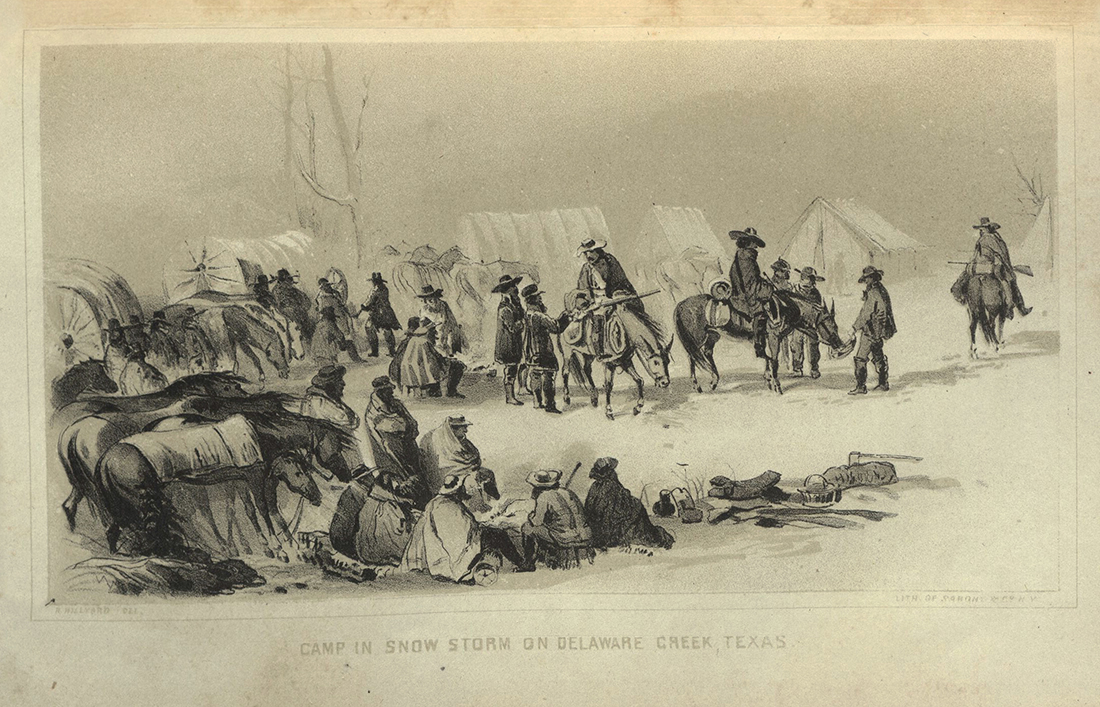
The sharp wind found its way through the openings in the carriage, which all the blankets I could pile on would not keep out. The young gentlemen crowded themselves in their tents, and lay as close as possible; while the teamsters, laborers, etc., stowed themselves in the wagons...
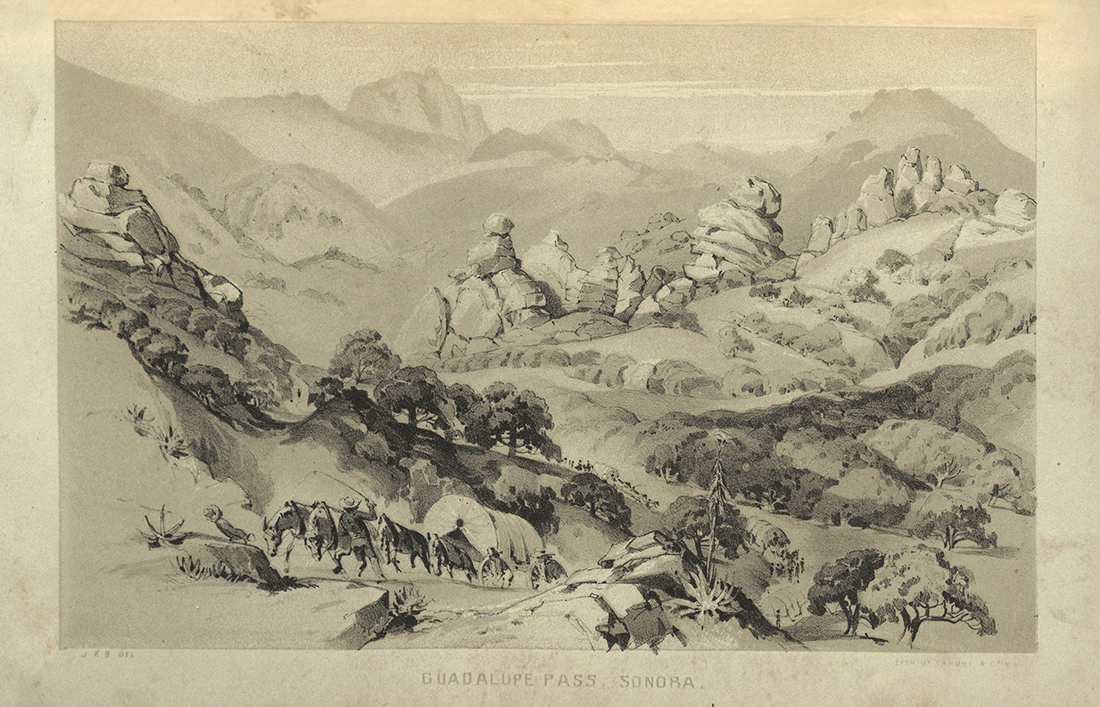
The getting up these hills proved a very difficult task, and it was only by every one putting a shoulder to the wheels and chocking them at every five or six feet, that they could be surmounted.
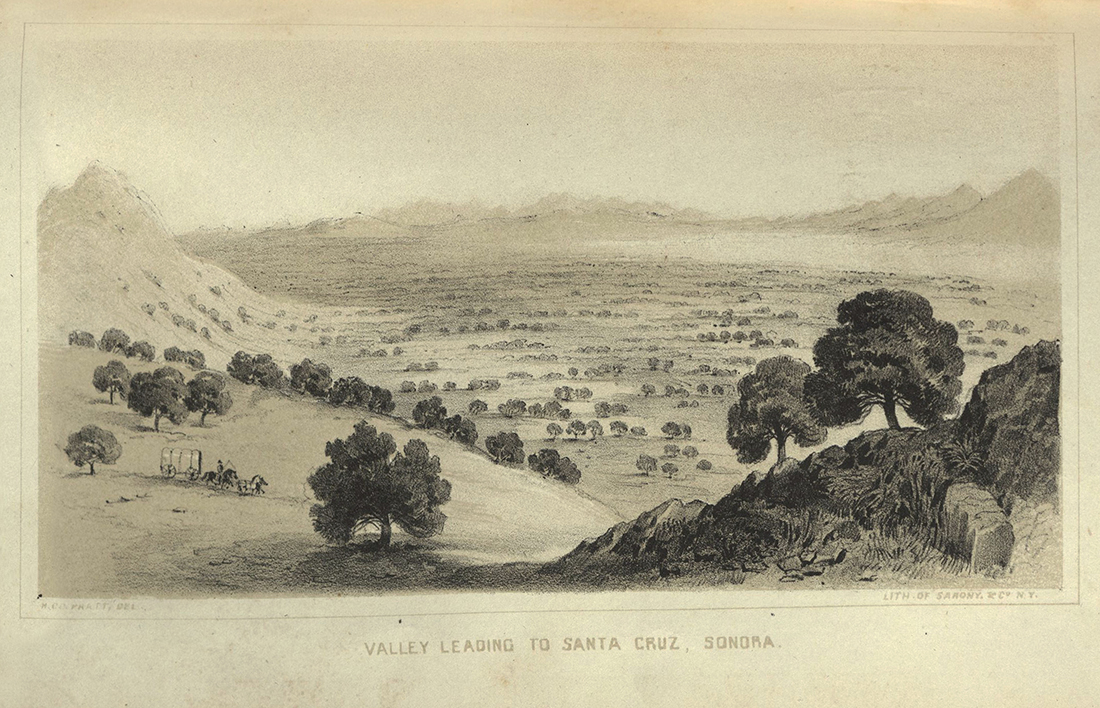
Opposite from where we stood, and not more than five miles distant, were the mountain and gorge, where we had been encamped for five days, endeavoring to find a passage through. At the further end of the valley into which we were descending, lay Santa Cruz.
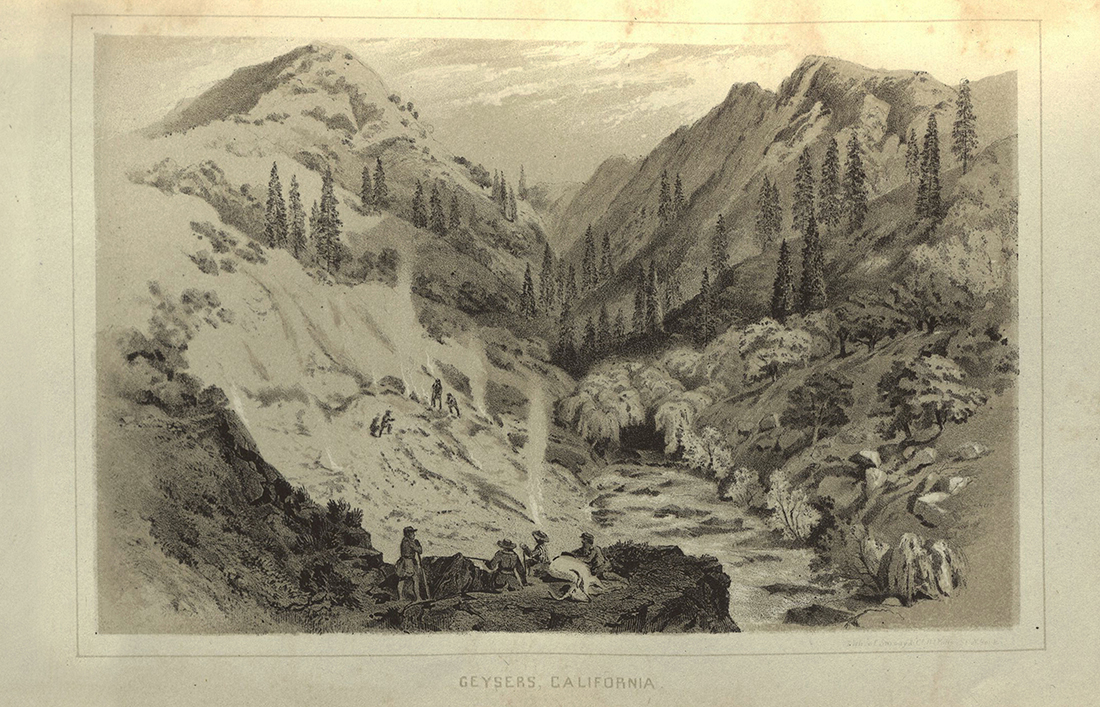
Here was truly a grand prospect, and difficult to describe by one unacquainted with such scene; for to speak with scientific precision of such a remarkable spot as this…In the chasm below us, columns of steam were spouting out on every side; while deep at the bottom, ran a small rivulet.
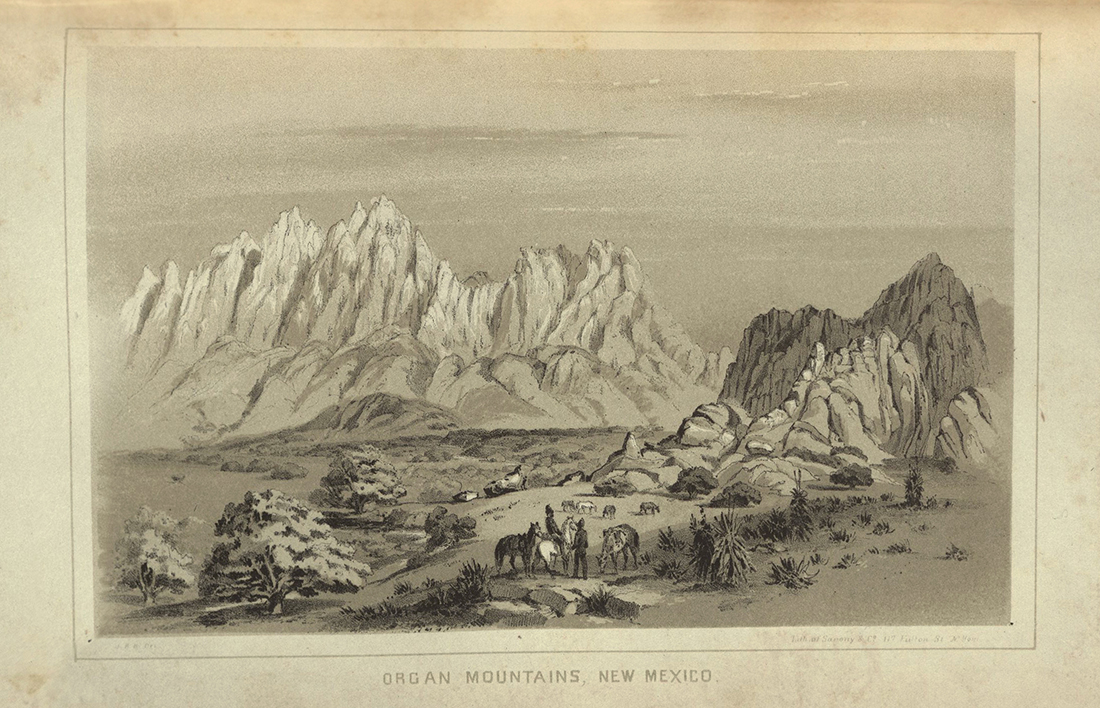
In this ramble I passed a beautiful little stream, which rising far within the defile, wound its way along through many intricacies, where it had worn for itself a deep bed, until it tumbled over the rocks in a single fall of some fifty feet. Although the quantity of the water was small, the fall was exceedingly picturesque.
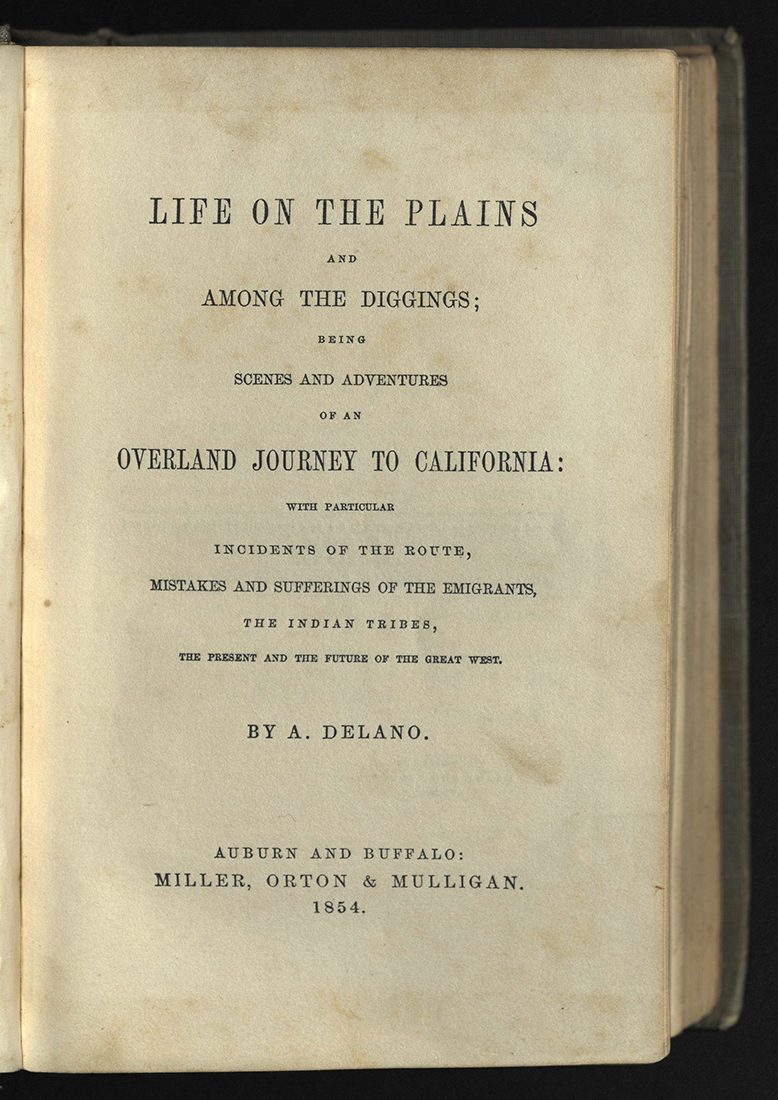
There was a great crowd of adventurers…Nearly every berth was full, and not every settee and table occupied at night, but the cabin floor was covered by the sleeping emigrants. The decks were covered with wagons, mules, oxen, and mining implements and the hold was filled with supplies…this was the condition of every boat – for since the invasion of Rome by the Goths, such a deluge of mortals had not been witnessed, as was now pouring from the States to the various points of departure for the golden shores of California. Visions of sudden and immense wealth were dancing in the imagination of these anxious seekers of fortunes, and I must confess that I was not entirely free from such dreams…Our first day out was spent in these pleasing reflections, and the song and the jest went round with glee – while the toil, the dangers and the hardships, yet to come, were not thought of, for they were not yet understood.
LIFE ON THE PLAINS AND AMONG THE DIGGINGS ...
Alonzo Delano (1806-1874)
Auburn, NY: Milner, Orton & Mulligan, 1854
First edition, first state
F593 D33 1854
A native of Auburn, New York, Alonzo Delano lived in Ottawa, Illinois with his wife and two children when gold was discovered in California. At the age of forty-three, he sold his stocks and commodities and left Ottawa on April 5th, 1849 with a company of fifty men. The company traveled about fifteen to twenty miles per day.
Delano kept a diary, chronicling illness, hunger, thirst and death as frequent experiences of the group. Five months after the group began traveling, it entered California via the Lassen Trail.
From there, Delano headed up the Feather River. His story of his travels, writing of emigrants, miners, and Native Americans, became an instant classic. He settled in Grass Valley, where he invested in a quartz mine and returned to banking and selling merchandise.
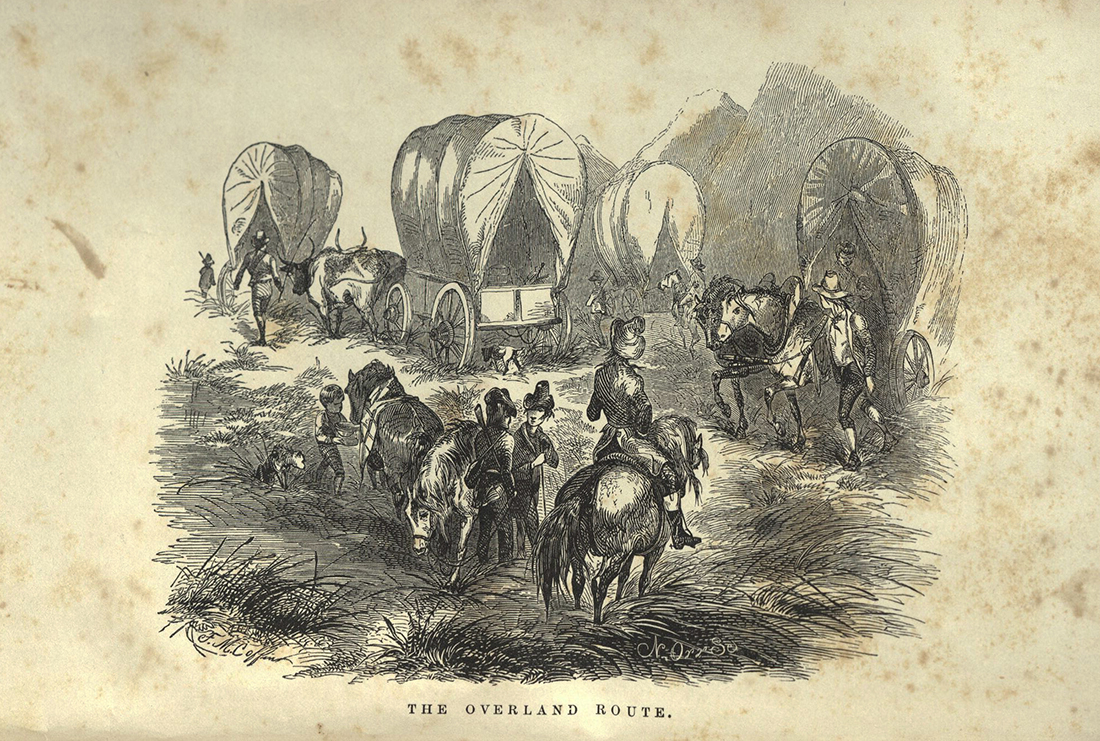
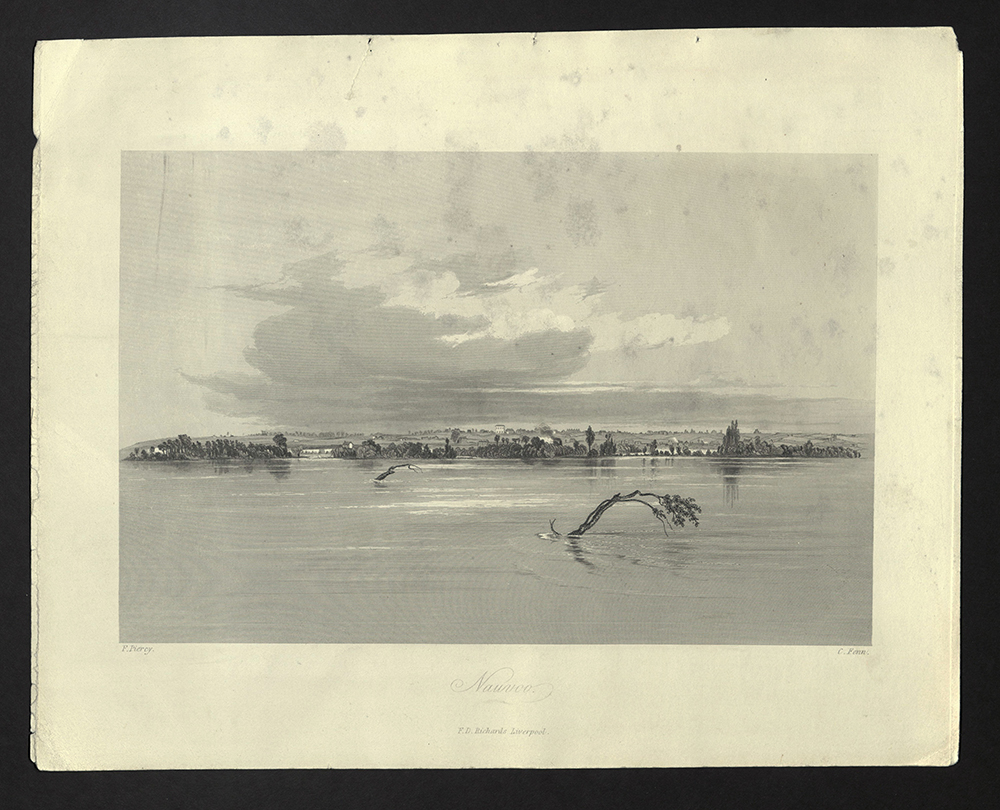
At length matters reached the culminating point, in the assassination of Joseph and Hyrum Smith at Carthage, on the 27th of June, 1844, by which Nauvoo was deprived of two of its great master spirits, under whose wise policy and judicious watch-care it had risen from the wilderness…
ROUTE FROM LIVERPOOL TO GREAT SALT LAKE VALLEY ...
Frederick Hawkins Piercy (1830-1891)
Liverpool: F. D. Richards; London: Latter-Day Saints’ Book Depot, 1854
First edition
E166 P65
Frederick Piercy was the eighth of nine children born in Portsea, Hampshire, England. He joined the Church of Jesus Christ of Latter-day Saints on March 23, 1848. A year later he married Angelina Hawkins, also a convert.
When Piercy was twenty and his wife was expecting their first child, he left for a short mission to Paris. In addition to proselytizing, he produced artwork, impressing John Taylor, the mission president in France. Piercy became known for portraiture and landscapes. He exhibited at the Royal Academy of Arts and at the Suffolk Street Gallery of the Society of British Artists in London prior to leaving for the Salt Lake Valley.
In 1853, then twenty-three years old, Piercy left England aboard the emigrant ship Jersey, which was headed for New Orleans. Piercy had been commissioned to work on an illustrated guide meant to encourage and assist British converts to the Mormon church immigrating to America. He and James Linforth, an editor for the Mormon newspaper, Millennial Star, published a collection of engravings and woodcuts made from Piercy’s drawings, paintings, and journals in Route from Liverpool to Great Salt Lake Valley. Ironically, the book as a guide was of limited use. But its illustrations were intensely evocative of a journey across the United States to Utah Territory and the landscape and life to be found there. In addition, Piercy’s written descriptions were lively and witty.
Instead of remaining in Utah like many others, Piercy returned to England shortly after his trip. By April 1857, after refusing to return to the Salt Lake Valley at the behest of both Brigham Young and Orson Pratt, Piercy and his wife left the Mormon faith.
Route from Liverpool was first published in fifteen monthly parts between July 1854 and September 1855.
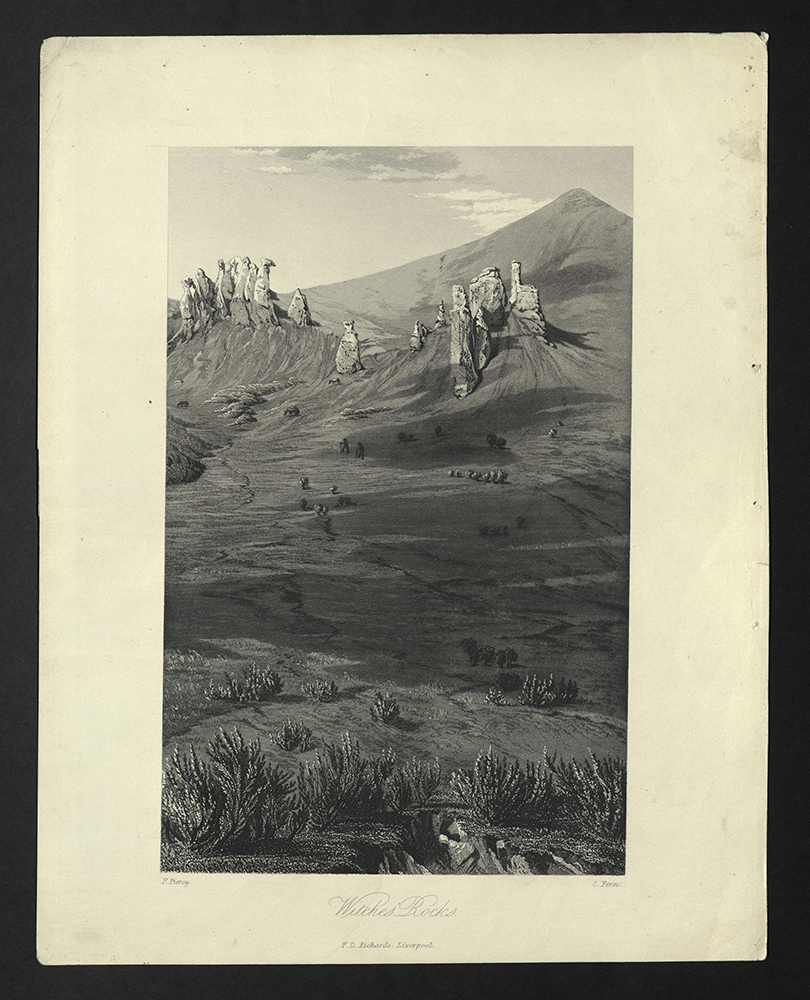
We passed many remarkable rocks to-day, but none I think so much so as Witches Bluffs, on the east bank of Weber river. They are more like gigantic and somewhat rude pieces of statuary in the form of women than any thing else.
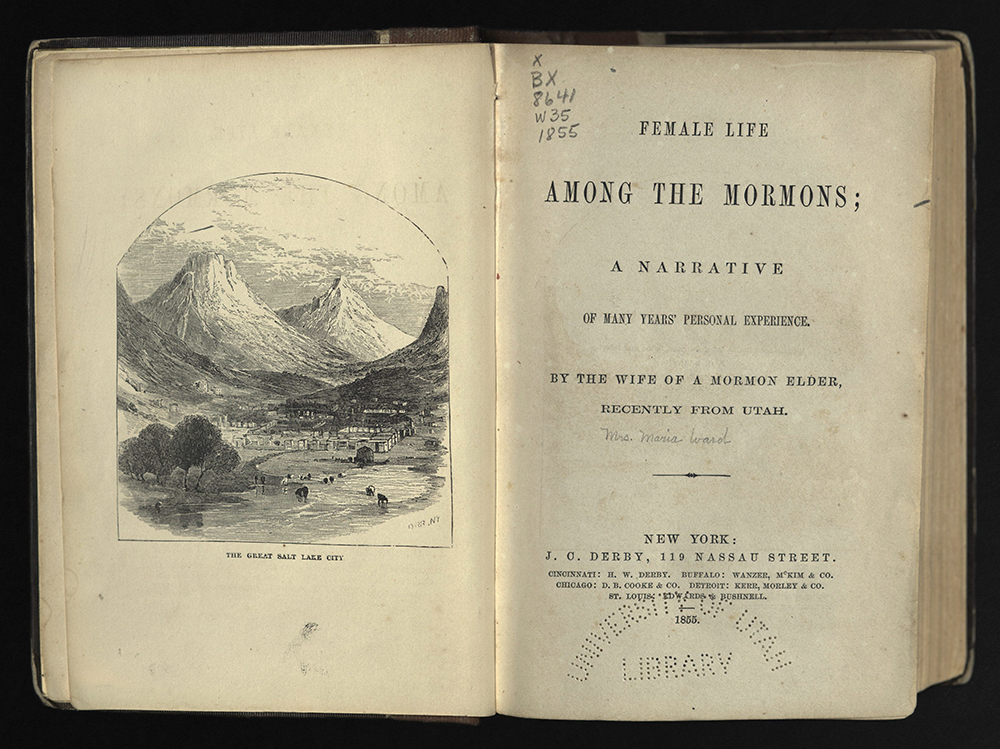
We were alone in the desert – men, women and children. Many of us inspired by the most resolute fanaticism; others, imbued with sentiments of religious veneration for their leader; and all pledged to support a cause that, whether good or bad, whether comfortable to their feelings or not, could not fail to redound to the glory of the Mormon hierarchy, and promote the interests and views of the church.
FEMALE LIFE AMONG THE MORMONS ...
Maria Ward
New York: J. C. Derby, 1855
First edition
BX8641 W35
These memoirs tell the story of a woman from New York who married a Mormon when polygamy was openly practiced by members of the Church of Jesus Christ of Latter-day Saint. The couple traveled from New York to Illinois and eventually settled in Utah Territory with the church’s leader Brigham Young. The author described the Mormon culture as one of immorality, featuring polygamy, sexual depravity and indoctrination. The author did not, herself, live in a polygamous household.
In terms reminiscent of the abolitionist literature of the time, Ward described harsh treatment of other women: “One poor woman who told an immigrant in the hearing of a Mormon elder that polygamy was a system of abominations was stripped nude, tied to a tree and scourged till the blood ran from her wounds to the ground.”
A contemporary review of this book in the New York Times called it “the worst fiction of the season,” questioning the authorship of the work: “An anonymous work like this, making grave accusations against a body and against individuals, is not entitled to much consideration at any rate.” Clues to the fictional nature of the book are rampant within the text. For instance, the pseudonymous author wrote that Joseph Smith was shot on horseback, attempting to rescue a woman from jail.
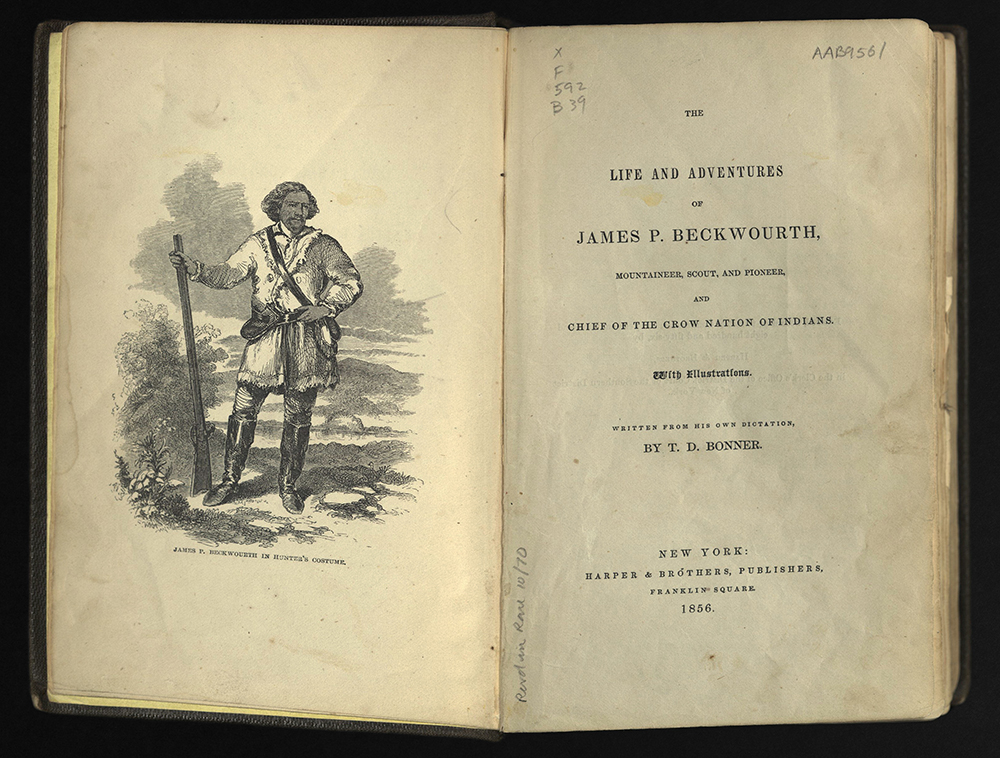
THE LIFE AND ADVENTURES OF JAMES P. BECKWOURTH ...
James Pierson Beckwourth (1798?-1867?)
New York: Harper & Brothers, 1856
First edition
F592 B39
Mountain man Jim Beckwourth, born into slavery in Frederick County, Virginia and freed by his white father, began his life of western adventure with General William Ashley’s Rocky Mountain Fur Company, working in this capacity until 1826 when he went to New Mexico and began his own trading venture. He apprenticed as a blacksmith before he joined the Rocky Mountain Fur Company. Later, Beckwourth began selling his furs to the American Fur Company, John Jacob Aster's venture. While working as a trapper, he lived with the Crow Nation for many years.
Zenas Leonard reported that, in a Crow village, he met a man who “has acquired a correct knowledge of their manner of living, and speaks their language fluently. He has rose to be quite a considerable character, or chief, in their village; at least he assumes all the dignities of a chief, for he has four wives with whom he lives alternately.” Historians believe the man Leonard was writing about was Jim Beckwourth.
Beckwourth cooperated with the Ute Indians under Chief Wahkara to steal vast amounts of livestock from California ranches. According to Beckwourth’s own account, he visited Los Angeles in 1844, eventually settling there, operating a hotel and trading post. The pass he claimed to have taken through the Sierra Nevada, between Reno, Nevada and Portola, California, is named after him. The Beckwourth Trail, originally a Native American path, was taken by thousands of pioneers to California during the Gold Rush. In about 1858, he returned to his life as a mountain man in the Rockies.
Beckwourth dictated his memoir to Thomas D. Bonner, an itinerant justice of the peace. The consequent book was published in 1856, in England the same year, reprinted in 1858, and printed in a French translation in 1860. Contemporary American reviewers had a difficult time believing his story, probably because of prejudice against his race.
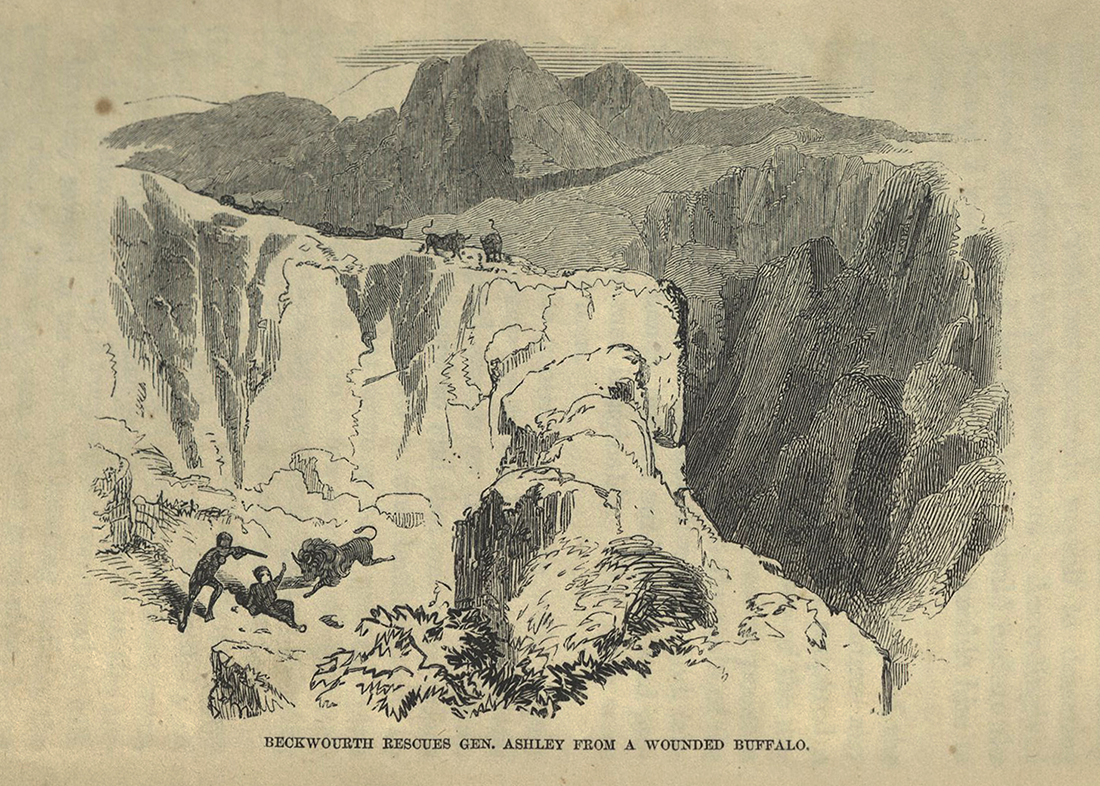
I, seeing the danger in which he was placed, sent a ball into the beast just behind the shoulder, instantly dropping him dead.
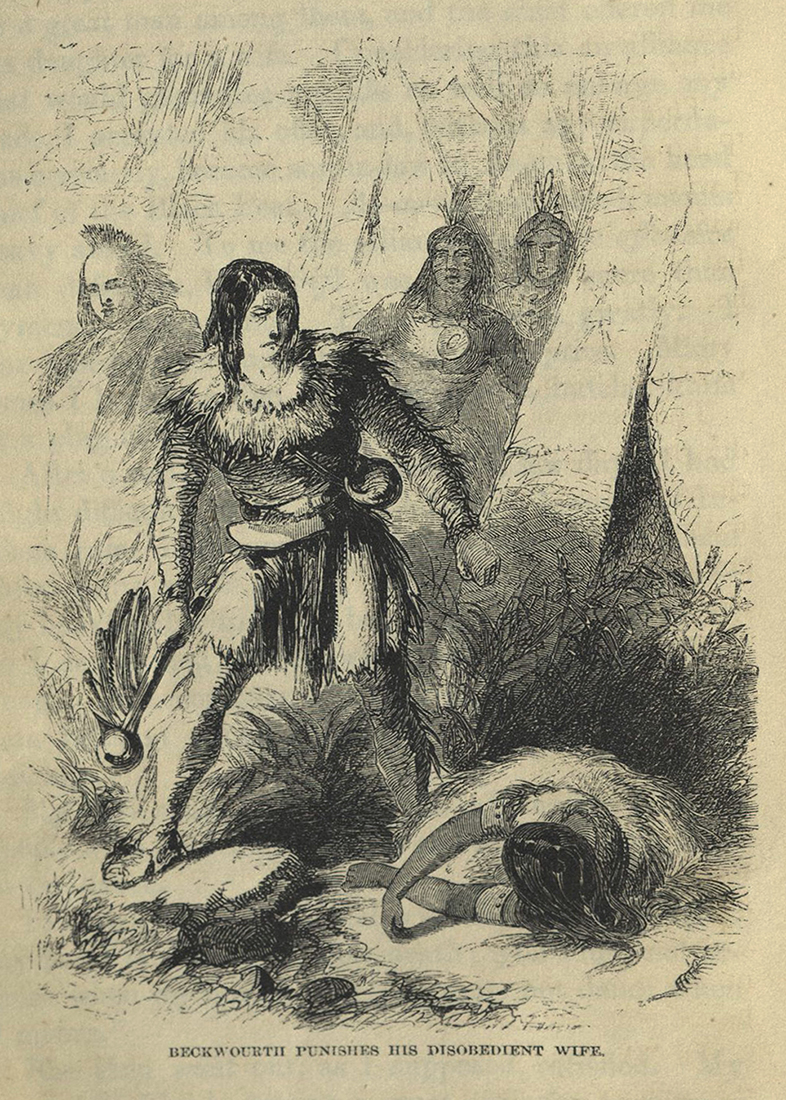
Taking my battle-axe, and forcing myself into the ring, I watched my opportunity, and struck my disobedient wife a heavy blow in the head with the side of my battle-axe, which dropper her as if a ball had pierced her heart.
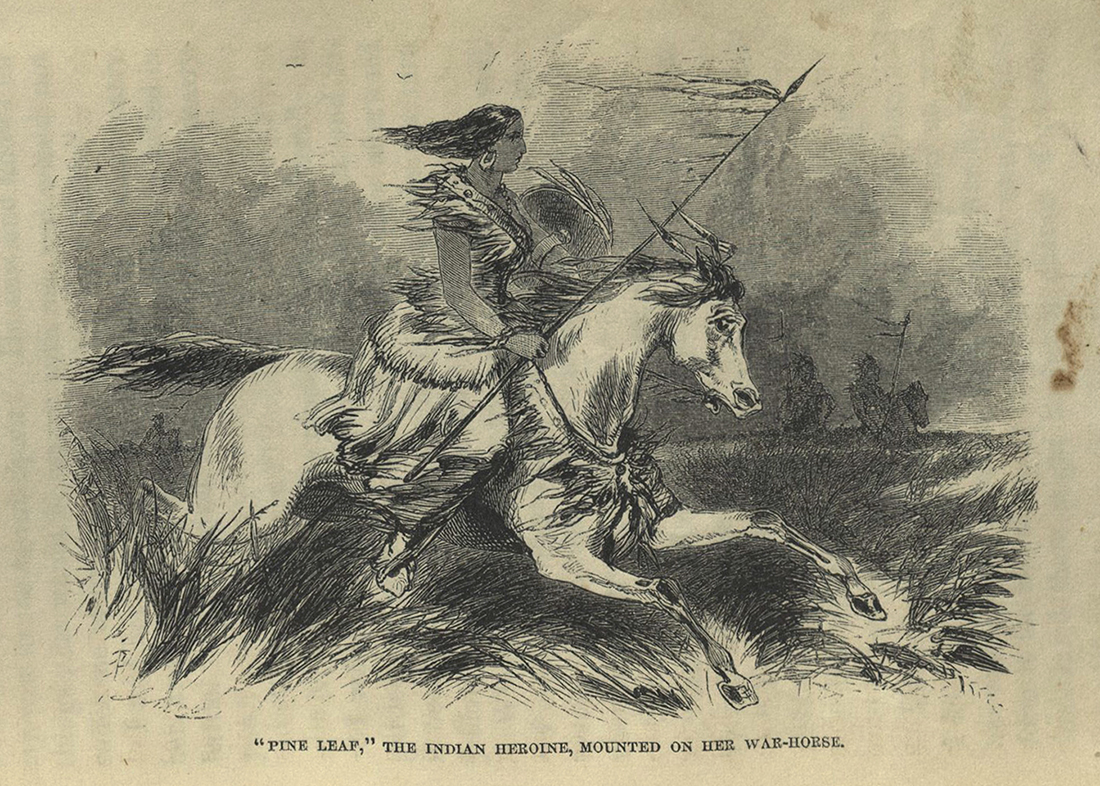
Her intelligence charmed me, and her modest and becoming demeanor singled her out from her sex. One day, while riding leisurely along, I asked her to marry me provided we both returned safe.
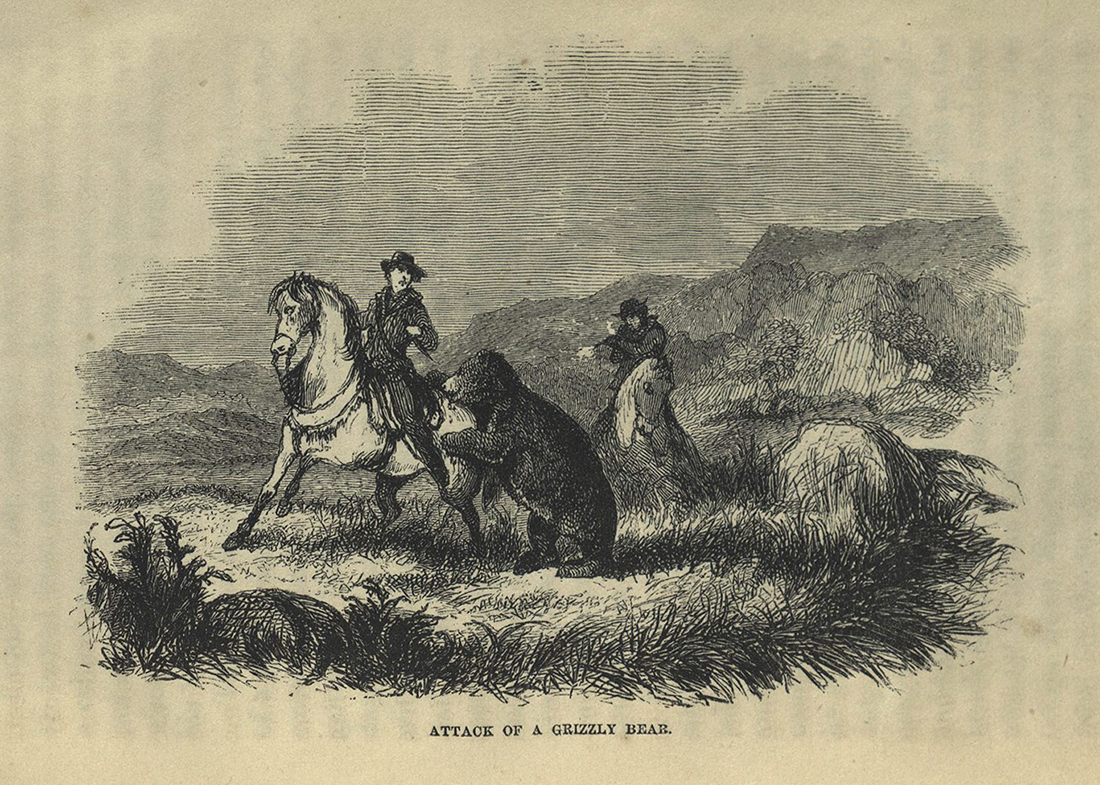
By-and-by Grizzly came in sight, walking along as independently as an alderman elect.
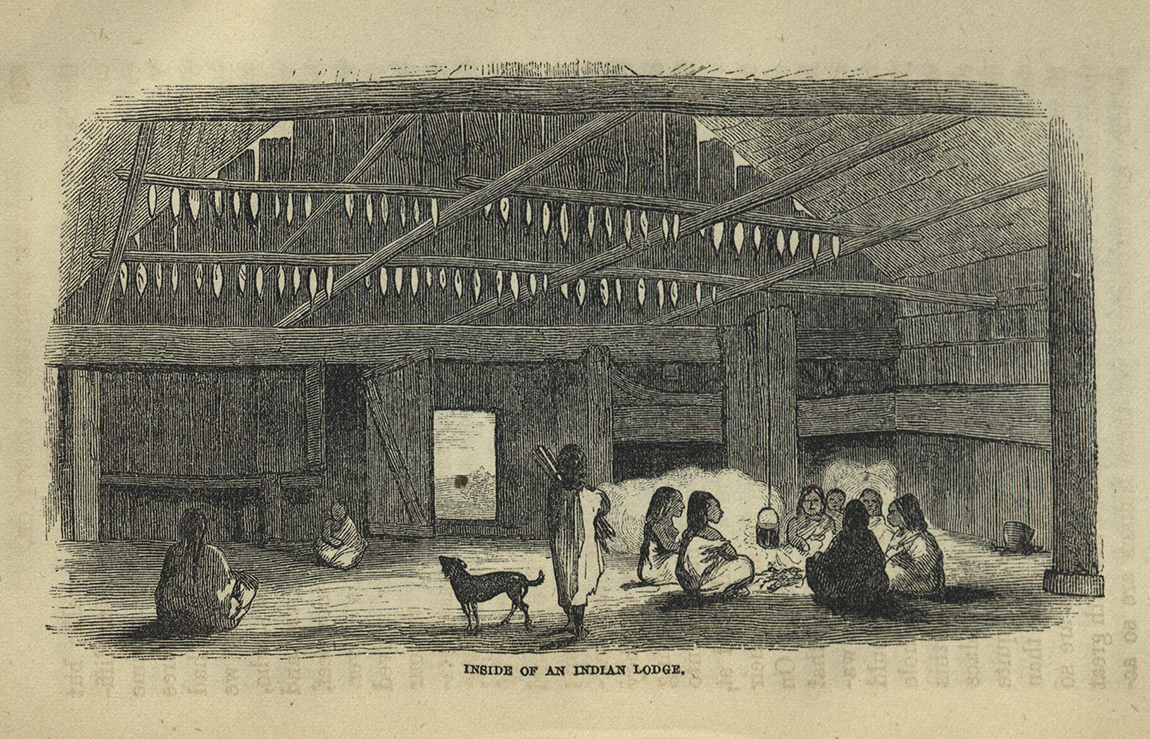
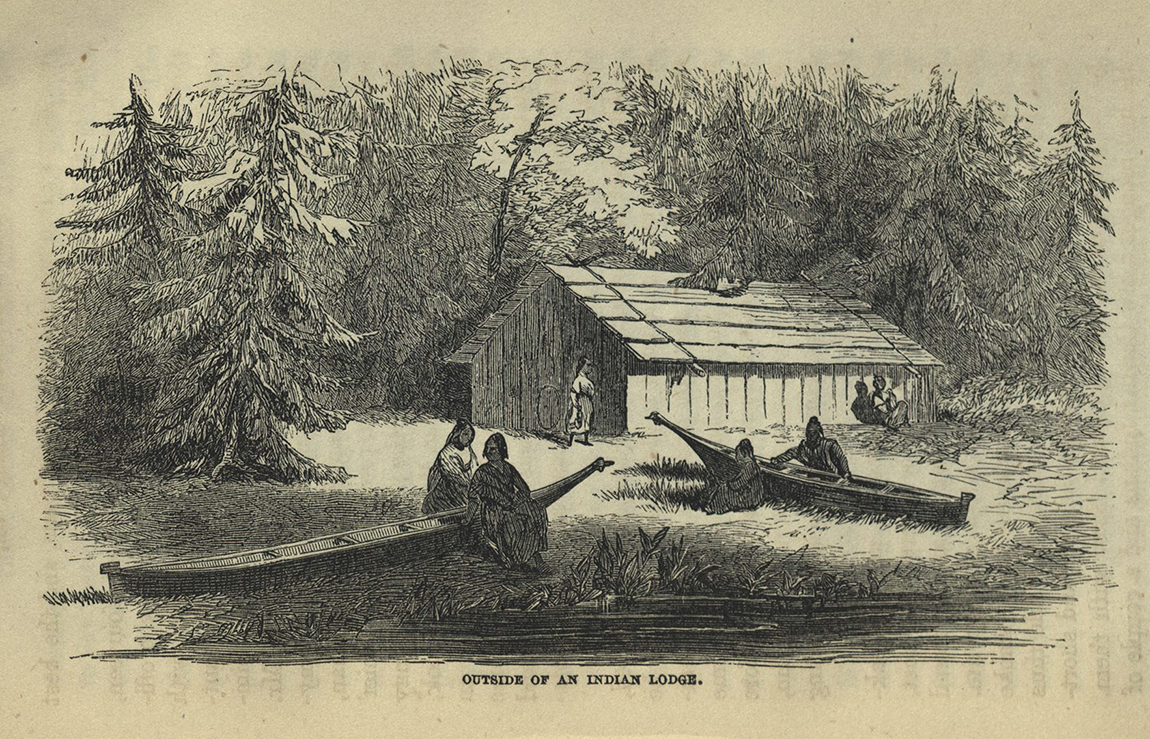
THE NORTHWEST COAST ...
James G. Swan (1818-1900)
New York: Harper & brothers, 1857
First edition
F891 S97
James Swan, born into a Massachusetts family, listened to stories of adventure from his seafaring uncle, who sailed along the Northwest coast during an 1806 trading expedition to the Columbia River. He used the California gold rush as an excuse to go on his own adventure, leaving behind his wife, Mathilda Loning, and two children. He worked in California for two years, publishing two articles in the California Courier.
In 1852, he left California for the Washington Territory. There, Swan established a strong rapport with the several Native American peoples, learning their cultures and languages, including a trade language that Northwest Coast Indians used to communicate between tribes and with non-Indians. He worked with Isaac I. Stevens in Washington, D.C., helping Stevens craft Indian treaties in 1853 and 1855 with translation. The treaties cancelled Indian land in the Willamette Valley and banished natives onto two reservations outside the valley.
The Northwest Coast details the homes, tools, religious ceremonies, songs, and games of the Native Americans Swan befriended. He returned to Washington Territory in 1859 and worked with Indian agent Henry A. Webster and the Makah tribe of Neah Bay. He continued to study tribal legend and worked as a schoolteacher on the reservation. The Makah named him Cha-tic, meaning “painter.” Swan’s book is illustrated with his own drawings.
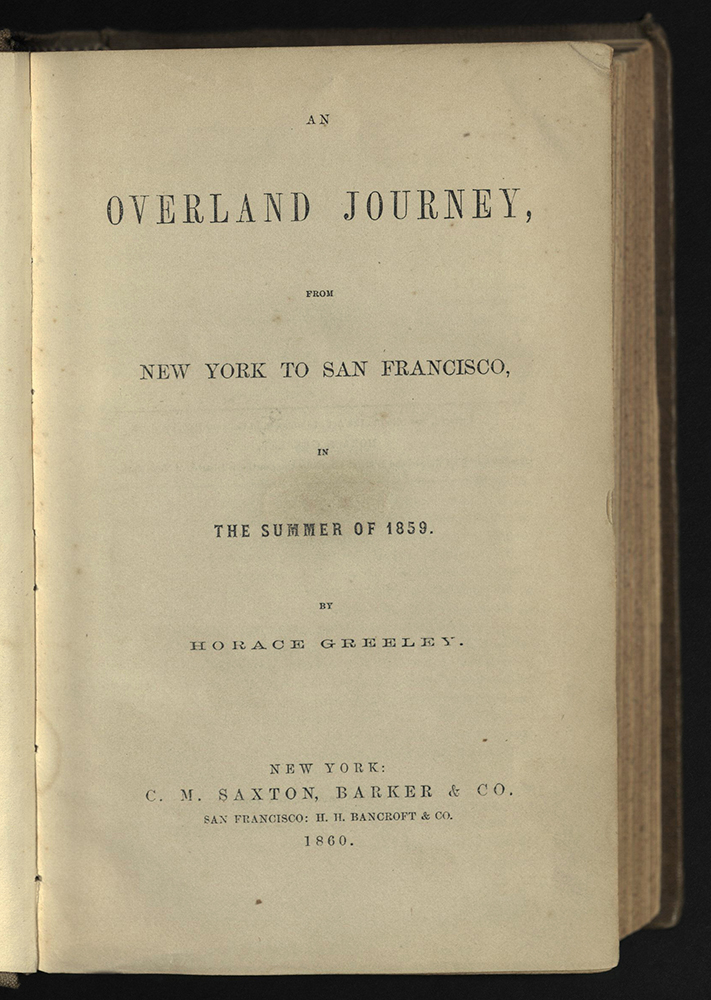
I propose in this letter to present such considerations as seem to me pertinent and feasible, in favor of the speedy construction of a railroad, connecting at some point our eastern network of railways with the waters of the Pacific ocean. Let facts be submitted to, and pondered by considerate, reflecting men. There are thousands of usually intelligent citizens, who have decided that a Pacific railroad is a humbug – the fantasy of demagogues and visionaries – without having ever given an hour’s earnest consideration to the facts in the case.
AN OVERLAND JOURNEY ...
Horace Greeley (1811-1872)
New York; San Francisco: C.M. Saxton, Barker & Co., 1860
First Edition
F593 G59
In 1859, editor and Republican, Horace Greeley, explored the projected central route for a transcontinental railroad line connecting the Mississippi Valley with the West Coast. Traveling mostly by stagecoach on an already well-stablished route through the Plains, the Rocky Mountains, Utah territory and the Sierra Nevada, he sent letters back to New York recounting economic possibilities and encouraging the development of the railroad and settlement of the American West. These letters were published in his New York Tribune, at that time the most influential newspaper in the United States.
His trip was not a happy one. He experienced illness (from drinking bad creek water) and the loss of his luggage in the Sweetwater River. He described the Plains as, “a tape-worm over tens of thousands of square miles of woodless, waterless desert…a dodge at once atrocious and contemptible.” For Greeley, the trip west was to cross the Plains, the Great American Desert, to end in the Edenic northwest. It was, wrote Greeley, “palpable homicide to tempt or send women and children over this thousand miles of precipe and volcanic sterility to Oregon.” The railroad was a necessary component to settling the continent. “I judge that the desert is steadily enlarging its borders and at the same time intensifying its barrenness,” he wrote and “[It] affords little sustenance and less shelter to man…” The lack of timber disturbed Greeley. He offered an opinion as to why this lack existed, writing that the wind blew so hard that trees could not grow, adding an extraordinary story that the wind blew so hard it blew the wheels off of a wagon in one instance and straightened them out in another.
Greeley was anti-slavery, mostly for economic reasons. But his thoughts about the Native Americans and the Chinese that he encountered on his trip supported and emphasized the ever-present racism rampant in the United States. Of Native Americans he wrote disparagingly, “But the Indians are children. Their arts, wars, treaties, alliances, habitations, crafts, properties, commerce, comforts, all belong to the very lowest and rudest ages of human existence…they are utterly incompetent to cope in any way with the European or Caucasian race…unless they shall be treated as a truly Christian community would treat a band of orphan children providentially thrown on its hands, the aborigines of this country will be practically extinct within the next fifty years.” Of the Chinese he wrote, “He is not malignant nor sanguinary, and seldom harms any but his own tribe. But he is thoroughly sensual, and intent on the fullest gratification of his carnal appetites, and on nothing else…he is an inveterate gambler, an opium smoker, a habitual rum drinker, and a devotee of every sensual vice. But he is weak in body, and not allowed to vote, so it is safe to trample on him…Even the wretched Indians of California repel with scorn the suggestion that there is any kinship between their race and the Chinese.”
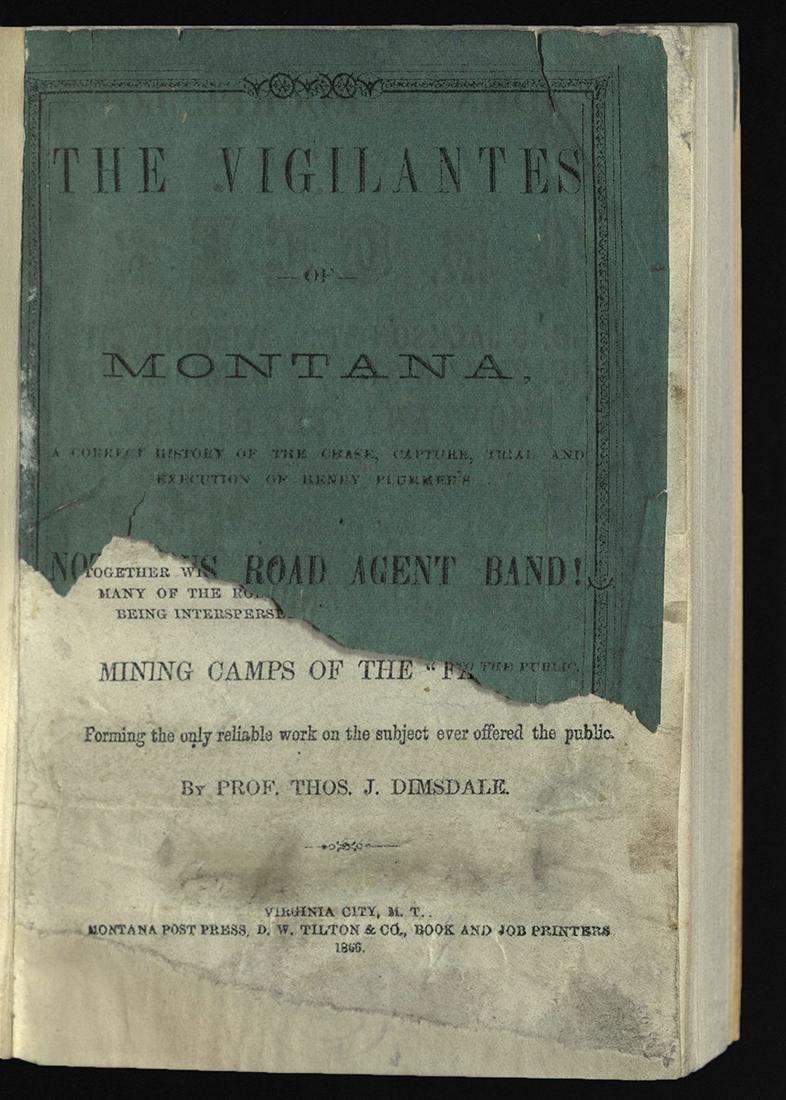
Above all things, let the resistless authority of the Vigilantes, whose power reaches from end to end of Montana, be never exerted except as the result of careful deliberation, scrupulous examination of fair evidence, and the call of imperative Necessity; which, as she knows no law, must judge without it, taking Justice for her counselor and guide.
THE VIGILANTES OF MONTANA ...
Thomas J. Dimsdale (1831-1866)
Virginia City, MT: D. W. Tilton & Co., 1866
First edition
F731 D57
This is the first book printed in Montana. It became a classic, presenting a picture of the lawless conditions that characterized mining camps. Charles Dickens wrote of it, “the most interesting book I ever read.” Dimsdale was the editor of the Virginia City Montana Post, and waged, in a series of newspaper articles in 1865, a campaign against lawlessness.
Dimsdale’s account of vigilantes denounced their victims as “low, brutal, cruel, lazy, ignorant, sensual, and blasphemous,” qualities Dimsdale believed were deserving of violent repression. In his conclusion, Dimsdale wrote, “Leave us the power of the people, as a last resort; and where governments break down, the citizens will save the State. No man need be ashamed of his connection with the Virginia Vigilantes.”
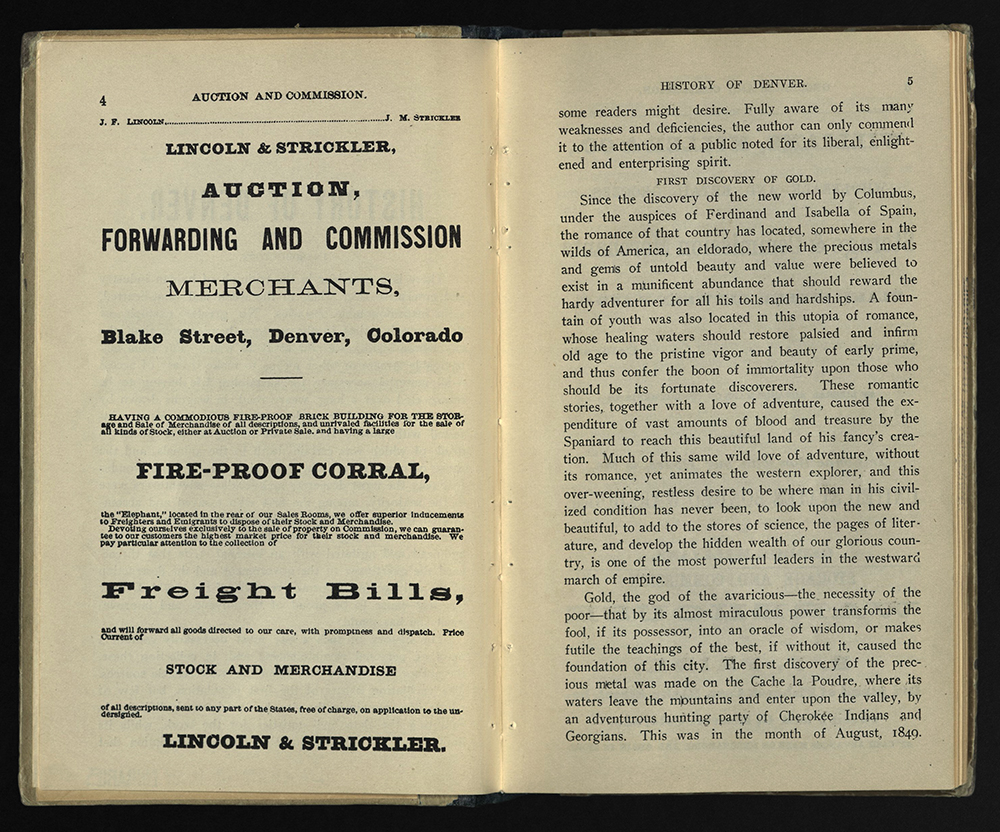
The dastardly scoundrels who committed this outrage, also stole three mules during the night. The Indians followed the trail next day and recovered their property. The majority of the citizens denounced the outrage, and through the efforts of Capt. James P. Beckworth, the Indians were pacified. Previous to this affair, the Indian troubles of this region had been principally on the part of the Utes, who had plundered and murdered several straggling prospectors in the mountains.
HISTORY OF THE CITY OF DENVER
Junius E. Wharton
Denver: Byers & Dailey, printers, news office, 1866
First edition
F784 D4 W4
The first history of Denver, this work tells it all with sections including the discovery of gold, emigrants, duels, murders, trials, executions, Indian scares, outrages upon the Indians, the Third Regiment, the mint, marshals, fires, the Pacific Railroad, guerrilla raids, gambling, trading houses, “claim jumper’s wars,” “the turkey war,” and “the great flood,” quoting a Professor Goldrick and his “somewhat verbose” account of the event.
Now the torrent, swelled and thickened, showed itself in sight, sweeping tremendous trees and dwelling houses before it – a mighty volume of impetuous water, wall-like in its advancing front, as was the old Red Sea when the Israelites walked through it and volcano-like in its floods of foaming, living lava, as it rolled with maddened momentum directly toward Larimer street bridge and gorged, afterwards rebounding with impetuous rage and striking the large Methodist church and the adjoining buildings, all of which it wrested from their foundations and engulphed in the yawn of bellowing billows at they broke over the McGaa street bridge.
William Newton Byers (1831-1903) & John Lewis Dailey (1833-1890) arrived in Denver on April 8, 1859. Dailey had apprenticed as a printer in Fort Wayne, Indiana. While working as a surveyor for the United States government, Byers crossed the Plains and the Rocky Mountains. He joined the Pike’s Peak Gold Rush in 1858, where he began reporting first-hand from the mines.
Byers began advocating for Colorado statehood using The Rocky Mountain News, which he and Dailey founded on April 23, 1859. In June of that year, Byers was chosen president of a convention to draft a constitution for the proposed state. Junius Wharton, described as having a foul disposition, acted as editor and contributor to several newspapers, including The Rocky Mountain News. In his History of the City of Denver he writes of “The natural advantages of Colorado as a stock country,” adding that “The grass-fed beef and mutton of the Territory may safely challenge the markets of the world.” Along with his glowing report of Colorado Territory and the city of Denver, he wrote of “bloody outrages” in the form of horse thievery and acts of violence such as murder. He was, himself, the victim of violent attacks. The book is interspersed with advertisements of local businesses throughout and extensive lists of businesses and churches.
THE HEATHEN CHINEE
Bret Harte (1836-1902)
Chicago, IL: The Western News Company, 1870
First separate edition
PS1831 H37 1870
Written as a satire of anti-Chinese attitudes in California, Bret Harte’s poem was excerpted and published throughout the United States as a diatribe against cheap Chinese labor, shaping American anti-Chinese sentiment. The broad distribution made Bret Harte a household name in 1870. Originally published as “Plain Language from Truthful James” in September 1870 in the Overland Monthly, of which Harte served as its first editor, it was published that same year with illustrations by Joseph Hull.
The publication consisted of nine loose pages, printed on stiff paper, and sold in an engraved envelope. The leaves could be framed. Hull’s penultimate drawing elaborates on the poems reference to “the scene that ensued,” a violent mob action like one of many that occurred during this time in western cities such as San Francisco and Denver.
This separate printing of Harte’s satire was published without his permission. At the time copyright laws were difficult to enforce. The newly illustrated, pirated edition sold thousands of copies, much to Harte’s dismay. In several cases the illustrations refer to characters and incidents that were not in Harte’s verse.
Harte, born in New York, arrived in California in 1854, joining his widowed mother who had moved there with relatives and friends the year before. In 1864, after working a series of jobs including typesetter, Harte moved to San Francisco. After his success, he moved to Boston, then Germany and finally England, where he remained until the end of his life.
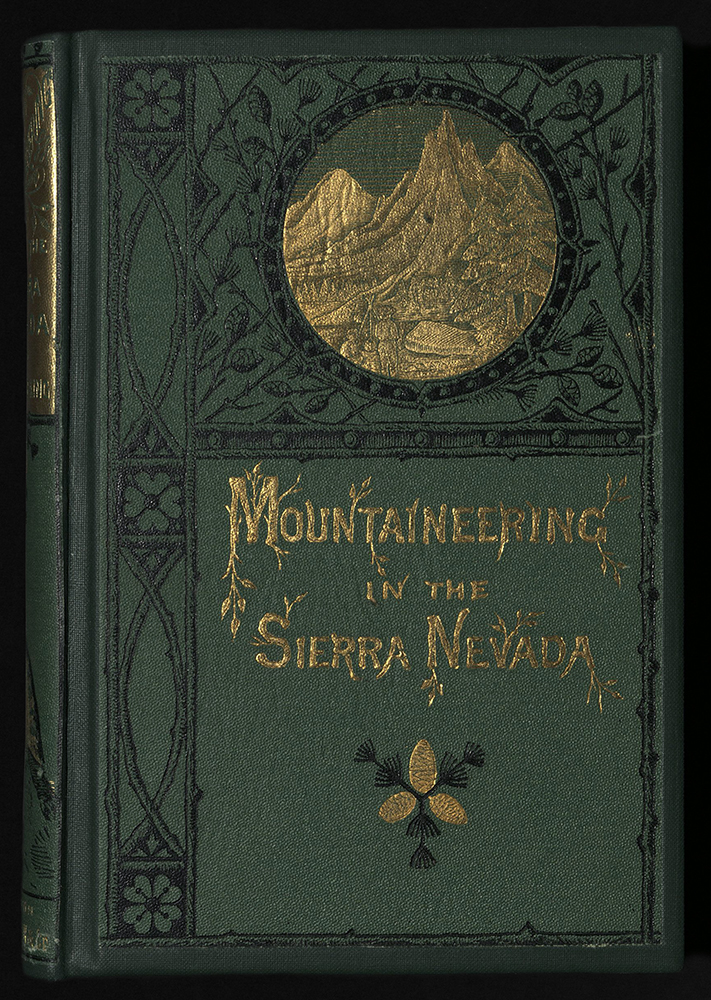
A vivid belt of blue lightning flashed down through the blackness, and for a moment every outline of cliff and forest forms, and the rushing clouds of snow and sleet, were lighted up with a cold, pallid gleam. …In the moment of lightning I saw that the Yosemite Fall, which had been dry for a month, had suddenly sprung into life again. Vast volumes of water and ice were pouring over and beating like sea-waves upon the granite below.
MOUNTAINEERING IN THE SIERRA NEVADA
Clarence King (1842-1901)
London: S. Low, Marston, Low & Searle, 1872
F868 S5 K52
Mountaineering in the Sierra Nevada gave Clarence King a place with Bret Harte as a founder in the California school of literature. This collection of naturalist sketches charmed nearly everyone who read it. One of the few critics was the author’s new friend, Henry Adams. Adams expressed father-like worry that King’s literary dabbling would cost him influence with the congressmen who held the purse strings of the survey of the Fortieth Parallel, a much more important venture, both for the American public and for King’s career. Despite Adams’ trepidation, King went on to survey the Fortieth Parallel, produce an excellent report on his work, and become celebrated for the adventure.
Yale-educated King first went West in 1863, where he was offered a job with California’s State Geological Survey. Under these auspices, he explored much of the Sierra and the Mt. Shasta region.
King entered into federal service in 1867, organizing and operating his geographical and geological survey under army sponsorship. King wrote his own orders and chose his own men, all of whom were civilian scientists. He mapped the basin and range country of Nevada and Utah and the mountains of Utah and Wyoming with a new degree of accuracy, all the while conducting geological, botanical and zoological examinations of the country he explored. He also looked for possibilities for development of railroad lines, promoting settlement along these routes.
In 1870, Brett Harte’s Overland Monthly accepted one of his stories. A year later, an editor of the Atlantic Monthly heard King lecture and invited him to submit articles for publication in that magazine. These articles became chapters in Mountaineering. King was able to write about his scientific investigations in a way that gave lay readers a sense of adventure. In typical marketing strategy of the time, Mountaineering was first published in Boston and London simultaneously. The book received positive reviews in several magazines, with comparisons to Washington Irving and Francis Parkman. A century after the publication of this book, Wallace Stegner would later sing its praises.
King became the first head of the U.S. Geological Survey, joining other bureaus of the Interior Department which came to have great sway over what happened in the West. His U.S. Geological Survey focused on mineral deposits rather than water sources for irrigation, emphasizing the benefits for mining corporations rather than farmers.
King’s racist remarks against the Mexicans and the Chinese he encountered in California, described in Mountaineering in the Sierra Nevada, were characteristic of Anglo loathing in the literature of the time. If current readers can look beyond this, the book is an intimate view of the first extended exploration of the Sierra.
Ironically, blue-eyed King would later marry a Black woman, convincing her that he was a Black railroad porter, a ruse he presumably got away with for the rest of their lives together.
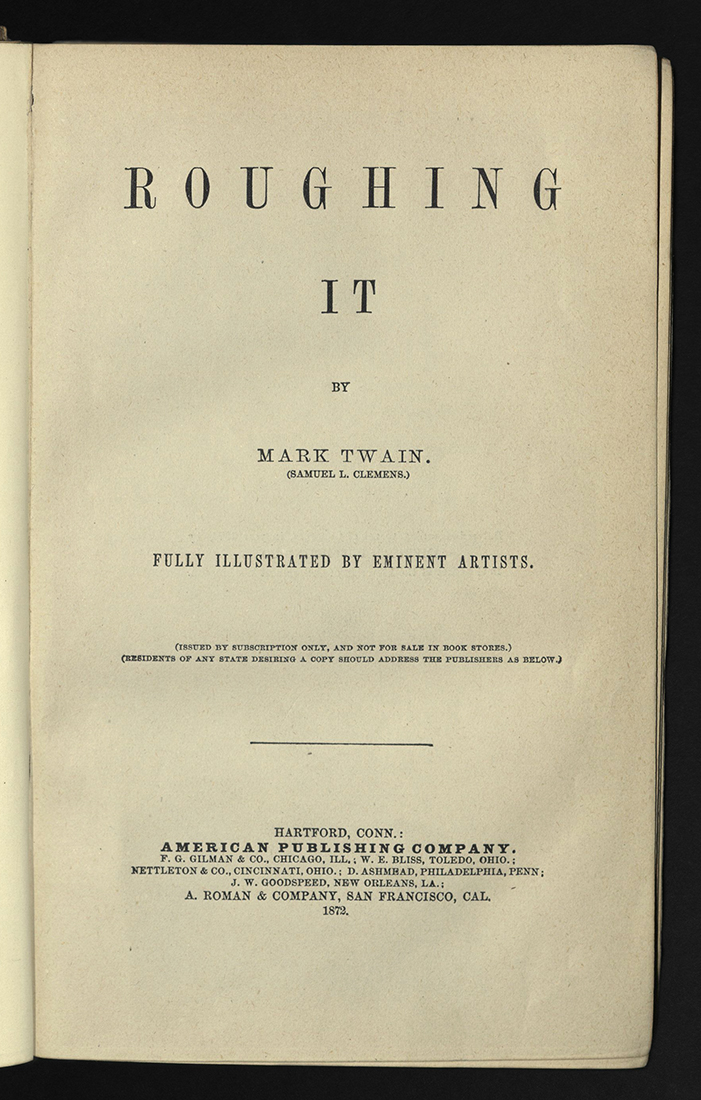
ROUGHING IT
Mark Twain (1835-1910)
Hartford, CT: American Publishing Co.; Chicago: F. G. Gilman & Co., 1872
First edition
PS1318 A1 1872
Mark Twain’s semi-autobiographical travel book was written in 1870-71 and published as a prequel to his first book, The Innocents Abroad. Roughing It covers 1861 to 1867. In 1867, the Transcontinental Railroad was completed, an event, Twain wrote to his publisher, that “has turned so much attention in that direction.” His narrative moves through Nevada, California, and ultimately Hawaii.
Samuel Clemons took the journey with his brother Orian, who was appointed Secretary to the Governor of the Nevada Territory in 1861. The Clemons brothers left St. Louis on the first leg of their journey to Nevada Territory on July 18, 1861. Clemons devoted the first twenty chapters of Roughing It to an account of that journey.
Clemons vividly documented various aspects of the boom-and-bust American West, taking on the romantic expectations of wilderness and savagery as the disillusioned easterner, mocking the dreams of Americans who sought quick and easy wealth in the West, with an exaggerated humor. With his infallible social commentary and true to form, he wrote of hoaxes and gullibility: “The government of my country snubs honest simplicity, but fondles artistic villainy, and I think I might have developed into a very capable pickpocket if I had remained in public services a year or two.” Clemons used letters he wrote to the Sacramento Union from his travels in the Sandwich Islands in 1866, as the basis for some of the chapters. He wrote extensively of his time in Aurora and Virginia City in 1862.
Clemons wrote briefly of three racial groups other than whites: “Indians,” “Chinamen,” and Pacific Islanders. He expressed some indignation at anti-Chinese discrimination and curiosity about the values of Hawaiian culture, but his attitude toward Indians was shamefully, outrageously racist:
Such of the Goshoots as we saw, along the road and hanging about the stations, were small, lean, ‘scrawny’ creatures; in complexion a dull black like the ordinary American negro; their faces and hands bearing dirt which they had been hoarding and accumulating for months, years, and even generations, according to the age of the proprietor; a silent, sneaking, treacherous looking race; taking note of everything, covertly, like all the other ‘Noble Red Men’ that we (do not) read about, and betraying no sign in their countenances; indolent, everlastingly patient and tireless, like all other Indians; prideless beggars--for if the beggar instinct were left out of an Indian he would not ‘go,’ any more than a clock without a pendulum; hungry, always hungry, and yet never refusing anything that a hog would eat, though often eating what a hog would decline; hunters, but having no higher ambition than to kill and eat jack-ass rabbits, crickets and grasshoppers, and embezzle carrion from the buzzards and cayotes; savages who, when asked if they have the common Indian belief in a Great Spirit show a something which almost amounts to emotion, thinking whiskey is referred to; a thin, scattering race of almost naked black children, these Goshoots are, who produce nothing at all, and have no villages, and no gatherings together into strictly defined trivial communities--a people whose only shelter is a rag cast on a bush to keep off a portion of the snow, and yet who inhabit one of the most rocky, wintry, repulsive wastes that our country or any other can exhibit.
Nor was Clemons kind to Mormon women:
Our stay in Salt Lake City amounted to only two days, and therefore we had no time to make the customary inquisition into the workings of polygamy and get up the usual statistics and deductions preparatory to calling the attention of the nation at large once more to the matter. I had the will to do it. With the gushing self-sufficiency of youth I was feverish to plunge in headlong and achieve a great reform here--until I saw the Mormon women. Then I was touched. My heart was wiser than my head. It warmed toward these poor, ungainly and pathetically "homely" creatures, and as I turned to hide the generous moisture in my eyes, I said, “No--the man that marries one of them has done an act of Christian charity which entitles him to the kindly applause of mankind, not their harsh censure--and the man that marries sixty of them has done a deed of open-handed generosity so sublime that the nations should stand uncovered in his presence and worship in silence.
Illustrated with a whopping three hundred and four drawings by a variety of artists, many of them originally meant for another book entirely, Clemons blamed the poor sales of this book on these.
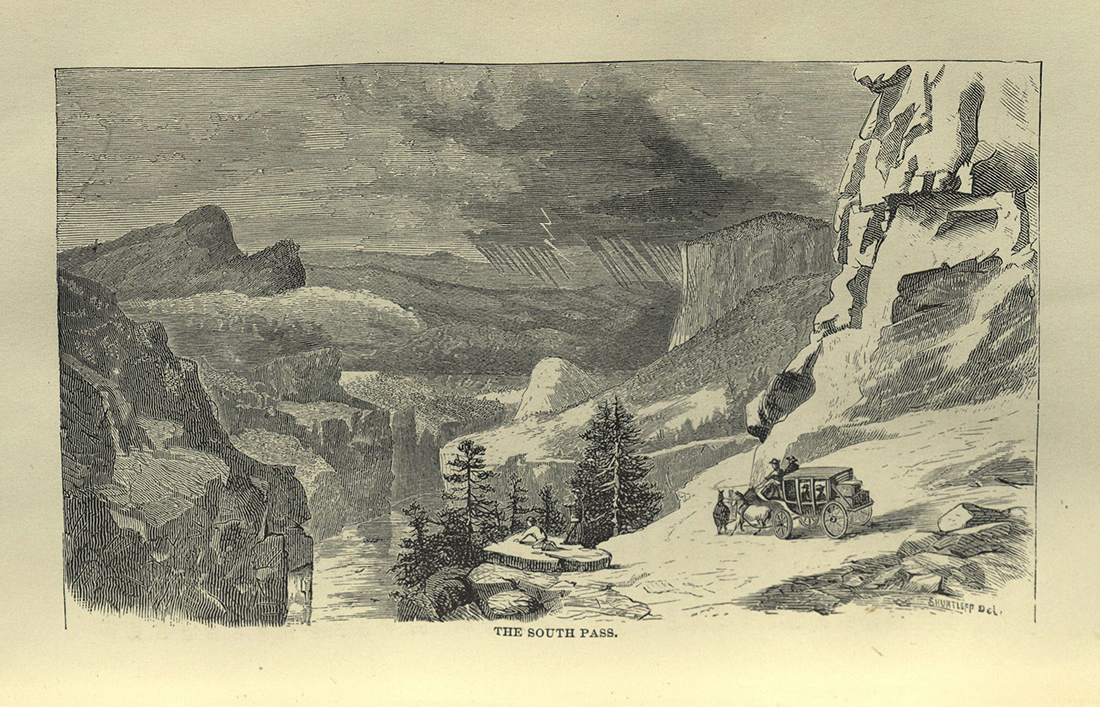
At that place the upper third of one or two majestic purple domes projected above our level on either hand and gave us a sense of a hidden great deep of mountains and plains and valleys down about their bases which we fancied we might see if we could step to the edge and look over.
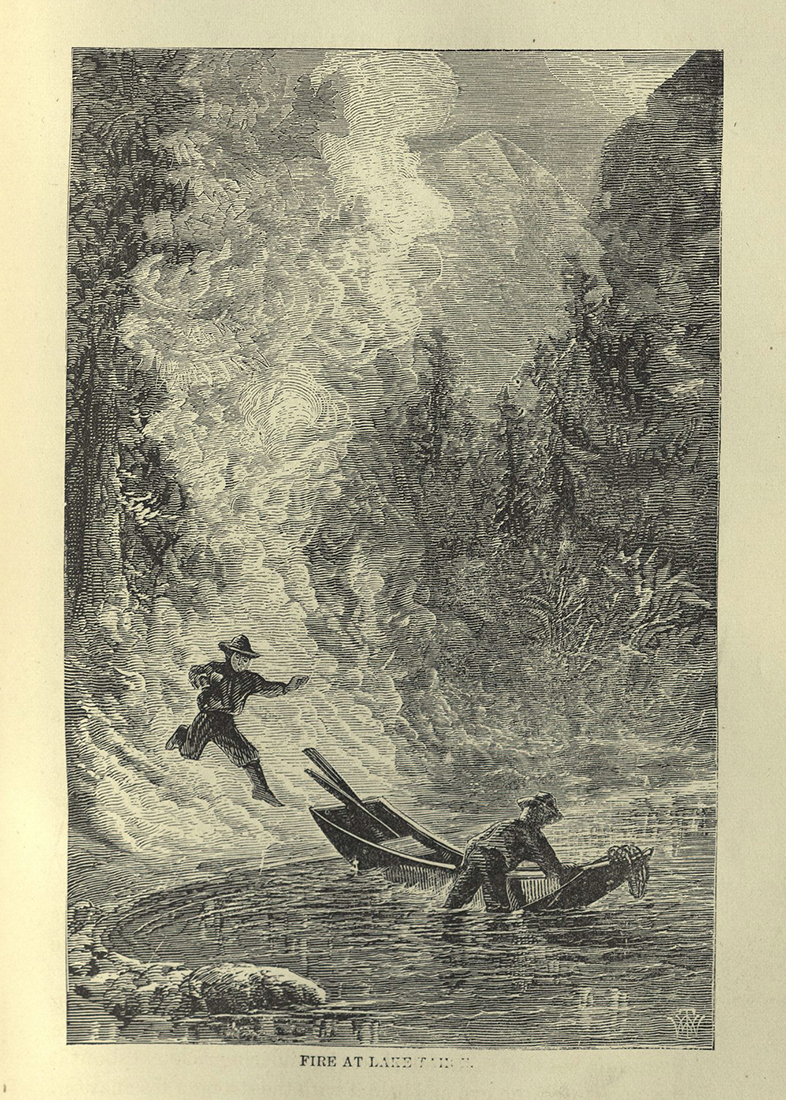
It went surging up adjacent ridges – surmounted them and disappeared in the canons beyond – burst into view upon higher and farther ridges, presently – shed a grander illumination abroad, and dove again – flamed out again, directly, higher and still higher up the mountainside – threw out skirmishing parties of fire here and there, and sent them trailing their crimson spirals away among remote ramparts and ribs and gorges, till as far as the eye could reach the lofty mountain-fronts were webbed as it were with a tangled network of red lava streams.
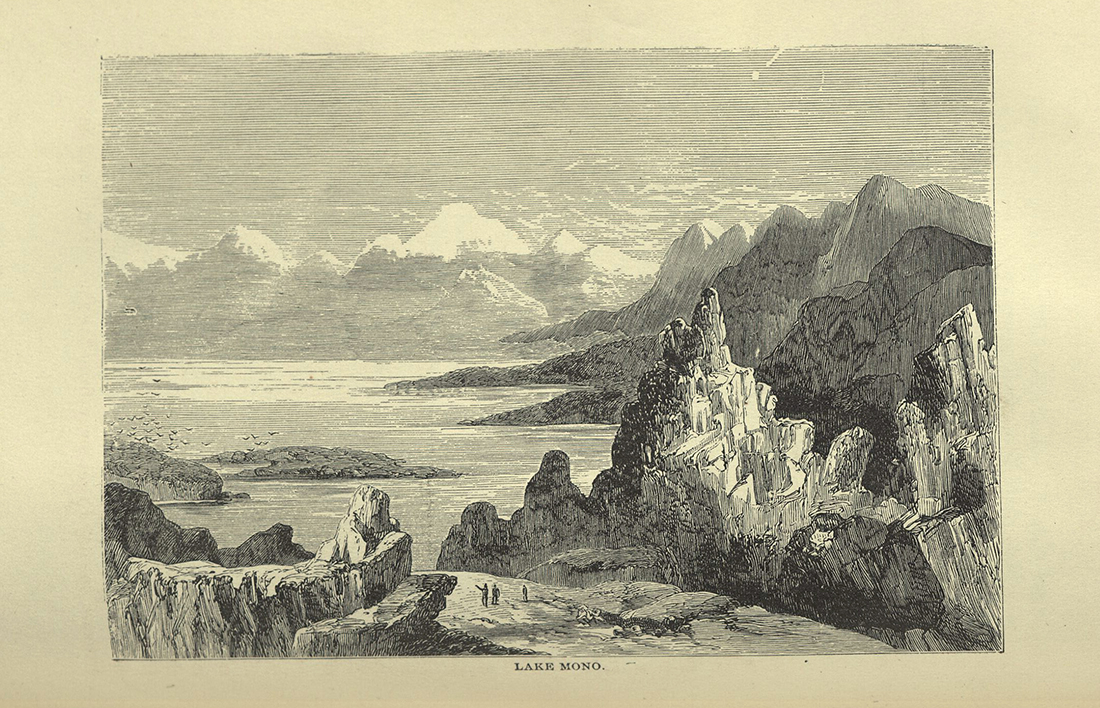
This solemn, silent, sailless sea – this lonely tenant of the loneliest spot on earth – is little graced with the picturesque.
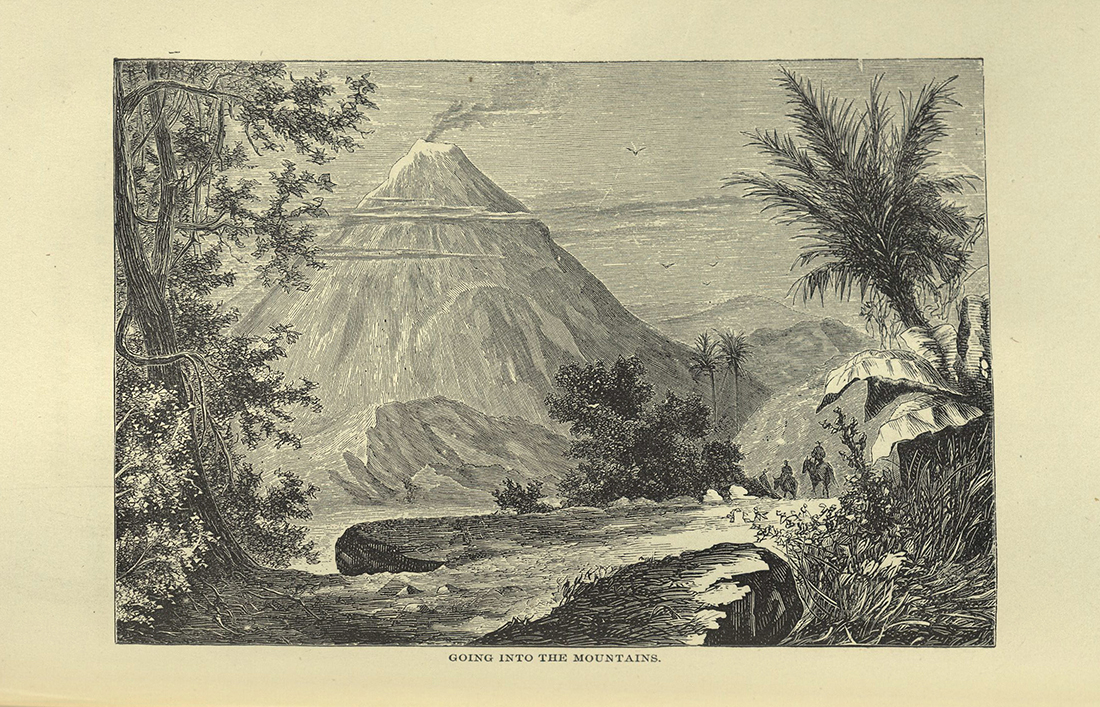
The trail passes along on high ground…and usually about a mile distant from the ocean, which is always in sight, save that occasionally you find yourself buried in the forest in the midst of a rank tropical vegetation and a dense growth of trees, whose great bows overarch the road and shut out the sun and sea and everything, and leave you in a dim, shady tunnel, haunted with invisible singing birds and fragrant with the odor of flowers.
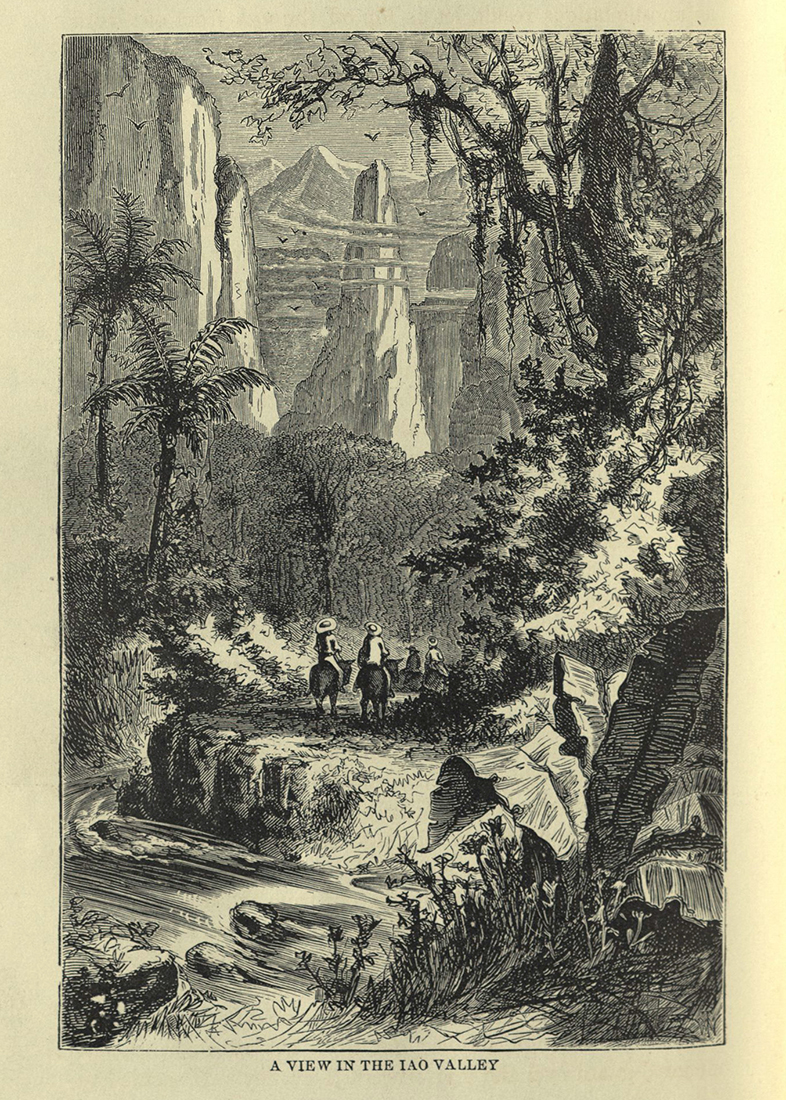
The trail lay along the edge of a brawling stream in the bottom of the gorge – a shady route, for it was well roofed with the verdant domes of forest trees… Passing shreds of cloud trailed their shadows across these shining fronts, mottling them with blots; billowy masses of white vapor hid the turreted summits, and far above the vapor swelled a background of gleaming green crags and cones that came and went, through the veiling mists, like islands drifting in the fog…
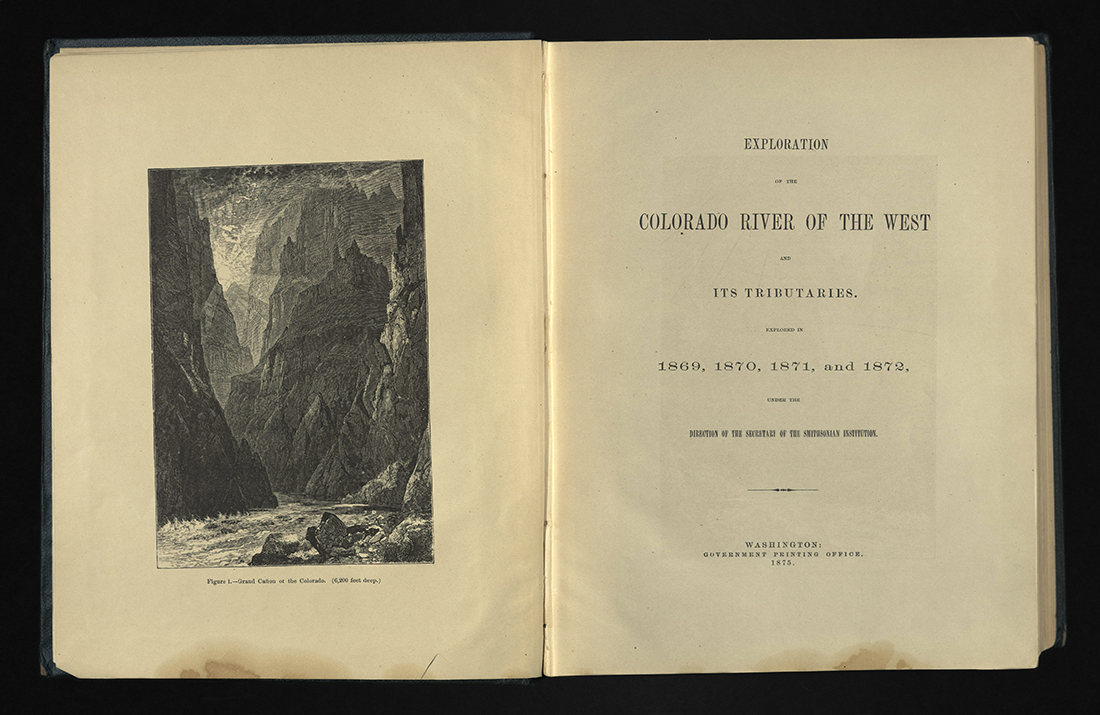
And now we go on through this solemn, mysterious way. The river is very deep, the canon very narrow, and still obstructed, so that there is no steady flow of the stream; but the waters wheel, and roll, and boil, and we are scarcely able to determine where we can go… We can neither land nor run as we please.
EXPLORATION OF THE COLORADO RIVER OF THE WEST ...
John Wesley Powell (1834-1902)
Washington: G.P.O., 1875
First edition
F788 S65 1875
John Wesley Powell, as director of the U.S. Geological Survey, produced this extensive scientific report on his groundbreaking exploration that underscored the dramatic features and economic possibilities of the American West. It included two large maps and eighty wood engravings of the landscape and peoples of the Grand Canyon.
The report began with a description of trips down the Green and Colorado Rivers, beginning on May 24th, 1869. Powell and a party of ten men, including artists and photographers, embarked on four boats at Green River City, Wyoming and headed south towards the mostly unexplored Colorado River. In late August, after enduring harrowing rapids and several near-fatal accidents, as well as being perilously low on supplies, Powell and his men emerged from the Grand Canyon at Callville. Their success was the basis for several repeat expeditions led by Powell, during which he discovered the last unknown river (the Escalante) and the last unknown mountain range (the Henry Mountains) in the United States.
Powell’s deep appreciation for the American West made his report one of the most celebrated works in the literature of exploration. His pioneering scientific and natural history data gave way to an early debate about the viability of settling the country. He was the first government scientist to understand fully the climatic challenges of the West.
Powell was apparently reluctant to write this report. It was only after the House of Representatives refused to consider funding for future explorations that Powell agreed to publish the story of his first expedition. The book became one of the most popular adventure narratives in American literature. Powell’s potent prose and the book’s illustrations brought the drama of the remote and demanding Western landscape into the parlors of an awed and eager Eastern audience.
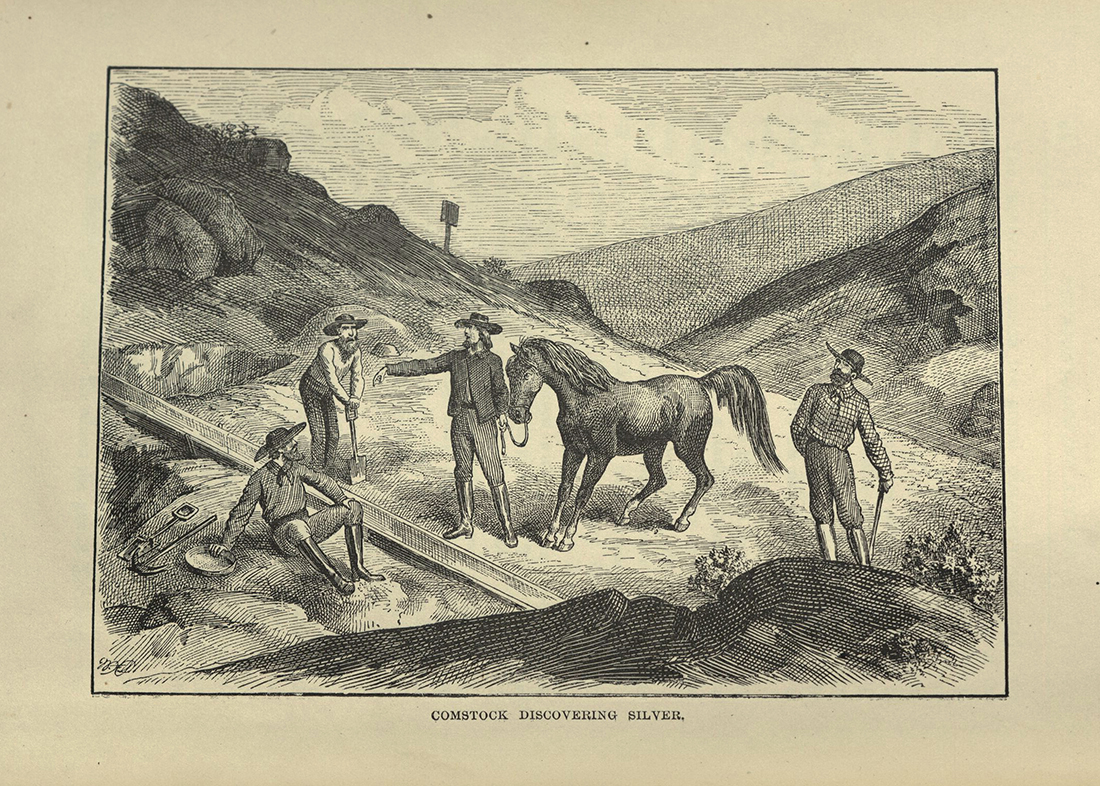
When the gold caught his eye, he was off the back of his pony in an instant. He was soon down in the thick of it all – “hefting” and running his fingers through the gold, and picking into and probing the mass of strange-looking “stuff” exposed.
HISTORY OF THE BIG BONANZA ...
Dan De Quille (1829-1898)
Hartford, CT; San Francisco: American Publishing Company, 1876
First edition
TN413 N23 W94 1876
This account of mining life at the Comstock Lode, a vein of gold and silver that ran beneath the mountainside town of Virginia City, Nevada was written by a miner turned writer. It has an introduction by the author’s friend, Mark Twain. Twain had worked with the author at the same Nevada newspaper, the Territorial Enterprise.
Dan De Quille was among the earliest to descend the mine just after it had been opened by John Mackay in 1873. Supervised by Mackay, De Quille, along with a few other visitors, took the dip into the 1500-foot station, then went east into Crosscut No. 1. One hundred feet past that intersection, they saw the first ore body, described by De Quille as “moderately rich.” Twenty-five feet into the ore body, the walls, ceiling and floor sparkled. The sight, De Quille quoted one man, made “a poor man sick to look at it.” De Quille called it “the richest mineral discovery in the world’s history” describing it as “the great bonanza” in a letter sent to the San Francisco Chronicle. Soon after that, he perpetuated the moniker that stuck, “the Big Bonanza.” “Bonanza” is a Spanish word meaning a rich ore body.
Eventually, the excavated hole became 1,167 feet deep, revealing a vein of gold and silver fifty-four feet wide. History of the Big Bonanza describes mining success and failures, the Chinese, opium dens, drinking, brawling, interactions with Native Americans, exploration and speculation, illustrated with black and white drawings.
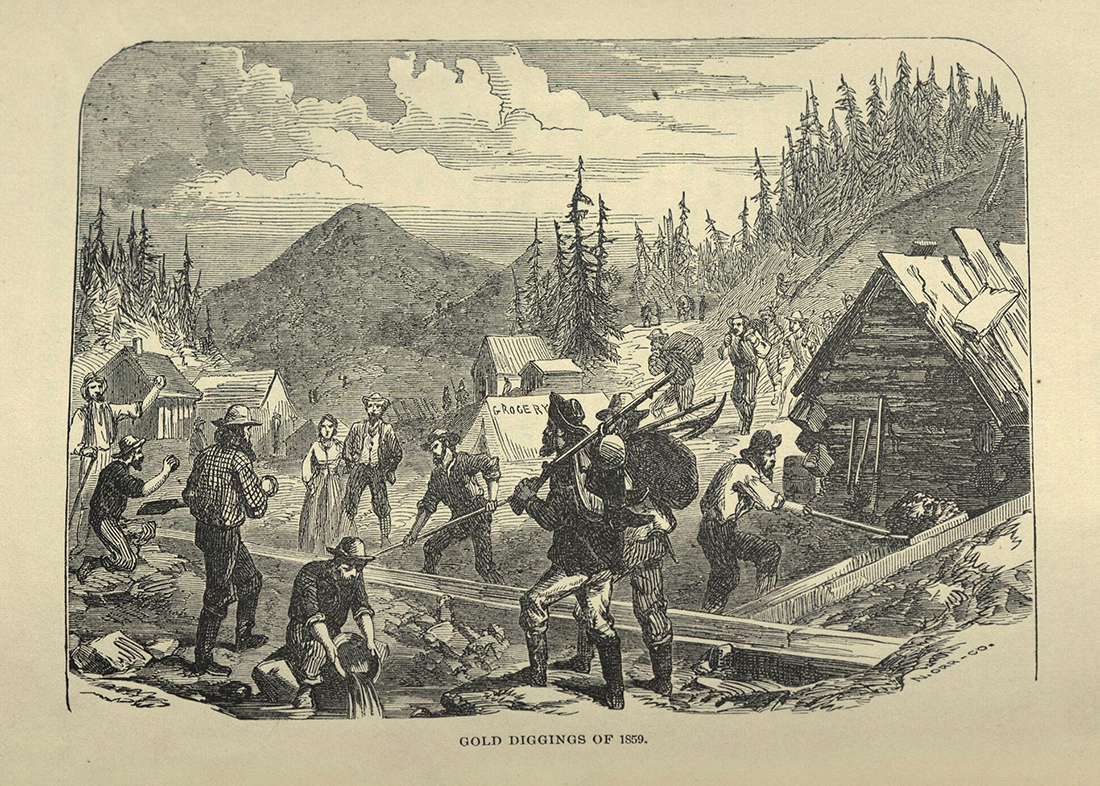
The majority of the sagacious citizens of the then mining metropolis of the country did not think much of the new strike. They had placer-mines near at home, five miles below, that prospected much better. However, “Old Pancake” and some of others interested in the new diggings, blowed about them as being the big thing of the country.
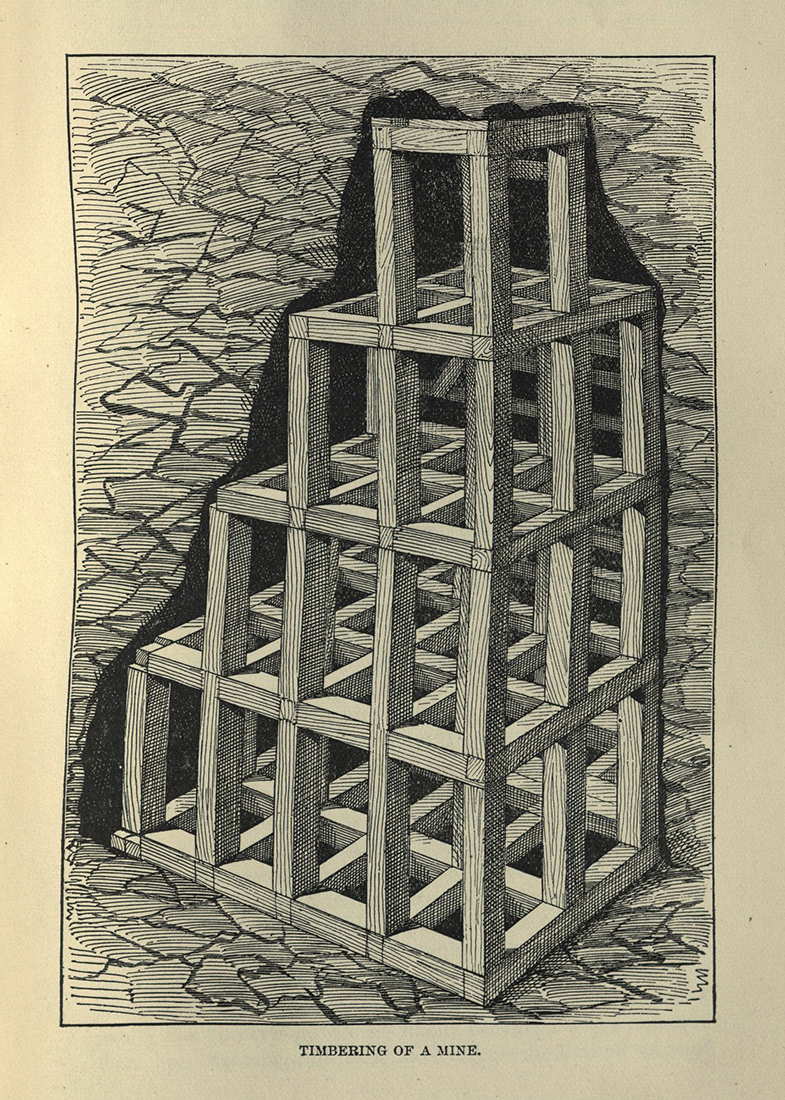
The Ophir was probably the first mine in any part of the world where such a system of timbering became a necessity, as no ore-body of such great width had ever before been found. Nothing seen in the Comstock mines more surprises and pleases the mining men of Europe than this mode of timbering.
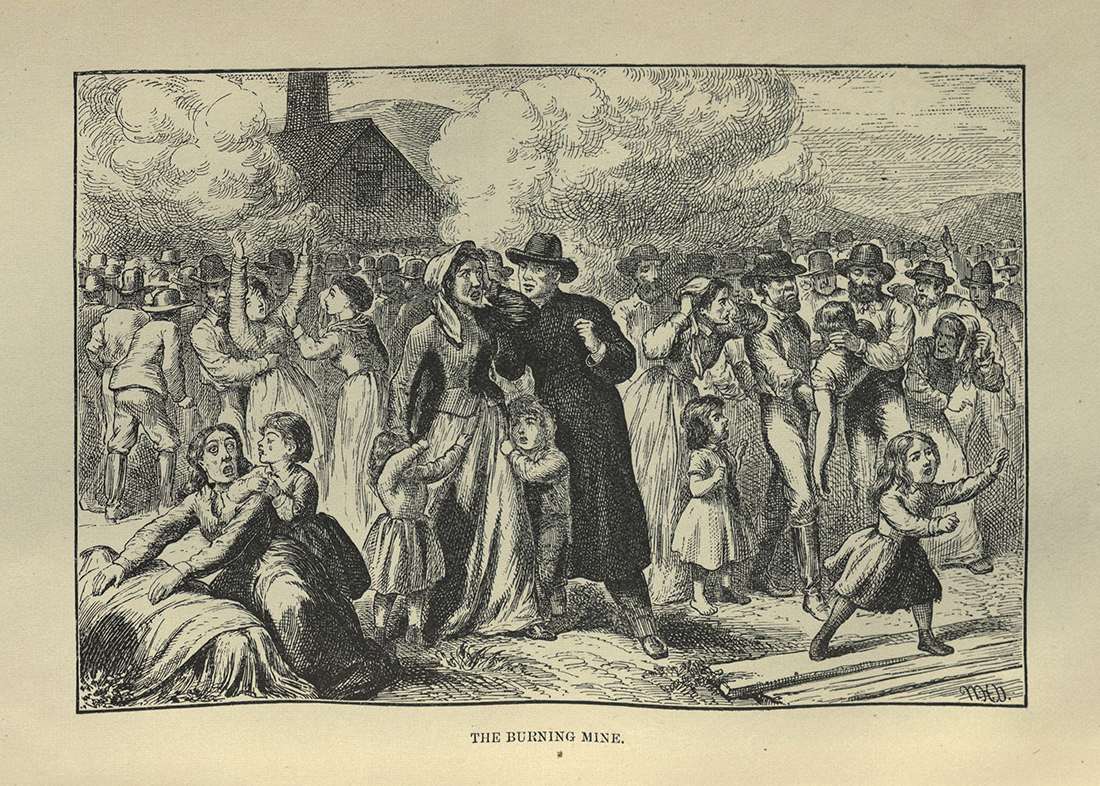
As this cage started up, hope left the hearts of those remaining behind. They were heard to throw themselves into the shaft and to fall back on the floors of the mine.
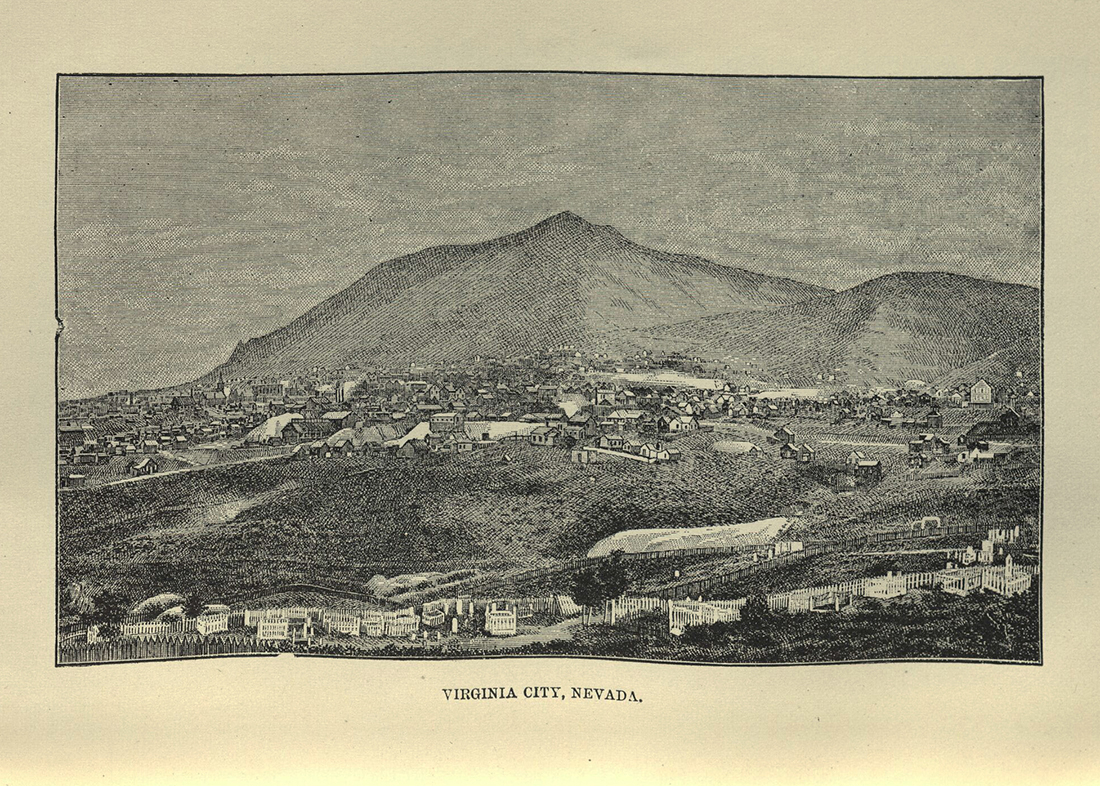
Virginia City… lies along the eastern face of Mount Davidson, on a broad sloping plateau, and is surrounded on all sides by rugged hills and rocky mountain peaks. In the early days, these hills were covered with a sparse growth of nut pine-trees – a sort of stunted pine, in size and form of trunk and branches somewhat resembling an ordinary apple-tree – but the demand for fuel for the mines, mills, and domestic uses, swept all these away in a very few years, and even the stumps have been dug up and made into firewood by the Chinese.
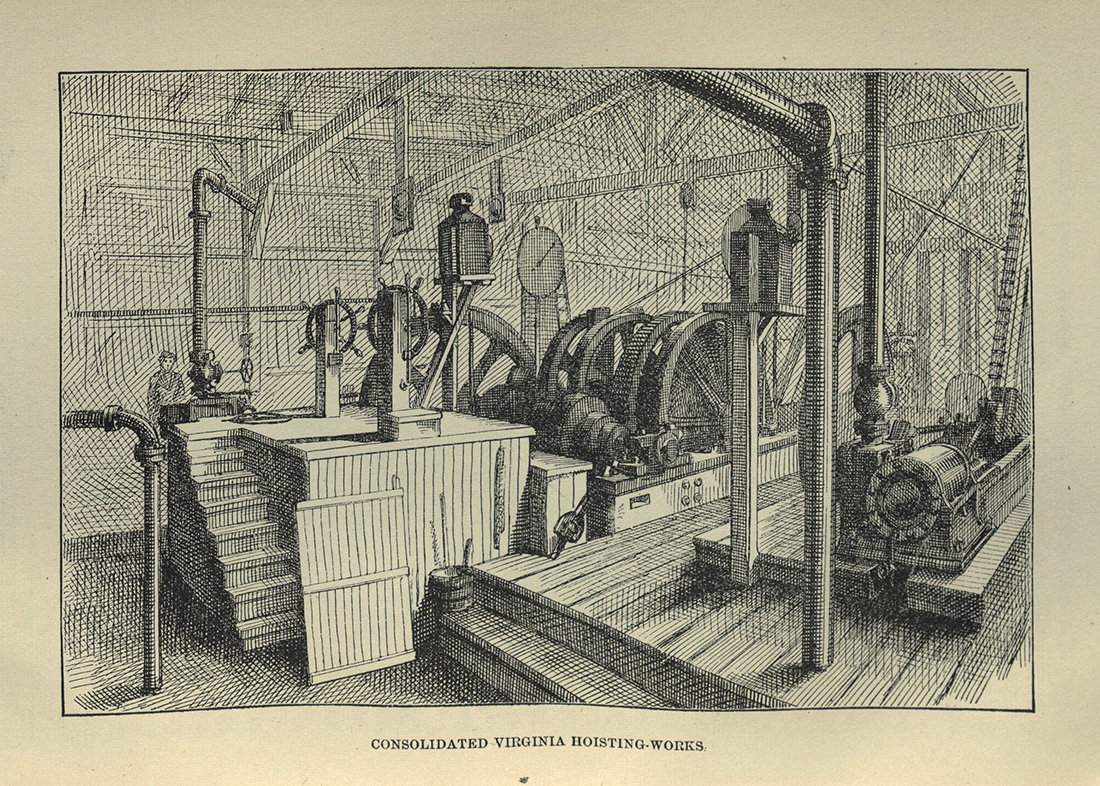
By means of this bell the engineer receives nearly all his orders. He is told when to start the cage up and when to stop, if he is to stop short of the surface; is told to hoist slowly; that there are men on board; and a great many other things which he understands as readily as the telegraph operator understands the click of his instrument.
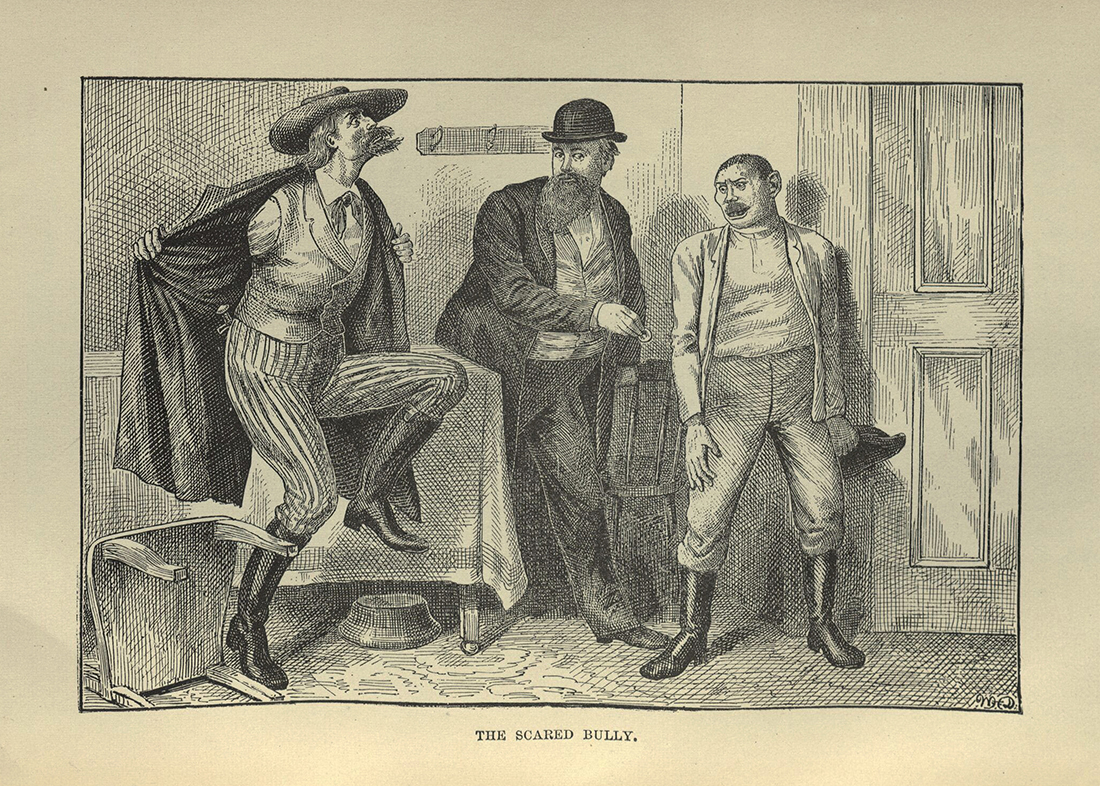
With this Carter began to wriggle from side to side in the effort to “shuck” himself of his long-tailed black coat he always wore, and in so doing he displayed on one side that famous old white-handles, sixteen-inch bowie knife, his constant companion, and on the other the but of a navy revolver.
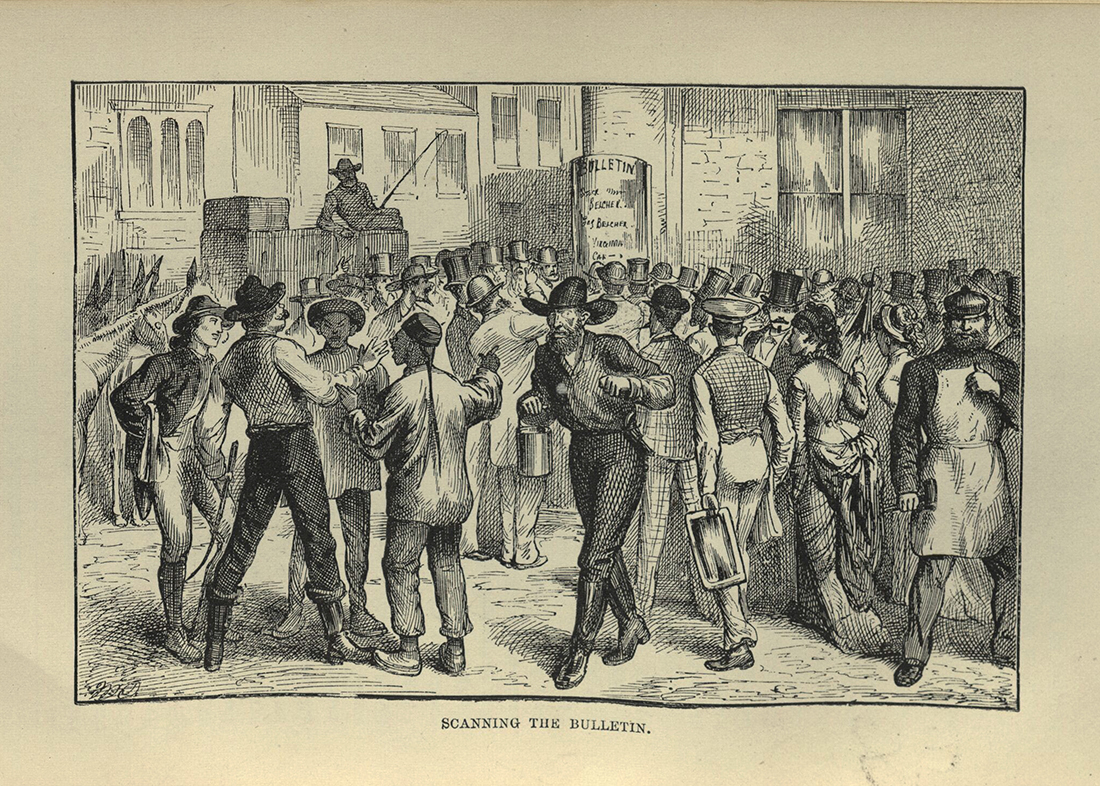
… as soon as the Stock Board is in session and business begins, reports of the sales begin to arrive in Virginia City and are placed in the windows or on the bulletin-boards of the various stock-brokers of the town, where all interested may see them. Therefore during a big stock excitement the bulletin-boards are the centres about which are seen large crowds of anxious dealers – and nearly everybody in the city dabbles more or less in stocks, women as well as men.
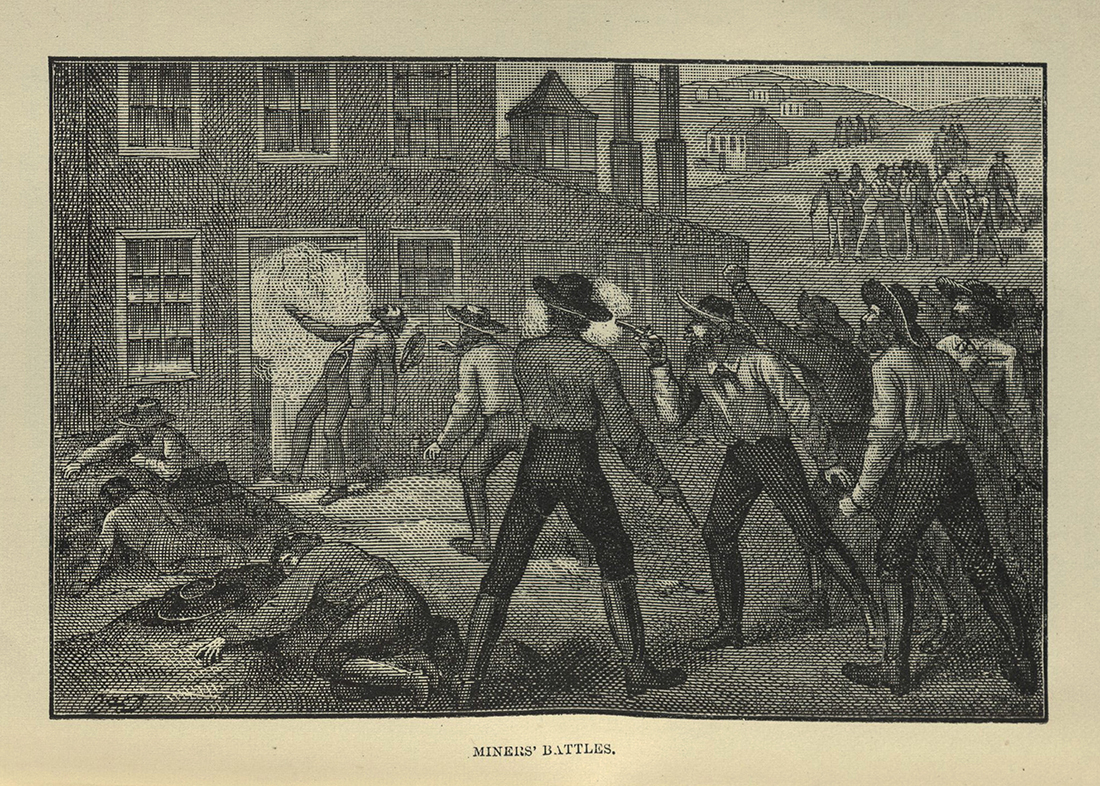
The last mining fight, of any importance, on the Comstock lode, occurred at the Justice mine on the evening of Saturday, October 3, 1874, which resulted in the death of five men in about as many minutes.
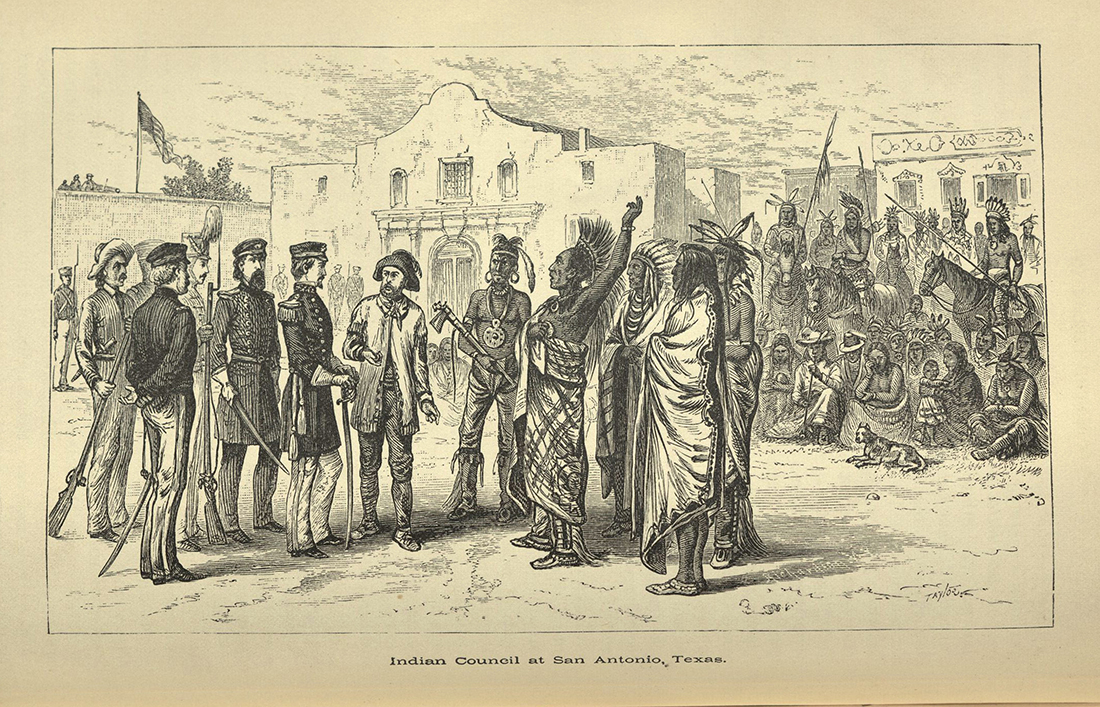
General Johnston told them of the great advantages of peace, and that the Texans wished to be friendly with them; to which they replied that they wished also for peace. General Johnston told them that, if they were better acquainted with the white people, they might like them better; and that, if they desired it, trading-posts would be established in their country. Essowakkenny rose, and said that the Comanches had noticed that trading-posts always seemed to frighten the buffalo away, so that they did not want any in their country; but that they did not object to a line of posts along the border of their country – drawing an imaginary line with his hand, so as to indicate a distance of about three miles from San Antonio.
THE LIFE OF GENERAL ALBERT SYDNEY JOHNSTON ...
William Preston Johnston (1831-1899)
New York: D. Appleton & Company, 1878
First edition
E467.1 J73 J7
Albert Sydney Johnston was born in Kentucky in 1803. He attended military school at West Point, graduating in 1826. He served in the Black Hawk War in Illinois as a regimental adjutant.
In need of distraction after the death of his wife he heard Stephen F. Austin deliver an address in Louisville in 1836 imploring aid for Texas. Johnston resigned from the U.S. Army in 1834 and joined the Texian army in 1835 as a private. He was immediately made adjutant-general and then offered full field command. He became Secretary of War under Mirabeau B. Lamar and led the 1st Texas Rifle Regiment in the Mexican War in 1837, seeing action at Monterrey. He led an expedition against the Cherokee in East Texas in 1839. That same year, he submitted to the congress of the Republic of Texas a plan of defense which would protect its western frontier.
He then became a regular officer in the U.S. Army, serving on the Texas frontier and leading an expedition against the Mormons in 1857, peacefully removing Brigham Young as governor of Utah Territory. He commanded the Dept. of Utah in 1858 and 1860.
When the Civil War broke out Johnson was offered a position as head of the Union armies. When Texas seceded, however, Johnston resigned from the U.S. Army in 1861 and commanded the Western Department of the Confederacy. He was killed at Shiloh in 1862. When Johnston’s remains arrived at the docks in Galveston, federal occupation troops prevented planned solemnities. Still, nearly the entire populations of Galveston, Houston, and Austin lined the road for miles in silence, daring the troops to act.
His son, William Preston Johnston wrote his biography, contributing anecdotes that only a son could. The work is an early defense of the administration of Texas President Lamar, presenting a sound case for the policies of Lamar, particularly in regard to military and Indian affairs.
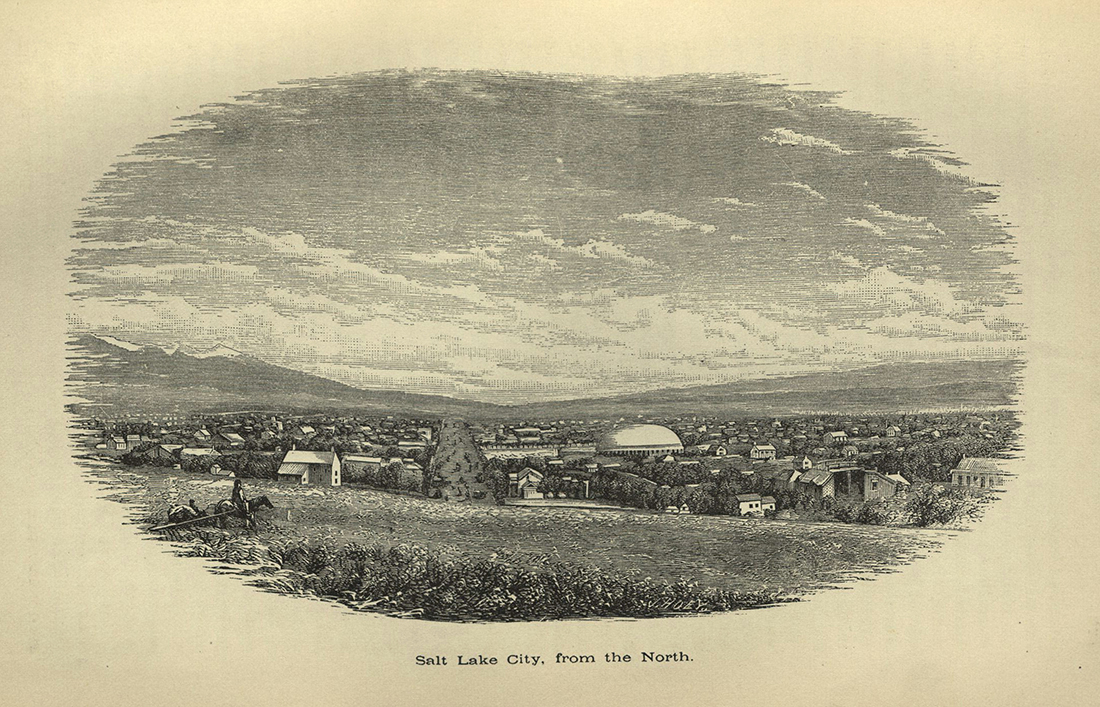
The Mormons from the origin of their sect have tried to preserve every possible analogy to the Hebrews; and this memorable migration out of Egypt to the promised land has enabled them to indulge it. Utah reproduced to their imaginations a new and enlarged type of Canaan. As they emerged from the defiles of the Rocky Mountains they beheld a vast basin, in which lay a Dead Sea, with a shoreline of 290 miles, in a frame of treeless mountains, its sullen waves lapping a snow-white beach.
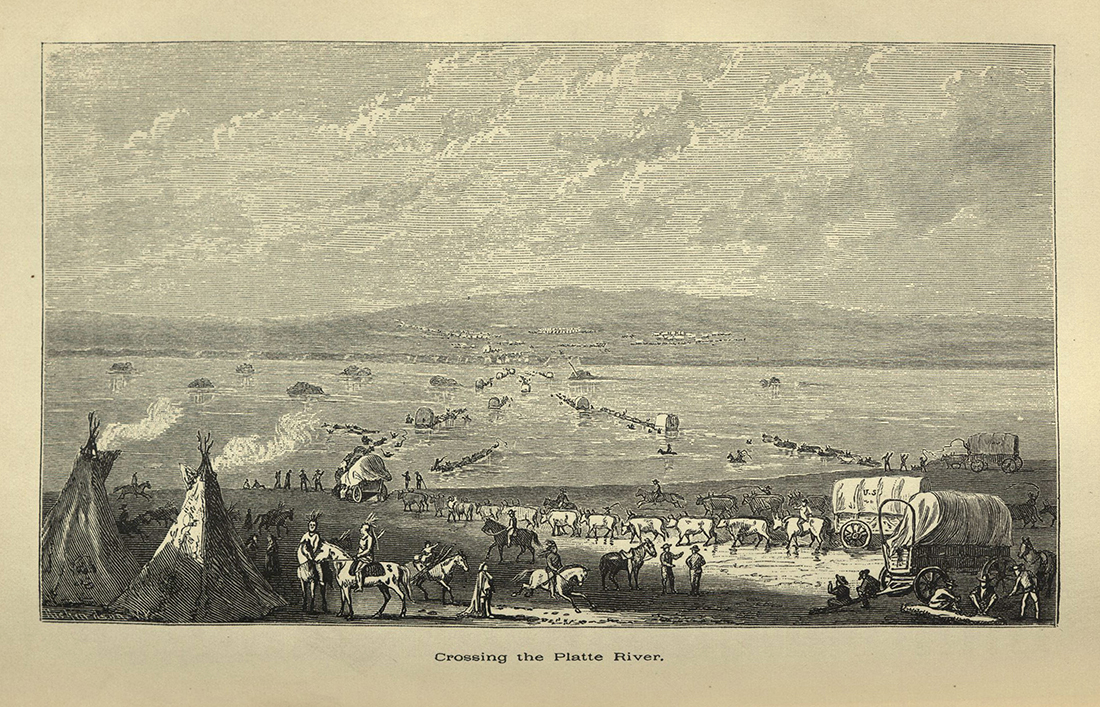
On the 29th of September, on the South Fork of the Platte, General Johnston received Captain Van Vliet’s report of his journey to Salt Lake City, which was his first authentic information that actual organized resistance by the Mormons might be expected.
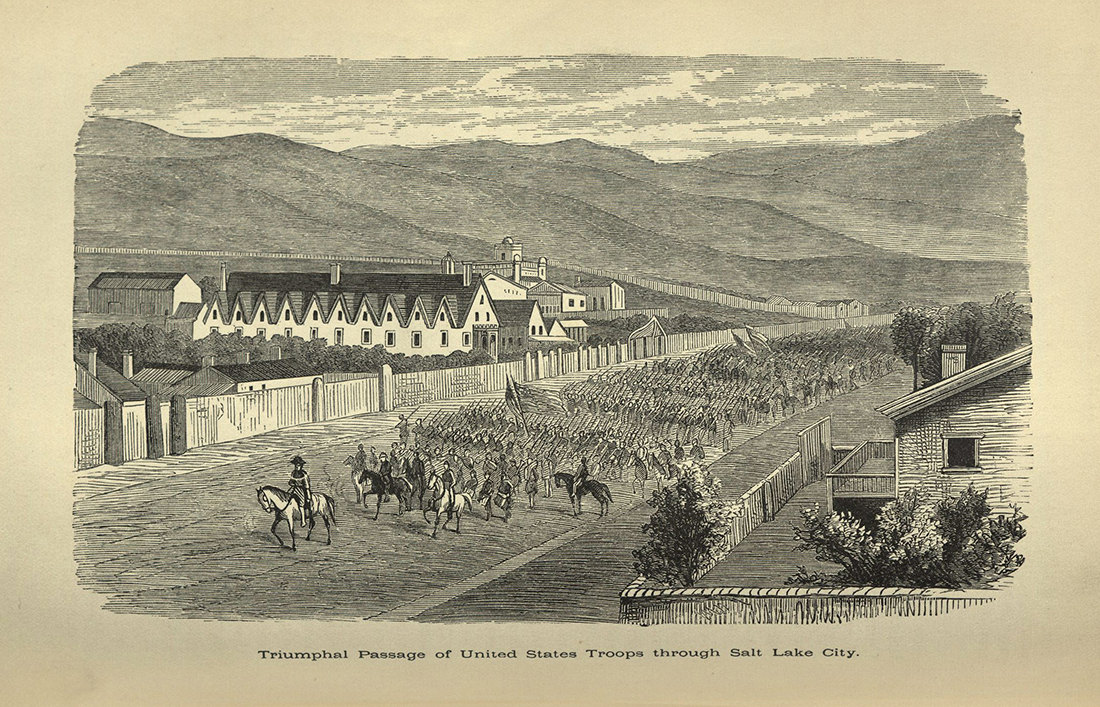
…it was evident that the Mormons ought to feel that the Federal authority extended everywhere; and, therefore, General Johnston marched his command in perfect order through the chief streets of the sacred city.
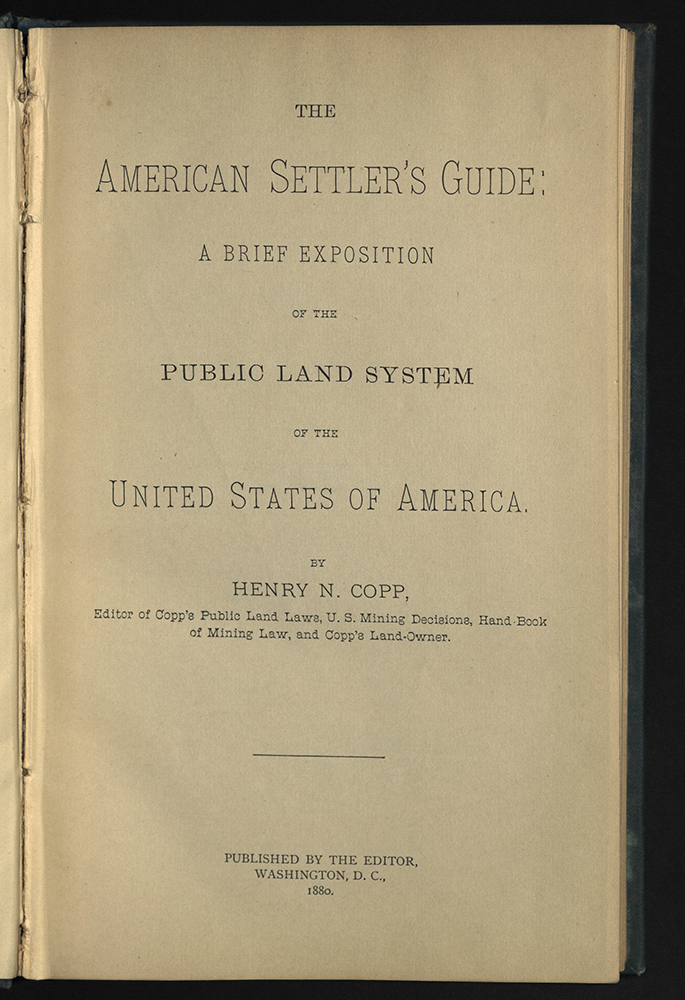
To the people of Europe, where the high price of real estate confers distinction upon its owner, it seems almost beyond belief that the United States should give away one hundred and sixty acres of land for nothing. Yet such is the fact; a compliance with the Homestead Law, and the payment of small fees and commissions to the local officers, secure title to a quarter-section of Government land. Laborers in other countries, who find it difficult to support their families, can here acquire wealth, social privileges, and political honors, by a few years of intelligent industry and patient frugality.
…
Timber Culture
The object of the timber culture law is to promote the growth of timber by providing a method of acquiring title to public lands on condition that timber shall be grown thereon to an extent and for a period of time therein specified. The wisdom of this law is seen in the increased annual rainfall in regions heretofore subject to frequent droughts.
…
Who may apply and for what kind of land.
Any person who is the head of a family, or who has arrived at the age of twenty-one years, and is a citizen of the United States, or who has filed his declaration of intention to become such, as required by the naturalization laws of the United States, may make a timber culture entry without regard to how much land he already owns.
A single woman, duly qualified, who has made an entry under the timber culture act, and subsequently marries, is not thereby debarred from acquiring title to the lands(s).
THE AMERICAN SETTLER'S GUIDE
Henry N. Copp (1843-1912)
Washington: H. N. Copp, 1880
HD221 C66 1880
This is a comprehensive ‘how-to’ for the Western settler, explaining the public land system of the United States. According to Henry Copp, a Washington, D.C. land attorney, this guide “is a popular exposition of the public land system of the United States, especially the homestead, pre-emption, and timber culture laws, and is intended to promote migration from the crowded East to the public land States and Territories South and West.” Copp presented the Homestead Act of 1862 as United States legislation that made the country a true land of opportunity.
He detailed gaining American citizenship, finding and claiming a plot of land, and entering a claim to obtain government relief for the now-familiar crop-devastating grasshopper infestations.
As amendments were made to the Homestead Act, and conditions changed, Copp published new editions of this guide to keep would-be homesteaders abreast of those changes. Nineteen editions of the amended work were published before 1892.
Bound in the original blue buckram cover with gold tooling. A Henry N. Copp card is glued to the front flyleaf, and an original prospectus is inserted.
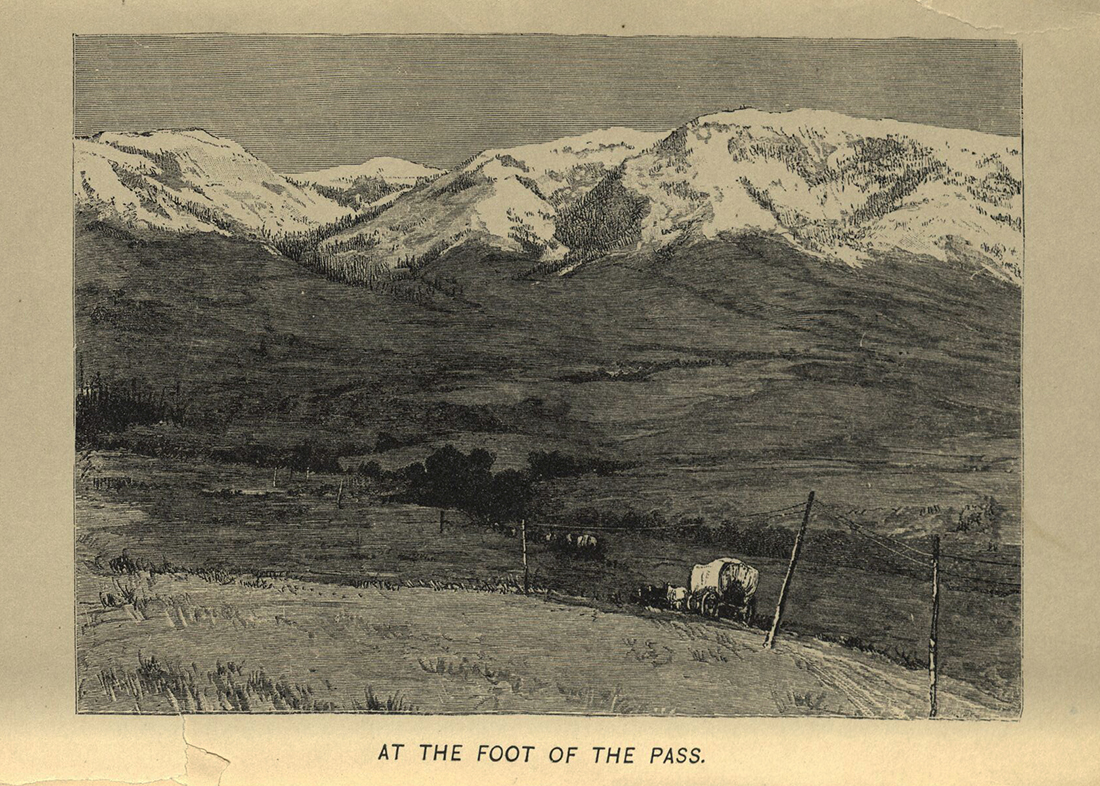
Their movement had the absolute conviction, the devotedness, of a crusade. They pressed onward, across the Great South Park, following its white wagon-trails which rise and sink with the long swells of that archaean sea; pausing in the dreary valley at the foot of the pass, which shelters the caravansary-like town of Fairplay; struggling upward, in the cold light of early morning, along the mountain sides; resting again at the last stage-station above the timber-line, where the tough fir forests bend, and fail, and finally give up altogether the ascent of those bare slopes, ever whitening, to the pitiless region of lasting snow; on again into the strenuous air of the summits, following the pass as it staggers through the wild canons; dizzily winding by weary grades, down to the desolate land of promise.
THE LED-HORSE CLAIM : A ROMANCE OF A MINING CAMP
Mary Hallock Foote (1847-1938)
Boston: J. R. Osgood and Company, 1883
First edition
PS3511 O3455 L4
Mary Hallock Foote was the wife of a mining engineer. Together, they lived in mining towns in California, Colorado, and Mexico, where she continued her career as an illustrator and author. The Led-Horse Claim was her first novel. Set in a silver mine camp in Colorado, Foote writes of a raw settlement, a town constructed on the fly, full of fortune seekers, young men from everywhere and every social rank. She described Leadville as a “senseless, rootless place.” Illustrated by the author with five plates.
There is nothing so skillful in its own defense as imperious pride. It has an ingenious system of its own, of reprisals, -- a system so ingenious that the defeat must be sore indeed, after which it cannot still find some booty to bring off? And even greater than this ingenuity at reprisals is its capacity for self-deception. In this regard, it outdoes vanity a thousand-fold. Wounded vanity knows when it is mortally hurt; and limps off the field, piteous, all disguises thrown away. But pride carries its banner to the last…Such pride as this has led many a forlorn hope, on the earth, when all other motives have died out of men’s breasts; has won many a crown, which has not been called by its true name.
RAMONA : A STORY
Helen Hunt Jackson (1830-1885)
Boston: Roberts Brothers, 1884
First edition
PS2107 R2 1884
The first novel set in Southern California, Helen Hunt Jackson’s Ramona was a landmark for the cause of justice for Indian tribes. In 1881, Jackson had published a well-researched exposé on the mistreatment of Native Americans by the United States government. The book did not initiate the reforms she hoped for. She wrote of Ramona, “I am going to write a novel, in which will be set forth some Indian experiences in a way to move people’s hearts.” The story of a half Irish, half Native American orphan and her lover, Hunter incorporated her research on Southern California locals reflecting her own experiences, adding names, events, and specific occurrences that she had witnessed. Much of Ramona was taken from real events. Hunt created the first characters in what became a long line of heroic persons who populated later Southern California fiction.
As in the instant of drowning, men are said to review in a second the whole course of their lives, so in this supreme moment of Alessandro’s love there flashed through his mind vivid pictures of every word and act of Ramona’s since he first knew her. He recollected the tone in which she had said, and the surprise with which he heard her say it, at the time of Felipe’s fall, ‘You are Allesandro, are you not?’…He recalled her tender distress because the shearers had had no dinner; the evident terribleness to her of a person going one whole day without food.
Jackson called Ramona a “sugar-coating of the pill” when it came to her goal of policy reform regarding Native American peoples. She hoped that her novel would have a sociopolitical effect like Harriet Beecher Stowe’s Uncle Tom’s Cabin had had on the institution of slavery. Publicists with connections to eastern Protestant churches which promoted reform of policies regarding Native Americans capitalized on the interest caused by Hunt’s novel in its exposure of past and current American duplicity and corruption in its dealings with the Indians.
Born in Amherst, Massachusetts the same year that Emily Dickinson was born, Hunt was orphaned at sixteen. In 1852 she married an Army officer and traveled with him from fort to fort, until he drowned. With the help of Dickinson and Dickinson’s friend, Thomas Wentworth Higginson, Hunt began to write.
In 1874, she married William Sharpless Jackson in Colorado. Her new forays into the American West left her not particularly sympathetic toward Indians. The 1871 Indian Appropriations Act had made all Native Americans wards of the state, enabling removals and reservations to make way for white settlers.
In 1879, in Boston, she attended a lecture by Standing Bear, a Ponca chief. The lecture, telling of ethnic cleansing and land theft changed her viewpoint. She became an investigative reporter, which led to the publication of her A Century of Dishonor, an indictment of U.S. federal Indian policy. She sent a copy to every member of Congress.
Ramona became an immediate best-seller and remains in print today. At least five movie versions of it have been made. Ramona, with its romantic element, and as popular as it was, did little to create public enthusiasm for reform. Instead, it boosted a European yearning for California as a pastoral paradise, warm and still full of old-world charm.
And the delicious, languid, semi-tropic summer came hovering over the valley. The apricots turned golden, the peaches glowed, the grapes filled and hardened, like opaque emeralds hung thick under the canopied vines. The garden was a shade brown, and the roses had all fallen; but there were lilies, and orange-blossoms, and poppies, and carnations, and geraniums in the pots…It was like an enchanter’s spell…
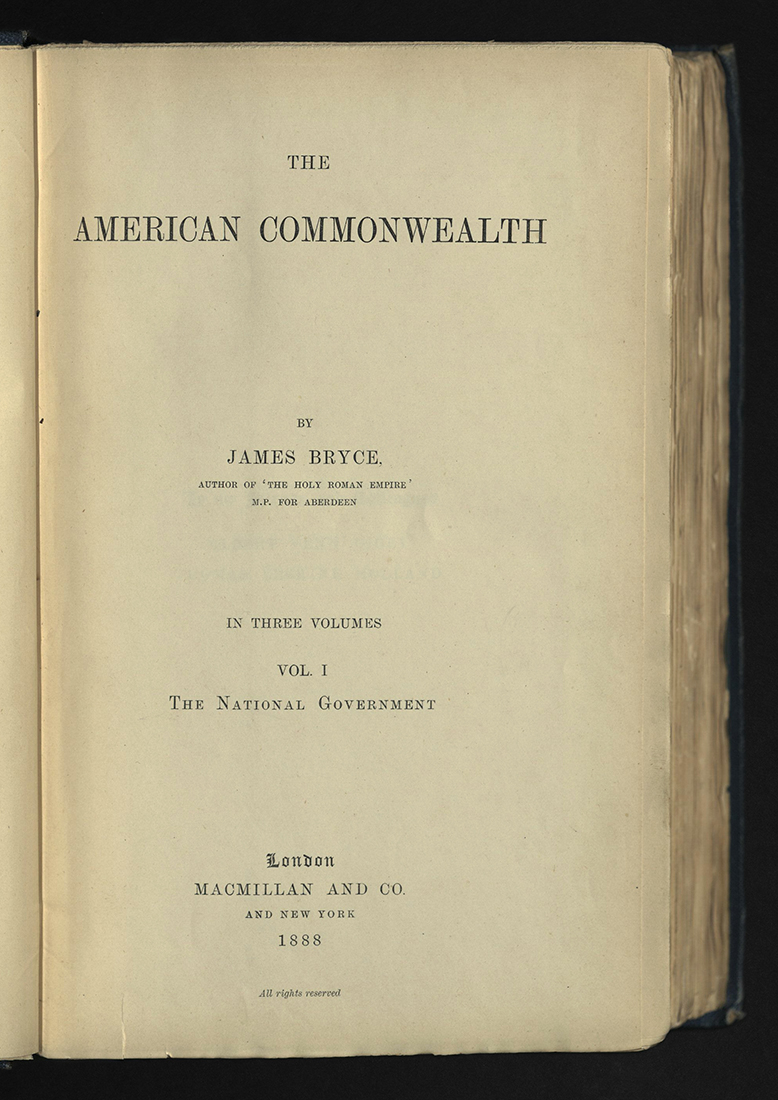
THE AMERICAN COMMONWEALTH
James Bryce (1838-1922)
London and New York: Macmillan and Co., 1888
First American edition
JK246 B9 1888
From 1907 to 1913, Scotsman James Bryce served as British ambassador to the United States. In this capacity, he examined “the institutions and the people of America as they are,” presenting his findings in The American Commonwealth, first published in London in three volumes in 1888.
Bryce, a noted scholar and author of The Holy Roman Empire, a bestselling book based on a school essay, wrote of the political, social, and economic distinctions of what he called “the nation of the future.” The three-volume work dealt with the federal government branches (executive, legislative, and judiciary), surveying the powers and limitations of each, and the relationship between these and the state governments. Bryce then discussed state governments. He discussed political machinery and the party system, giving a history of their origins and growth. Next, he discussed public opinion, its nature and tendencies. Bryce concluded with a discussion of the nation’s strengths and weaknesses as an example of a democratic state. “Democracy really means nothing more or less than the rule of the whole people expressing their sovereign will by their votes,” he wrote. He continued with an overview of society and citizens – the intellectual and spiritual forces guiding generations of Americans and future generations. Bryce devoted a chapter to “The Temper of the West,” writing,
... why in heaven’s name the haste? You have time enough. No enemy threatens you. Ages and ages lie before you. Why sacrifice the present to the future, fancying that you will be happier when your fields teem with wealth and your cities with people? In Europe we have cities wealthier and more populous than yours, and we are not happy. You dream of your posterity; but your posterity will look back to yours as the golden age, and envy those who first burst into this silent splendid Nature, who first lifted up their axes upon these tall trees and lined these waters with busy wharves. Why then complete in a few decades what the other nations of the world took thousands of years over the older continents? Why in your hurry to subdue and utilize Nature, squander her splendid gifts?
Bryce’s writing is lucid and fluent, easily read and understood by the lay reader. As such, The American Commonwealth was much admired by its American readership.
Rare Books copy is uncut and accompanied by an undated letter from James Bryce to Reverend J. Carvell Williams declining an invitation to contribute to a work being put together by a “Committee”
Rare Books copy is a gift from Dr. Ronald Rubin.
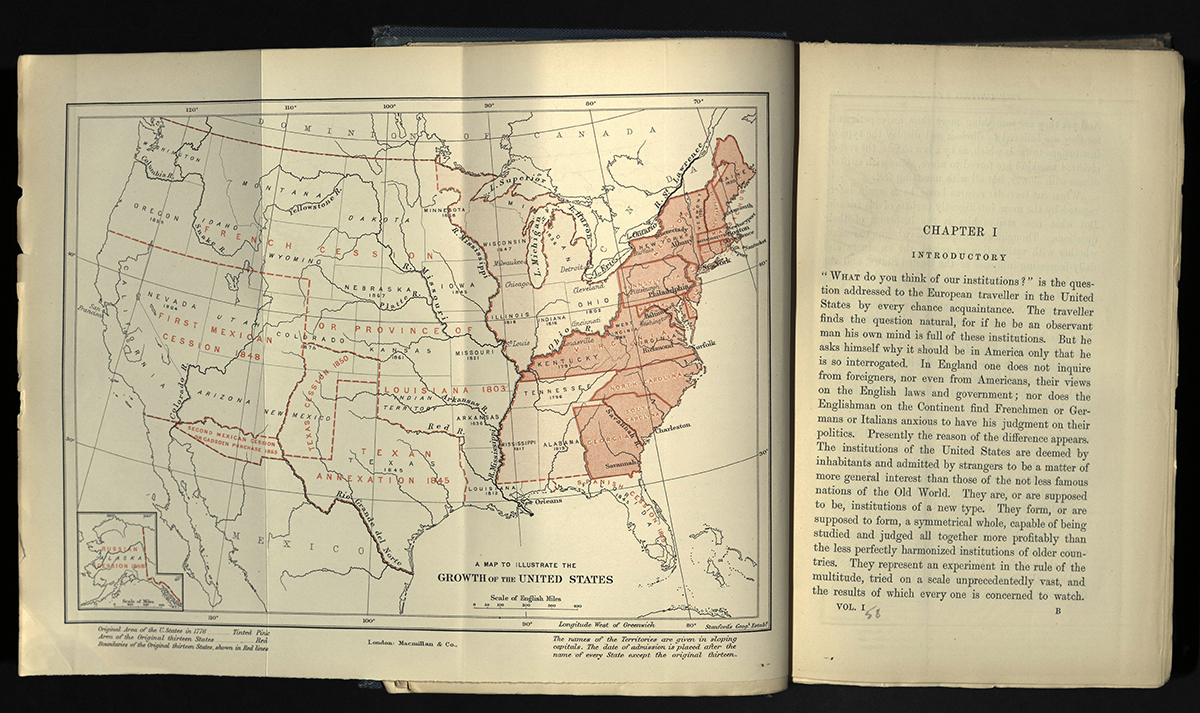
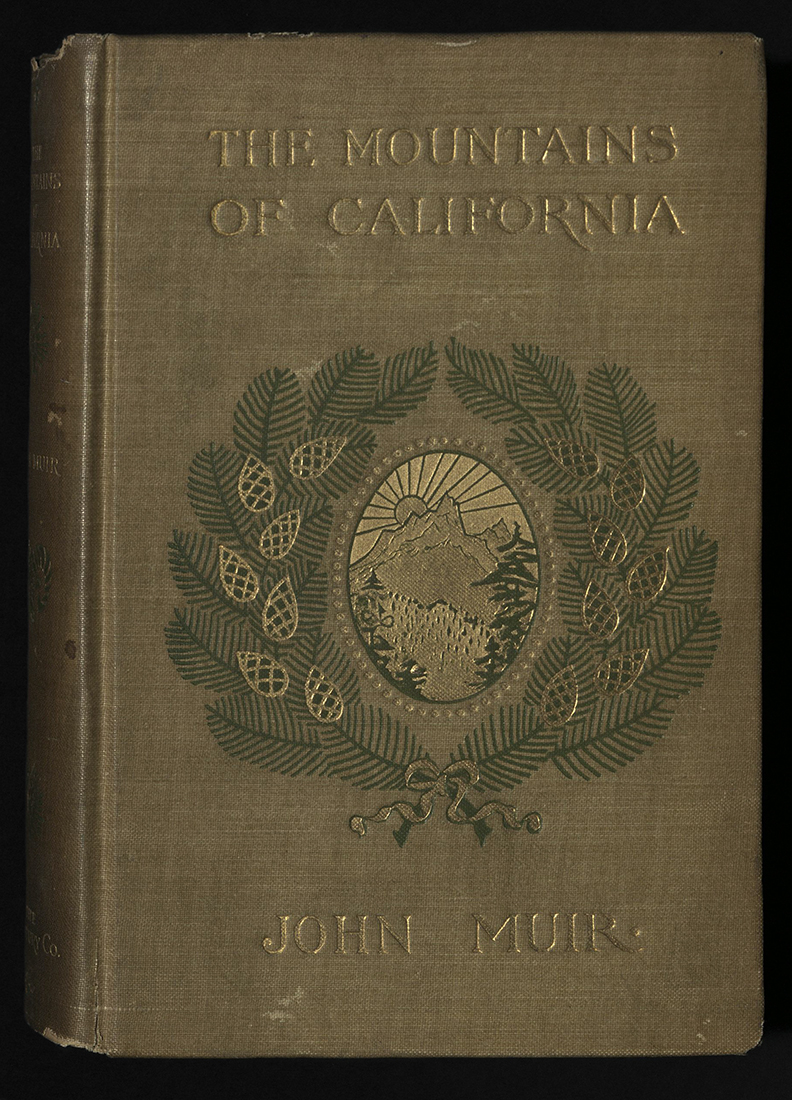
THE MOUNTAINS OF CALIFORNIA
John Muir (1838-1914)
New York: Century Co., 1894
First edition, first state
F866 M95 1894
Born in Scotland, John Muir arrived in Wisconsin as a boy. With the rest of his family, he worked beside his father, converting wilderness into farmland. Muir’s family, like most others, viewed the land as frontier, ready for their exploitation. He studied at the University of Wisconsin, where two factors -- transcendentalism (he would later stress the spiritual manifestation of a loving God in the wilderness) and science -- changed Muir’s view of the American landscape.
He spent his next years as a botanist in Canada, the Midwest, and the southeastern United States. He went to California in 1868 and studied the Yosemite Valley for nearly six years. From there he went to Nevada, Utah, and Colorado, but returned to California in 1880, making the state his home.
He became the first writer to make a close study of the land he visited as he developed a post-frontier philosophy. The Mountains of California, Muir’s first book, is his tribute to the Sierras in which he recounted his journeys by foot through glaciers, forests, and valley, and gave the geological history of the region, including patterns of tree growth, and the life of animals and insects. He lambasted current land usage, such as the grazing of sheep and its destruction of vegetation in the Sierra Nevada.
The book is made up of previously published (1875-1882) magazine and newspaper articles, assembled and edited by Muir. He prefaced the collection with a lyric portrait of the Sierra Nevada. The San Francisco Call’s review declared that “no man since Thoreau ever had a keener sympathy with nature, a quicker vision of her mysteries, or a surer speech for their interpretation.” A 1895 review in the Overland Monthly endorsed it: “The book should not only be in every school library in California, but it should be in every home within the entire range of the grand old Sierra Nevada.” Charles Lummis wrote in the July 1895 issue of The Land of Sunshine, “People everywhere of brains and heart will read this book and love its author.” Muir wrote with passion, awe and respect for his physical surroundings, and was driven by a desire for its preservation.
His writings were among the principal nineteenth-century texts that convinced Americans, most especially those living in eastern cities, of the need to set aside lands in the West as wilderness. He was the founding president of the Sierra Club and is credited with alerting the American people for the need to protect the country’s natural wonders. For all his appreciation for the land and its pre-settlement beauty, he took little notice of Native Americans and their early and long existence on what he viewed as pristine wilderness.
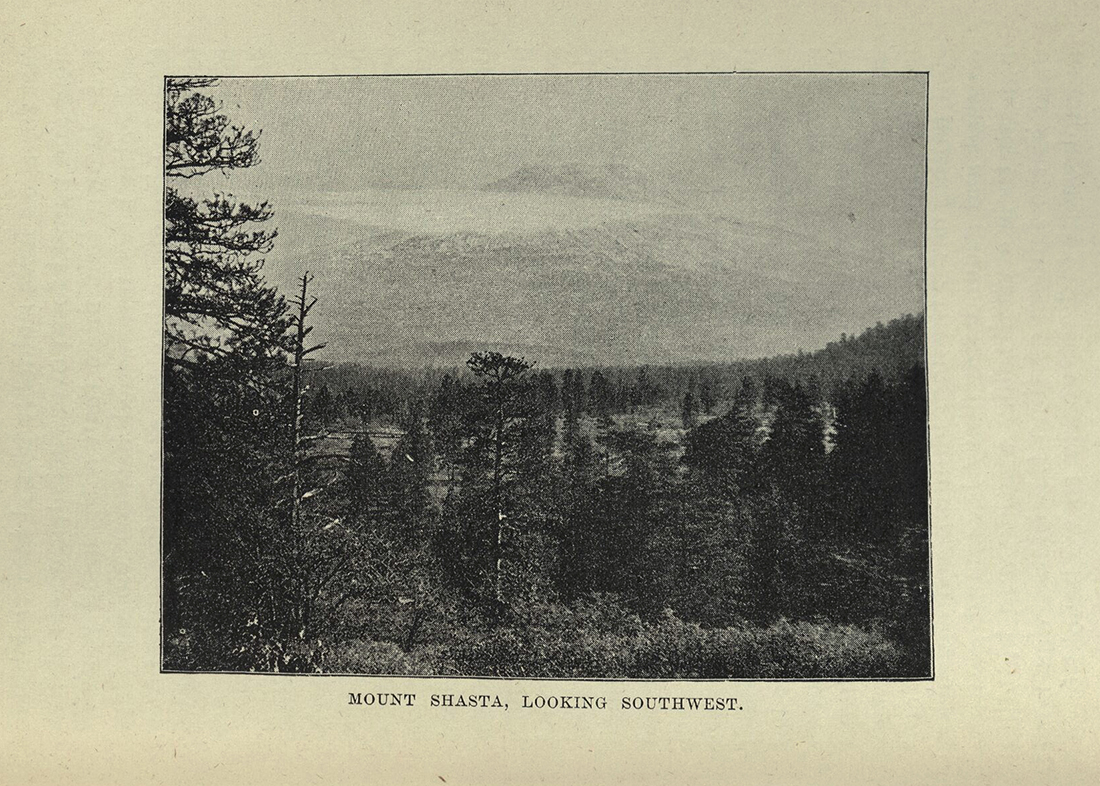
Not in one great convulsion was Shasta given birth.
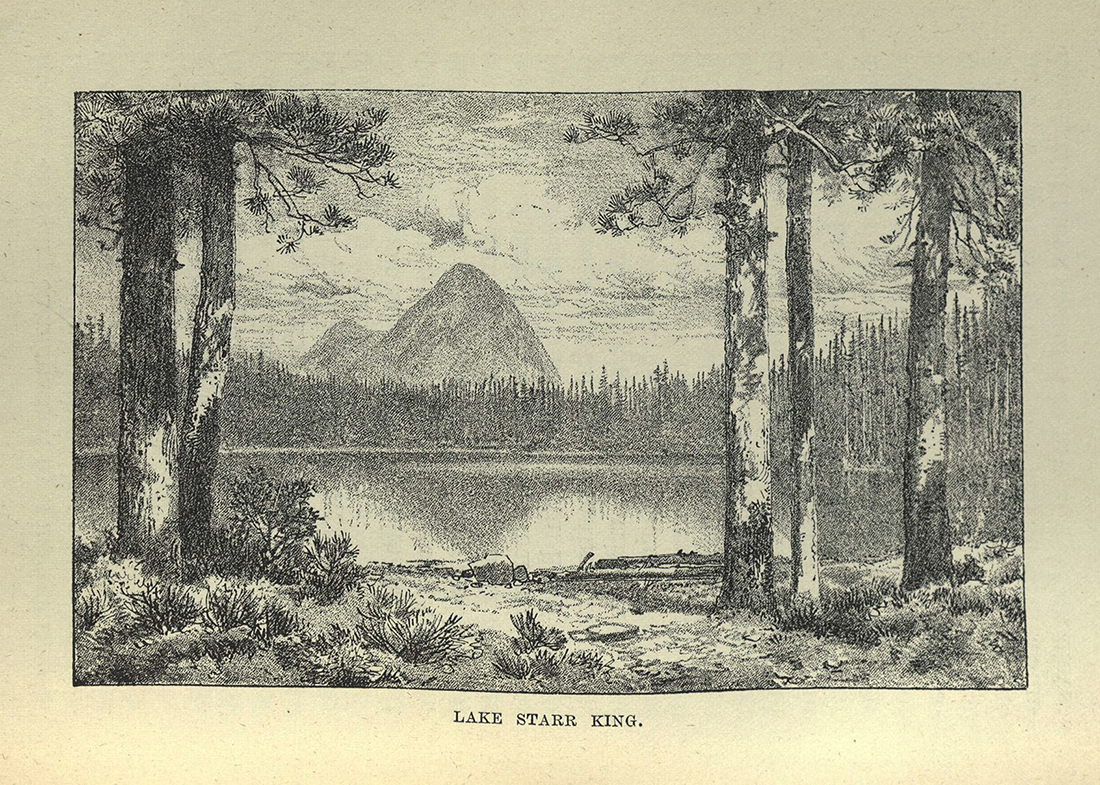
A beautiful variety of the bench-top lakes occurs just where the great lateral moraines of the main glaciers have been shoved forward in outswelling concentric rings by small residual tributary glaciers.
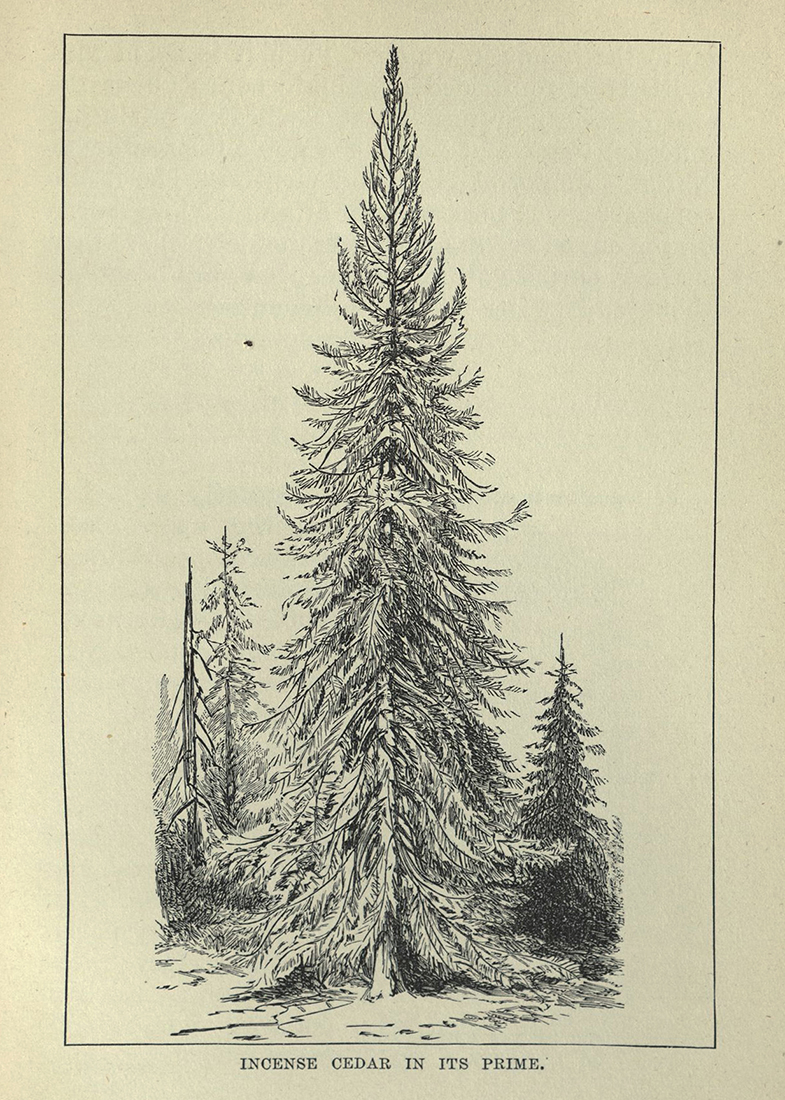
The bark is brown, of a singularly rich tone very attractive to artists, and the foliage is tinted with a warmer yellow than that of any other evergreen in the woods.
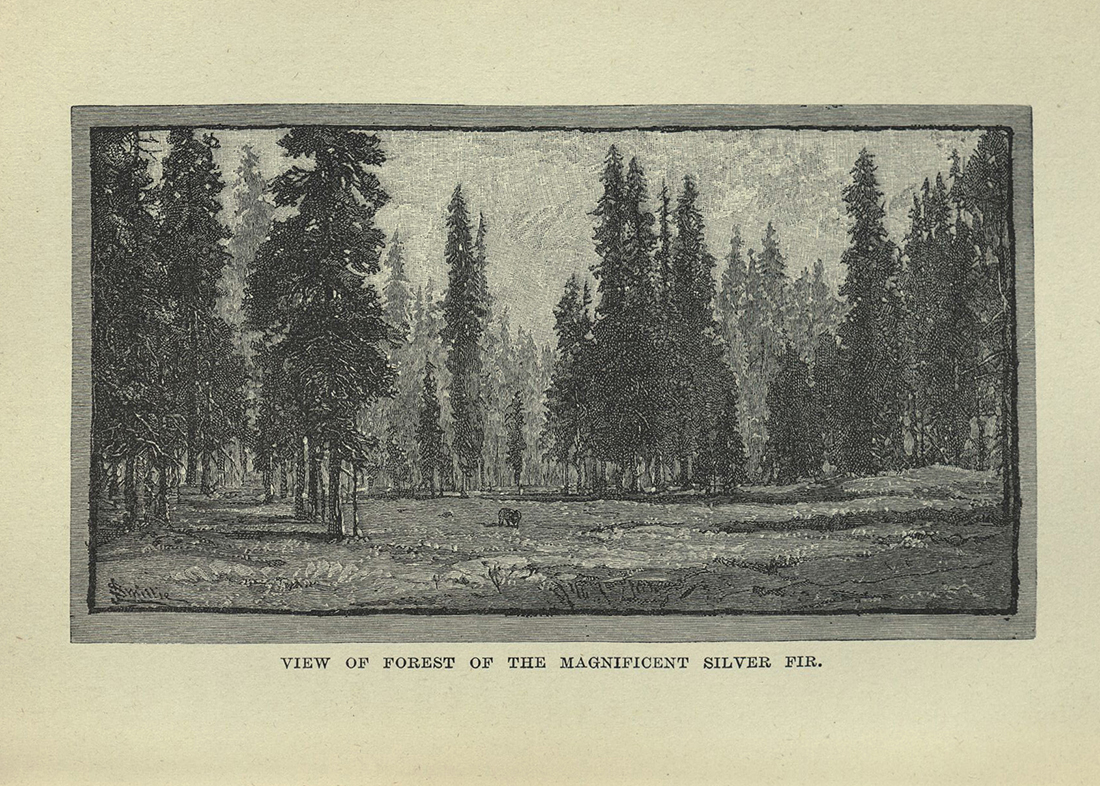
How admirable the forest-work of Nature is then seen to be, as one makes his way up through the midst of the broad, fronded branches, all arranged in exquisite order around the trunk, like the whorled leaves of lilies, and each branch and branchlet about as strictly pinnate as the most symmetrical fern-frond.
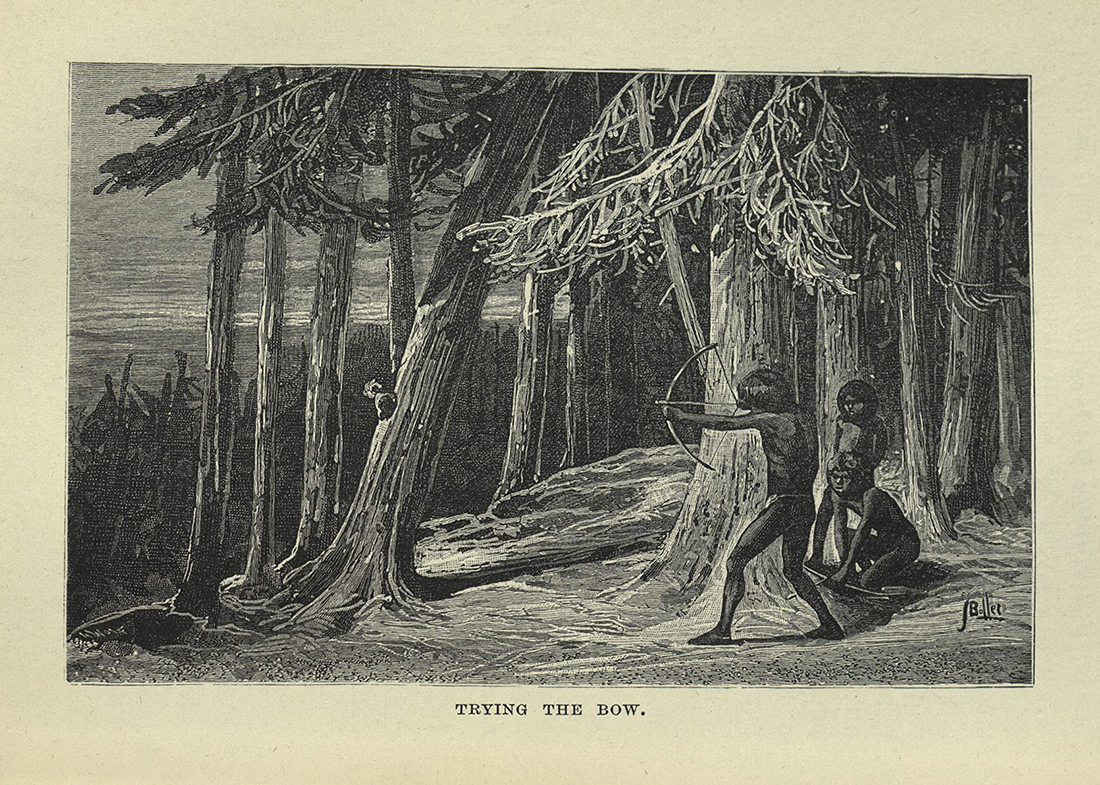
Indian boys, however, lie in wait with unbounded patience to shoot them with arrows.
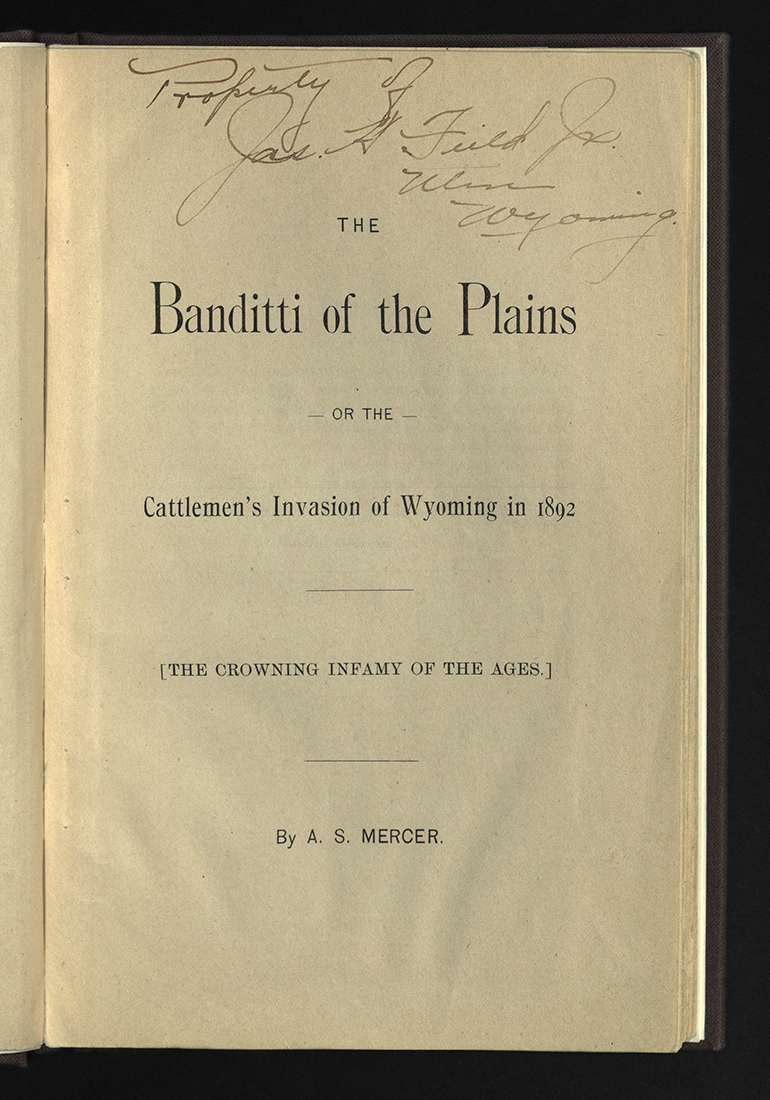
THE BANDITTI OF THE PLAINS ...
Asa Shinn Mercer (1839-1917)
Cheyenne, WY: privately published, 1894
First edition
F761 M557
The Banditti chronicles one of the last instances of frontier violence in the wars for the open range against fencing by homesteaders. Asa Mercer’s sympathies, made clear in this book, were not with Wyoming cattlemen. He objected to the manner in which large ranch owners were importing paid killers to exterminate other citizens of the region.
Immediately after the printing of this book, Wyoming cattlemen objected to the way they were characterized and filed a libel suit against the release of it. Presumably, the entire print run was impounded and ordered destroyed. While the book was in the custody of the court, copies were stolen and smuggled to Denver, outside the court’s jurisdiction. The books had not yet been bound when they were confiscated and were later bound in Denver. The bindery was burned, causing water damage to most copies. For years afterwards, members of the Wyoming Stock Growers’ Association, their sympathizers and descendants destroyed any copy they came across.
Mercer, who later helped establish the University of Washington, became involved with the Johnson County Range War when he switched his alliance from the stock growers, with whom he had worked as a publicist, to the homesteaders. As a newspaper editor at the time, he wrote The Banditti just after the Johnson County Range War. The Cheyenne Sun called the book in its August 22, 1894 issue “careless and reckless.” The Denver Daily News, two days earlier, wrote that “The book is written in a free, flowing journalistic style, but with a pen dipped in gall. It does not mince words.” Mercer’s vitriolic denunciation of the Wyoming Stock Growers Association members became the stuff of legend.
The fate of the book is another legend. In one instance, New Hampshire-born, Princeton graduate and novelist Philip Asthon Rollins claimed that when the books were shipped to Denver they were deliberately hosed down in an effort to destroy them. In a letter Rollins wrote, “several hundred of the books found themselves one night in a wagon drawn by galloping horses and headed for the Colorado line. The marks on the back of the last flyleaf represent in part, I am told, the doings of the fire hose that was called into play for a few moments.” Rollins, who lived in the West on and off between 1892 and 1924, based his novels, most notably The Cowboy, on his own eye-witness accounts.
More than one historian believes that the book was printed in Denver, not Wyoming. Waste sheet wrappers from another book printed in Denver on many surviving copies suggest this was the case. Two of Mercer’s children said that the book was printed in Denver. Claims of book burning, injunctions and threats to Mercer’s life are hardly supported by any surviving evidence.
Those claims, however, have made his book famous. Whatever happened, at least forty copies out of an estimated 1000, made it out of the injunction/fire/flood stories bandied about, to survive today. Mercer’s eyewitness account of the cattleman’s invasion of Wyoming has stood the test of time. Many of his claims, angrily disputed, were justified, although historians have questioned some of his conclusions. Amidst his diatribe and distortion, stand facts. With the intention of killing alleged rustlers, a band of fifty-two cattlemen and hired gunmen, some from Texas, invaded Johnson County, Wyoming in April 1892. The vigilantes, who called themselves “Regulators,” after the South Carolina Regulators of 1767-69, fought with about 200 small ranchers and local settlers and eventually were taken into protective custody by the United States cavalry. Legal maneuvering, including the support of Republican politicians, allowed the invaders to go unpunished.
Mercer was also well-known for bring women to lonely bachelors in the northwest. In 1865, he brought forty-six marriageable women to Washington Territory. The women were known as “The Mercer Girls.”
Rare Books copy inscribed “Property of Jas. H. Field, Jr., Ulm, Wyoming” inscribed on title-page.
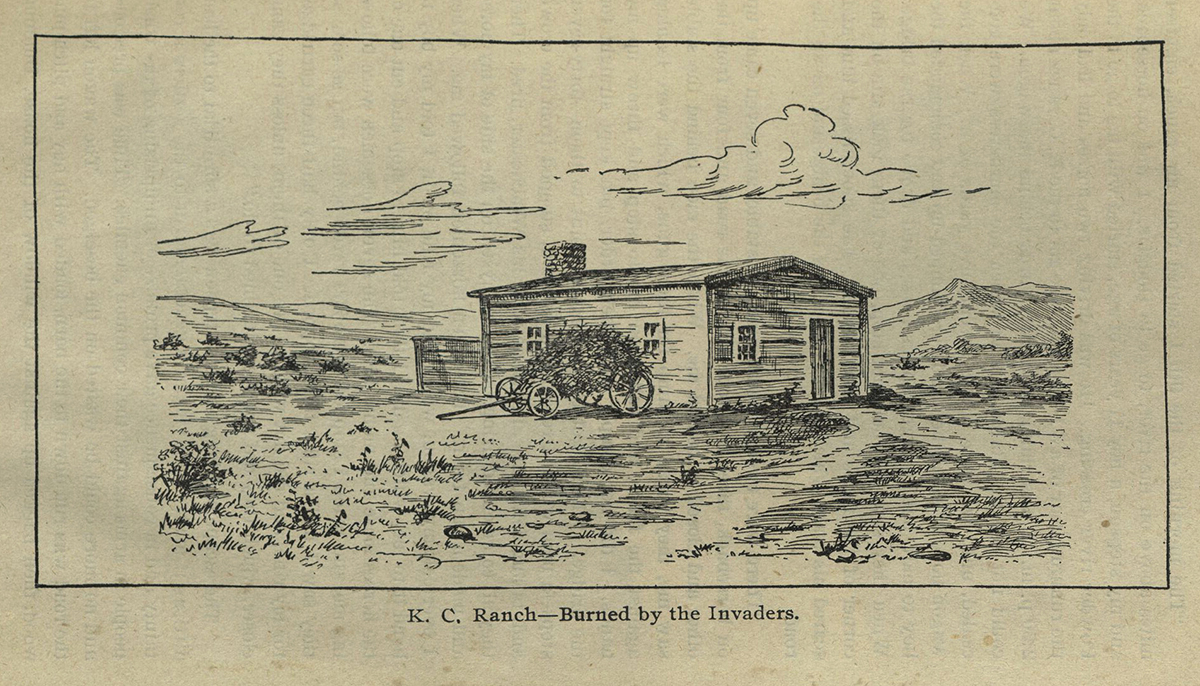
We got to the K. C. ranch about 2:30 p. m. I was riding about fifty yards behind the wagon. We could not see the stable, behind which the murderers were concealed, until we were within seventy-five yards of it.
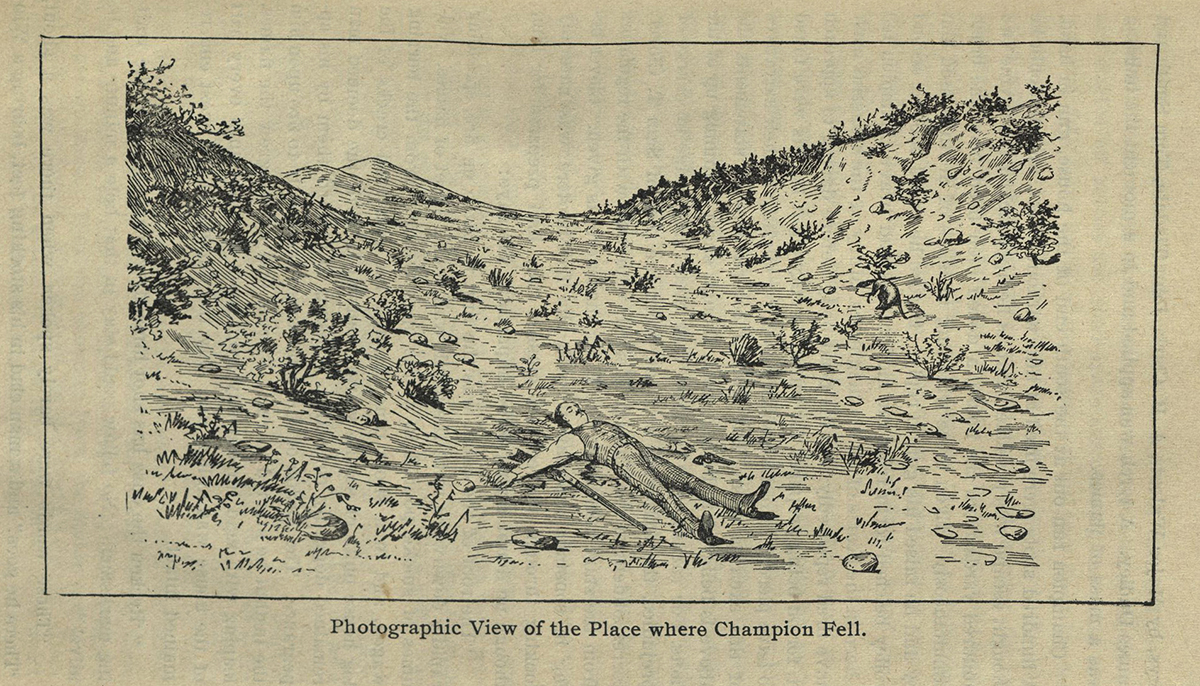
Champion ran out at the south end of the house, gun in hand. A hundred shots were fired at him without effect, and no doubt he thought escape was possible.
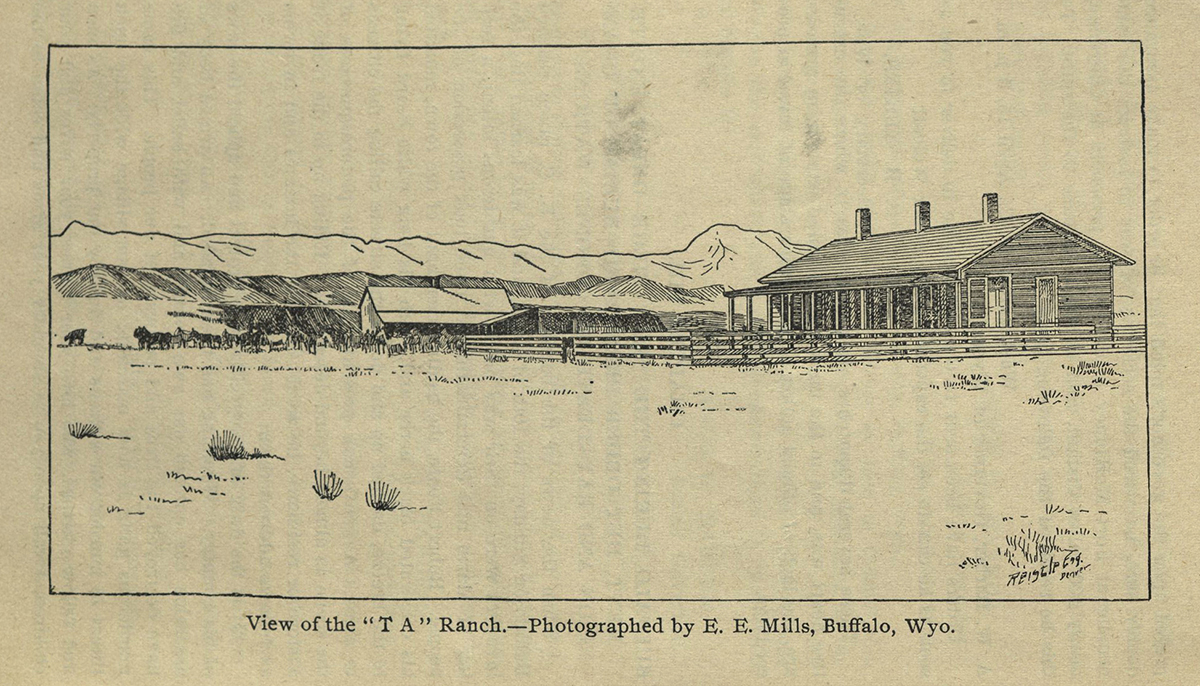
Hundreds of men were spared to surround the cattlemen at the T. A. ranch, 12 miles away, but the constant rumor set afloat by the white caps not in the fighting ranks of their friends, that large reinforcements were on the way from the north and the west, kept excitement running high in the town and seemingly made it necessary to keep up an organized force with which to meet any emergency.
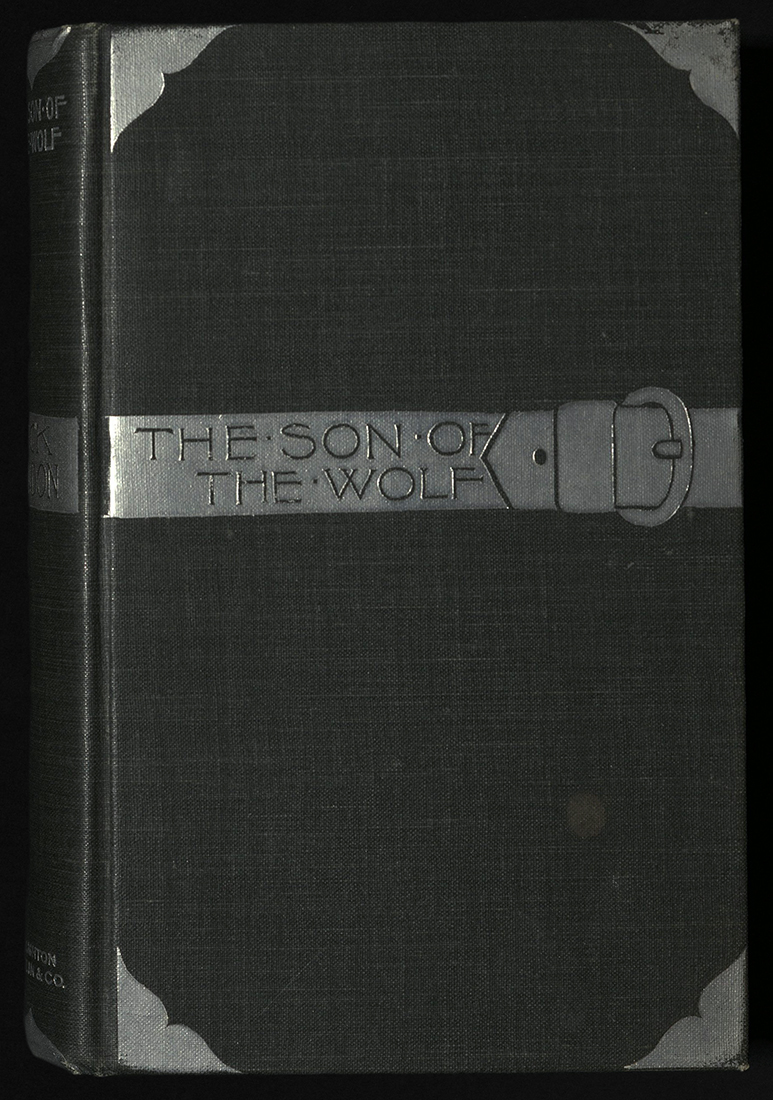
Nature has many tricks wherewith she convinces man of his finity, -- the ceaseless flow of the tides, the fury of the storm, the shock of the earthquake, the long roll of heaven’s artillery, -- but the most tremendous, the most stupefying of all, is the passive phase of the White Silence. All movement ceases, the sky clears, the heavens are as brass; the slightest whisper seems sacrilege, and man becomes timid, affrighted at the sound of his own voice.
THE SON OF THE WOLF
Jack London (1876-1916)
Boston and New York: Houghton, Mifflin and Company; Cambridge, MA: The Riverside Press, 1900
First edition, first issue
PS3523 O46 S6 1900
In 1897 Jack London joined the gold rush to the Yukon, where he made an unsuccessful attempt at mining. While there, he met the men who became prototypes for the hard-living heroes in his stories and novels. Stricken with scurvy, London returned to Oakland, California the following year and began writing his adventures. These tales appeared in the Overland Monthly and the Atlantic Monthly. The Son of the Wolf is his first collection of the stories.
Giving expression to the romance of the frontier, the stories about the brutal life of the Yukon brought him national fame. The first printing, released on March 21, 1900 numbered 2028 copies. Two more printings were released the same year. London went on to publish more than fifty books.
London’s birth name was John Griffith Chaney. He was the son of Flora Wellman, daughter of a well-to-do merchant from Massillon, Ohio and William H. Chaney, from Maine, who denied his fatherhood. When John Chaney was eight months old his mother met and married John London, a disabled Union soldier from Pennsylvania, who moved first to Moscow, Idaho to take up a land claim and become sheriff, then to San Francisco, where he lived the remainder of his life, working as a carpenter. John Chaney’s name was changed to Jack London and he grew up with John London’s daughters in Oakland, believing that John London was his birth father. The family was poor. London began working when he was nine years old.
In later years, he lived on his own ranch, using his interest in science as the foundation for his farming methods. He married twice and had two daughters. He became a committed socialist, albeit with a decidedly American bent, based upon the principles of the Declaration of Independence and the Bill of Rights. He believed that anyone ready for hard work could reap its rewards.
After his death, one of his daughters began to rubber stamp his signature on first editions of his works, at the request of his publisher, in an effort to increase value. The frontispiece illustration for Son of the Wolf is by Maynard Dixon.
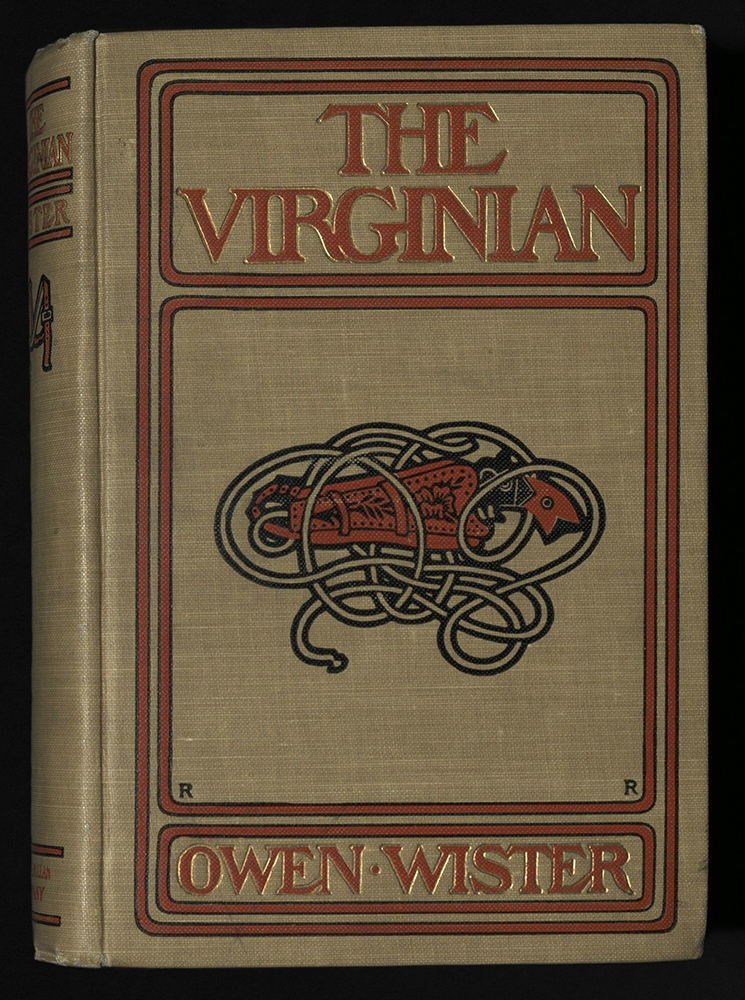
Then for the first time I noticed a man who sat on the high gate of the corral, looking on. For he now climbed down with the undulations of a tiger, smooth and easy, as if his muscles flowed beneath his skin.
THE VIRGINIAN : A HORSEMAN OF THE PLAINS
Owen Wister (1860-1938)
New York, London, Macmillan & Co., Ltd: The Macmillan Co., Ltd, 1902
First edition
PS3345 V5 1902
The Virginian immediately captured the attention of Americans, staying on top of best seller lists for months. Wister’s story of the modern-day American hero, the strong yet sensitive “horseman of the plains,” was reprinted fifteen times within the first eight months of publication and for a sixteenth time within its first year. The book was praised by Wister’s friends, including artist Frederic Remington and Theodore Roosevelt, who had suggested that Wister write the novel and to whom the novel was dedicated.
Wister was a New England-bred Harvard graduate, whose first encounter with the landscape of the American West came two years after he was graduated summa cum laude, when he was sent to a Wyoming ranch to recover from a nervous breakdown. His classmate, Theodore Roosevelt, suggested that he travel west to find needed recuperation.
Ensconced in a dramatic landscape and buoyed by physical exercise, Wister was inspired by the rugged cowboys who worked on the ranch where he stayed. He returned to the West for several summers, finding in it a reinvention as a place embodying spiritual individualism in contrast to the affectations of the morally exhausted East. This was not a new theme, but Wister furthered the myth. He wrote, “Here in flesh and blood was truth which I had long believed in words, but never met before. The creature we call a gentleman lies deep in the hearts of thousands that are born without chance to master the outward graces of the type.”
The Virginian contains the first “walkdown,” the now-iconic Main Street fast-draw pistol duel. Wister’s heroic Wyoming cowboy, never named but known only as “the Virginian,” slays the evil Trampas.
Wister based his novel on the conflict between the big cattlemen of Wyoming and the rustler element, the conflict that became known as the Johnson County Range War. The Virginian rides with a vigilante mob taken straight out of that conflict.
Wister was a friend of some of the cattle barons. His villain, Trampas, was based on a real figure, whom Wister had met. In the end, the Virginian rides off into a “land without end, a space across which Noah and Adam might have come straight from Genesis.”
The cowboy as a literary character arrived with the dime novel in the 1870s, but it was Wister’s Virginian who gave the world the horse, the girl, the gun, the villain, the hero, the sunset, all in one story, offering up a man who would, because of his moral and physical superiority abandon the cares and duties required of ordinary people: “The others had all visibly whirled the rope, some of them even shoulder high. I did not see his arm lift or move. He appeared to hold the rope down low, by his leg. But like a sudden snake I saw the noose go out its length and fall true; and the thing was done.” For the Virginian the Western sunset was not the end, but the beginning.
Illustrated with eight full-page black and white illustrations by Arthur Keller.
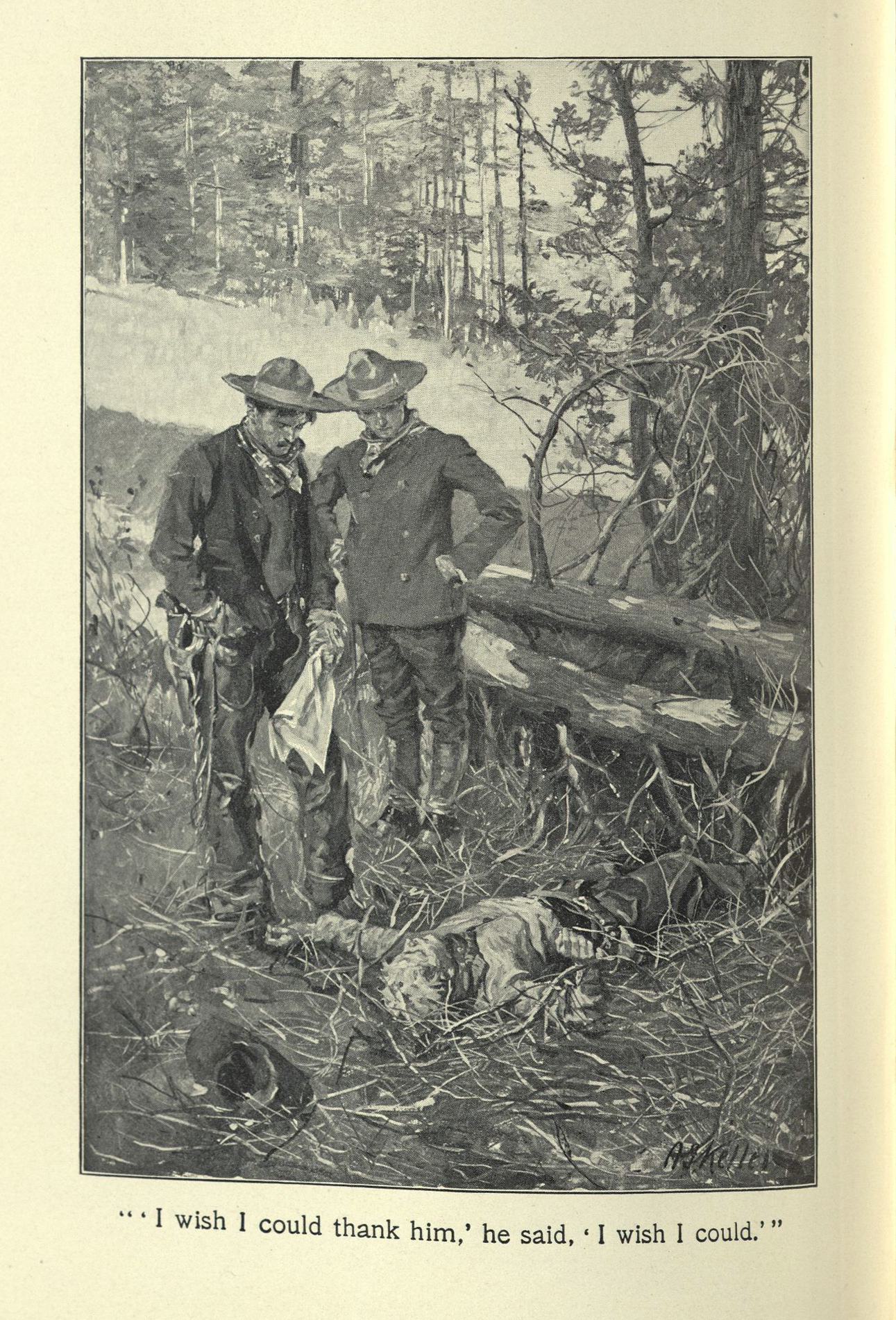
We carried Shorty over and covered him with earth, and on that laid a few pine branches; then we took up our journey, and by the end of the forenoon we had gone some distance upon our trail through the Teton Mountains. But in front of us the hoofprints ever held their stride of haste, drawing farther from us through the hours, luntil by the next afternoon somewhere we noticed they were no longer to be seen; and after that they never came upon the trail again.
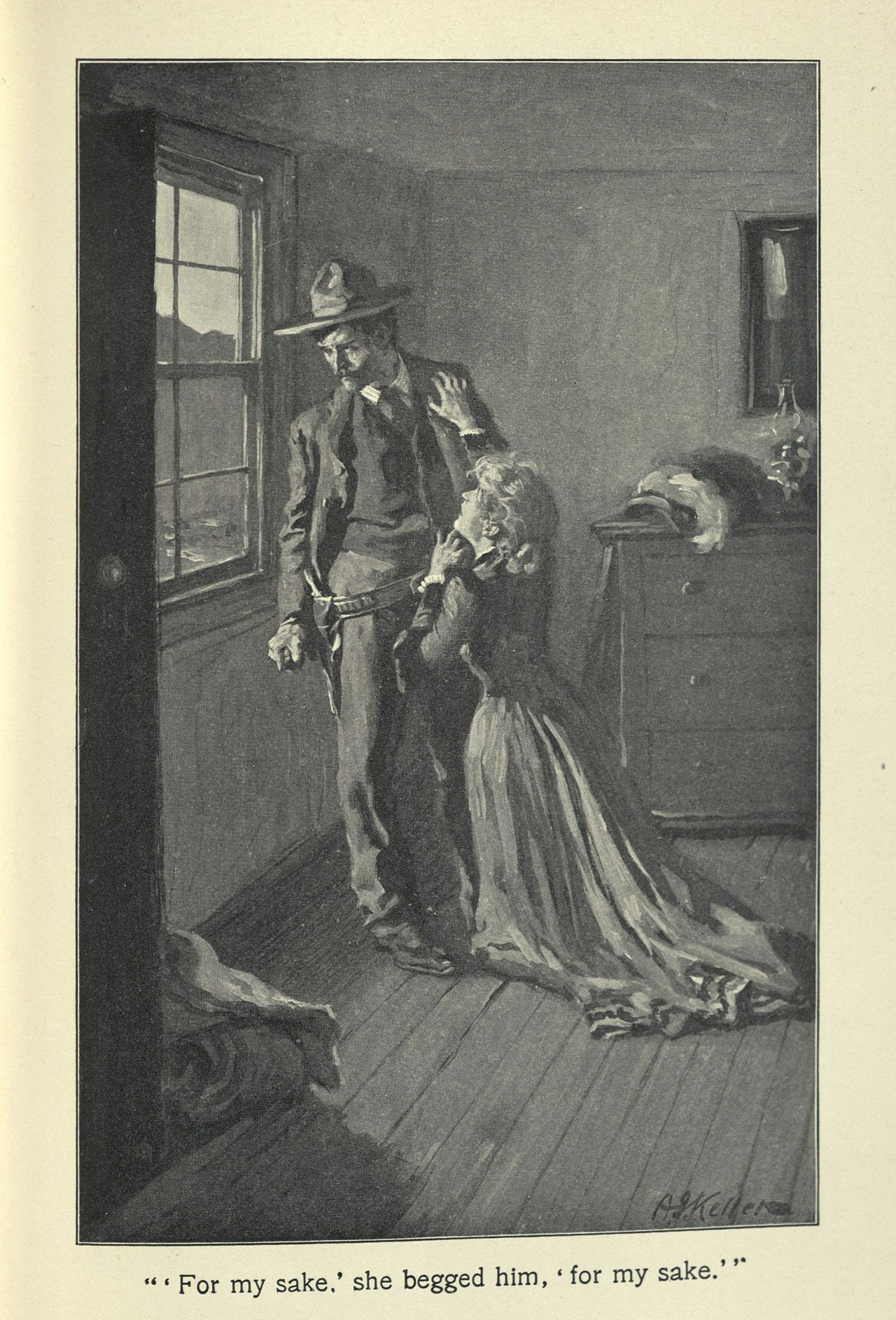
She did not fall, or totter, but stood motionless. And next – it seemed a moment and it seemed eternity – she heard in the distance a shot, and then two shots.
This presentation copy is inscribed, “Owen Wister to Barrett Wendell; June 17, 1902.” Barrett Wendell was a professor of English at Harvard. Wister was enrolled in Wendell's “Eighteenth and Nineteenth Century Literature.”
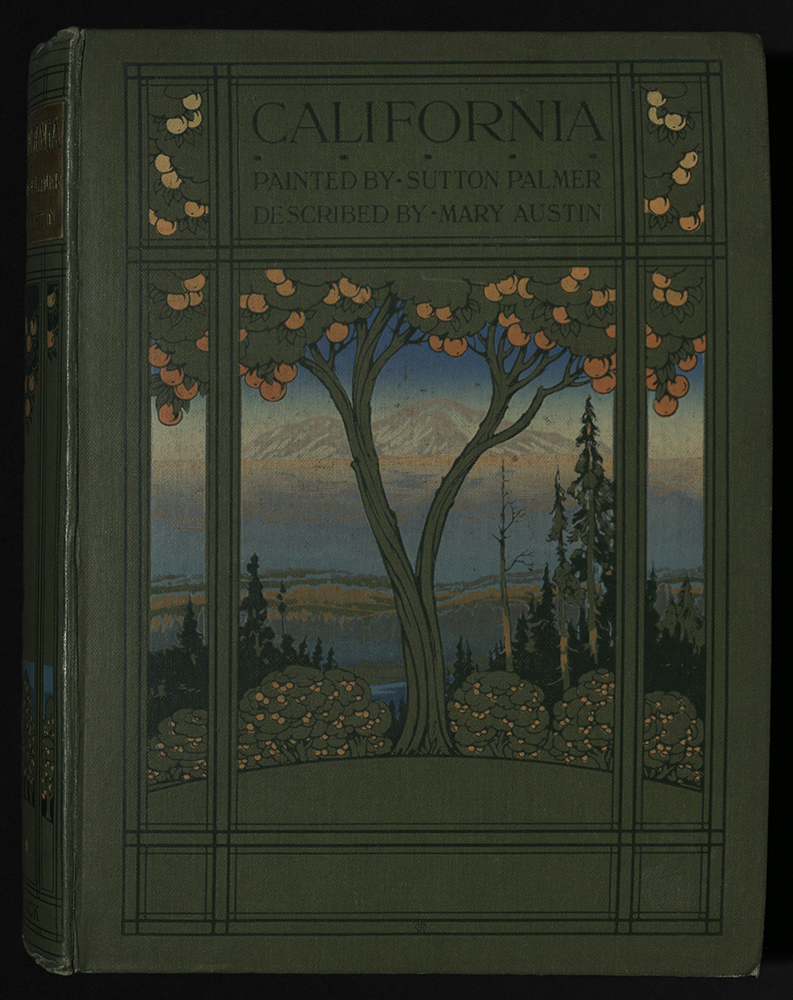
CALIFORNIA : THE LAND OF THE SUN
Mary Hunter Austin (1868-1934)
London: Adams and Charles Black, 1914
First edition
F866 A93 1914
Mary Austin, writer, conservationist, fervent suffragist, and deeply sympathetic to the treatment of the American Indian, moved in distinguished literary and scientific circles in both the United States and abroad. She was one of the leading literary figures of her time, the author of twenty-seven books and more than two hundred and fifty articles. H. G. Wells called her the most intelligent woman in America.
After the death of her father, she moved with her family from Illinois to a ranch near Bakersfield, California, where she married, three years later, Stafford Austin, a rancher and teacher. They settled in Lone Pine, Inyo County. Here began Austin’s lifelong fascination with the desert. She became acquainted with Indian lore and Mexican history and culture. Austin and her husband later moved to Owens Valley, a remote area east of the Sierra Nevada.
Austin kept detailed notes on what surrounded her. She followed the local Native American groups, watching how they managed to balance life against the realities of nature. Unlike John Muir, she paid close attention to these first settlers of the land.
She eventually moved to Santa Fe, New Mexico, reveling in the native, Hispanic and Anglo intermingled cultures, and the New Mexican landscape which Austin observed, “takes the breath like pain.” For Austin, nature and landscape took primacy over peoples. She wrote, “Not the law, but the land sets the limit,” recognizing the ecology of her surroundings, declaring “The manner of the country makes the usage of the life there, and the land will not be lived in except in its own fashion.” In California, Austin recorded process – the adjustments of plants and animals that made up the biological community of aridity, while noting the human capability to harness, capture, and discard the surrounding environment.
This work is a physical description of various California locales, illustrated by Harold Sutton Palmer (1854-1933), a well-known English Victorian landscape artist and book illustrator.
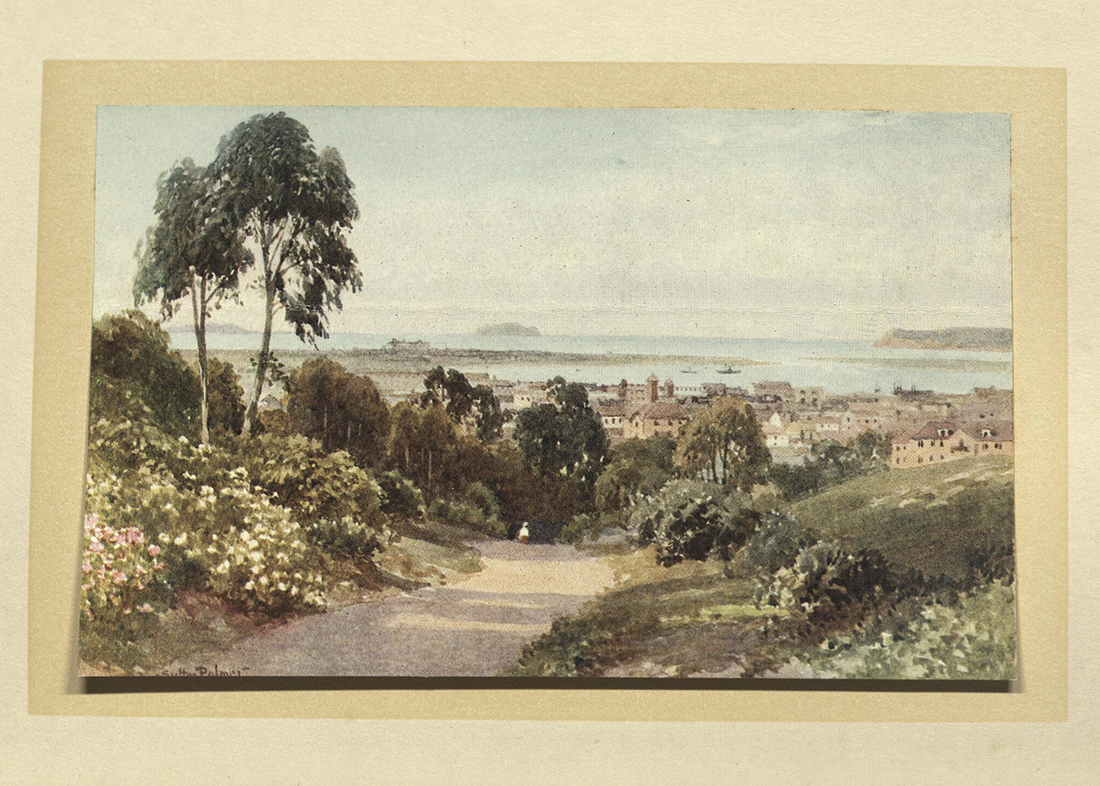
All human interest of this region centres about the city on the bay of San Diego, a low locked harbor with a long spit of sand breaking the mild Pacific swell, as it bides its time for the shipping of the south-western world.
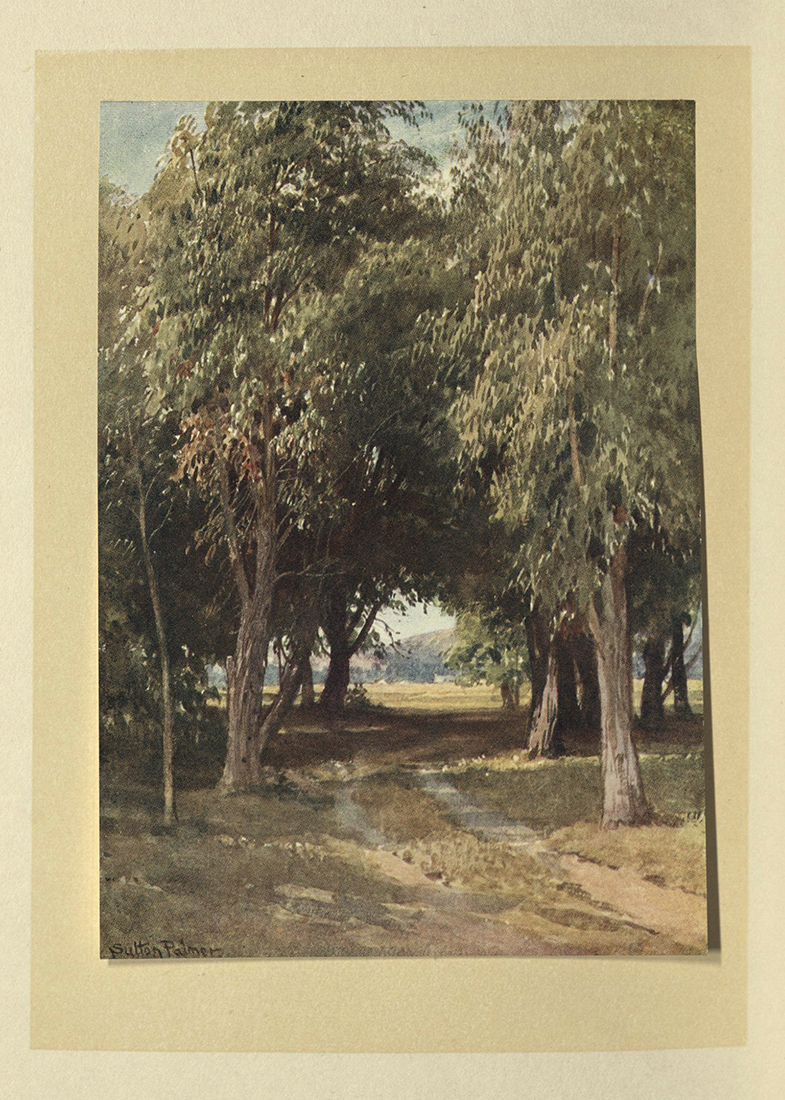
One of the most interesting of the instruments by which the cultivated landscape has gathered up and fixed the evanescent greens that spread thinly yet over the uncropped hills in spring, is the eucalyptus.
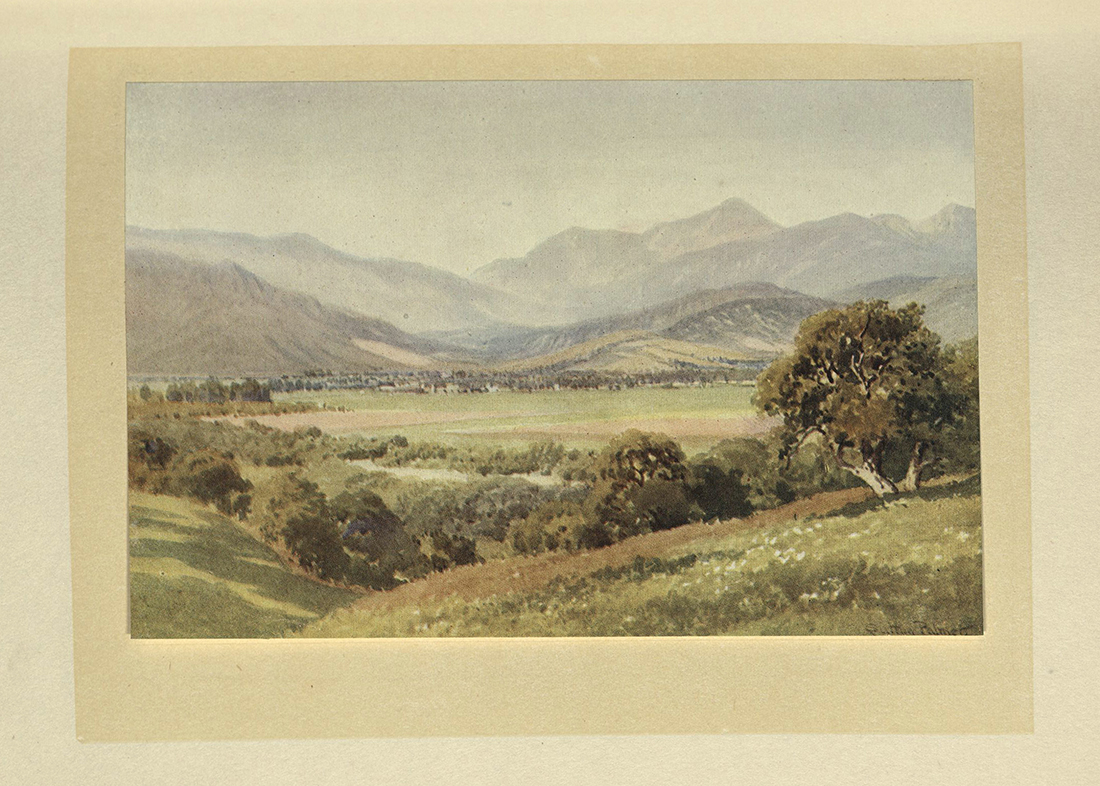
In a country which disdains every sort of prettiness, and dares even to use monotony as an element of beauty, as California does, it is surprising to find, cut in the solid granite wall, little dells all laced with fern and saxifrage, and wind swung, frail, flowery bells.
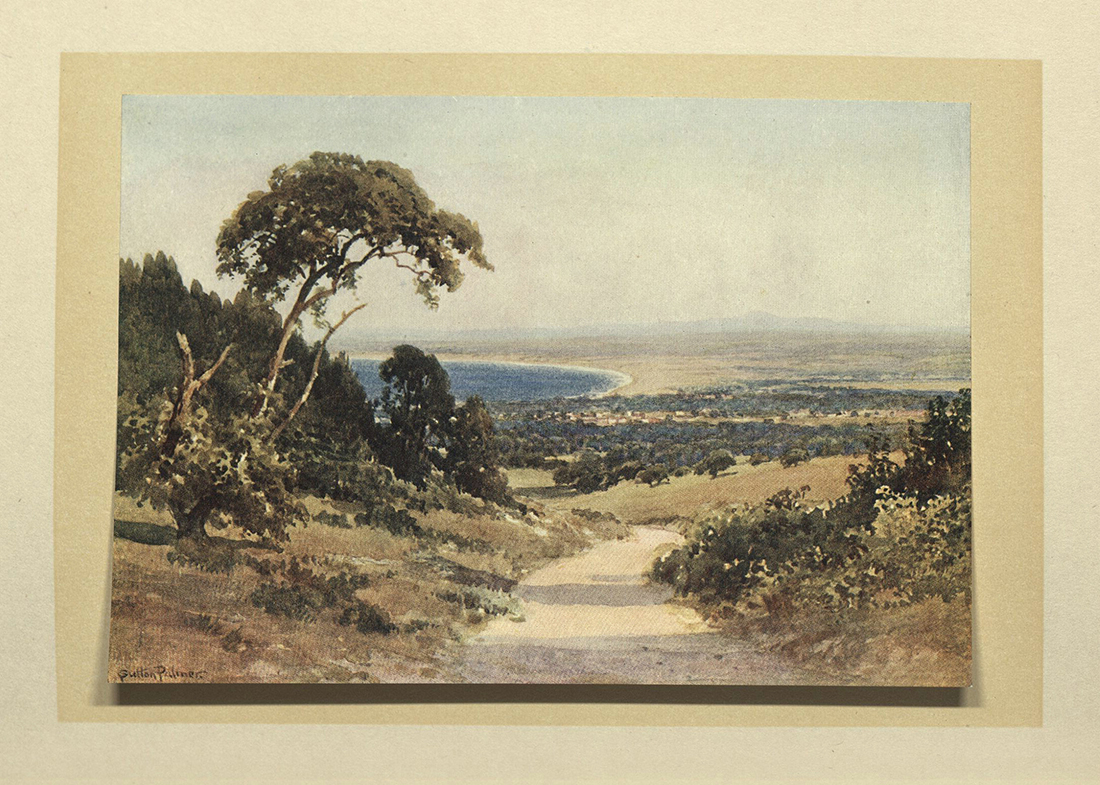
We struggle so to achieve a little brief moment of beauty, but every hour at Monterey it is given away.
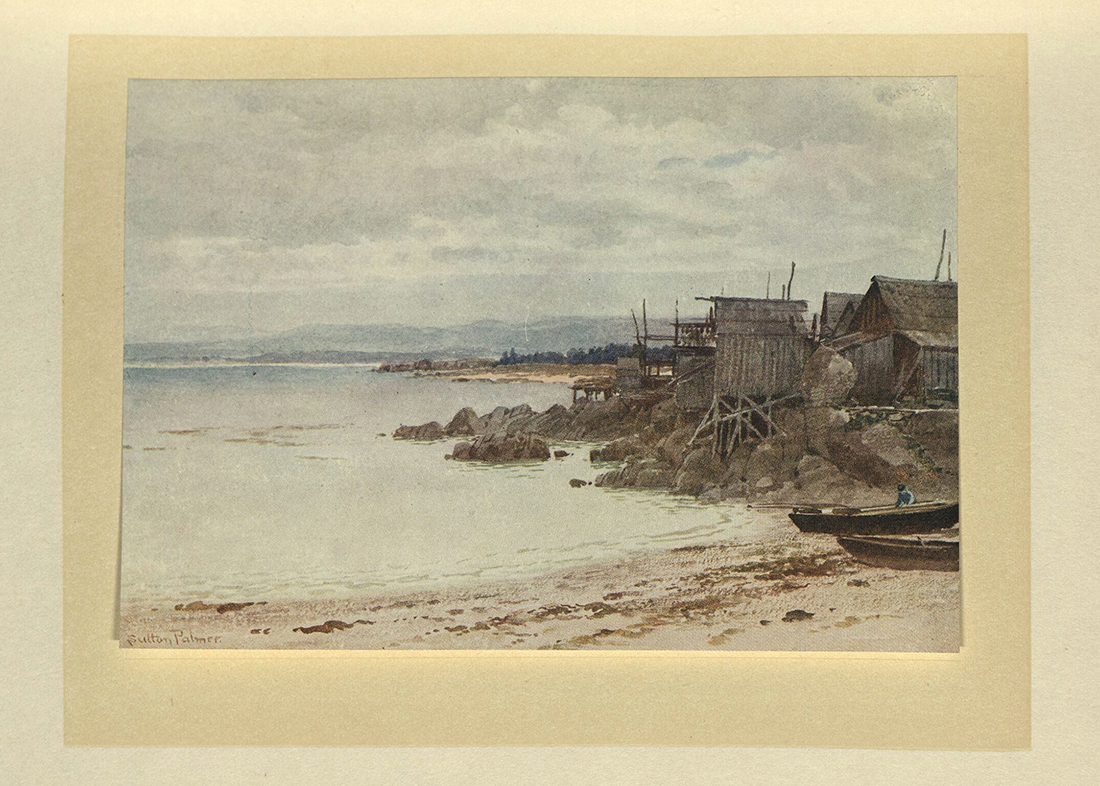
Blake, indeed, might have had a hint of these from some transplanted seedling on an English terrace, for the Monterey cypress is quick-growing for the first century or so and one of the most widely diffused of trees; but only here on the Point and south to Pescadero ranch do they grow of God’s plantings.
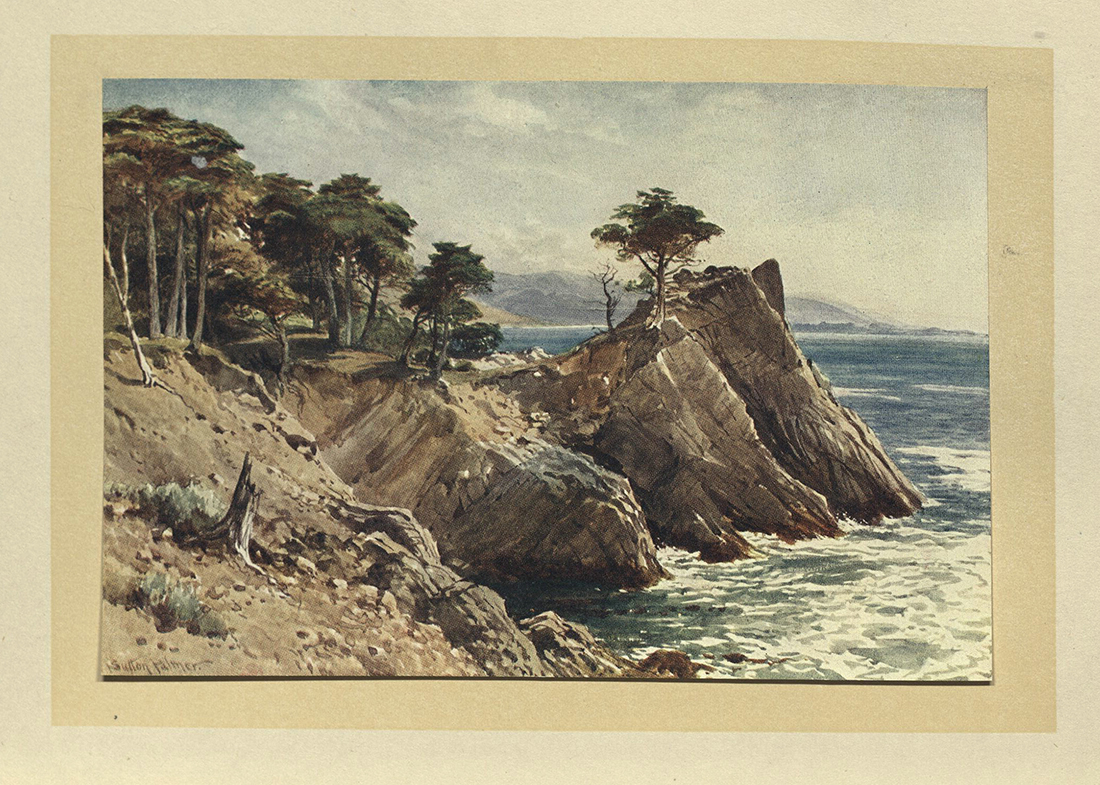
There are no redwoods on the peninsula; straggling lines of them look down from Palo Corona on Carmel Bay, walking one after another, with their odd tent-shaped tops and long branches all on the windward side, like a procession of friars walking against the wind.
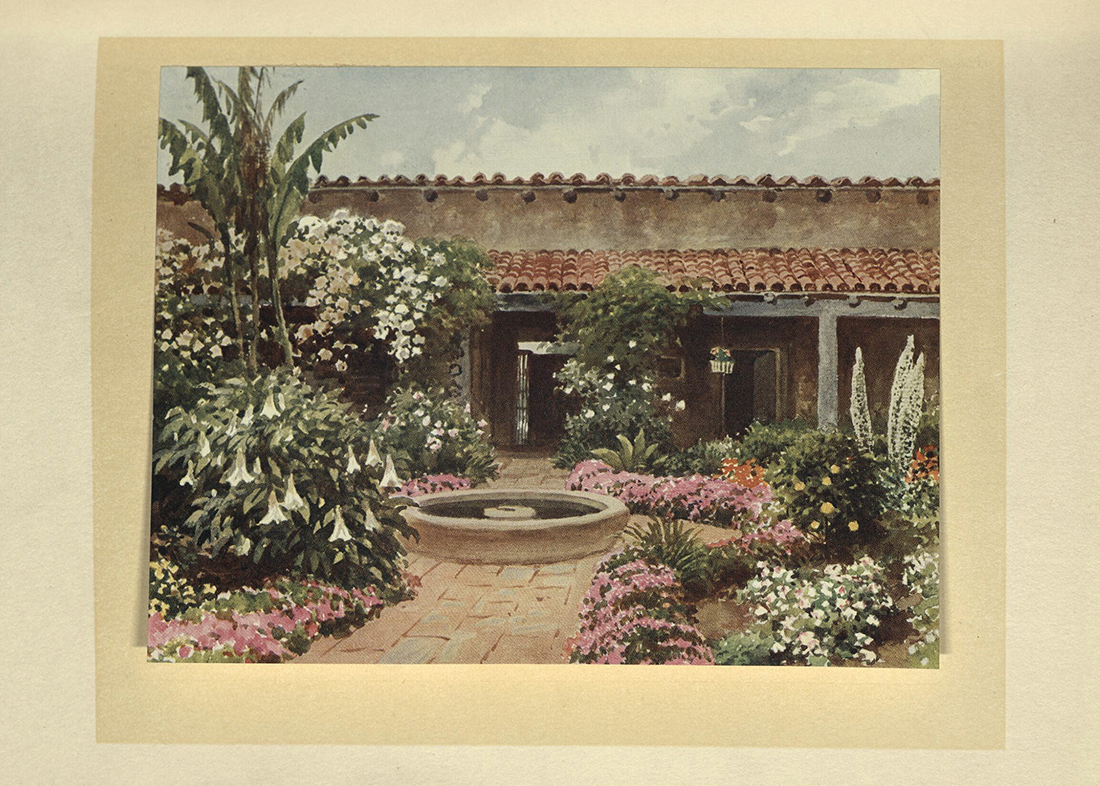
It was not spoken of as the garden at all, it was the patio, an integral part of the dwelling.
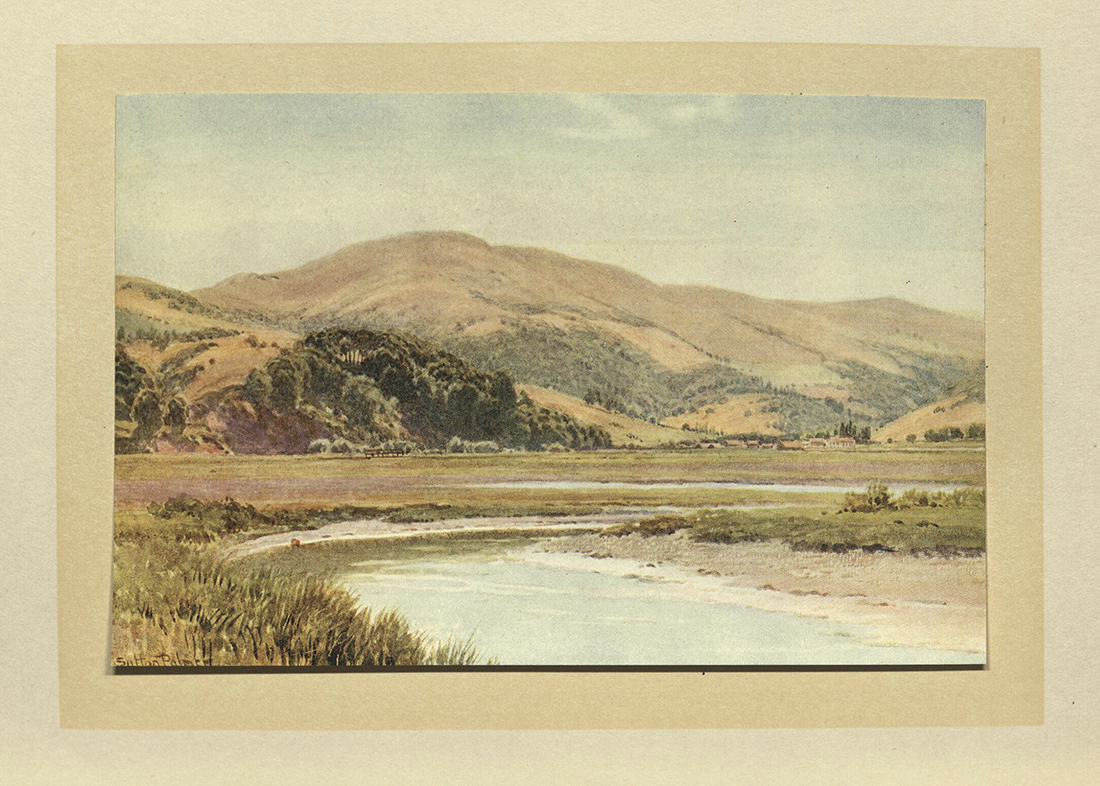
The bay of San Francisco with its contingencies is one of the most interesting of inland yachting waters, full of adventurous weather.
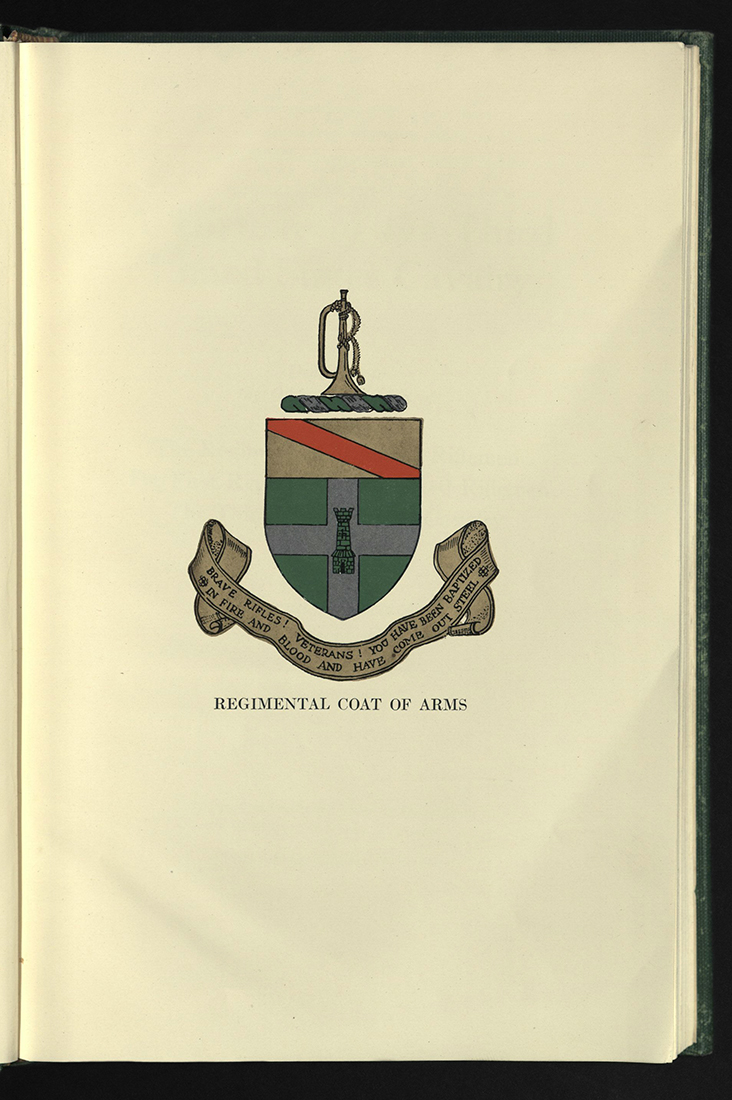
Practically the whole history that ensues up to the year 1894…must be read to follow the regiment through the campaigns in which is operated against hostile Comanches, Lapins, Navajos, Kiowas, Mescalero Apaches, Utes, Sioux and Cheyennes in all of which it characterized itself by always accomplishing its purposes with the use of only such force as was absolutely required to carry out its missions; but when required to use force, doing so with all efficiency and effectiveness.
A HISTORY OF THE THIRD UNITED STATES CAVALRY ...
Ralph Conrad Deibert (1885-1968)
Harrisburg, PA: Telegraph Press, 1933
First edition
UA31 3d D4 1933
In 1846 a group of mounted riflemen was formed to become the Third Cavalry for the United States Army. The unit served in Mexico, New Mexico, Arizona, Texas, Nebraska, Colorado, Alabama, Arkansas, Montana, Wyoming, Dakota Territory, and Philippine Islands. They engaged in the Mexican War, the Civil War, the Philippine insurrection, World War I, and the battle of the Rosebud in the Spanish-American War. They participated in numerous Indian campaigns including the Big Horn Expedition of 1876 and others with Indians in New Mexico and Arizona, fighting the Comanche, the Cheyenne, and the Utes. The Third United States Cavalry protected the frontiers of Nebraska, Kansas and Colorado and guarded the large reservations of the Sioux and Cheyenne.
The author of this history, Ralph Conrad Deibert, served as a colonel in the U.S. Army and is buried at Arlington National Cemetery.
Illustrated with colored regimental coat of arms, portraits and maps. Bound in green cloth with gold stamping on front cover and spine. Edition of one hundred copies. Rare Books copy inscribed by a former Captain of the Third Cavalry.
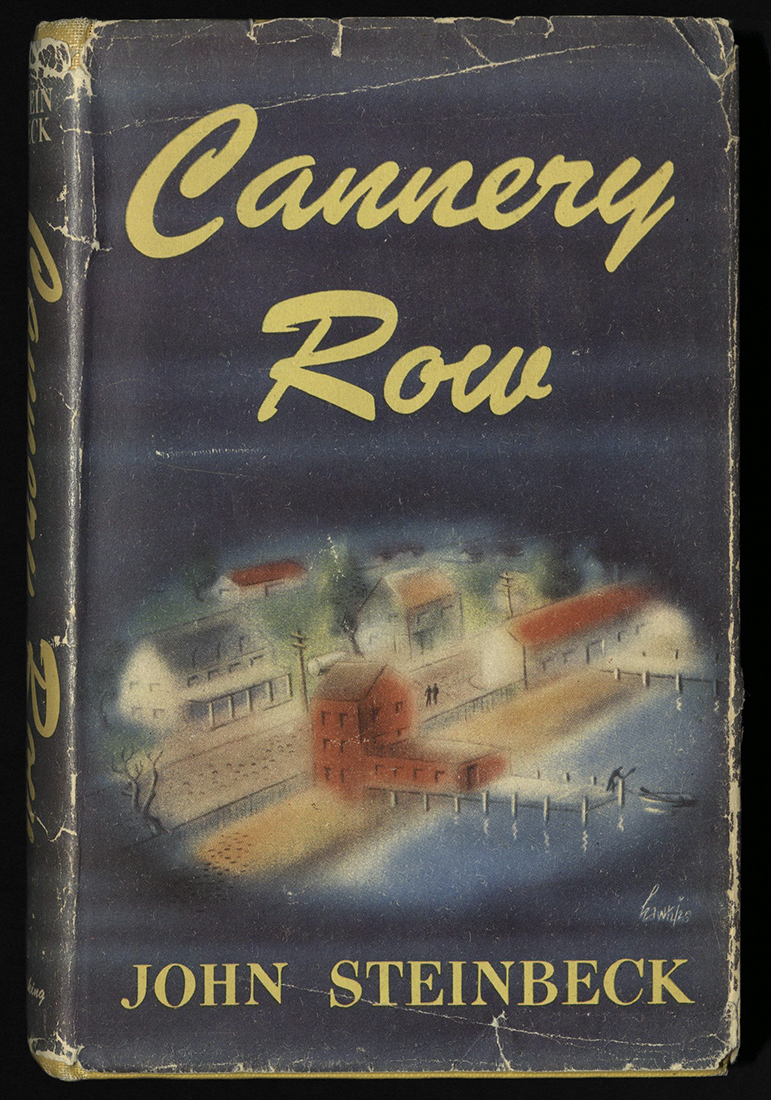
Cannery Row in Monterey in California is a poem, a stink, a grating noise, a quality of light, a tone, a habit, a nostalgia, a dream.
CANNERY ROW
Steinbeck, John (1902-1968)
New York: The Viking Press, 1945
First edition, second state
PS3537 T3234 C3 1945
Cannery Row is a Depression-era novel set in Monterey, California. The story takes place on a grungy street: “the gathered and scattered, tin and iron and rust and splintered wood, chipped pavement and weedy lots, junk heaps, sardine canneries of corregated iron, honky tonks, restaurants and whore houses, and little crowded groceries, and laboratories and flophouses.” The street was based on a real street, since re-named “Cannery Row.” The cast of characters is as broad as the range of the make-up of the street: a marine biologist, a grocer, a restaurant owner and a band of vagabonds, described as, “gentlemen and philosophers united by a common dislike of a steady job and a mutual feeling for the pleasures of living according to their lights.” John Steinbeck, who was born in Monterey County, based much of this novel on his own experiences. Growing up, Steinbeck knew fishermen and other workers and was a close friend with marine biologist, Ed Ricketts, who worked on the real Cannery Row.
Original pictorial dust jacket designed by Arthur Hawkins, Jr., with an illustration of Cannery Row by Hawkins to the front panel, titled in yellow. The first edition was published using materials in conformity with wartime conservation measures. Issued both in paper wrappers and in cloth with dust jacket, it was first bound in light buff cloth. When supplies ran out, the job was finished in yellow cloth.
University of Utah copy gift from the Frank O’Rourke Collection.
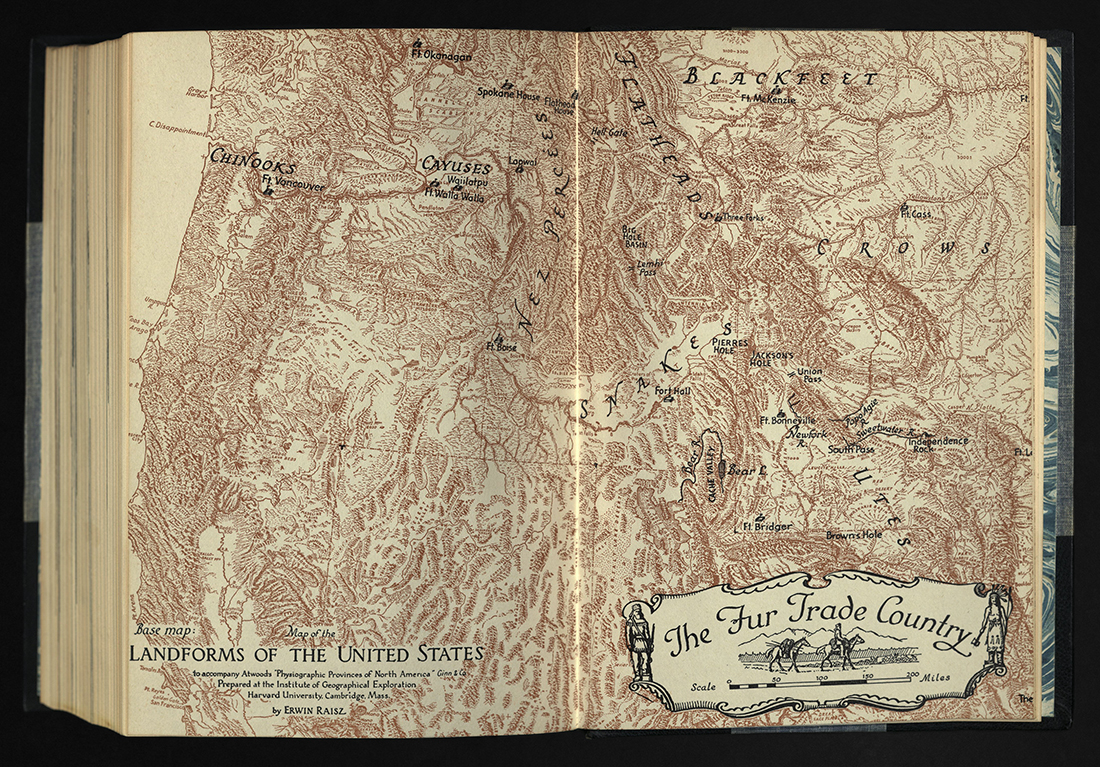
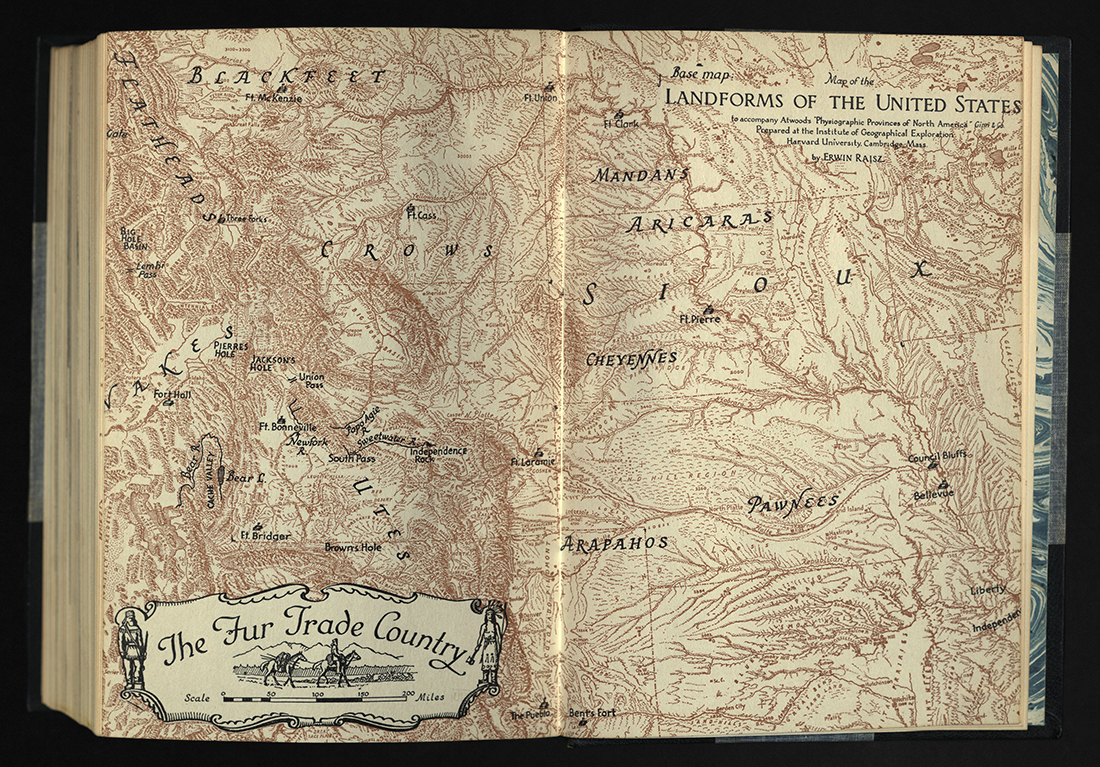
Certain moments in history are like a man waking at night and counting the strokes wrong when he hears a clock strike.
ACROSS THE WIDE MISSOURI
Bernard DeVoto (1897-1955)
Boston: Houghton Mifflin Co., 1947
First edition
PS3507 E867 A37
Born in Utah and trained as a journalist, Bernard DeVoto was a historian, critic, editor, professor, political commentator, and conservationist. His Across the Wide Missouri is a history of the Rocky Mountain fur trade between 1832 and 1839. Across the Wide Missouri is part of a trilogy, begun with A Year of Decision in 1943 and ending with The Course of Empire in 1952. All three of these works are still in print.
In Across the Wide Missouri, DeVoto examined the fur trading companies, focusing on the Rocky Mountain Fur Company, which competed with John Jacob Astor’s American Fur Company and the British Hudson’s Bay Company, and the fur trappers and their lifestyle. The Rocky Mountain Fur Company set up an annual summer trade rendezvous supplied by overland wagon trains in a different mountain valley every year. Winner of the 1948 Pulitzer Prize, Across the Wide Missouri helped romanticize the trappers and this annual gathering.
Devoto wrote of Native Americans and their interaction with Anglo-Americans. He included the impact of geography, weather, and the political intrigue between the United States and Britain, with the eventual ownership of Oregon as the ultimate goal. He wrote about the economics of the trade, emphasizing the inability of many trappers to get out of debt to the fur companies who both bought their furs and sold them their supplies. He stressed that the trappers pioneered the overland wagon transport across the Great Plains and that their knowledge of the interior West was essential to the overland migrations of Anglo-Americans to California and Oregon, as the trappers acted as scouts and guides after the collapse of the fur trade.
A contemporary New York Times review of Across the Wide Missouri, called it “magnificent.” The book was turned into a film starring Clark Gable. A defender of American public lands, from 1935 to 1955 DeVoto wrote a column for Harper’s Magazine titled the “Easy Chair,” known for its forceful views. He was brash and opinionated, qualities that were reflected in his writings and that kept him in the public limelight. He was so controversial that the FBI created a file on him.
Illustrated with paintings by Alfred Jacob Miller, Charles Bodmer, and George Catlin. Rare Books copy is a gift from Mark DeVoto, specially bound by the publisher.
THE DOUBLE AXE & OTHER POEMS
Robinson Jeffers (1899-1961)
New York: Random House, 1948
First edition
PS3519 E27 D6 1948
Many of Robinson Jeffers’ references to current events and figures like Pearl Harbor, Hitler, Stalin, and Roosevelt raised questions about his patriotism. This first edition, is in its original dust wrapper, carries the publisher’s infamous disclaimer of their poet’s philosophy: “Jeffers sees a world bent on self-destruction and takes a stand for complete political isolationism. His publishers cannot subscribe to such a credo. Random House feels compelled to go on record with its disagreement...Acutely aware of the writer's freedom to express his convictions boldly and forthrightly and of the publisher's function to obtain for him the widest possible audience whether there is agreement in principle or not...time alone is the court of last resort in the case of ideas on trial...”
Yesterday morning enormous the moon hung low on the ocean,
Round and yellow-rose in the glow of dawn;
The night-herons flapping home wore dawn on their wings.
Today
Black is the ocean, black and sulphur the sky,
And white seas leap. I honestly do not know which day is more beautiful.
I know that tomorrow or next year or in twenty years
I shall not see these things – and it does not matter, it does not hurt;
They will be here. And when the whole human race
Has been like me rubbed out, they will still be here: storms, moon and ocean,
Dawn and the birds. And I say this: their beauty has more meaning
Than the whole human race and the race of birds.
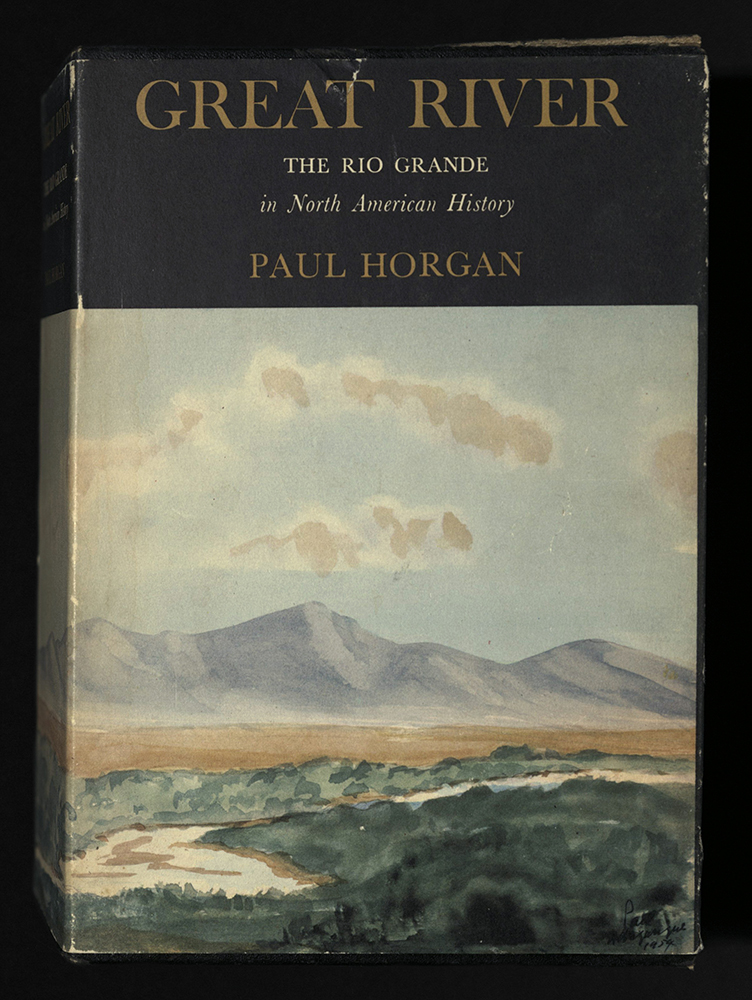
In all its career the Rio Grande knows several typical kinds of landscape, some of which are repeated along its great length. It springs from tremendous mountains, and intermittently mountains accompany it for three fourths of its course. It often lies hidden and inaccessible in canyons, whether they cleave through mountains or wide level plains. From such forbidding obscurities it emerges again and again into pastoral valleys of bounty and grace. In such fertile pastures all is green, and the shade of cottonwoods and willows is blue and cool, and there is reward for life in water and field. But always visible on either side are reaches of desert. After turbulence in mountains, bafflement in canyons, and exhaustion in deserts, the river finds peaceful delivery into the sea, winding its last miles slowly through marshy bends, having come nearly one thousand nine hundred miles from mountains nearly three miles high.
GREAT RIVER ...
Paul Horgan (1903-1995)
New York: Rinehart, 1954
First edition
F392 R5 H65 1954
Winner of the Bancroft and Pulitzer prize Paul Horgan’s Great River is the epic history of four civilizations – Native American, Spanish, Mexican, and Anglo-American – that peopled the Southwest through ten centuries. Horgan described the Rio Grande River, its role in human history, and the overlapping cultures that lived alongside it, entering into conflict over the land it traverses. He wrote of the pueblo culture of the Anasazi and of the colonial Spanish experience in New Mexico.
King Charles, who was also the Holy Roman Emperor, lived and worked in hard bare rooms with no carpets, crowding to the fire in winter, using the window's sunshine in summer. The doctors of medicine stated that the humors of moisture and of cold dominated his quality. His face was fixed in calm, but for his eyes, which moved and spoke more than his gestures or his lips. His face was pale and long, the lower lip full and forward, often dry and cracked so that he kept on it a green leaf to suck. His nose was flat and his brows were pitted with a raised frown that appeared to suggest a constant headache. He held his shoulders high as though on guard. He would seem to speak twice, once within and fully, and then outwardly and meagerly. But his eyes showed his mind, brilliant, deep and always at work. He loved information for its own sake, was always reading, and knew his maps well. They said he saw the Indies better than many who went there, and held positive views on all matters concerning the New World and its conquerors.
He wrote of the Franciscan friars from Spain settling, in European fashion, the desert Southwest, admiring them as men of strong faith and hard work. And finally, of the Anglo-Americans who entered the area, eventually conquering Texas and New Mexico.
In the early summer of 1848, what so long a sequence of claims had labored over and over to effect was now confirmed by overwhelming power: that the southeasterly Rio Grande had always seemed a natural boundary between different sovereignties, kinds of country and types of society. Under the sense of destiny of the American people, and their weight of arms, the issue – passed from trappers to traders, traders to soldiers, soldiers to citizens – was at rest. The Rio Grande in Colorado and New Mexico, and its left bank in Texas, belonged to the United States…It was won by the tradition, the skill, of the frontier rifleman. And it was won by a spirit drawn from deep in the national character.
Great River contains reverent passages about the land and the river itself.
Landscape is often seen as static; but it never is static. From its first rock in the sky to its last embrace by the estuary at the sea, the river has been surrounded by forces and elements constantly moving and dynamic, interacting to produce its life and character. It has taken ocean and sky; the bearing of winds and the vagary of temperature; altitude, and tilt of the earth’s crust; underground waters and the spill of valleys and the impermeable texture of deserts; the cover of plants and the uses of animals; the power of gravity and the perishability of rock; the thirst of things that grow; and the need of the sea to create the Rio Grande.
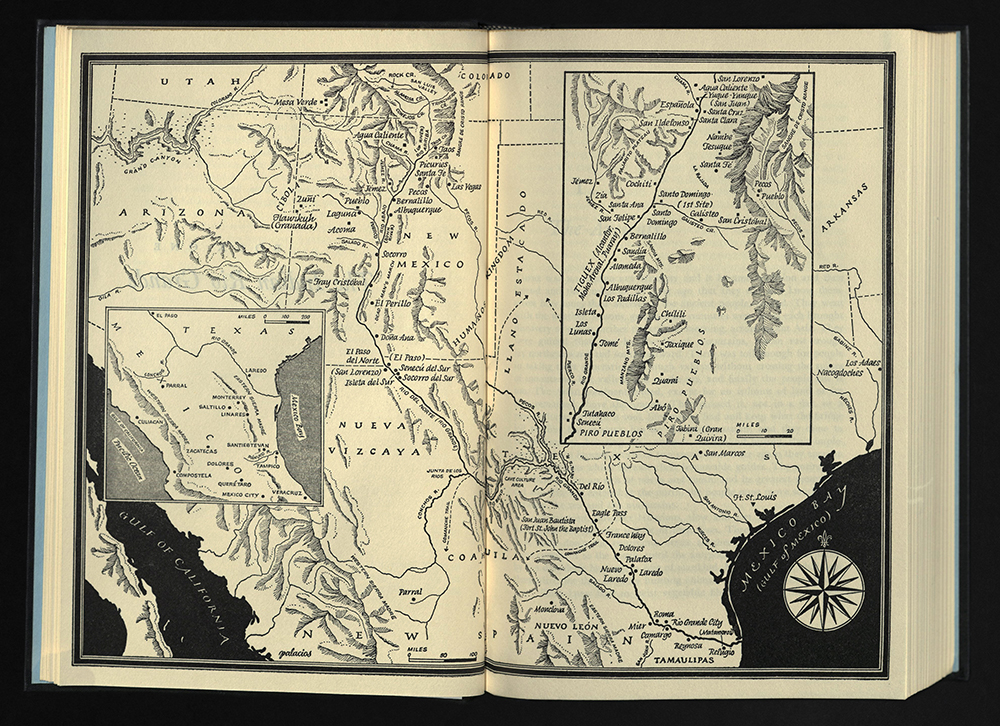
Horgan worked for fourteen years on this history. Its literary qualities claimed praise as a masterpiece of American historical writing. A native of Buffalo, New York, he moved with his family to Albuquerque when he was twelve. He worked as a reporter for the Albuquerque Journal. He worked as the librarian at the New Mexico Military Institute, in Roswell, New Mexico, where he had earlier attended school with artist Peter Hurd. Its library is now named after him. He was the author of forty books. Historian, novelist, poet, and biographer, he oversaw the writing programs at Wesleyan University, although he never attended college, with the exception of one year at the Eastman School of Music, in Rochester, New York. He received nineteen honorary degrees from other universities and a knighthood from Pope Pius XII.
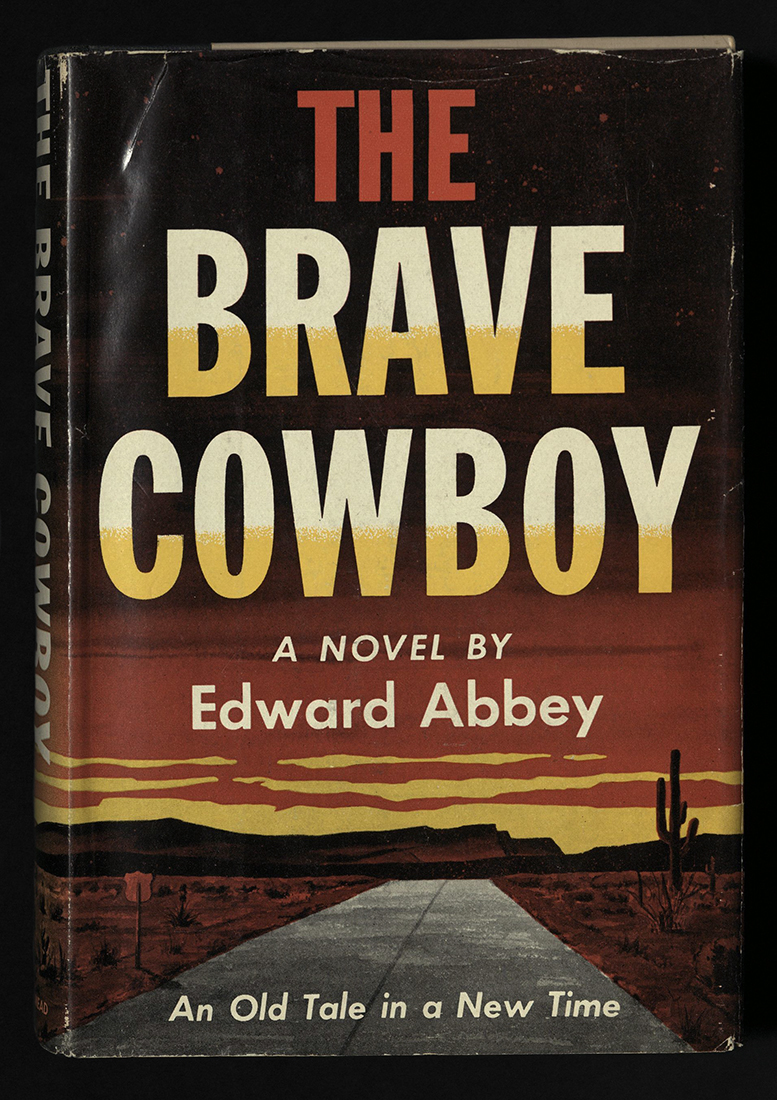
A near silent world: he heard nothing but his own breathing, the faint scrape of his boots on stone and gravel, the whispering boughs of the juniper, the rattle of the oak, the vague, distant and intermittent whistle, like a bad flute, of a mourning dove. Over everything, stone and plant and animal, over the canyon wall, over the face of the mountain far above, the sun radiated its patina of warm, rye-golden, evening light.
THE BRAVE COWBOY : AN OLD TALE IN A NEW TIME
Edward Abbey (1927-1989)
New York: Dodd, Mead, 1956
PS3551 B2 B67 1956
Novelist and essayist Edward Abbey became an icon for grassroots environmental activism. In the 1970s, after The Monkey Wrench Gang was published, he gained near-cult status within the American West environmental movement. He was noted for his advocacy of environmental issues, criticism of public land policies, and anarchist political views.
Abbey was born in Pennsylvania. When he was seventeen, he began to explore the American Southwest. He traveled by foot and bus, hitched rides and hopped freight trains. In the U. S. Army, he was promoted and then demoted for his propensity for opposing authority. In 1956 and 1957, Abbey worked as a seasonal ranger for the United States National Park Service at Arches National Monument (now a national park), near the town of Moab, Utah. In the 1960s, he worked as a ranger at the Organ Pipe Cactus National Monument, on the border of Arizona and Mexico.
The Brave Cowboy was Abbey’s second published novel. The protagonist is an anarchist cowboy fighting modern society. Abbey used the main character again in later novels. The book was the basis for the film, Lonely are the Brave, starring Kirk Douglas.
Desert Solitaire, Abbey’s fourth book and first non-fiction work, published in 1968, is regarded as one of the finest narratives in American literature, often compared to Henry David Thoreau’s Walden.
While known for his cantankerous personality, he was best at putting words to landscape. He could move from poetry to profanity and back again in a single paragraph. From poetic to profane to personal to prophetic, his lyrical, vividly powerful prose stands the test of time. The first edition of The Brave Cowboy was small. Only 5,000 copies of it were printed. For more of Edward Abbey, please visit our digital exhibition, Brave Cowboy.

Pioneers, for whom history was walking through dead grass,
and the main things that happened were miles and the time of day –
TRAVELING THROUGH THE DARK
William Stafford (1914-1993)
New York: Harper & Row, 1962
PS3537 T143 T7 1962
Poet William Stafford was born and raised in Kansas, a state now described as being in the middle of the United States. Its history, however, places it in the west of early European exploration and the later battles with Native Americans in the western war for supremacy.
The first European to set foot in present-day Kansas was the Spanish conquistador Francisco Coronado, who explored it in 1541. Zebulon Pike neared its present-day border in 1806. Trapper Ezekial Williams spent time in the area between 1807 and 1809. In 1842, John C. Fremont mapped distances in the area as he travelled through it. Francis Parkman toured its plains in 1846. In 1878, the Third United States Cavalry fought battles with the Cheyenne in, as it was then termed, Indian Territory. It first began to be settled by white people as early as 1827, with the building of Fort Leavenworth. It was admitted into the Union in 1861. Hence, Stafford grew up in the West.
After attending the University of Kansas, he became a conscientious objector and spent the Second World War years working in California for the Civilian Public Service. In 1948, he began teaching at Lewis and Clark College in Oregon, where he spent the rest of his life. His first book of poetry, Traveling Through the Dark, won the National Book Award for poetry in 1963.
Stafford’s poetry, an exploration of the human relationship with nature, using the western landscape to address universal themes, and recognizing Native American culture as “wisdom [derived] from intimacy with the wilderness,” has been described as the “highly personal daydreaming about the western United States.”
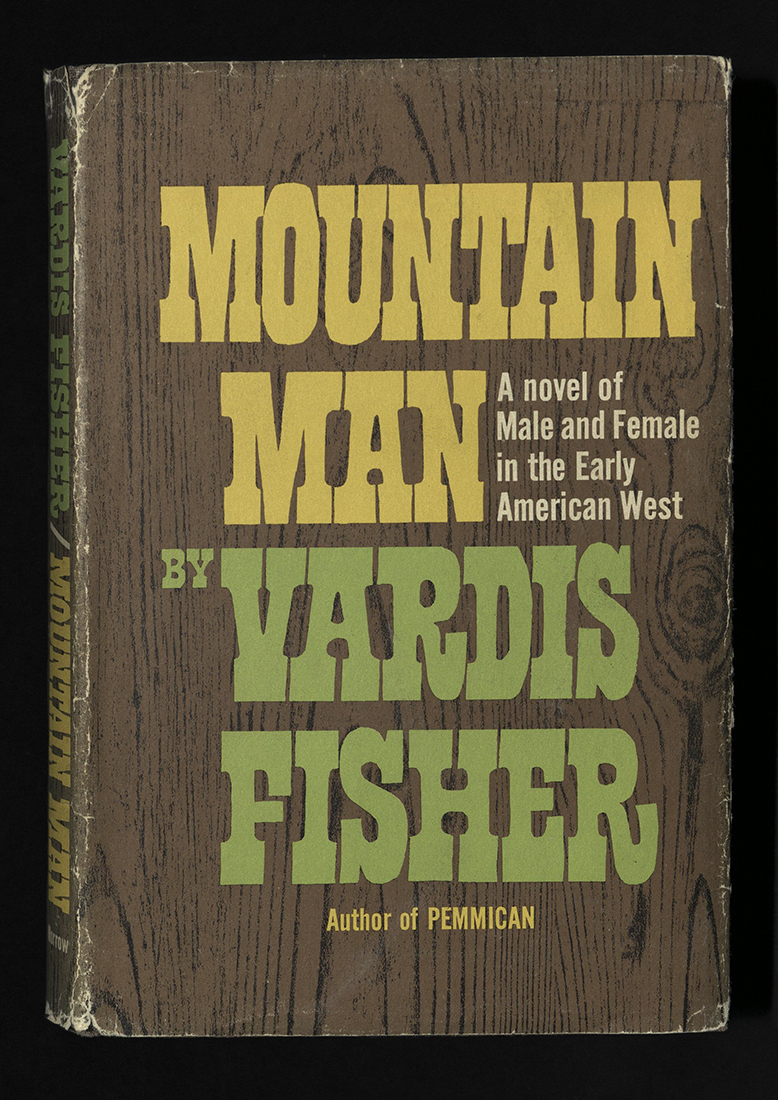
If you loved the world the Creator had made for you, you did not shut out the blue heaven and its lights, or lie in foul air in a stuffy room, when in a bed outside you could smell the morning and watch its mother-of-pearl light softly touch the hills.
MOUNTAIN MAN ...
Vardis Fisher (1895-1968)
New York: Morrow, 1965
First edition
PS3511 I744 M62 1965
Vardis Fisher was born in a log cabin without running water or electricity in Idaho, where he would spend most of his life. Home-schooled until the fourth grade, he attended the University of Utah and then the University of Chicago, from which he received a Ph.D in 1925. He taught as assistant professor of English at the University of Utah. He continued teaching at New York University, where he befriended the novelist Thomas Wolfe.
In 1931 he moved back to his father’s Idaho ranch. In 1935 he was named director of the Great Depression-era Federal Writer’s Project, part of the federal Works Progress Administration, for Idaho. The WPA was one of President Franklin Roosevelt’s New Deal programs that hired unemployed writers, researchers, and historians, who produced thousands of pieces, from oral histories to children’s books. In this position, Fisher, already known for his curmudgeonly demeanor, infuriated the WPA’s D.C. office by ignoring directives and then threats and then physical attempts to stop the press, by publishing the Idaho Guide, written mostly by himself, in January 1936, ahead of the guide for Washington, D.C., as well as those scheduled for eastern states. Fisher’s friendship with the owner of Idaho’s Caxton Printers enabled the early publication. Henry Alsberg, the Writer’s Project’s national director called Fisher the “bad boy of the Project.”
As a novelist, essayist, columnist, poet and historian, he is considered Idaho’s most prominent, native-born writer. Fisher came from a family whose ancestors embraced Joseph Smith and his Church of Jesus Christ of Latter-day Saints in 1834, settling on the land Lewis and Clark became the first white men to travel through. Although Fisher was never excommunicated by the Church, he became a vocal atheist.
He died of an overdose of alcohol and sleeping pills. An autopsy was inconclusive as to whether or not the overdose was intentional. Called by later critics an ethnocentric misogynist (his work is rife with what now seem shocking portraits of the American Indian) and anti-Semite, one essayist, J. H. McGuire wrote, “At least he shows that whatever dreams people manage to achieve, the costs of achievement can sometimes crush the dreamers.” Today, Fisher is known for his novels of the “Old West,” especially Mountain Man, which gained added fame when it was made into the 1972 movie, Jeremiah Johnson, starring Robert Redford. Fisher based his story on real-life hunter-trapper “Crow Killer Johnson,” who roamed Idaho, Montana, and Wyoming.
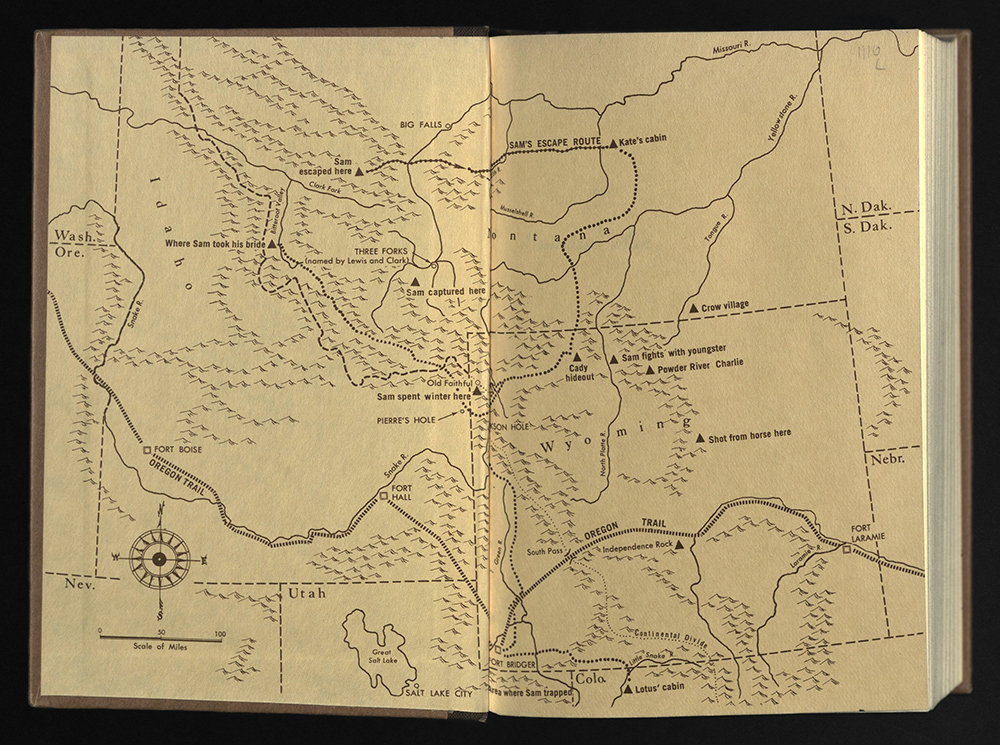
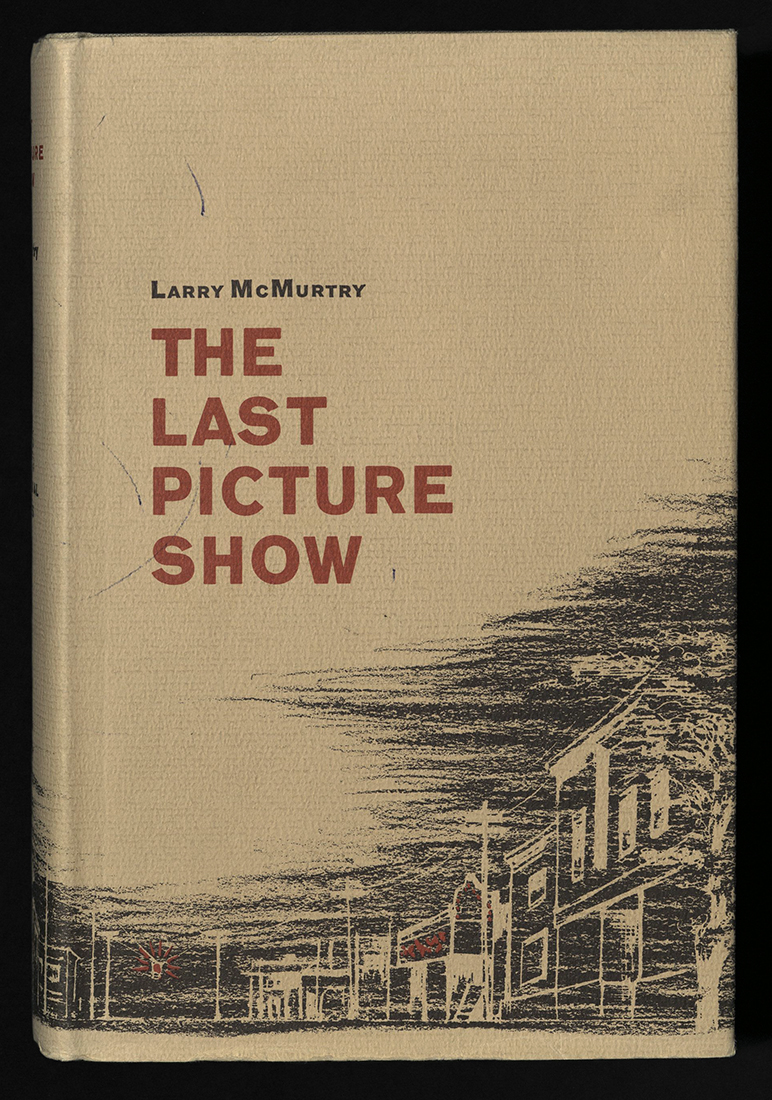

“Sometimes Sonny felt like he was the only human creature in the town. It was a bad feeling, and it usually came on him in the mornings early, when the streets were completely empty, the way they were one Saturday morning in late November.”
THE LAST PICTURE SHOW
Larry McMurtry (1936-2021)
New York: The Dial Press, 1966
First edition
PS3563 A319 L37 1966
Larry McMurtry, the son of an Archer City, Texas rancher and a well-known bookman, was also a Pulitzer Prize winning writer. McMurtry was a Wallace Stegner fellow on Stanford University’s creative writing programme, along with classmates Wendell Berry and Ken Kesey. Texan that he was, McMurtry’s stories are full of characters, sometimes slow to move, and often spare in delivery; rich, however, in generosity of spirit, compassion for the good, and a take-no-prisoners gunning for the bad.
The Last Picture Show, McMurtry’s third novel, is set in ubiquitous small-town West Texas in the 1950s, where nothing much happens, even though the wind blows. Contrary to the mythological inheritance of Texas, a legacy of the American West larger than the state itself, The Last Picture Show used small-town life to pursue persistent twentieth-century battles of ennui and existential woe. The grim and dusty little town, well-known to every born-Texan backed by generations of Texas-born ancestors, delivers its own wilderness, pitching teenaged sexual desire against adult love, all with a wit as dry as the Texas plains. The Last Picture Show, in spite of the fact that it contained no Main Street showdown and cowboys were just regular dudes, was made into a movie, nominated for eight Academy Awards.
McMurtry became one of the best-known novelists of the late twentieth century. He received a Pulitzer Price for Lonesome Dove, a sprawling story about two retired Texas Rangers, which has sold more than a million copies.
Bound in gray cloth; stamped in red. Dust jacket. Rare Books copy signed by the author.
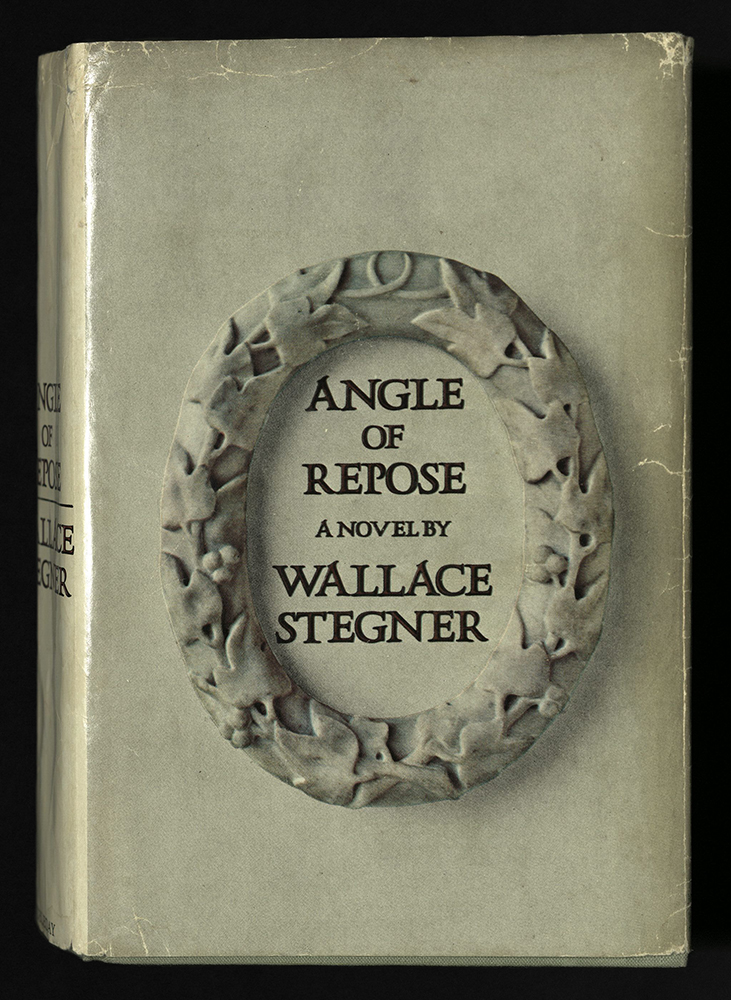
I know no way of discounting the doctrine that when you take something you want, and damn the consequences, then you had better be ready to accept whatever consequences ensue.
...
I’m not writing a book of Western history,' I tell him. 'I’ve written enough history books to know this isn’t one. I’m writing about something else. A marriage, I guess.’
...
My grandparents had to live their way out of one world and into another, or into several others, making new out of old the way corals live their reef upward.
ANGLE OF REPOSE
Wallace Stegner (1909-1993)
Garden City, NY: Doubleday & Company, 1971
First edition
PS3537 T316 A8 1971
Wallace Stegner attended school in Utah and taught briefly at the University of Utah. On the faculty at Stanford University, Stegner founded its creative writing program. He was awarded the Pulitzer Prize in 1972 for this novel, which explores the characteristics of the men and women who settled the American West after the disruption and removal of indigenous populations.
In Angle of Repose, a wheelchair-bound retired historian, Lyman Ward, on the outs with his son, writes about his frontier-era grandparents, now long dead. Four generations of an American family dwell in this dramatic story of the American West.
The novel is based on the letters of the novelist Mary Hallock Foote. Stegner used substantial passages from Foote’s letters as the correspondence of his fictional character Susan Burling Ward, a controversial literary usage of historical documents. Along with portions of Foote’s unpublished memoir, edited or combined with invented material, Stegner borrowed specific details of her life for his character. The use of Foote’s own story brought her back into public awareness. Criticisms of Stegner’s unadulterated use of Foote’s writings came mostly from the academic world and a few feminists, most of whom were ignored by the public.
While Stegner had family permission to use the material, and the alteration of her life to fit the needs of his novel, he did, minimally, acknowledge the use of the material, in a forward to the book. Questions remain about the appropriateness of his extensive culling. In answer to these, Stegner once defensively responded, “The irony is that the novel with its Pulitzer and its controversy has brought more attention to Mary Hallock Foote that she would have ever received otherwise.” In fact, it was a student who brought Foote’s unpublished material to Stegner’s attention.
Stegner contacted one of Foote’s three grandchildren, to whom he promised that his book would contain “no quotations direct from the letters.” And so, the novel became fake fiction, fitting well within the twentieth-century revisionist take on the American West as the United States’ mythic answer to its European background. The New York Times called it “a disquisition on the high price paid by men of ability and women of taste for the opening and developing of the West…a kind of textbook for anyone who is interested in studying the structure of the traditional novel.” The Los Angeles Times wrote, “Brilliant…Two stories, past and present, merge to produce what important fiction must: a sense of the enhancement of life.” Readers of the San Francisco Chronicle voted it the best novel about the West written by a Westerner in the last century. In 1998, the Modern Library ranked Angle of Repose #82 on its list of 100 best English-language novels of the 20th century. It has sold nearly one million copies.
###
